- North Dakota
- Czech Republic
- Switzerland
- Vegan City Guides
- Vegan Travel & Tips
- Vegan Fashion
- Sustainability
- Blogging Tips
- Photo Diaries
- Unfortunate (but hilarious)
- Recommendations
- Get in Touch
- Work With Me
- Best Travel Insurance
- Freelance Gig

- Europe , Greece
Ready to spend two weeks island hopping around Greece? From Paros and Naxos to Mykonos, Milos and Santorini, this incredible 14-day Greek island hopping route takes you to some of the most popular islands throughout the Cyclades. Prepare to explore beautiful white-washed villages, lay on stunning beaches, eat delicious Greek food and experience the wonderful Greek culture! Keep scrolling to read.
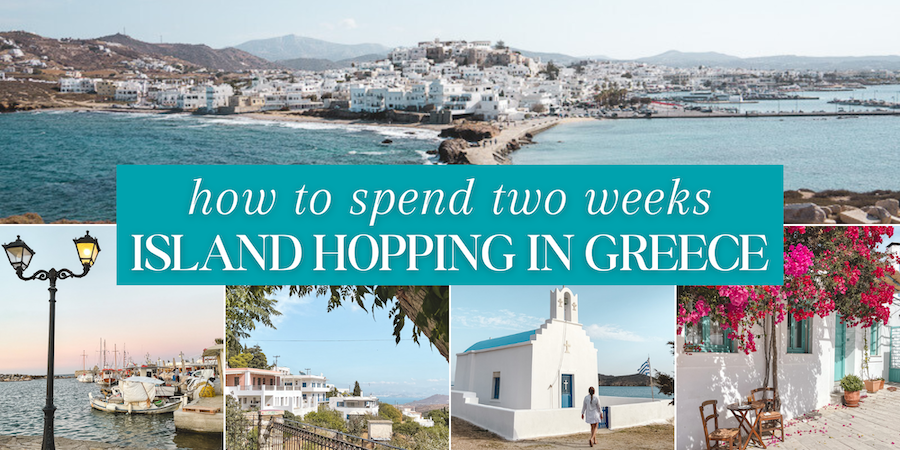
Psst, this post contains affiliate links. Read our disclosure .
Oh, buddy, am I excited to write about this incredible Greek island hopping itinerary! As someone who has visited Greece every year for the past three years, this is hands down one of my favorite countries to visit in Europe .
With its affordability, delicious food, unique islands, welcoming locals, captivating history and jaw-dropping scenery, Greece is truly one-of-a-kind.
If you are wanting to visit it for yourself, specifically in the warmer months like April through September, this is the ideal Greek island hopping itinerary that’ll help you see the best of popular islands across the Cyclades region.
In my comprehensive guide below, I dive into:
✓ What you should know about the Cyclades region ✓ How long to spend on each Greek island ✓ The best things to do on each island ✓ Where you should stay on the Greek islands ✓ How to get from one island to the next ✓ My must-know Greece travel tips ✓ How to save money in Greece ✓ Local Greek customs (like tipping)
…and so much more! If you are thinking about or in the depths of planning a two-week trip to Greece, this is the ultimate guide on how to experience the best of what Greece has to offer.
When planning your trip, don’t forget to read my guide on 25 things to know before you go to Greece !
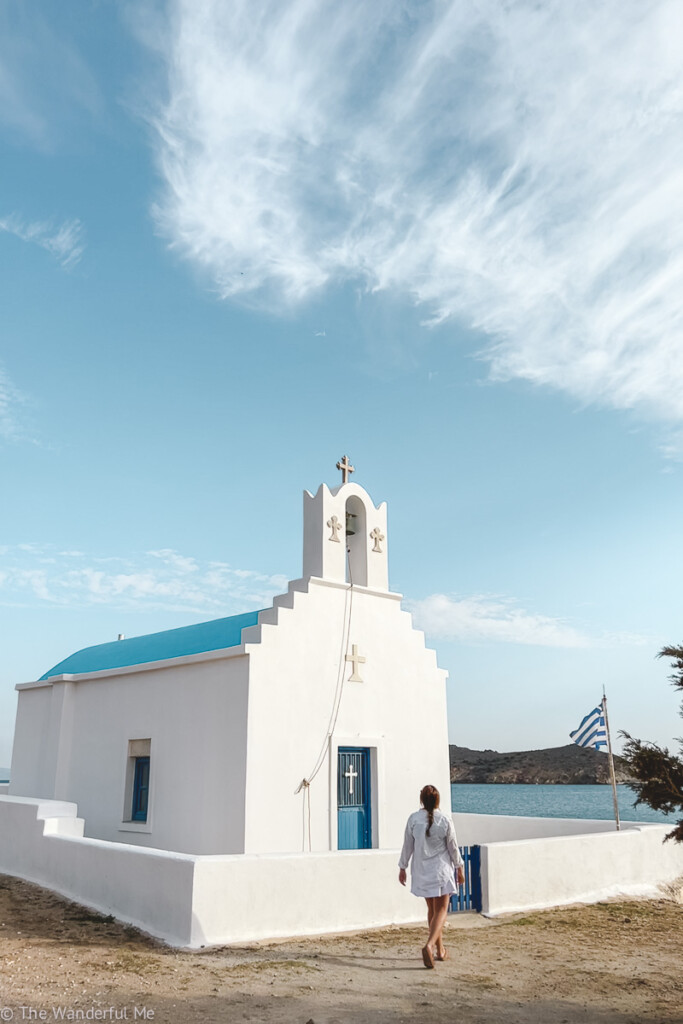
Table of Contents

ISLAND HOPPING IN GREECE
Before we jump into the itinerary, there are some key things you should know about the Cyclades, which is the primary region you will be traveling around.
Below, I explain what the Cyclades are and the islands it includes, the best way to get around Greek islands and the best time to visit the Cyclades.
What are the Cyclades?
The Cyclades is one of my favorite regions of Greece! A very popular group of islands in the Aegean Sea, the Cyclades are known for their picturesque white-washed villages, turquoise-blue waters, unique landscapes (hello, Santorini’s volcanic terrain!), beautiful beaches and ancient historical sites.
What islands are in the Cyclades?
While this itinerary focuses on the popular islands of Milos, Paros, Naxos, Mykonos and Santorini, there are around 220 islands throughout the Cyclades (though only a handful are inhabited).
Aside from the islands mentioned in this itinerary, the Cyclades include other well-known islands like Syros, Ios, Antiparos, Kythnos, Folegandros, Serifos, Anafi and Sifnos.
How do you get around the Cyclades?
The best—and easiest—way to get around the Cyclades is by ferry (psst, I use Ferryhopper ). Unless you are going off the beaten track and visiting lesser-popular Greek islands, most are going to be directly connected via ferry.
That said, it’s worth noting that ferries can be rather expensive, especially if you are visiting Greece during busy season (i.e. July and August).
Additionally, if you are visiting during the summer months, it’s crucial that you book your transportation ahead of time, as ferry tickets can often sell out.
What is the best time of year to visit the Cyclades?
Personally, I find that shoulder season is the best time to visit Greece as a whole. This includes the end of April, all of May, the beginning of June, all of September and the beginning of October. Not only is the weather often more comfortable, there are far less crowds, lending to a more enjoyable Greece experience.
I’ve also visited Greece in the spring , which was really nice! It wasn’t super warm but it wasn’t really cold either, so it was a nice escape from my winters in the UK and Minnesota .
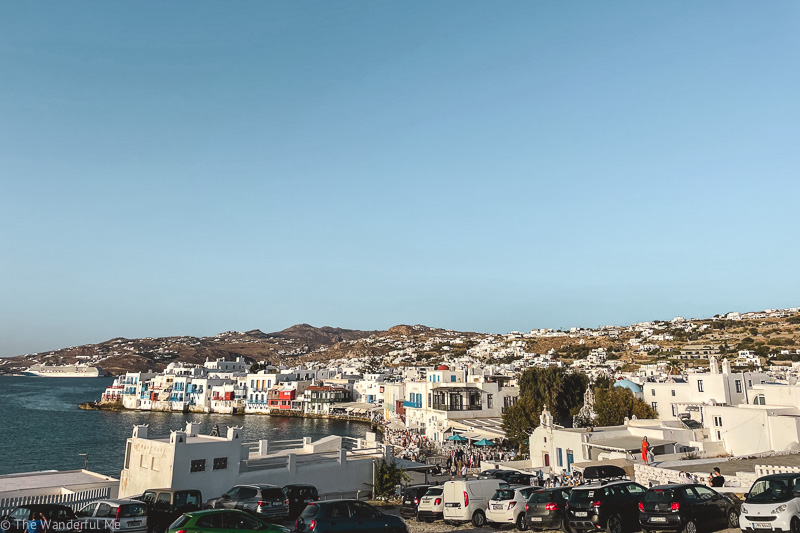
14-DAY GREEK ISLAND HOPPING ITINERARY
Without further adieu, let’s get into my all-encompassing 14-day Greek island hopping itinerary, shall we? Find out how to spend two weeks exploring Athens, Mykonos, Naxos, Paros, Milos and Santorini.
Here’s a quick summary:
Athens (2 nights)
Mykonos (2 nights), naxos (2 nights), paros (3 nights), milos (3 nights), santorini (2 nights).
My top recommendation is to use this Greek island-hopping itinerary as an outline and modify based on your unique travel style!
For instance, if you’re flying into Athens pretty early and will have nearly two days there, make the most of your first day and leave the next to give you one more night on an island!
Or if you want to skip super busy islands, like Mykonos, and focus on the more relaxed ones, like Paros, do it! This two-week Greece itinerary is just a guideline that you can adjust to your liking.

Athens is one of my favorite cities to visit in Greece! It’s also the easiest destination to fly into, especially if you’re coming from somewhere outside of Europe, as it has a well-connected international airport.
A ridiculously vibrant city, there are a ton of things to do in Athens, from exploring historic ruins and visiting the Acropolis museum to eating allllll the different types of food, wandering around markets, and experiencing one of its many rooftop bars.
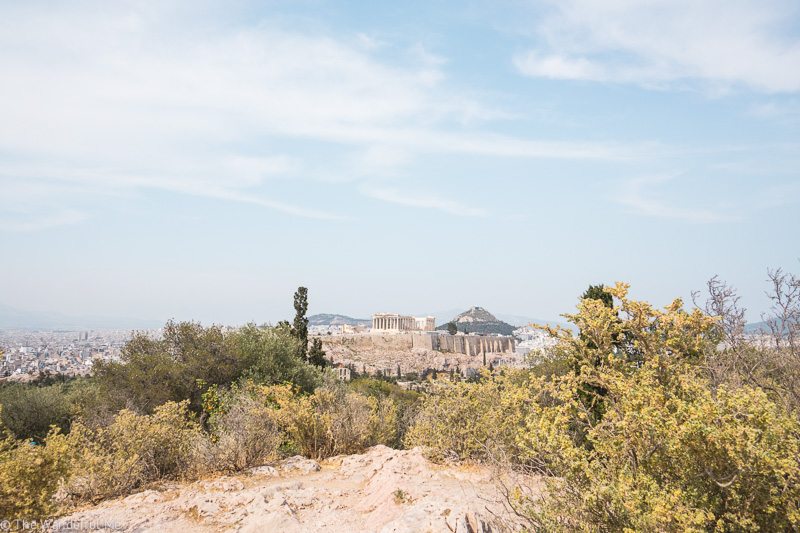
Best Things to Do in Athens
While I recommend checking out my blogs on the 13 best things to do in Athens and 5 ridiculously fun things to do in Athens , here’s a snapshot of some things to do with your one full day in the city.
- Visit the Acropolis and Acropolis Museum (take a peek at this guided tour !)
- Explore the many different historic ruins around the city
- Wander through the neighborhood of Plaka—don’t miss Brettos, the oldest distillery in Athens!
- Check out some of the markets (Monastiraki is great!)
- Try some cheap gyros (HIGHLY recommend Vegan Beat if you’re veggie !)
- Visit a rooftop bar during sunset (obvs one that overlooks the Acropolis)
Where to Stay in Athens
- Budget : Bedbox Hostel OR City Circus Athens
- Mid-Range : Phaedra Hotel OR Athens Residence Apartments
- Luxury : Acro Urban Suites OR A77 Suites
How to Get From Athens to Mykonos
Getting from Athens to Mykonos is a piece of cake! Personally, I book all my Greek ferries through Ferryhopper , which has a super easy-to-use app that holds all your e-tickets.
When booking a ferry from Athens to Mykonos, make sure to look at which ferry port you are departing from—it’ll either be Rafina or Piraeus . These two ferry ports are located on complete different sides of Athens so it’s crucial to plan accordingly!
Prices for ferries between Athens and Mykonos tend to hover between €40-90, depending on the speed of the ferry (speed boats cost more). The slow ferries take around 4-5 hours, while the speed boat can get you there in as little as 2.5 hours.
If you are short on time, it may be worth paying extra to get to Mykonos on a faster boat!
Use the little widget below to see how much a ferry from Athens to Mykonos will cost during your island-hopping trip in Greece.
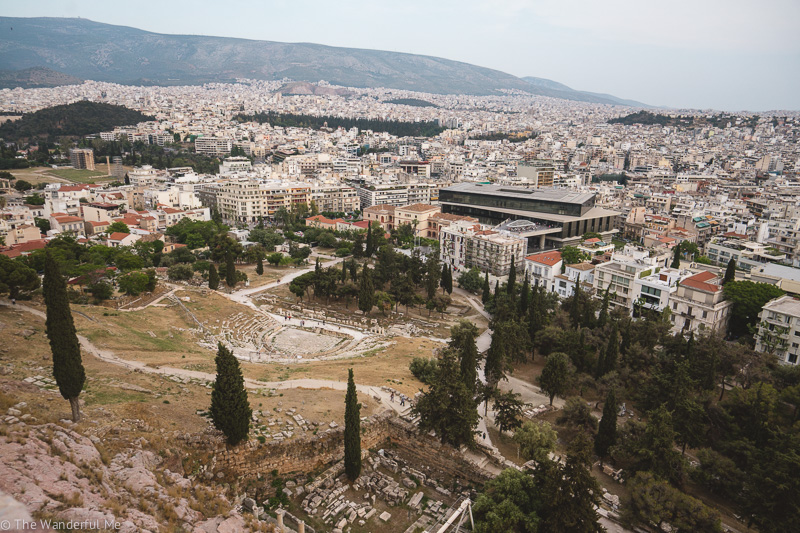
Aside from Santorini, Mykonos is arguably the most popular island in Greece! And after you explore its stunning white-washed villages, swim in its crystal-clear waters, take in its magnificent views and experience its nightlife, you’ll likely understand why.
While Mykonos isn’t my favorite island due to its expensiveness and excessive crowds, it definitely still has a lot to offer, especially when it comes to food and bar options.
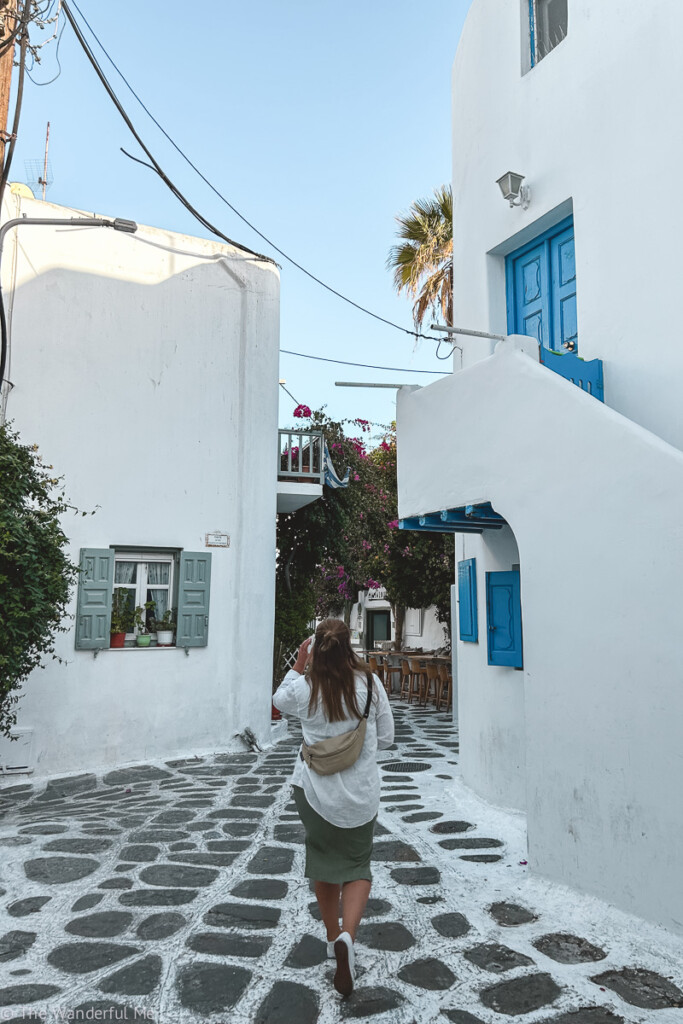
Best Things to Do in Mykonos
If you get an earlier ferry from Athens, you can have one and half days on this gorgeous island. With your time on Mykonos, I recommend you:
- Walk around Mykonos Town, featuring narrow streets, white-washed homes and cute shops.
- Visit “Little Venice,” a beautiful row of seaside homes surrounded by lots of restaurants and bars.
- Admire the view from the Mykonos Windmills (go for sunrise to avoid the crowds!).
- Shop till you drop at one of Mykonos’ many luxury stores.
- Check out the Church of Panagia Paraportiani.
- Soak up the sun on one of its many beaches—Paradise Beach and Paralia Kalo Livadi are popular!
- Visit the Archaeological Museum of Mykonos.
- Check out the Monastery of Tourliani.
- Explore the island on a guided highlights tour !
You can get around Mykonos either by bus, taxi, car, scooter, ATV, water taxi or foot! Personally, we got around via bus but I’m wishing we would have rented a car , scooter or ATV for more freedom on where to go.
Where to Stay in Mykonos
When visiting Mykonos on your 14-day Greece trip, I recommend staying in either Mykonos Town or Ornos ! While Mykonos town offers a ton of restaurant and bar options, Ornos has amazing beach access and stunning hotels.
- Budget : Studio Eleni OR Orpheas Rooms
- Mid-Range : Corfos Hotel OR Matogianni Hotel
- Luxury : Adorno Beach Hotel & Suites OR Semeli Hotel Mykonos
How to Get From Mykonos to Naxos
Getting the ferry from Mykonos to Naxos can be a super quick at only 30 minutes if you take the speed boat! The regular ferry takes around 1.5 hours but is about 60% cheaper, which is ideal for those traveling Greece on a budget.
Click here to view your ferry options and costs .
Since you will only have one day on the island of Naxos, I recommend getting the earliest ferry you can. This gives you more time on Naxos, which is a rather large Greek island!
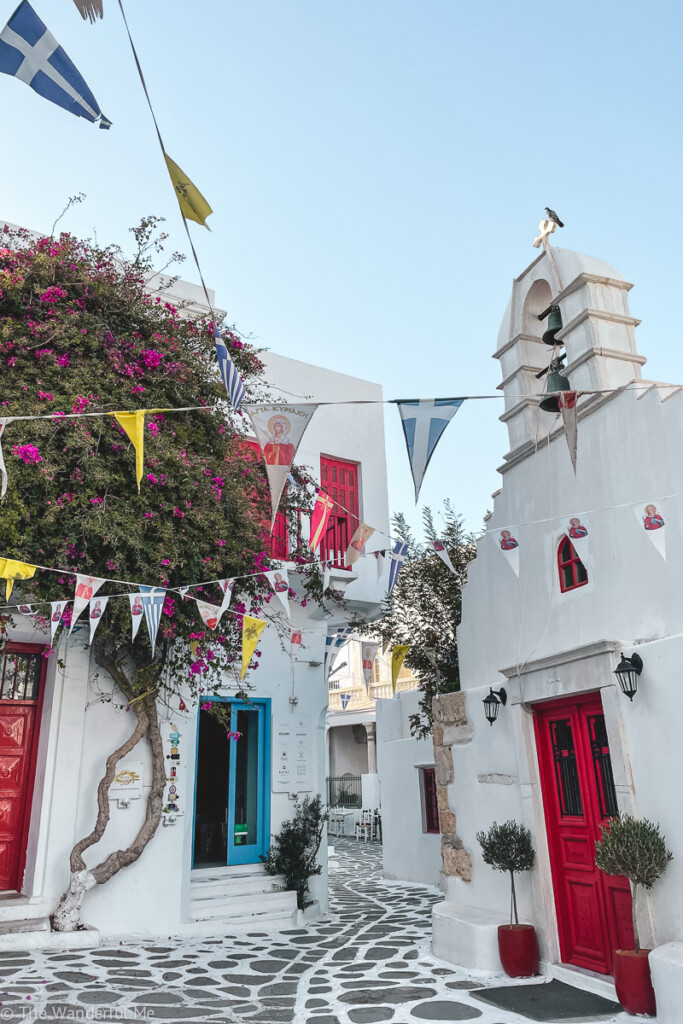
The largest of the Cyclades islands, Naxos features an incredibly hilly landscape, countless beaches with turquoise waters, a charming town with lots of great restaurants and shops, and the amazing Temple of Apollo that features stunning views.
Becoming more and more popular, especially among families, now is the time to visit Naxos before it gets too crowded! Here’s my top tips on how to visit Naxos and what to do when island-hopping in Greece.
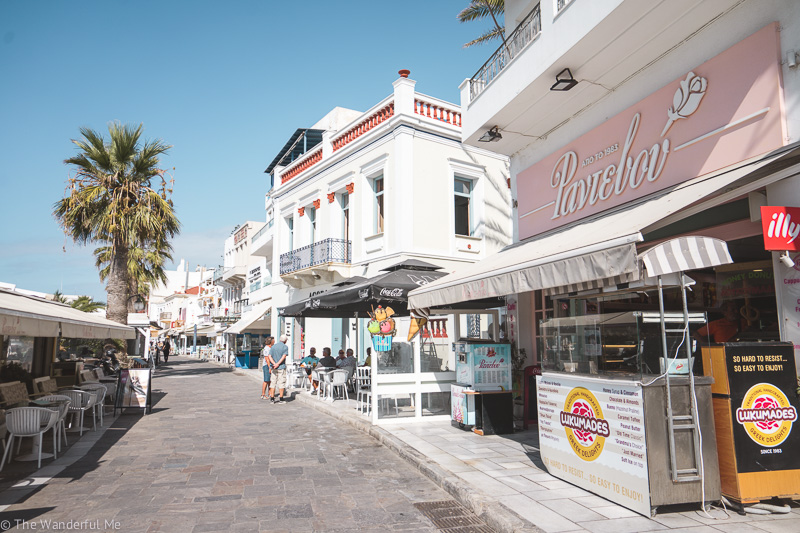
Best Things to Do in Naxos
Naxos is pretty big, so don’t expect to see all of it with only one full day on the island! That said, there are still so many things you can do to make the most of your time here.
- Visit the iconic Portara, a massive marble doorway dating back to ancient times, located at the Temple of Apollo.
- Walk up to the Kastro (Castle) of Old Town, built in the 13th century.
- Relax on the Naxos’ pristine beaches, like Agios Prokopios, Agios Georgios and Plaka.
- Hike to the summit of Mount Zas, the highest peak in the Cyclades, for breathtaking views.
- Experience traditional Greek cuisine at local tavernas and seaside restaurants.
- Windsurf or kitesurf (Naxos is known for being a very windy island).
- Explore the picturesque villages of Halki, Apirantho and Filoti.
- Visit Vallindras Kitron Distillery—kitron is a citron liqueur unique to Naxos island.
- Check out the oldest church on Naxos, the Church of Panagia Drosiani.
To make getting around Naxos easy, you can rent a car but public transport is also available.
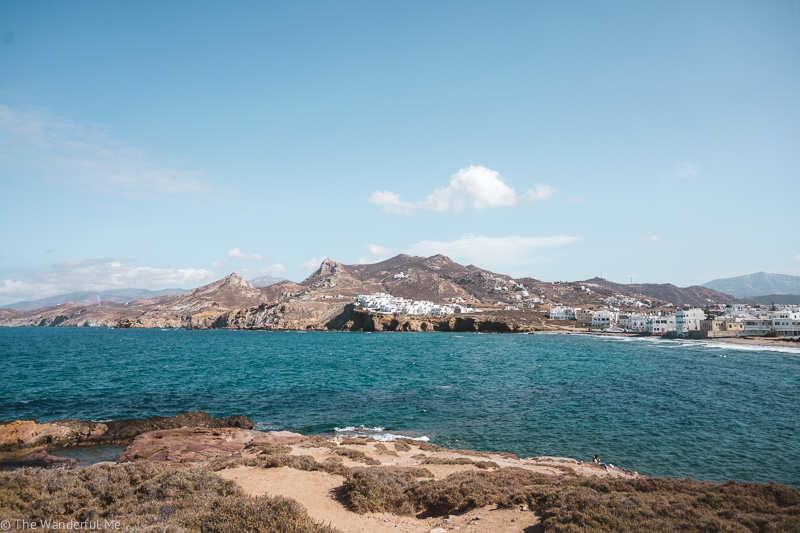
Where to Stay in Naxos
I recommend staying in Naxos town (Naxos Chora) ! This gives you access to tons of restaurants, shops, the castle, Temple of Apollo, Agios Georgos beach and the ferry port.
- Budget : Syrianos Hotel OR Kapetanos Rooms
- Mid-Range : Panormos Hotel & Studios OR Venetiko Apartments
- Luxury : Nissaki Beach Hotel OR Anapollo Boutique Hotel (Adults Only)
How to Get From Naxos to Paros
Next up on this 14-day Greek island-hopping itinerary is Paros, a personal favorite of mine! To get to Paros from Naxos, you’ll grab a short 30 minute ferry ride (if you take the speed boat). Prices for the Paros-Naxos ferry range between €15-35, depending on the type of ferry.
To see prices for your specific dates, use the handy Ferryhopper widget below.
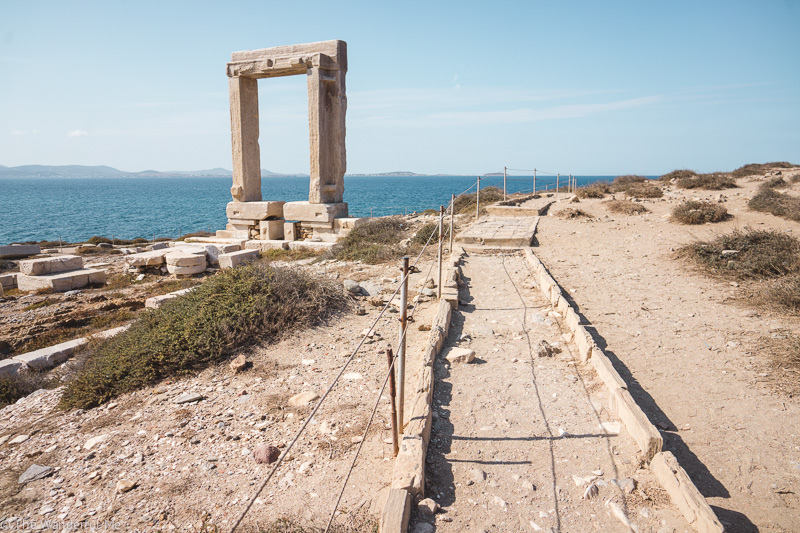
Paros is by far one of my favorite Greek islands due to its stunning beaches, beautiful villages, affordable prices and delicious restaurants! Plus, it’s super easy to get around via rental car or ATV, which I think is one of the best ways to explore the island.

Best Things to Do in Paros
- Visit the charming fishing village of Naoussa for its white-washed buildings and picturesque harbor.
- Explore the adorable villages of Lefkes, Kostos and Marpissa. (Lefkes is my fav.)
- Check out the historic Panagia Ekatontapiliani aka the Church of 100 Doors.
- Soak up the sun at the beach—Παραλία Φάραγκα, Kolympethres Beach and Paralia Parikia are popular but I can personally recommend Paralía Molos (small but insanely beautiful and quiet).
- Wander through the quaint, narrow alleys of Parikia, the island’s capital.
- Take a day trip to the gorgeous, uninhabited island of Antiparos. ( Check out this boat tour !)
- Eat your fill of local food at cute tavernas—try the slow-roasted chickpeas, a Paros delight!
- Visit the ancient marble quarries of Marathi and marvel at the colossal unfinished sculptures.
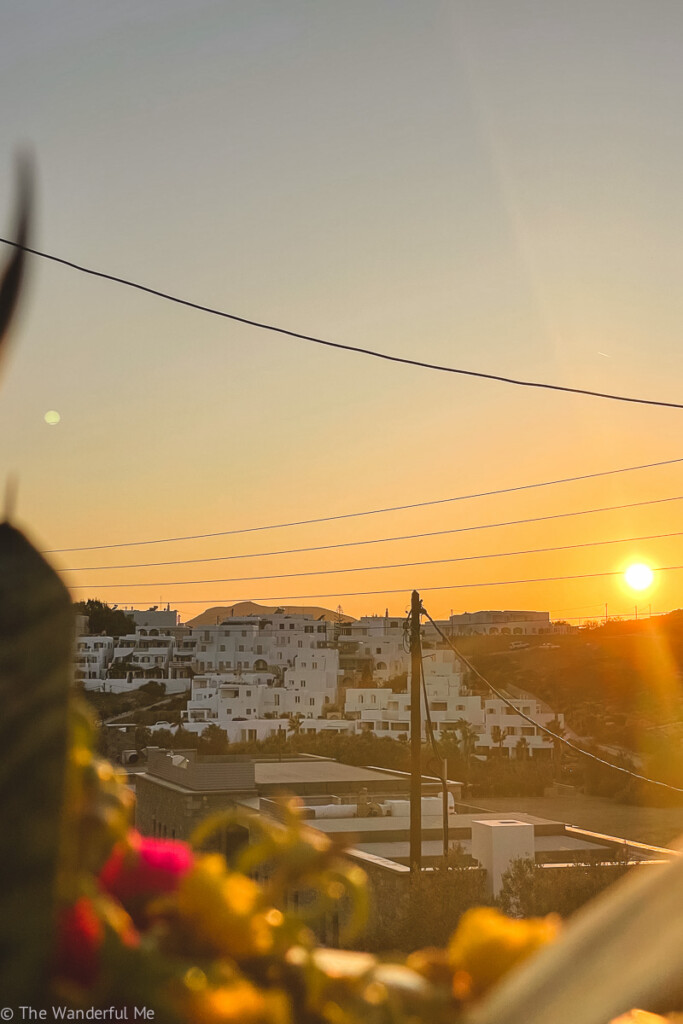
Where to Stay in Paros
I recommend staying in Naoussa , the cute seaside fishing village just north of Paros town! There are also some really gorgeous beaches around this area that are easily accessed via ATV or car.
- Budget : Katerina Rooms OR Liprando
- Mid-Range : Hotel Bilia OR Hotel Marinero
- Luxury : Sandaya Luxury Suites OR Lilly Residence-All Sea View Suites
How to Get From Paros to Milos
At just under two hours, the direct ferry ride from Paros to Milos is easy and efficient. However, note that while this ferry goes daily, it seems to only go in the evening (around 6 PM).
To view the Paros to Milos ferry schedule and prices, click here .
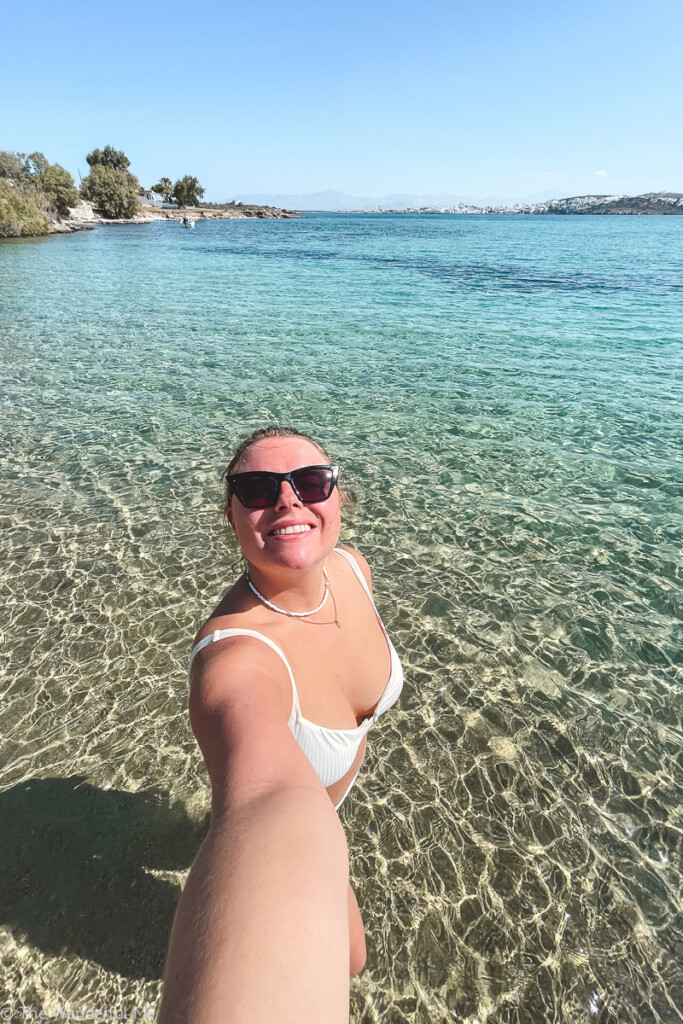
Milos is becoming more and more popular! With its otherworldly landscapes, bright blue waters, breathtaking beaches, classic Greek island experience, ancient ruins and white-washed villages that the Cyclades are known for, it’s no wonder that more travelers are flocking here than ever before.
I have no doubt that once you visit, Milos will rise to the top of your favorite Greek islands list!
Best Things to Do in Milos
- Marvel at the lunar-like landscape of Sarakiniko Beach and swim in its super blue waters.
- Explore the Catacombs of Milos, one of the largest early Christian cemeteries in Greece.
- Relax at Tsigrado Beach, a secluded paradise surrounded by cliffs.
- Wander through the picturesque fishing village of Firopotamos, as well as the stunning Plaka, Milos’ capital.
- Embark on a hike to the top of Profitis Ilias, the highest peak on Milos, for amazing panoramic views.
- Check out the Milos Mining Museum, chronicling the island’s mining history.
- Go on a boat tour around the island. (Take a peek at this highly-rated tour that has an open bar !)
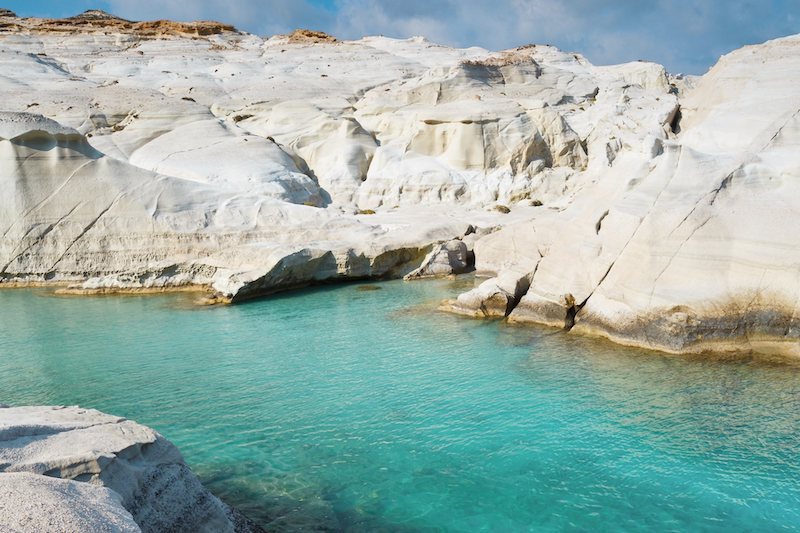
Where to Stay in Milos
When on the island of Milos, I recommend staying in either its capital, Plaka , or Adamantas (where the ferries dock). These are both well-connected to the rest of the island via local bus! Or you can get a rental car or ATV to get around.
- Budget : Arethousa OR Livanios Studios
- Mid-Range : Semiramis Guesthouse OR Piazza Castello
- Luxury : Arco Solium Suites OR Thalassitra Private Pool Suites & Spa
How to Get From Milos to Santorini
Onto your final island in this 14-day Greece itinerary—Santorini! Getting from Milos to Santorini is easy, as there is a direct ferry route that takes around 2 hours.
However, this is one of the most expensive ferry tickets at around €100 per person. That said, I think it’s definitely worth it, as Santorini is one of the most beautiful and unique Greek islands.
To view ferry times and prices for your dates, use the Ferryhopper widget below!
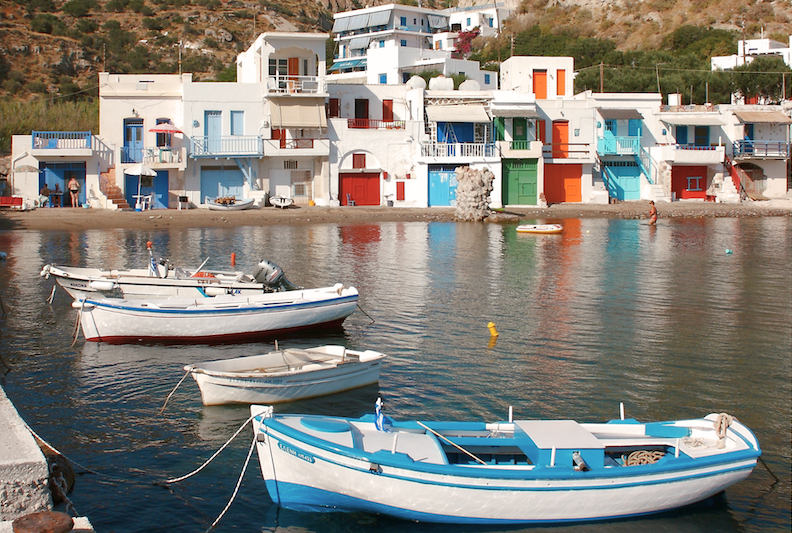
Santorini is arguably the most popular island in Greece, as its volcanic landscape, incredible views and stunning architecture draws millions of tourists each year.
From couples and families to solo backpackers, friends and everyone in between, Santorini truly offers something for every type of traveler.
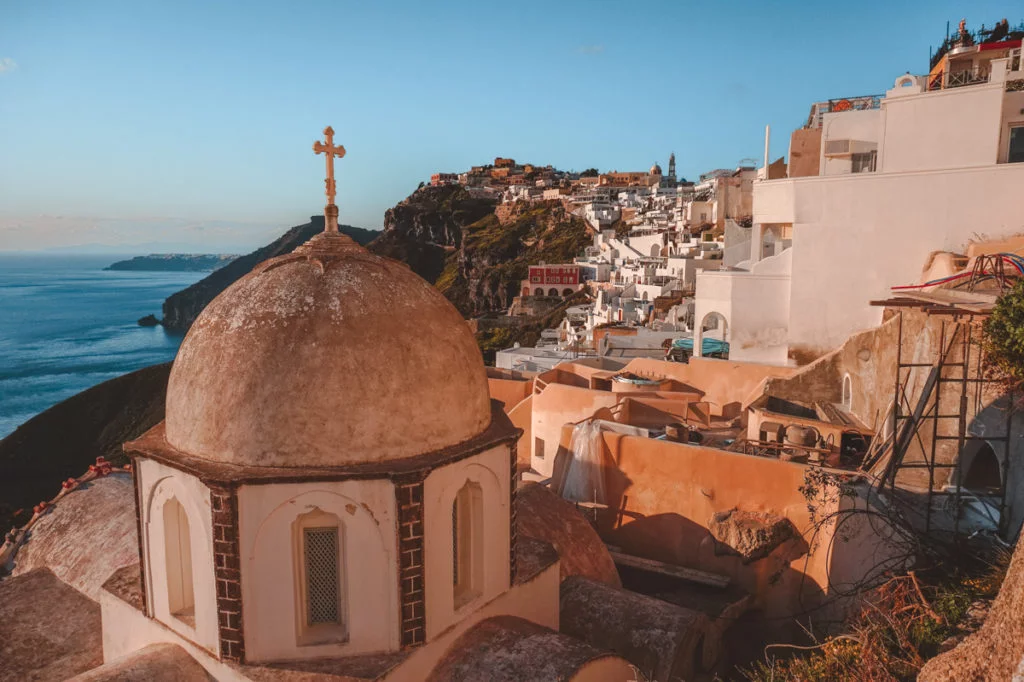
Best Things to Do in Santorini
There are many things you can do on Santorini with only one day! While not a ton of time, this island will no doubt blow you away.
- Watch the breathtaking sunset in Oia, known for its iconic views over the caldera.
- Take a boat tour or hike along the caldera rim for stunning volcanic landscapes. ( Check out this one !)
- Explore the ancient Minoan city ruins at Akrotiri, nicknamed the “Pompeii of the Aegean.”
- Relax on the unique red sands and clear waters of Red Beach or on the strange black sands of Perissa Beach.
- Go wine tasting in Pyrgos village, offering delicious local wines and panoramic views.
- Wander about Fira village’s charming alleys, boutiques and cafes.
- Soak in the natural hot springs near Nea Kameni.
For a more comprehensive Santorini travel guide that talks about how to get around the island and what to do with one day on the island, click here !
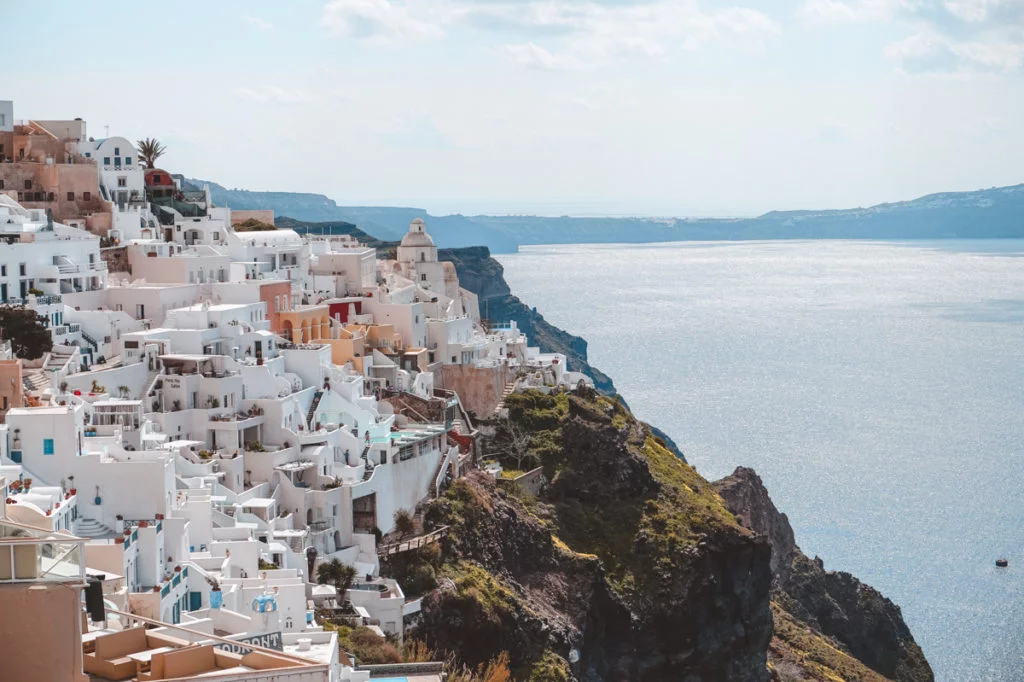
Where to Stay in Santorini
There are SO many accommodation options on Santorini! While many stay in either Fira or Oia , these villages can be super expensive, so I recommend Kamari or Mesaria if you’re on a budget.
- Budget : Oscar Hotel OR Villa Pelekanos
- Mid-Range : Gianna Suites OR Hermes Hotel
- Luxury : Abyss OR La Perla Villas and Suites
Where to Go After Santorini
Santorini has a really well-connected airport to both Athens and the rest of Europe—which is why this two-week Greek island-hopping itinerary ended here! My guess is you’ll likely fly back to Athens, where there are countless international flights to all over the world.
Alternatively, if you have more time in Greece, why not go to Crete? Crete is incredibly beautiful and also has two well-connected airports—Chania and Heraklion. It also has a direct ferry from Santorini .
To see what Crete is like, check out my blog on how I spent one week exploring Chania, Balos Beach, Loutro and Sougia .
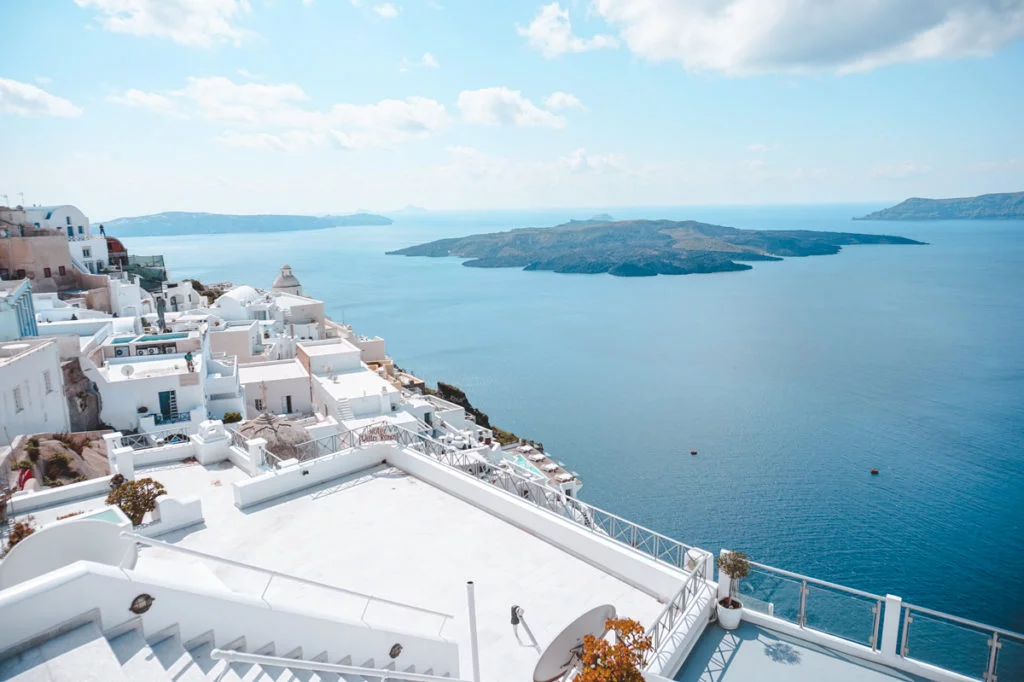
GREECE TRAVEL TIPS
Get travel insurance.
Travel insurance is incredibly important for staying protected while you’re exploring! In my personal—and sometimes controversial—opinion, I don’t think anyone should travel if they can’t include travel insurance in their overall budget.
Personally, I use either World Nomads, SafetyWing or Travelex travel insurance.
- World Nomads is for the more adventurous traveler who plans on doing a lot of activities, like hiking, ATV riding, scootering, swimming, boating and the likes. It also comes with your expected travel insurance coverage like trip interruption, baggage delay and medical stuff. A little bit more expensive but good coverage.
- SafetyWing is ideal for digital nomads who need both medical and travel insurance, like emergency dental, travel delay, baggage loss and unexpected medical treatment. This is ideal if you’re already traveling, as you can start a new plan from wherever (some travel insurances don’t allow this). It’s also pretty affordable.
- Travelex is your classic travel insurance built for the everyday American tourist. It covers you for trip cancellation and interruption, trip delay, emergency medical and dental, missed connections and baggage loss or damage.
Book Tours in Advance
Greece can—and does—get incredibly busy, especially during the summer! I recommend you book all tours in advance to ensure you get to do everything you want. This includes things like boat tours (a must do in my opinion), city tours and island tours.
When searching for tours in Greece, I tend to always book with GetYourGuide . There’s always a ton of options and they’re rated by real travelers.
Buy Ferry Tickets Early
It’s an absolute MUST to buy ferry tickets in advance if you’re island-hopping around Greece during the summer months! Ferry tickets can sell out quick and if there’s only one ferry going per day (like from Paros to Milos), then you’re out of luck if they run out.
Again, I recommend using Ferryhopper to buy and hold your Greek ferry tickets. The app is super easy to use, too.
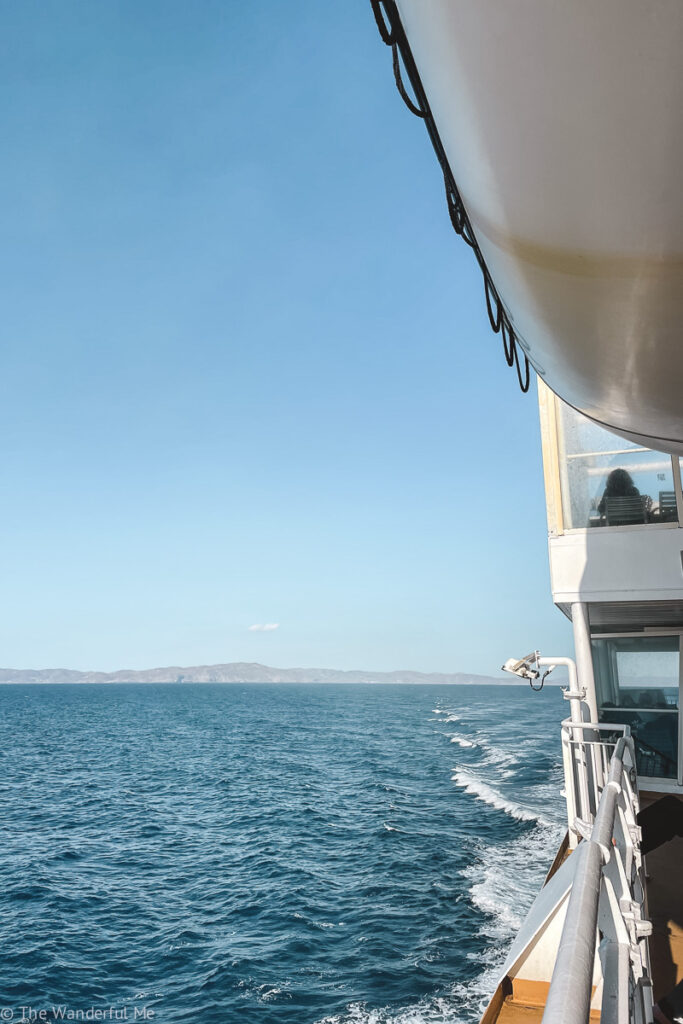
Book Local Accommodation
Forget inauthentic chain hotels like Best Western, Hyatt and Hilton—book local accommodation where you will not only be supporting the local economy, you’ll also have a far better experience.
For instance, when I stayed at Katerina Rooms in Naoussa, Paros, the lovely lady who runs the place brought us little local treats every morning, like loukoumades, warm sweet rolls and fresh orange juice! It was so cute.
Personally, I always book with Booking.com , as I find it has the best prices (especially when you’re on a mobile device or you’re part of the Genius program where you get 10% off).
To explore your local hotel options for Cyclades island hopping, click here .

GREECE FREQUENTLY ASKED QUESTIONS (FAQS)
What is the best greek island hopping route.
As you can guess, I recommend my 14-day Greek island hopping itinerary explained above! The route goes from Athens to Mykonos, Naxos, Paros, Milos and Santorini, all of which have direct ferry connections between them, making it super easy to follow.
You also have at least one full day on each island, which I think is enough time to get a feel for the uniqueness of each destination. (These islands aren’t massive.)
However, if you want to check out lesser-visited Greek islands, I recommend swapping out Mykonos for Syros and Naxos and Santorini for Crete. Here’s an example of what that Greek island hopping itinerary could look like:
- Athens – 2 nights
- Syros – 2 nights
- Paros – 3 nights
- Milos – 3 nights
- Crete – 4 nights
If you have a specific Greek island hopping route you want some feedback on, ask in the comments below!
Is Greece cheap for travelers?
Yes… and no. As with many destinations, Greece caters to both budget and luxury travelers.
However, there is a pretty wide range of prices across the Cyclades, as you will find that islands like Paros and Naxos are more affordable than Mykonos and Santorini.
For budget travelers, like budget backpackers, you can find affordable hostels and hotels that start around €30-40 per person. Hotels are cheaper if you are splitting with someone, as many local hotels start at €50-70 per night.
With regards to food, I find that Greece has some of the most affordable food prices out of most European countries, especially if you are eating vegan and vegetarian food like me. Generally, you can find eat a cheap lunch or dinner at a local taverna for around €15-20 per person.
How much money should I save for two weeks in Greece?
For this 14-day Greek island hopping itinerary, I recommend saving at least $2,000 (around €1,800 and £1,600). This is per person and does not include the cost of your flights, as I don’t know where you are coming from.
If you’re a semi-budget traveler like me—one who likes to stay in affordable hotels but occasionally indulges in luxury and drinks pretty regularly (e.g. glass of wine at dinner)—then this should be more than enough for your Greece trip.
On the flip side, if you’re more of a luxurious traveler who is here to have a good time on a once-in-a-lifetime Greek island hopping trip, then I recommend saving at least $4,000.
Beautiful, 4- and 5-star hotels in Greece tend to hover between €250-1,000+, depending on which island you’re visiting. As you can imagine, the luxury hotels in Santorini are the most expensive (but also the most extraordinary).
Food at high-end or very popular, highly-rated restaurants (like those with a good view) tend to have main dishes ranging from €20-50. Local seafood dishes seem to cost the most.
Can Greece be traveled on a budget?
Yes, absolutely! I have traveled to Greece every year over the last three years and each of those times were on a budget. Here are my tips for traveling Greece on a budget:
- Travel during off or shoulder season —this is by my money-saving tip that’ll make the biggest difference, as high season comes with high prices no matter where you go.
- Stay at local hotels or hostels and split your accommodation costs with another person.
- Choose small, local tavernas —these can often be found away from the main tourist area.
- Pick up breakfast items from the local grocery store or bakery and eat it at your hotel in the morning.
- Grab a small lunch from a local gyro shop, bakery or street vendor.
- Book your ferries in advance to get the best prices (I use Ferryhopper ).
- Use public transportation , like local island buses—renting a car or an ATV can be expensive (an ATV rental on Paros costs around €80-100 for the day).
- Avoid tourist traps like expensive souvenir shops, scams and sketchy tours.
- Carry a reusable water bottle to avoid paying for water—I love my GRAYL filtering water bottle, as this allows me to drink tap water on any island, even if it’s not recommended. Find it here on the GRAYL website or on Amazon .
- Negotiate prices for things like tours and souvenirs, especially at markets and when you’re offered a tour on the streets of Greece. (Don’t do this if you’re in a store or something—that’s tacky.)
For more tips, check out my blog on 25 things you should know before traveling to Greece .

What are the best Greek foods to try?
As a vegan, I have SO many food options in Greece! It’s amazing and why Greece is one of my favorite European countries. Personally, I think every traveler should try:
- Dolmades (stuffed vine leaves)
- Gemista (stuffed tomatoes and peppers)
- Melitzanosalata (smokey eggplant dip)
- Hummus (creamy chickpea dip)
- Fasolada (hearty white bean soup)
- Spanakopita (savory spinach pie—often made with feta but not always)
- Briam (roasted vegetable casserole)
- Fava (creamy split pea or lentil dip)
- Athoi Gemistoi (stuffed zucchini flowers)
- Stewed chickpeas (Cyclades local dish)
- Loukoumades (sweet Greek donut balls)
If I had to choose my favorites, it would be gemista, stewed chickpeas and fava with warm bread!

Do you tip in Greece?
Usually, but this depends on the situation. Tipping in restaurants is very normal and often expected, but not the same amount as you would in America!
Often, it’s only around 5-10%—I just round up the bill to make it easy. For instance, if your bill came to €37, you would just round it up to €40. That said, a service charge (aka a tip) is sometimes included in the bill, so make sure to check before tipping!
Tipping in cafes and bars, as well as taxi drivers, hotel staff, tour guides and drivers, is appreciated but not required or expected.
Are there any Greek customs I should know?
For sure! One thing you will notice when visiting Greece for two weeks is how hospitable and welcoming Greeks are. They are incredibly kind and will go out of their way to help you. (That said, I did get stared a lot in Greece by older men but I think that’s just the norm.)
Additionally, Greece is a very religious country, and many customs and traditions are associated with the Greek Orthodox Church. When visiting a church or monastery, show your respect by wearing modest clothing and refrain from swearing or loud behavior.
When you’re at dinner, you may be given ouzo or raki, both of which are often served as a complimentary aperitif before a meal or as a digestif after a meal. If you’re offered ouzo or raki, it’s polite to accept and enjoy the drink as a gesture of goodwill and friendship!
I definitely recommend trying it! Though not for everyone, these two alcohol beverages are made from distilled grapes and are very common throughout Greece. Raki is more so found around Crete but ouzo is found nearly everywhere in Greece.
Also, don’t forget to say “yamas!” Or cheers in Greek before taking your first sip of ouzo or raki!
Lastly, when island-hopping around Greece for two weeks, you may notice how expressive and passionate the Greeks are. Don’t be surprised if you find Greeks stand closer to you or touch your arm during conversation—it’s a sign of friendliness and engagement!
Which words should I know for my two-week Greek island-hopping trip?
There are a few Greek words that every traveler should know before going to Greece! These include:
- Ne — “yes”
- Ohi — “no”
- Yassas — “hello” or a casual greeting
- Kalimera — “good morning”
- Yamas — “cheers!”
- Efharisto — “thank you”
- Parakaló — “please” or “you’re welcome”
Watch this video on YouTube to see how these Greek words are pronounced!
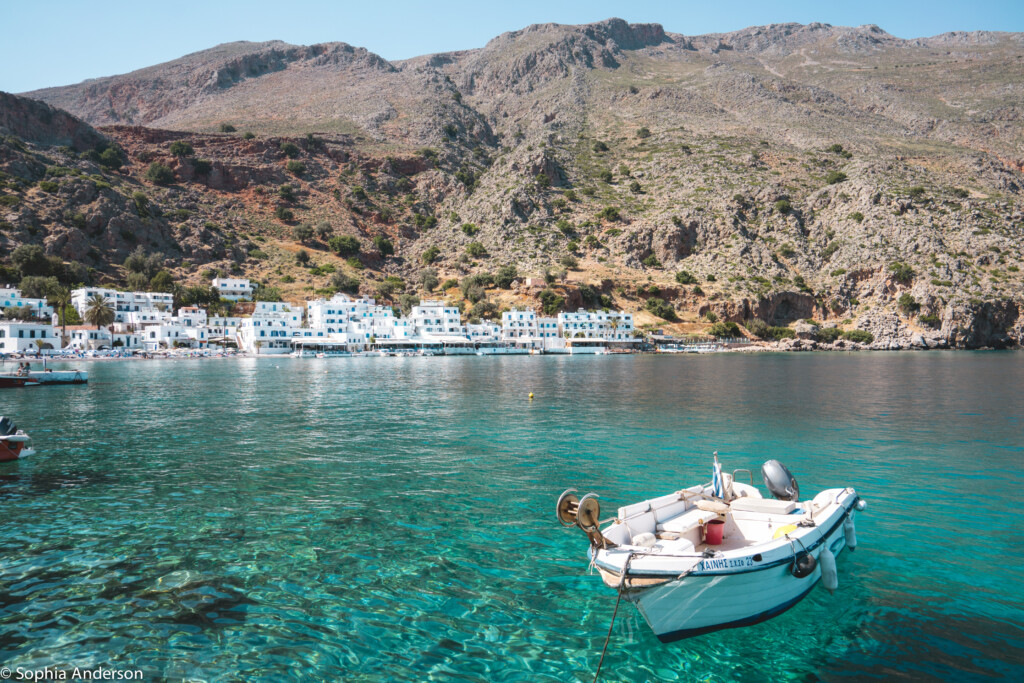
What are lesser-visited Greek islands?
If you’re interested in visiting a few lesser-known Greek islands, I’d highly recommend Syros, Sifnos, Kithnos or Folegandros.
Syros, in particular, is lovely due to its more colorful buildings—think pastel pinks and yellows and varying shades of red, blue and white. It’s also known as the capital of the Cyclades, so it’s super easy to get to from Athens, Myknonos, Naxos and Paros.
Additionally, Crete is another really great island, which can be reached via direct ferry from Santorini, Naxos, Milos and Paros.
It’s the largest Greek island, so it’s really easy to escape the crowds and find some hidden gems. Plus, I have found that it’s one of the more affordable Greek islands, as there is a wide array of accommodations, restaurants and things to do.
Get inspired to travel to Crete by reading my blogs on visiting Chania, Sougia and Loutro ; visiting the incredible Balos Beach ; and staying at the sensational Monastery Estate Retreat Hotel .
Is Greece worth the hype?
Yes, yes and heck yes. Greece is one of my favorite countries due to its friendly locals, delicious food, gorgeous landscapes, amazing beaches and wide array of Greek islands that offer very different experiences.
If you plan on island hopping around Greece for two weeks, you will not regret your trip! It’ll arguably be one of the best things you have ever done (especially when done right).

With that said, I hope you got some value and inspiration from this 14-day Greek island hopping itinerary! If you have any questions about traveling or backpacking Greece, don’t hesitate to ask them below in the comments. 😊
Safe travels,
Not sure what to check out next? Readers love these posts:
25 important things you should know before going to Greece
- 11 essentials to pack when traveling to Europe for the first time
- Spending 4 days on the captivating island of Corfu, Greece
- 20 simple ways to practice ecotourism & be a more green traveler
- 10 airport travel tips all flyers should know
- What to pack for Greece in the Spring
Love this post on the best 14-day Greek island hopping route? Pin it!
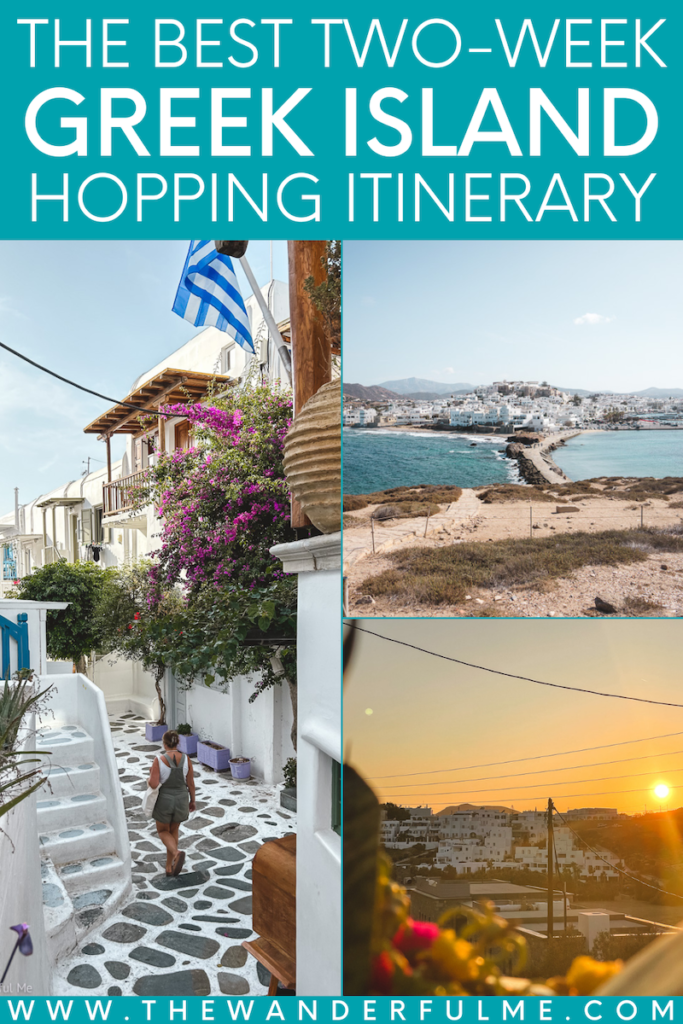
As mentioned above, this post contains affiliate links. Which means if you make a purchase through the links, this site receives a small commission at no extra cost to you. Read our full disclosure here .
Related Posts

Visiting Balos Beach on the Greek island of Crete
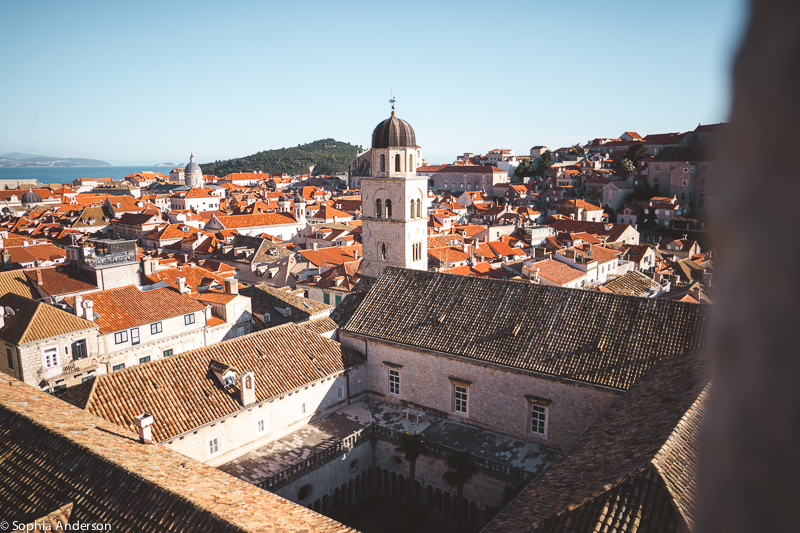
Discovering the Adriatic gems of Dubrovnik, Kotor and Budva
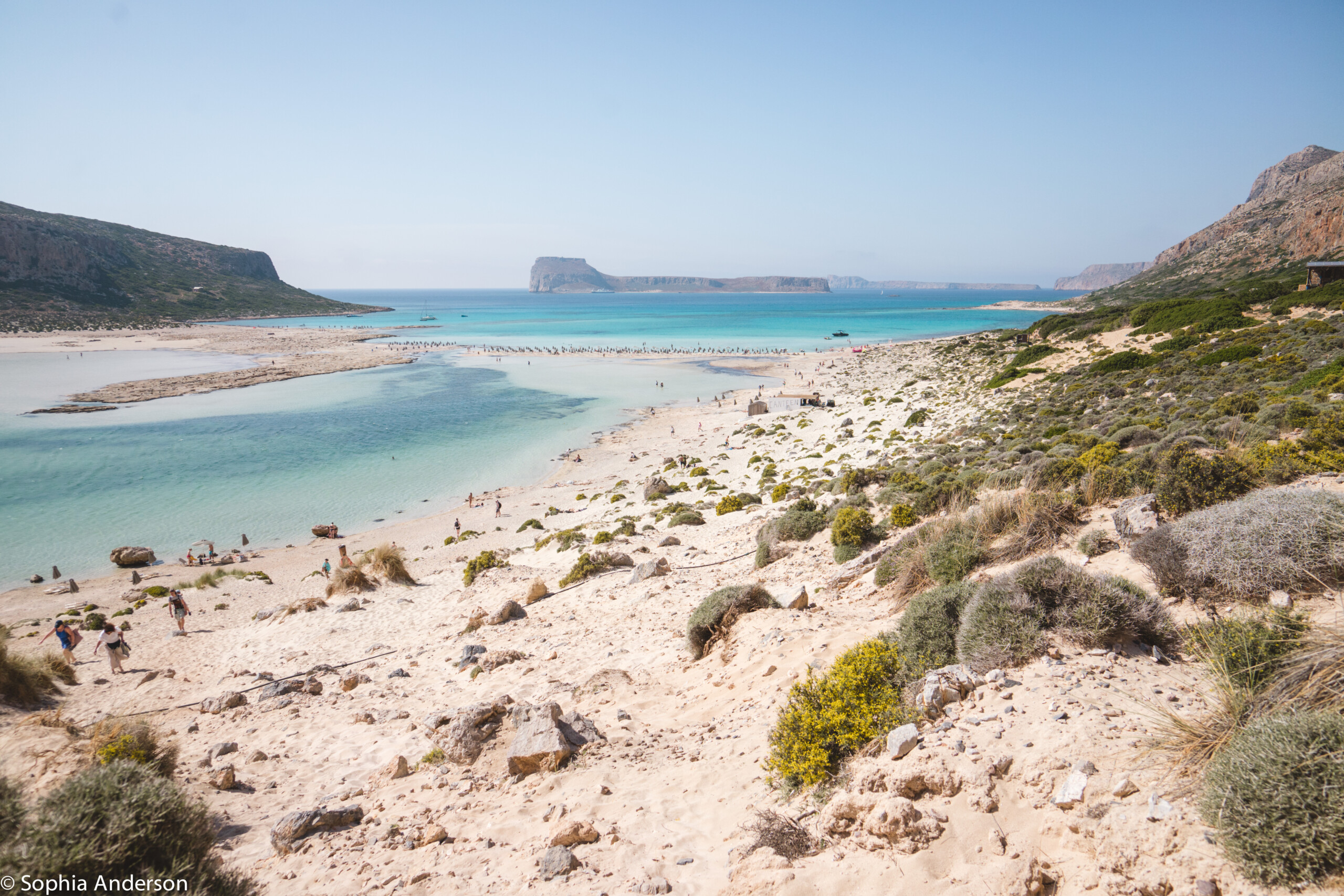
Leave a Comment Cancel Comment
Sign me up for The Wanderful Me newsletter!
This site uses Akismet to reduce spam. Learn how your comment data is processed .
- Search Please fill out this field.
- Manage Your Subscription
- Give a Gift Subscription
- Newsletters
- Sweepstakes
- Destinations
Everything You Need to Know to Plan Your Perfect Greek Islands Vacation
From choosing the right hotel to getting around, here's how to plan the ultimate island-hopping adventure in Greece.
Planning a trip to the Greek islands can be intimidating, even for the most seasoned travelers. With more than 200 inhabited isles (and about 6,000 islands and islets in total), the magnitude of the archipelagos is astounding. Each has its own character and aesthetic, from Cyclades islands dotted with white-and-blue houses to the lush and green Ionian Islands to the castle-lined Dodecanese.
Overall, Greece has six main island groups, plus a significant stand-alone: Crete. It's generally easiest to travel between islands within one group than to hop between archipelagos. In this guide, we'll break down the best Greek islands to visit, including what each island group is known for, and how to travel within each archipelago.
Getting Around the Greek Islands
While many of the Greek islands have airports, not all of them have international terminals. Many are serviced solely by domestic carriers like Aegean Airlines , and you can only fly from neighboring islands or Athens. However, some of the most popular islands (including Crete and Santorini) have international airports, where you can fly directly from cities in Europe or the Middle East.
Traveling by ferry simplifies island hopping, especially if you're just exploring one archipelago. In the Cyclades, Seajets is the high-speed ferry, though travelers can find all options (including less expensive ferries) via Greek Ferries . It is possible, of course, to rent a car in Athens — or on one of the islands — and drive it onto the ferry, essentially turning your island-hopping excursion into a seafaring road trip. However, it's easy to rent a car on the islands, too, provided you have an international driver's license with you.
When to Visit the Greek Isles
May, June, and late September are great times to travel if you're looking for nice weather but still hoping to avoid the crowds. The high season (mid-June to mid-September) offers more ferry routes, flight options, and open restaurants and beach bars, but it also means more tourists and higher prices. Each island group has its own weather to look into — Crete is warmest year-round, making it a great choice for late fall or winter. And while some Greek islands, such as Hydra, are full of locals and see tourists year-round, others, such as Santorini, get very quiet in the off-season (November to March). Here, we've put together an overview of each group of islands (and the highlights of each archipelago) to help you plan your next Grecian adventure.
The Cyclades Islands
Monica Farber/Travel + Leisure
This archipelago is the most common first stop for American travelers in Greece, with two of the most-visited islands: Mykonos and Santorini. A group of about two dozen inhabited islands (and 220 total isles), this bunch looks like all the postcards of Greece you've seen: white churches with blue domes and pink bougainvillea vines shading secluded side streets.
Mykonos is known for its nightlife and see-and-be-seen beaches, but it also has a gorgeous Cycladic village in its center, with windmills and winding lanes designed to confuse pirates centuries ago. Home to an array of top-notch hotels , Santorini is romantic and luxurious, beloved by honeymooners lounging in their private pools overlooking the caldera. For those looking for alternatives to Mykonos and Santorini, options abound. Up-and-coming Milos has otherworldly beaches and the famed sea caves, Tinos is the site of a famous Church of the Virgin Mary, and the rustic Lesser Cyclades (Koufonisia, Donousa, Schinoussa, and Iraklia) are great for camping. There are large islands, like Naxos and Syros, the archipelago's capital, and tiny ones with very little tourism, like Sikinos.
How to Travel the Cyclades Islands
The tourist season on the Cycladic islands runs from mid-April to mid-October (peaking in June, July, and August). If it's your first time in the area, you'll want to start by visiting Mykonos or Santorini. On Santorini, you'll find great wineries, like Venetsanos and Santo , while on Mykonos, it's the nightlife that will keep you coming back, with iconic clubs like Scorpios and Super Paradise Beach Club . When exploring some of the smaller islands, like Ios, Folegandros, and Milos, swim, snorkel, and wander the fortress-like capital of each island. The cobbled alleyways are home to shops, galleries, bars, and tavernas (on most islands the main town is called "Chora"; on Milos, it's "Plaka"). And don't miss sailing adventures around the Cycladic islands — look into companies like Polco Sailing on Milos and Sunset Oia Cruises on Santorini.
Where to Stay
On Santorini, start your trip by staying amid the iconic white-and-blue cliffside houses of Oia at Andronis Luxury Suites . Next, move along the caldera to the village of Imerovigli, where you'll find some of the most over-the-top and romantic hotels, including Andronis Concept Wellness Resort and Grace Hotel, Auberge Resorts Collection . Finally, stay a night in the old town of Pyrgos at Santorini Sky .
On Mykonos, start your vacation at The Wild Hotel by Interni , which has a luxurious boutique atmosphere and a private beach for guests. For an ideal honeymoon in Greece , spend a few exceptionally romantic nights at Kalesma Mykonos , where each suite has its own infinity-edge pool.
Elsewhere in the Cyclades, look for luxury boutique hotels (many, like The Wild and Kalesma, are family owned). Try Milos Breeze on Milos, Coco-Mat Eco Residences on Serifos, Calilo on Ios, and the Naxian Collection Luxury Villas & Suites on Naxos.
The largest Greek island (and the southernmost, roughly halfway between Europe and Africa), Crete could be its own country. Because there's so much to explore, many travelers focus their energy on the 160-mile-long island rather than straying to other archipelagos.
How to Travel on Crete
The island has two main airports, making Crete very easy to get to from Athens. Once you're on the island, it's a good idea to rent a car; it takes about six hours to drive from one end of Crete to the other.
The island boasts some of the best beaches in Greece , including Elafonissi, with its unparalleled pink sand, and Elounda, known for its five-star beach clubs. Hike the Samaria Gorge (which takes five to seven hours through streams and between cliffs), or walk through wildflowers along paths in the mountain villages. Visit the ruins of the Knossos Palace, home of the Minoan empire (and the dreaded Minotaur monster), and the Boutari Winery if you're interested in sampling Cretan wines. Finally, if you have time for a day trip, the isle of Spinalonga, off the coast of Elounda, is worth visiting for its wild beauty and tragic history — it was home to a colony of people affected by leprosy until 1957.
Where to Stay on Crete
With picturesque olive groves sloping down to sandy beaches, Elounda has become something of a Cretan Riviera. This stretch along the island's northeast coast is lined with swanky resorts including Crete's only Relais & Chateaux property, the Elounda Mare , and the contemporary Cayo Exclusive Resort & Spa .
Outside the island's capital city of Heraklion is the family-friendly five-star beachfront resort Amirandes , part of the national Grecotel chain (take a detour to have dinner on their farm, Agreco ). Moving west, you'll find the well-preserved Venetian town of Rethymno, and more historic boutique hotel options like Kapsaliana Village Hotel , built around an 18th-century olive oil mill, and Casa Delfino , a renovated 17th-century mansion inside the walled old town of Chania.
Saronic Gulf Islands
The closest island group to Athens is also home to some of the most scenic, under-the-radar isles. Hydra, Spetses, Poros, Aegina, and little Agistri are popular with Greek weekenders and European visitors but are less known to Americans.
How to Travel the Saronic Gulf Islands
The Nantucket of Greece, car-free Hydra is tiny but mighty. Spetses has green pine trees, yachts parked in the harbor, and traditional horse-drawn carriages along its waterfronts. Family-friendly Poros, with tree-shaded beaches and a charming town dominated by a clock tower, is popular among sailing aficionados. Aegina, the closest island to Athens, has a large port town, sandy beaches, and the ancient Temple of Aphaia dedicated to the goddess of Athena. Because the Saronic Gulf islands are so close to Athens, getting here is simple — a hydrofoil from the port of Piraeus ferries you from Athens to each of these destinations.
Hydra and Spetses are brimming with converted captains' homes (we like the Cotommatae on Hydra and Orloff Resort on Spetses). On Poros, Sto Roloi is a collection of traditional island houses turned into holiday villas, while Sirene Blue Luxury Beach Resort offers plush suites and villas with access to swimming pools and a private beach. Renting a villa through Five Star Greece is also an option, especially on Aegina where weekend homes outshine the hotels. The crown jewel of the Saronic Gulf is Spetses' harborfront Poseidonion Grand Hotel, established in 1914, which is just as lavish as its name suggests.
The Ionian Islands
Irjaliina Paavonpera/Travel + Leisure
Lush and green, the Ionian Islands (also known as "Eptanissia" or the "seven islands") offer unique local culture, music, art, cuisine, and architecture. While the Ionians are known, first and foremost, for Corfu, the six other main islands hold their own and attract their fair share of tourists, too.
How to Travel the Ionian Islands
On Corfu, you'll want to wander the streets of the island's UNESCO-protected Old Town . Near Corfu, tiny Paxos is covered in olive trees, with three charming bays and a satellite island, Antipaxos, known for its translucent waters. The largest of the Ionian Islands in size, Kefalonia is one of the most beautiful places to visit in Greece and has semi-wild horses running around Mount Ainos in its center. Zakynthos is home to Navagio Beach (also known as Shipwreck Beach), accessible only by sea, and iconic blue caves you can swim through. Lefkada, connected to the mainland by a bridge, has woodland villages and some of Greece's best beaches along its shores. Small Ithaka, known to Homer fans as the home of Odysseus, is still relatively undiscovered. Finally, Kythera is the outlier — it looks more Cycladic than Ionian and is more easily reached from the Peloponnese.
Corfu, Kefalonia, Zakynthos, and Kythera all have airports, which receive domestic flights from Athens as well as international charters and airlines.
On Corfu, options range from stylish seaside resorts like the Grecotel Corfu Imperial to historic 18th-century estates in the Tuscan-like interior such as the Pelecas Country Club . Near the Old Town, the first Banyan Tree Hotels & Resorts property in Europe, Angsana Corfu , offers a gorgeous seaside enclave with 159 rooms and lavish pool villas.
On Kefalonia, the ultra-modern Tesoro Blu is an adults-only oasis just outside the village of Skala, and the Emelisse Nature Resort is a gem outside the picture-perfect town of Fiscardo. Its sister property on Ithaka, the Perantzada , is a contemporary hotel within a 19th-century mansion on the harbor in Vathy. Little Paxos is all villa rentals and rooms to rent except for a few intimate hotels, like Agali Hotel Paxos and Paxos Club Resort & Spa . On Zakynthos, Porto Zante Villas & Spa is a swanky oasis on the busy eastern coast, and in the quiet north of the island, near the blue caves, Nobelos is a four-suite, family-run hotel beloved for its organic restaurant.
The Sporades Islands
There are 24 of these green islands off of the northeastern coast of mainland Greece, but only four are inhabited — and if you've seen "Mamma Mia , " you know what they look like. Dark green pine trees, white churches, and lots of sand, rocks, and singing. It's all part of the Sporades experience.
How to Travel the Sporades Islands
Buzzy Skiathos is famous for its gold-sand beaches and nightlife, while low-key Skopelos is a natural paradise of white pebble coves, oak forests, monasteries, traditional villages, and lots of shipwrecks off the coast in the National Marine Park of Alonissos and Northern Sporades . Alonissos is at the center of the National Marine Park, a great base for fishing, bird-watching, and spotting the protected Mediterranean monk seal. Finally, Skyros is known for its ceramics and local crafts, churches, and gorgeous Chora, a mountaintop capital crowned by a Venetian castle.
To get to the Sporades, you can fly directly from Athens to Skiathos and Skyros. Skiathos is also served by a ferry from Thessaloniki. In summer, hydrofoils sail to all four islands from the port of Agios Konstantinos on the mainland. You can travel between the islands by ferry or private boat.
On these four islands, tourism is all about sailing, swimming, mountain biking, sea kayaking, and hiking. Hit the beaches — Skiathos's swanky Ambelakia to see and be seen, Skyros's Kalamitsa for wind-surfing, Skopelos's Hovolo for pine-scented breezes. Above all, do not miss sailing, swimming, or scuba diving in the marine park.
There are villas to rent all over the islands (like the ones with private pools run by Poikilma Villas on Alonissos). For a more full-service hotel, try the family-run Atrium Hotel above Agia Paraskevi beach in Skiathos, or the Adrina Resort & Spa on the beach in Skopelos.
The Northeast Aegean Islands
This collection of more than a dozen islands (the five most notable being Ikaria, Samos, Lemnos, Lesvos, and Chios) is the area of Greece closest to Turkey. For your journey here, you'll be richly rewarded with incredible beaches and natural wonders (a petrified forest on Lesvos, volcanic rocks and sand dunes on Limnos, and thermal springs on Ikaria).
How to Travel the Northeast Aegean Islands
Lemnos, Lesvos (also known as Mytilene), and Samos all have international airports, and Chios and Ikaria have domestic ones. There are several ferries from the port of Piraeus in Athens that can take you to these islands as well.
Visit the archaeological sites of the Temple of Hera on Samos, the acropolis on Thassos, the ancient city of Ifestia on Lemnos, and the magnificent castle atop Lesvos. While these islands are famous for their history, they're also known for their water sports. Keros Beach on Lemnos is one of the best places to kite- or windsurf in Europe. As for swimming, it's hard to beat the Seitani coves on Samos, Kipos beach on Samothrace, white-sand Seychelles on Ikaria, and Vatera on Lesvos.
Time-travel back to when Genovese nobility ruled Chios and stay at the majestic Argentikon Luxury Suites in a 16th-century estate. Sleep above popular Tsamadou beach at the Armonia Bay Hotel on Samos, overlooking the sea at Toxotis Villas on Ikaria, or on the beach in a luxury safari tent through Surf Club Limnos .
The Dodecanese Islands
This archipelago gets its name from the Greek number 12 (dodeca) because it contains — you guessed it — a dozen main islands and multiple smaller ones. Rhodes and Kos are the two largest islands, while the smaller 10 are quieter and less discovered.
How to Travel the Dodecanese Islands
Rhodes and Kos have international airports (making them popular among travelers who fly in from England and Germany), and Astypalaia, Kalymnos, and Karpathos receive domestic flights. All 12 main islands are served by ferries from the port of Athens, Piraeus.
Rhodes is known for its beautifully preserved walled city with Crusader castles and an ancient synagogue. And in the town of Lindos, there's an ancient Greek acropolis at the top of the hill, a medieval village in the middle, and a modern town on the beach at the bottom. Highlights on adjacent islands include the mansions of Kasos, the brightly painted houses of Kastellorizo, and the hilltop Chora (historic center) of Astypalea, one of the prettiest fortified villages in all of Greece. For a more active Greek isles experience, retreat to Karpathos to hike or windsurf, or scuba dive amid the World War II wrecks on Leros.
On Rhodes, soak in the atmosphere at Melenos Lindos , a 17th-century building with a pebbled mosaic roof deck offering sea views, set into the hill just under the acropolis. On Astypalaia, the island's breathtaking Chora is both the inspiration for, and the location of, Pylaia Boutique Hotel & Spa , which has a pool, spa, and ocean views from the Plori restaurant at its peak. And finally, on Patmos, overlooking the sea (and the famous Kalikatsou rock), The Petra offers luxurious suites equally convenient for the beach and the Monastery of St. John the Theologian .
:max_bytes(150000):strip_icc():format(webp)/maya-kachroo-levine-author-pic-1-2000-1209fcfd315444719a7906644a920183.jpg)
Related Articles

The Perfect 7 to 10 Days in the Greek Islands Itinerary
Last Updated on February 12, 2024
by Lizzie Fitzgerald
Disclaimer: This article contains affiliate links. That means if you click a link and make a purchase, we may make a small commission. As an Amazon Associate we earn from qualifying purchases. For more information, see our privacy policy.

Planning the perfect 7 to 10 days in the Greek islands itinerary is often top of the list for visitors to Southern Europe. Year after year, Greece tops the list of best holiday destinations in Europe. Could it be the friendly locals, the amazing cuisine, or the gorgeous islands that bring visitors back?
Of course, it’s all of the above, but Greece has so much to offer to a first-timer that it can often be confusing knowing where to start. Don’t worry we’ve got you covered with this Greek island hopping route showcasing the most iconic destinations in Greece.
Table of Contents
How Many Days in the Greek Islands?
With 227 inhabited Greek islands to explore, you could spend a lifetime exploring golden beaches and white-washed towns.
There are six major groups of islands in Greece, and most travellers choosing a first-time Greek islands itinerary will opt for the famous Cyclades.
Of course, the delightful Dodecanese, the iconic Ionian (like Kefalonia and Corfu ) and the sleepy Saronic islands are all worth their own trips. But ferries often link islands in the same group, so sticking to one chain will be easier and will allow you to effortlessly hop from island to island.
In my experience, 7 days in the Greek islands will serve as a snapshot into this amazing corner of the world.
But if time allows it, you should try and spend at least 10 days in the Greek islands – the sleepy villages, warm evenings and views from the ferries are intoxicating and addictive!

Getting To & Around the Greek Islands
Most visitors to Greece will arrive at Athens International Airport, the largest in the country. Get your bearings in the capital then head to the port of Piraeus, then onto the islands. Santorini and Mykonos airports also serve European arrivals in the busy summer months.
The obvious and the most iconic and idyllic way to make your way around on your island hopping route is using Greece’s extensive ferry network.
Ferries run frequently, and price affects quality and journey time. Slow boats are cheaper, but SLOW – whilst fast boats are more expensive and quicker. But note due to bad weather, fast boats generally only run during the high season.
You should book any peak-season ferries well ahead of time, tickets for fast boats can sell out well in advance. You can book ferries online here.
On the islands, public transport in peak season is quite efficient, so unless you want to get off the beaten track, you shouldn’t need your own transport. If you do decide to rent a car, you can browse options here.

7 to 10-Day Greek Islands Itinerary
So, pack your flip flops, get your best Instagram hat, and make sure your camera is charged as we’re about to embark on the ultimate Greek island hopping itinerary!
If you only have 7 days, it’s perfect for a classic Athens-Santorini-Mykonos itinerary (with a stop on another island as well). If you have 10 days, you will have more time to visit even more islands.
Day 1 – Athens
Athens, the vibrant, unorthodox, love-it-or-hate-it capital is where most Greek adventures start.
The first stop during your day in Athens is the Acropolis and exploring the sights located in the Plaka neighbourhood. Visible from across the city, with temples dating back nearly 2,400 years, the jewel in the crown is the Parthenon, the temple dedicated to the city’s namesake Athena.
Heading downhill from the Acropolis, investigate the Ancient Agora, littered with statues and ruins including the incredible temple of Hephaestus.
Exploring atmospheric Monastiraki Square will lead you down alleys to shops filled with everything as well as delightful tavernas. There are plenty of accommodation options in this area.
A must-see is the changing of the guard at the parliament. Every hour the elaborately dressed presidential guard, the Evzones, march in front of the tomb of the unknown soldier.
And if you want to explore more of the delicious Greek cuisine in Athens, then consider heading out on a street food tour of the capital.
For dinner, explore the hip Athens neighbourhood of Psiri, stopping at the delicious Lithos Tavern, before drinks at 360 Cocktail bar, with illuminated views of the Acropolis.
If you have more time in Athens, you can also opt for a day trip to Delphi or Meteora before you take the ferry to the Greek islands.

Where to Stay in Athens
Athens Ivy Suites – If you’re visiting Athens on a mid-range budget then this hotel is a good option. They have a number of clean and comfortable rooms on offer, a great location for seeing the highlights of the city and a terrace with beautiful panoramic views.
The Modernist Athens – Luxury travellers will love this 4-star hotel in Athens. Located in the perfect spot for exploring the highlights of the Greek capital, they have a number of bright and modern rooms available and plenty of other amenities to enjoy.
101 Adrianou Apartments – This aparthotel gives you the convenience of having your own flat while staying in Athens with the amenities of a hotel. They have a range of fully furnished apartments on offer and a location perfect for exploring the Greek capital.
City Circus Athens – This hostel is a great option for those pinching pennies in Athens (or who simply want a social atmosphere). They have both private rooms and dorms available, a great location and they organise social events for guests, as well.
Not quite what you’re looking for? Click here to browse more Athens hotels!
Day 2 – Mykonos
Start early and head to the port of Piraeus, before boarding a high-speed ferry destined for the Island of the Winds, Mykonos .
Your first stop should be to explore the beautiful main town of Chora. A maze of winding alleyways filled with shops, churches and whitewashed houses with painted shutters.
Explore the waterfront, stopping to admire the Paraportiani church, which is five separate chapels that are all built together. Look out for the island’s mascot Petros the Pelican, who can often be found taking an afternoon walk in this area.
Little Venice is full of restaurants and cocktail bars with excellent views over the water. Mykonos is a foodie heaven, but book ahead in the summer months – try M-Eating or Eva’s Garden for delicious cuisine.
There are a myriad of cute pensions and hotels in Chora, ideal for couples. If you want something more luxurious head to Elia Beach, or if you like to party stay at Paradise Beach. There are countless beautiful beaches on Mykonos so you can’t really go wrong.

Where to Stay in Mykonos
Panormos Village – This lovely hotel located on the North Coast of Mykonos is a great option for those looking for a mid-range option on the island. They have a range of wonderful rooms on offer, have breakfast included each morning and there is even a swimming pool for guests to enjoy.
ELA Boutique Hotel & Spa – This boutique hotel located close to Elia Beach is fantastic for those looking for a great luxe option in Mykonos where cost isn’t a factor. They have a number of rooms available, a great terrace and breakfast served each morning.
Alissachni Mykonos – Located in the village of Psarou, this luxe hotel is perfect for those after the high life in Mykonos. There are a range of suites available, some rooms include private pools and/or hot tubs and there is breakfast available daily.
MyCocoon Hostel – Solo and budget travellers will love this hostel in Mykonos. Offering both dorms and private rooms, they also have a swimming pool and an on-site bar — perfect for making friends while island hopping in Greece!
Not quite what you’re looking for? Click here to browse other options in Mykonos!
Day 3 – Mykonos
With a full day to explore, start early to discover all that Mykonos has to offer!
If history is your thing, take a guided tour of Delos. A 30-minute boat ride from Mykonos, this island is an archaeological site and is the birthplace of gods Apollo and Artemis.
A package including return boat trip, guide and ticket is well worth the cost and will take up about four hours of your day. You can book the guided morning tour here .
If beaches are more your thing, don’t worry because Mykonos has you covered there too! The southern coast of the island has beaches for every taste – from family-friendly Ornos, to raucous Paradise Beach, and LGBTQ-friendly Super Paradise. The beaches can all be explored via the Mykonos water taxi.

Day 4 – Paros
Today we’ll be taking our foot off the gas a little and taking a morning ferry across to idyllic Paros.
You’ll arrive in Parikia, the biggest town on the island of Paros , and the most central location to stay. The town is a jumble of gorgeous alleys filled with bougainvillaea, delightful cafes to grab a frappe and seafront tavernas and bars.
Be sure to check out the mighty Ekatontapiliani – the Church of 100 Doors. This church complex is steeped in legend and rumour has it there are 99 visible doors, and one hidden door. When the hidden door is found, Constantinople will return to Greece!
Check in and then jump on the public bus over to Santa Maria Beach. This organised beach has great restaurants, watersports, excellent tunes and drinks flowing throughout the day.

Where to Say in Paros
Hotel Dina – Located in the heart of Parikia, this mid-range hotel has the perfect location for exploring all Paros has to offer. They also have a myriad of clean and comfortable rooms available and there is even free parking available if you have a car.
Paros Palace – If you’re looking for a luxury option in Paros then this plush hotel in Parikia village is an excellent choice. They have many beautiful rooms on offer and countless amenities to ensure your stay is a memorable one.
Nautilus Apartments-Suites – Those after their own space in Paros will love this aparthotel on the island. There are a number of fully-furnished flats on offer that can suit all kinds of group sizes and they have a great location for exploring the island.
Paros Backpackers – This hostel is a great option for those looking for to visit Greece on a budget. They have a range of both dorm beds and private rooms available, a swimming pool and excellent common areas.
Not quite what you’re looking for? Click here to browse more Paros hotels!
Day 5 – Paros
Paros has some of the clearest water in Greece, and getting out to explore the many coves & beaches is a must. Jump on an organised boat tour and head out for a day on the waves – many of the tours include a BBQ lunch onboard.
Did you know that Paros is one of Europe’s best windsurfing destinations? The east coast of the island can be very windy and is a great spot to try this fun sport.
If you fancy exploring on foot, get the small ferry over to Antiparos to check out the island’s many cave systems. More hiking opportunities can be found in the interior of Paros around the hilltop village of Lefkes, checking out Byzantine ruins, and ancient stone paths.
For dinner, you must head to the tiny fishing village of Naoussa where you can get some delicious traditional Greek cuisine. Nestled in a cove protected by a Venetian fort, you’ll find seafood tavernas all along the waterfront serving beautiful food well into the night.

Day 6 – Santorini
Heading south, today we will head off to maybe the most iconic Greek island and hop on a ferry to Santorini .
Actually an archipelago of five islands, Santorini was shaped when the original volcanic island of Strogili erupted over 3,500 years ago, leaving us with a series of smaller islands. Nearly all visitors will stay on the main island of Thera – the only other inhabited option being the laidback Thirassia.
Most travellers will stay in the capital of Fira, on the southern black sand beaches of Perissa or Kamari, or in the expensive but enchanting cave houses of the village of Oia.
Both Fira and Oia are on the caldera, the cliffs that are left from the old eruption, and you can find restaurants and cafes in both towns to gaze out at the incredible views at sunset.

Where to Stay in Santorini
Kalimera Hotel – Mid-range travellers will love this family-run hotel in Santorini. Situated close to a number of sandy beaches, they have a number of clean and comfortable rooms available, there’s a swimming pool and breakfast is included daily.
Seaside Breeze – This luxury hotel is a great choice for those looking for something fancy on their Greek island hopping route. They have both standard rooms and larger suites available – all with their own balcony. There is also a terrace, pool and breakfast daily for guests to enjoy.
Remezzo Villas – If you’re looking for a luxury option during your time in Santorini, then these villas are an excellent option. There are a range of suites to choose from along with a daily breakfast, swimming pool and outdoor terrace.
Caveland Hostel – Situated in a small village on the island, this hostel is perfect for those visiting Santorini on a budget. They offer both dorms and private rooms and there is even a swimming pool for guests to enjoy.
Not quite what you’re looking for? Click here to browse other options in Santorini!
Day 7 – Santorini
Santorini has so much to explore, and if this is the final day of your 7-day Greek islands itinerary it will certainly be one to remember!
Wherever you are on the caldera, your eyes are often drawn towards the two imposing volcanoes jutting from the water. If you’re feeling active you can join a great day tour that will take you on a hike up the active Nea Kameni, and then swimming in the thermal mud springs at Palea Kameni.
Afterwards, you can take the cable car from the old port up to Fira for one last shopping trip in town to grab some unique souvenirs.
If you are heading back to Athens to end your trip, you grab a quick one-hour flight that will take you straight to Athens International Airport, thus maximising your last day in Santorini!

Day 8 – Ios
If you’re lucky enough to be continuing on for a 10 days in Greece itinerary beyond the Athens-Mykonos-Santorini route, then today it’s only a short 40-minute ferry ride to the nearby island of Ios.
A relatively unknown option compared to the likes of Mykonos and Santorini, Ios is famous in its own right. The first tourists visited in the 1960s and were hippies who camped on the beaches, stayed with locals and made makeshift homes in caves.
Now it is famous for its excellent restaurants, eclectic nightlife scene and its mix of raucous and relatively untouched beaches.
There are plenty of great value pensions in Chora, the main town, but if you want to be relaxing on the sand, then you should stay at Mylopotas Beach.
Mylopotas is a beautiful white sand beach, where you can get involved in beach volleyball, watersports, or just lounge on a hammock, iced coffee in hand and watch the world go by. You’re on holiday after all!

Where to Stay in Ios
Homer’s Inn Hotel – This cosy inn in central Ios is the perfect place for mid-range visitors to this island. They have a number of lovely rooms on offer and a great location for exploring all Ios has to offer.
Levantes Ios Boutique Hotel – Those looking for luxury will love this plush hotel. They have a number of wonderful rooms to choose from, a gorgeous pool for guests to enjoy and a location perfect for exploring the incredible island of Ios.
Hide Out Suites – These suites are perfect for those who’d like their own space on Ios. They have a range of different fully-furnished properties on offer along with an excellent location for exploring the island. There are also plenty of plush amenities for guests to enjoy.
Francesco’s – If you’re island hopping in Greece on a budget, then this hostel is a great option. They offer both dorms and private rooms, they have great common areas and a fantastic location on the island.
Not quite what you’re looking for? Click here to browse more Ios hotels!
Day 9 – Ios
Today, why not head to the interior of the island, where you can find the tomb of Homer, the poet responsible for the Iliad and the Odyssey .
Heading further afield you can find the super sleepy beaches of Magganari and Psathi where you can feel like you’re the only person on the whole of the Greek islands.
But as you are in Ios, it would be rude not to sample the nightlife. Start with some drinks at dinner, and then head into the main town around midnight – there are plenty of tiny bars dotted around the old town.
All have their own unique twist, be it Slammer, where they slam you on the head whilst wearing a crash helmet, Shush the silent disco or Coo which plays funky R&B well into the wee hours.

Day 10 – Ferry to Athens
For the final day grab a tasty brunch at Hellenic Social in the old town and then head down to the port.
Jump aboard the ferry, it’ll take around four hours on the fast boat back to Athens. Stay in Monastiraki again, and if you aren’t up for exploring too far, grab some last-minute souvenirs on Adrianou street, featuring everything from olivewood backgammon sets to beautiful artisan jewellery.
For a relaxed experience, head to Mnisikleous street, known as the steps, where cafes and eateries have cushions and chairs right out on the street steps – it is very relaxed and bohemian.
Finish your evening with drinks at The Clumsies, one of the best cocktail bars in all of Europe – what a way to wrap up your 10-day Greek island hopping itinerary!

Have More Time?
If you are lucky enough to have more time to spend in Greece, why not extend your trip to include a visit to Greece’s largest island Crete ? This massive island is perfect for road-tripping and is dripping in culture, history and amazing beaches. Take a few days to explore Chania and Heraklion and also make sure to venture beyond these two cities.
Alternatively, you could simply visit a few more islands in the Cyclades, including loves Milos , Naxos or Sifnos. Planning a trip to these islands is a little bit more off the beaten path than some of the other islands mentioned above and are the perfect addition on any trip to Greece.
The Saronic islands are only a short ferry ride from Athens (the closest island, Aegina, is only 40 minutes from the capital), and are a far more low-key experience than some of the busier Cyclades islands.
Finally, if you have a lot more time you can visit some destinations further afield such as Corfu – where you can visit towns like Agios Giorgios and Corfu Town – Rhodes or even explore more of the Greek mainland such as the Peloponnese region.

So, there you have it, the perfect way to spend 10 days exploring the Greek islands. You’ve seen the most famous, the most beautiful, the laid back and the craziest places in the Cycladic islands. But don’t worry, you have another 223 islands to come back and explore!
Are you planning a trip to the Greek islands? Have any questions about this itinerary? Let us know in the comments!

Related Posts:

Meteora Day Trip from Athens: A One Day Itinerary

The Perfect 2, 3 or 4 Days in Naxos Itinerary

Oia or Fira: Where to Stay in Santorini?
About Lizzie Fitzgerald
Lizzie is a writer for The World Was Here First. She loves travelling and discovering new places but also often finds herself returning to her favourite destinations. She has a particular affinity for Greece where she has visited countless islands and destinations on the mainland.
how much was the budget for a trip like this for just a couple going?
We have guides to the general prices in Greece along with specific guides to the prices in Mykonos and the prices in Santorini . Hopefully this helps you budget your trip adequately 🙂
Hello. Is this itinerary feasible for families with kids (5 and 1 year old)?
Hi Sheila, obviously it depends on your children, however, I see no reason why this wouldn’t be suitable for families with young kids 🙂
Leave a Comment Cancel reply
A Solo Woman Traveling
Boutique Travel Guides & All-Female Luxury Tours

Expert Greek Islands Travel Guide With Itinerary Routes
So you want to plan a trip to the Greek Islands and have no idea where to start? Luckily you have found an expert who has traveled the islands extensively.
With my guidance and the Greek Island travel guide below, I can ensure you don’t make the same mistakes I made 14 years ago on my first trip to Greece.
Since my maiden voyage to the Isles in 2010, I have visited some of the most famous and lesser-known Greek islands.
Compiling my decade of experience, I’ve put all my tips in one place to help you avoid the usual island-hopping mistakes.
This in-depth guide to the Greek Islands will help you understand the different island groups and how to craft your itinerary.
In case you’re still uncertain about your destination, I’ve put together a handy Greek Island Quiz to assist you in making your decision!

Human-written content, by me, and nearly all original images, unless stated. Posts could have affiliate links to help offset the cost of maintaining this blog. When you click on a link, we receive a small commission. This is at no extra cost to you. See Our Affiliate Policy and Advertiser Disclosure for more info.
Understanding The Main Island Groups
It is so important to understand the island groups when planning a Greek Island hopping itinerary.
And that is because some of these islands are extremely far from one another. For example, you are not going to “hop” from Crete to Corfu, you are going to fly.
Some Greek islands although seemingly close together can still be a little challenging to get to.
See the map below that gives you an overview of the Island Group in Greece.
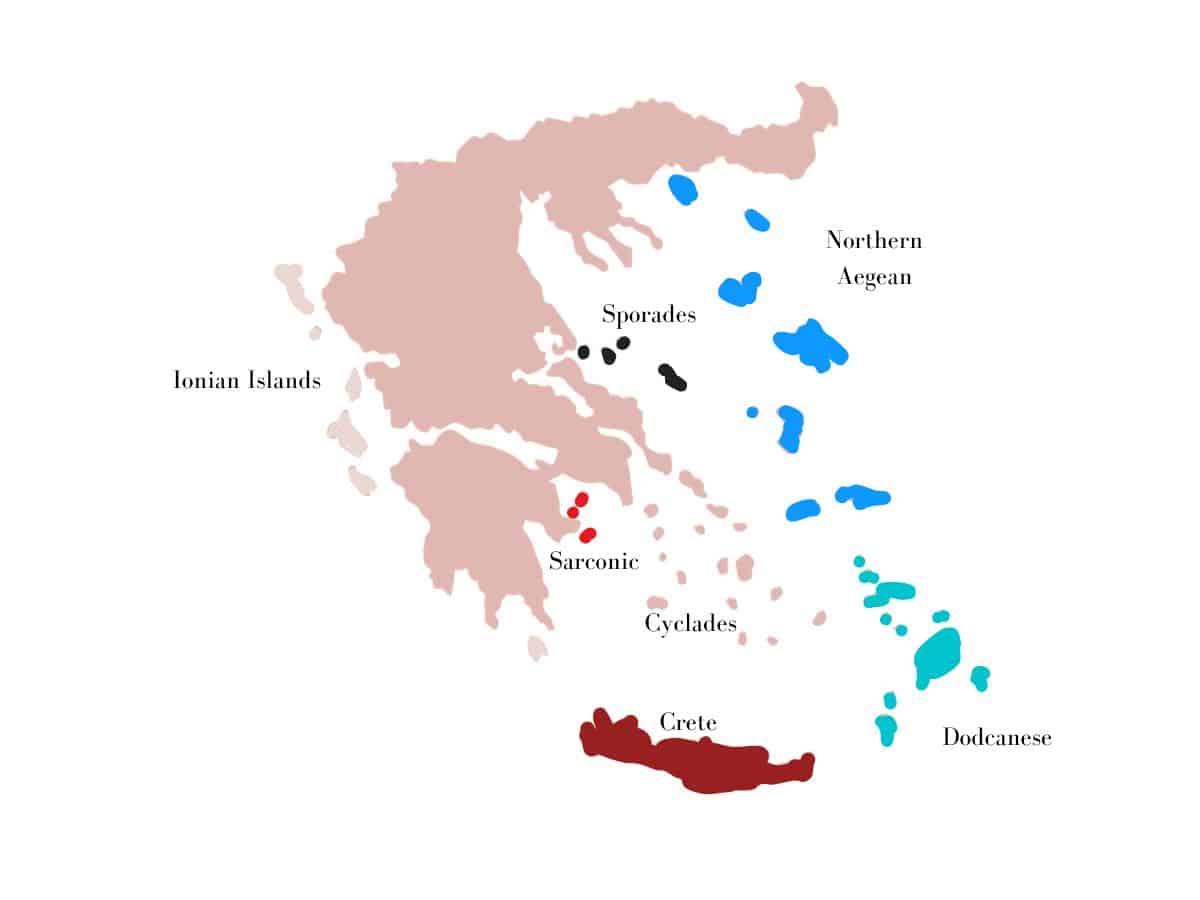
When you are researching from island to island , you can get inspired when using the search feature in Ferry Hopper .
You can see below that I selected my departing port, but left the destination blank. Look to the right and there will be a display of direct routes.
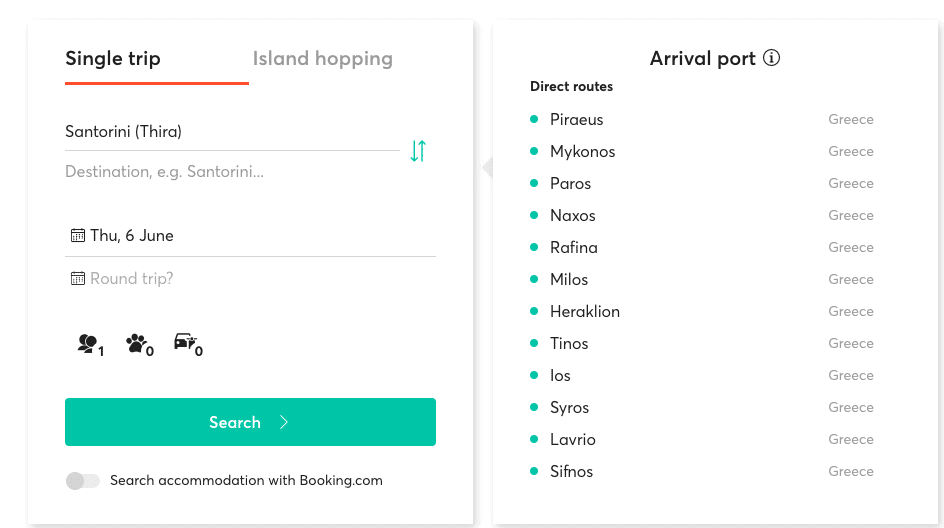
You can play around with ferry schedules here to help you find your next island. It is not a perfect system , but it works very well if you understand these island groups.
Planning your Greek island route takes a little time and patience. But don’t worry, I will share my expertise and suggest Greek island hopping routes.
The Best Time To Visit The Greek Islands
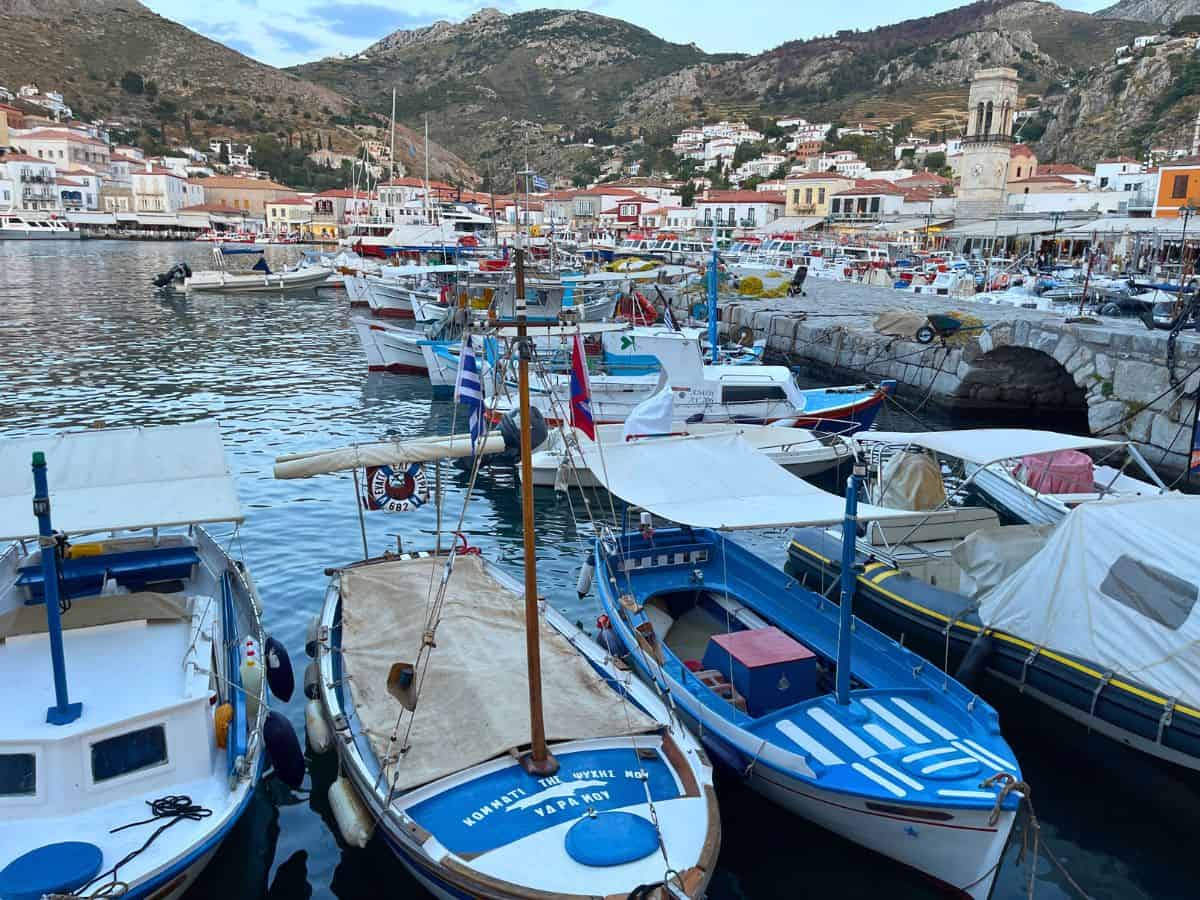
Timing your Greek Island getaway is important . Some of the most popular islands are incredibly crowded and overpriced in July in August. And I’m looking at you, Santorini and Mykonos…
If you are deadset on visiting these islands the best time to go would be late September. The crowds will have died down, the weather should still be great, and things will be on sale at the end of the season.
Ideally, you want to visit the Greek Islands between May and October. Many of the small islands are closed altogether during the winter months. Except the bigger islands like Rhodes and Crete that are functional all year round.
Choosing Where to Stay in The Greek Islands
No matter what island you are on, typically I focus on researching two areas, which are the Port and the Chora (the old town). It is especially important if you are traveling solo to the Greek Islands .
In the port and Chora, you will have access to many shops, bars, and restaurants. It is also where you will find the most transit options if you don’t rent a car.
For a more romantic and secluded experience on any island , you will need to rent a car .
Sometimes, off-the-beaten-path hotels will have shuttle buses to and from the old town, but you could be limited to that schedule.
Consider the experience you are looking to have and plan accordingly.
List of Greek Island Groups
Crete (largest greek island).
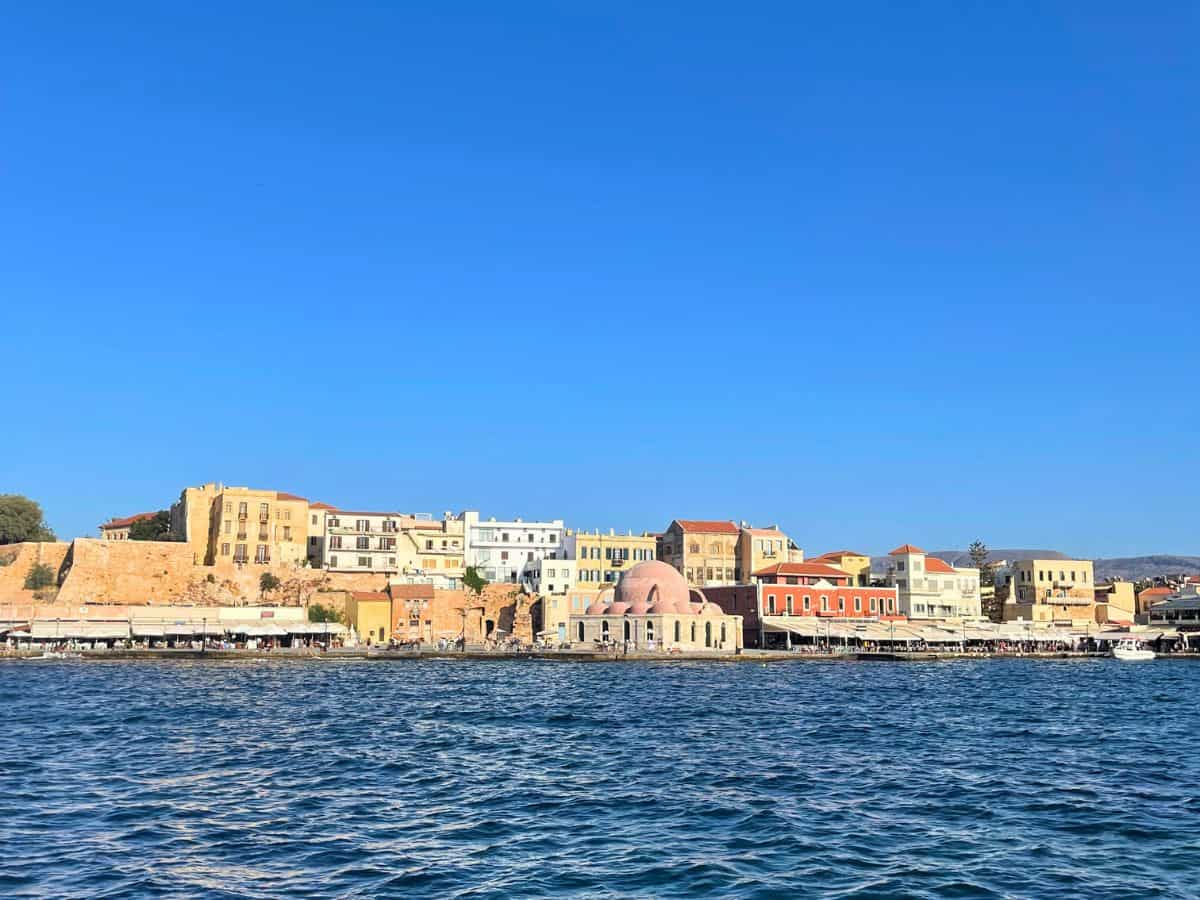
The largest Greek Island, Crete, is in a group all its own. This island has four regions, but two main cities that attract the majority of tourists. Chania “idyllic village” and Heraklion “historic village”.
Chania is much more delightful to visit if you are looking for a more relaxed chill vibe. Heraklion is BUSY , and in my opinion only worth visiting for the day.
Reymotho is another charming area in Crete to stay. You will find a nice seaside village with cute shops, good restaurants and a fortress high on the hill to explore.
Best Way To Get To Crete
When traveling to Greece’s largest island you have a few options. There are 2 major airports on the island. Heraklion and Chania. The major port is in Heraklion , but other ferry ports around the island exist including Chania.
If you are traveling to Crete after exploring Athens, you can take the overnight ferry to Crete , which is the best way since the ride is around 8 hours.
When I visited Crete I found it more convenient to fly , though the ferry is fun.
Best Areas to Stay in Crete

Where to stay in Crete will depend solely on the type of vacation you are after.
If you are looking to spend a romantic holiday with your partner that would look different than going with a bunch of friends to have a good time.
Since Crete is the biggest Greek Island , you should research where to stay in full.
Read Next: Best Areas to Stay in Crete
Here is a map and mini breakdown of 4 major regions of Crete:
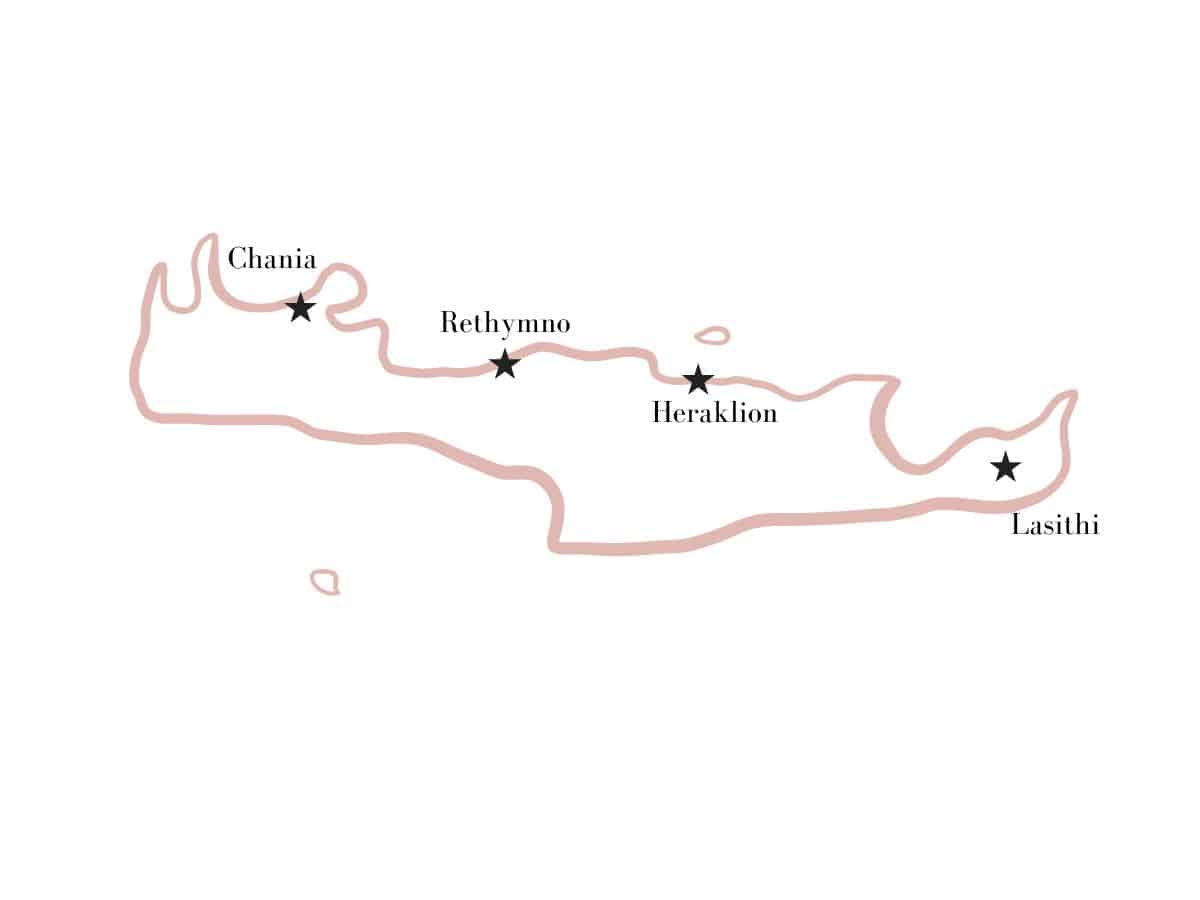
Heraklion (Iraklio):
- Location : Central-eastern part of Crete .
- Key Features : Home to the island’s capital city, also named Heraklion, which is the largest city in Crete. The region is famous for the Palace of Knossos , an important Minoan archaeological site, and the Heraklion Archaeological Museum , which houses many artifacts from Knossos and other Minoan ruins.
- Tourist Attractions : Heraklion offers a blend of urban and historic attractions, with bustling city life, historical sites, and beautiful beaches like Amoudara.
- Where to Stay : City Lion by Semavi , Casa Al Mare Sea View Heraklion City Center
Chania (Hania):

- Location : Northwestern Crete .
- Key Features : Known for its charming old town with Venetian-era buildings, narrow streets, and a picturesque harbor. The region has a diverse landscape, including the White Mountains (Lefka Ori), Samaria Gorge , and beautiful beaches like Balos and Elafonissi .
- Tourist Attractions : Chania’s old town and harbor, exotic beaches, and hiking opportunities in the gorges and mountains make it a popular destination.
- Where to Stay: Cretan Berry Kondylaki , Nais Apartments & Studios
Rethymno (Rethymnon):

- Location : Central-western Crete .
- Key Features : Characterized by its well-preserved Renaissance architecture and the Fortezza, a large fortress overlooking the city. Rethymno’s old town is a mix of Ottoman and Venetian influences, and the region boasts long sandy beaches.
- Tourist Attractions : The old town of Rethymno , the Fortezza, and beaches like Preveli with its unique palm forest are highlights.
- Where to Stay: Kapsaliana Village Hotel , SAVUS Boutique Hotel
- Location : Eastern Crete .
- Key Features : Known for its quieter, less developed atmosphere compared to the other regions. It is famous for the palm beach of Vai, which has one of Europe’s largest natural palm forests, and the Dikteon Cave believed to be the birthplace of Zeus according to Greek mythology.
- Tourist Attractions : Lasithi offers a more relaxed and natural setting, with attractions such as the Lasithi Plateau, traditional villages, and archaeological sites.
- Where to Stay: Aelia Suites , Enorme Santanna Beach
Greek Island Hopping Routes From Crete
As I mentioned before, the major port is in Heraklion , so to easily hop to another island you will have the most options from Heraklion.
Crete – Santorini – Ios – Naxos – Mykonos:
- Crete : 4 nights.
- Santorini : 3 nights.
- Ios : 2 nights.
- Naxos : 3 nights.
- Mykonos : 2 nights.
The Cyclades Islands (Most Famous Greek Islands)
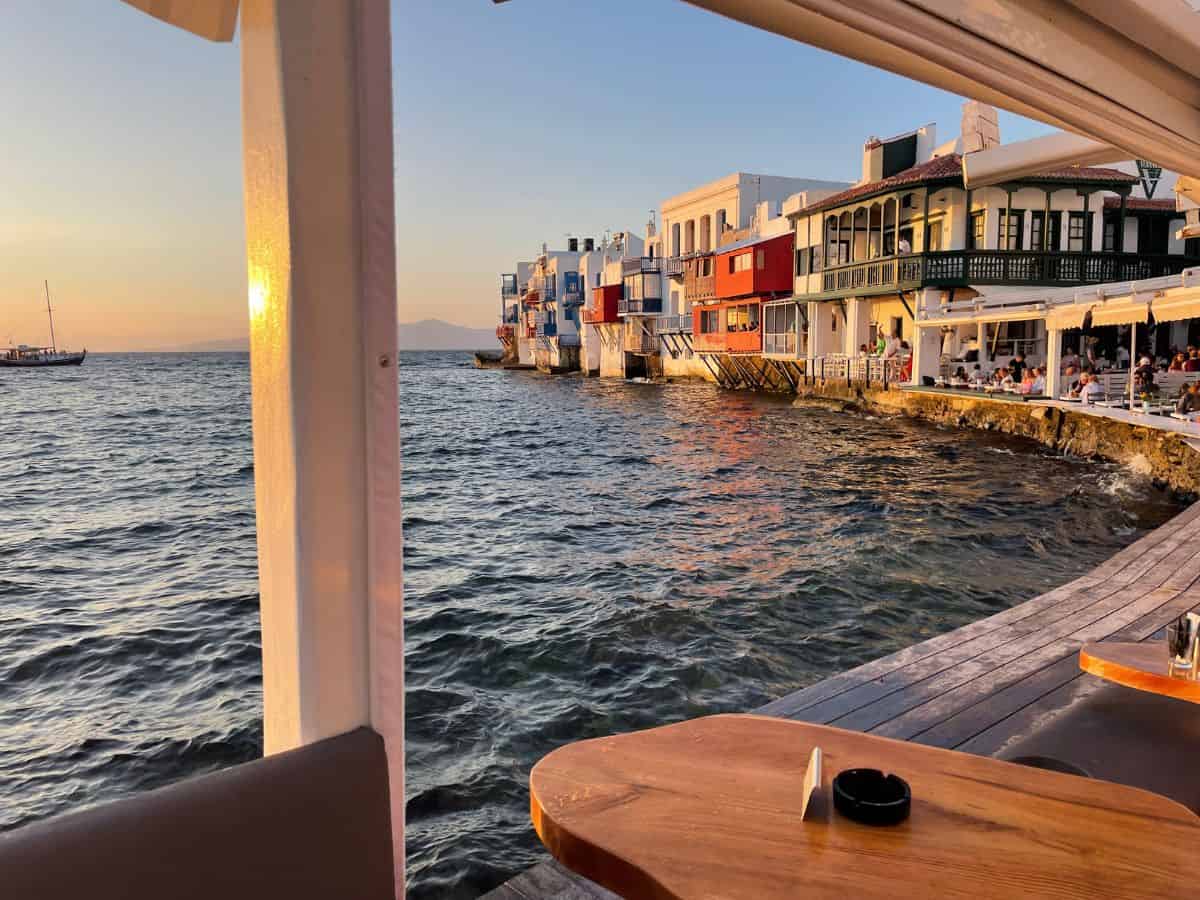
The Cyclades is an island group home to the most famous Greek Islands, Santorini and Mykonos. Both are worth visiting , but not in the high season for July and August.
Depending on when you visit, Mykonos can be extremely expensive , same with Santorini, and both are largely overcrowded.
While I understand the allure of visiting these islands, I would highly recommend visiting on a day trip and staying on a more affordable nearby island.
List of the Cyclades Islands – Amorgos, Anafi, Andros, Antiparos, Delos, Ios, Kea (Tzia), Kythnos, Milos , Mykonos , Naxos , Paros, Santorini (Thira), Serifos, Sifnos , Sikinos, Syros, Tinos, Folegandros.
Best Way To Get To The Cyclades
Several of the most popular islands in the Cyclades have airports, such as Naxos, Mykonos, Milos, and Santorini.
The smaller islands like Sifnos and Folegandros do not have an airport.
Depending on your travel plans you could fly into one of these islands and ferry your way around, eventually to Athens if you desire.
It will depend on how many days you have to explore altogether. I recommend 2 nights per island minimum for small islands and 4 nights minimum for larger islands.
The Milos to Athens ferry line is very convenient stopping at Milos, Sifnos, and Serifos.
Expert Tip: Rent a car in Milos . I made the mistake of not having a car and nearly went bankrupt using taxis that were hard to find.
Choosing The Best Island in The Cyclades
Santorini (thira):.
- Key Features : Famous for its stunning sunsets, white-washed houses with blue domes, and dramatic caldera views. It’s a popular destination for honeymooners and tourists.
- Tourist Attractions : The towns of Oia and Fira, the Akrotiri Archaeological Site, and the unique black sand beaches.
- Where to Stay : Santorini Sky, Luxury Resort , Voreina Gallery Suites

- Key Features : Known for its exciting nightlife, white-washed villages, luxurious resorts, and iconic windmills. It’s a cosmopolitan island popular with the celebrity crowd.
- Tourist Attractions : The picturesque Mykonos Town , beautiful beaches like Paradise and Super Paradise, and the nearby island of Delos , an important archaeological site.
- Where to Stay: Alissachni Mykonos , Tropicana Hotel, Suites & Villas Mykonos
Read Next: Is Mykonos REALLY that expensive?
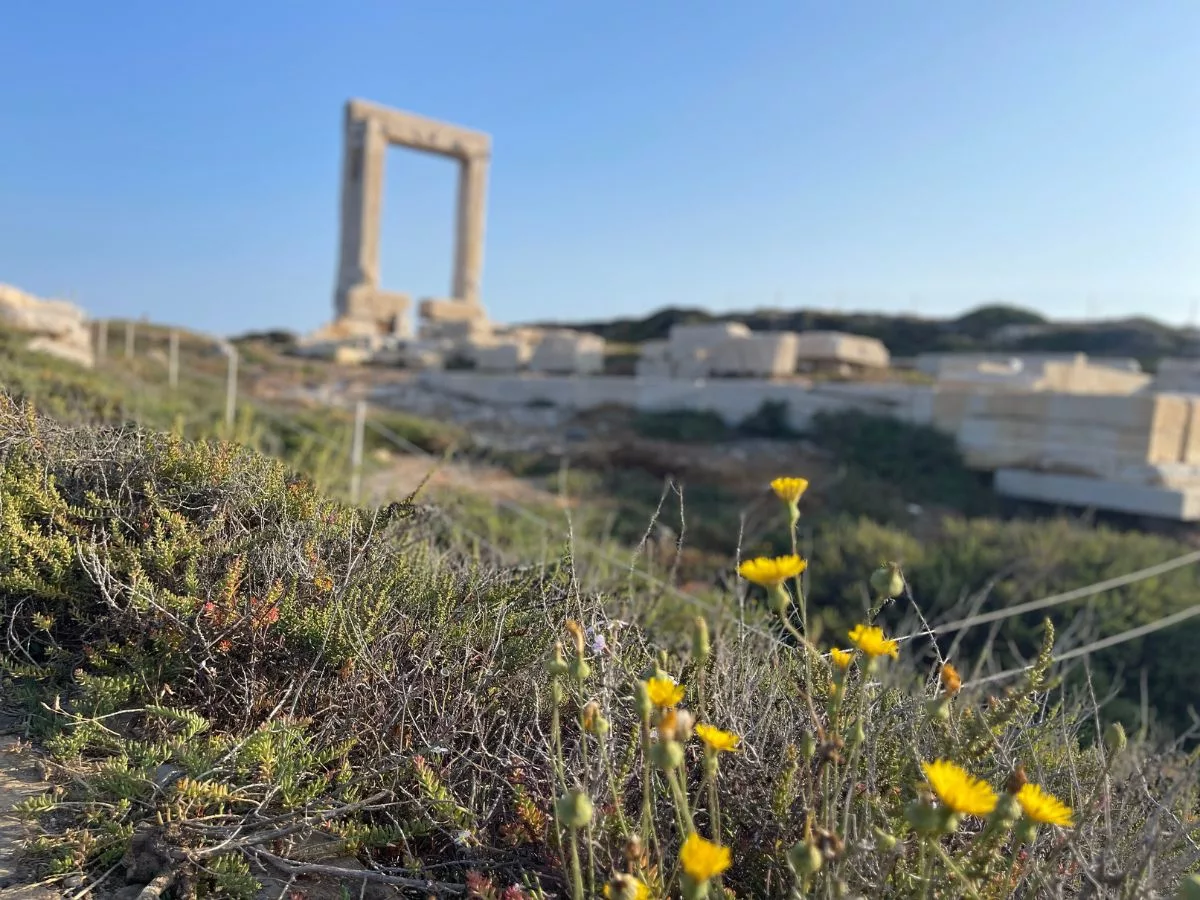
- Key Features : The largest island in the Cyclades, known for its impressive mountain landscapes, ancient ruins, and long sandy beaches. When visiting Naxos I recommend renting a car to see the whole island.
- Tourist Attractions : The Portara (an ancient marble gateway), traditional villages, and the Temple of Demeter .
- Where to Stay: Naxian Althea , Anapollo Boutique Hotel Adults Only
Read Next: Best Bus Tour in Naxos

- Key Features : Famous for its traditional villages, beautiful beaches, and active windsurfing community.
- Tourist Attractions : The port town of Parikia, the charming village of Naoussa, and the Panagia Ekatontapiliani church .
- Where to Stay: PAREA Paros – Adults Only , Kymo Luxury Suites Paros
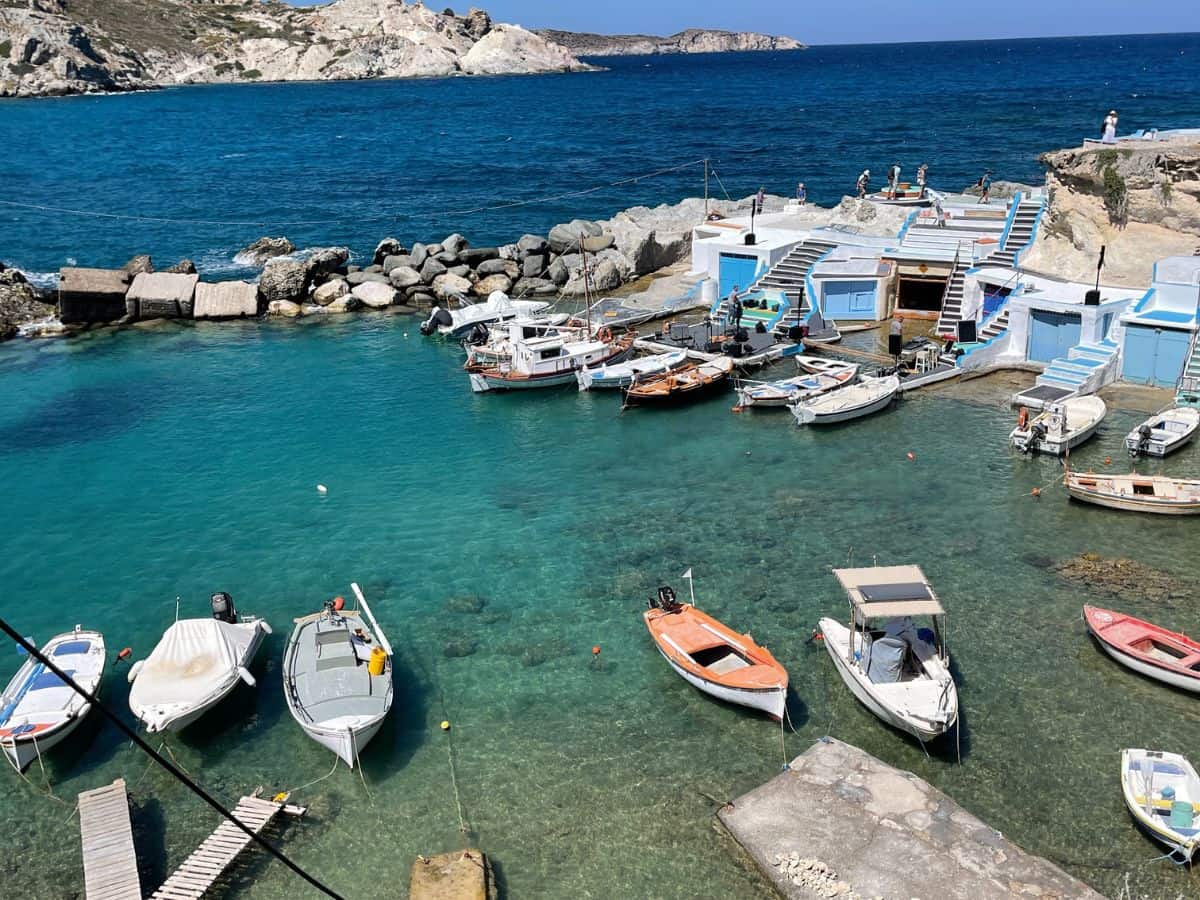
- Key Features : Known for its volcanic landscape and unique beaches. The island is where the famous Venus de Milo statue was discovered.
- Tourist Attractions : The picturesque fishing village of Klima, the catacombs, and beaches like Sarakiniko and Tsigrado.
- Where to Stay: Artemis Seaside Resort , Milos Breeze Boutique Hotel
Read Next: 12 Best Boutique Hotels in Milos

- Key Features : The administrative center of the Cyclades, is known for its blend of medieval and neoclassical architecture, especially in the capital, Ermoupoli.
- Tourist Attractions : The Apollo Theater , Ermoupoli’s town square, and Vaporia district.
- Where to Stay: SYROS SOUL LUXURY SUITES , Shapes Luxury Suites
- Key Features : A pilgrimage site for Greek Orthodox Christians, known for its Church of the Annunciation and traditional villages.
- Tourist Attractions : The church and its icon believed to perform miracles, the marble craft villages, and the sculptors’ workshops.
- Where to Stay: Avissalou Apartments , La Vista TINOS
- Key Features : A less touristy island with lush landscapes, numerous springs, and a rich maritime history.
- Tourist Attractions : The Museum of Contemporary Art Andros , the capital Chora with its medieval castle, and beautiful beaches.
- Where to Stay: Blue Bay Resort Village , Krinos Suites Andros
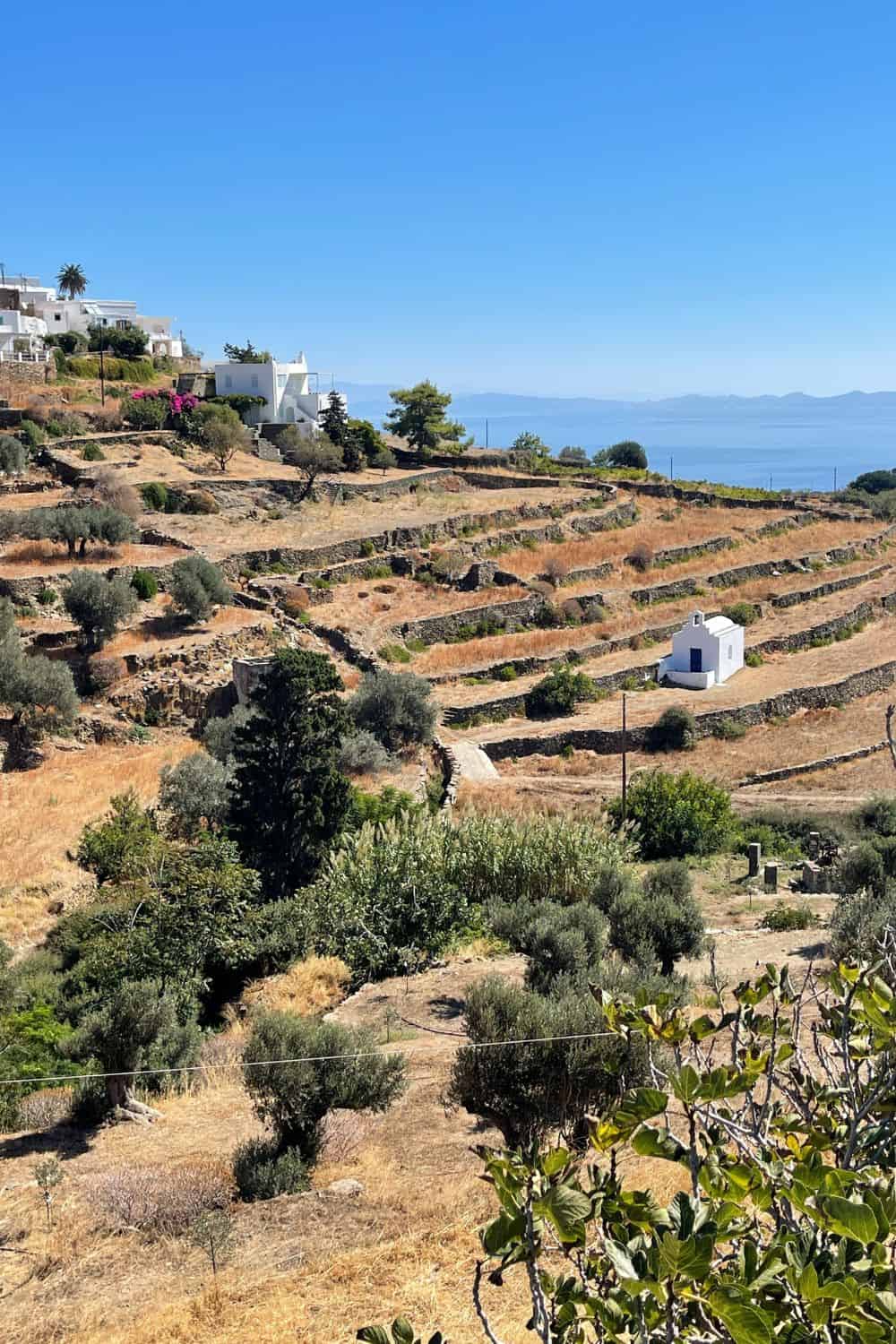
- Key Features : Known for its pottery, incredible restaurants , culinary tradition, and charming villages. You’ll love all the unique areas to stay in Sifnos.
- Tourist Attractions : The picturesque village of Kastro, the church of Seven Martyrs , and traditional pottery workshops. Check out local restaurants such as Omega3 and Cantina .
- Where to Stay: Nival Boutique Hotel , Apsila Pool Suites
Read Next: Guide to Sifnos, Greece and 3 Day Itinerary for Sifnos

- Key Features : Popular among young tourists, known for its lively nightlife and beautiful beaches.
- Tourist Attractions : The tomb of Homer , the main village of Chora, and beaches like Mylopotas and Manganari.
- Where to Stay: White Loft , Liostasi
- Key Features : A more remote and tranquil island, known for its dramatic cliffs and the impressive Monastery of Hozoviotissa .
- Tourist Attractions : The monastery, the shipwreck from the film “The Big Blue,” and traditional villages.
- Where to Stay: Pension The Big Blue , Amorgion Hotel
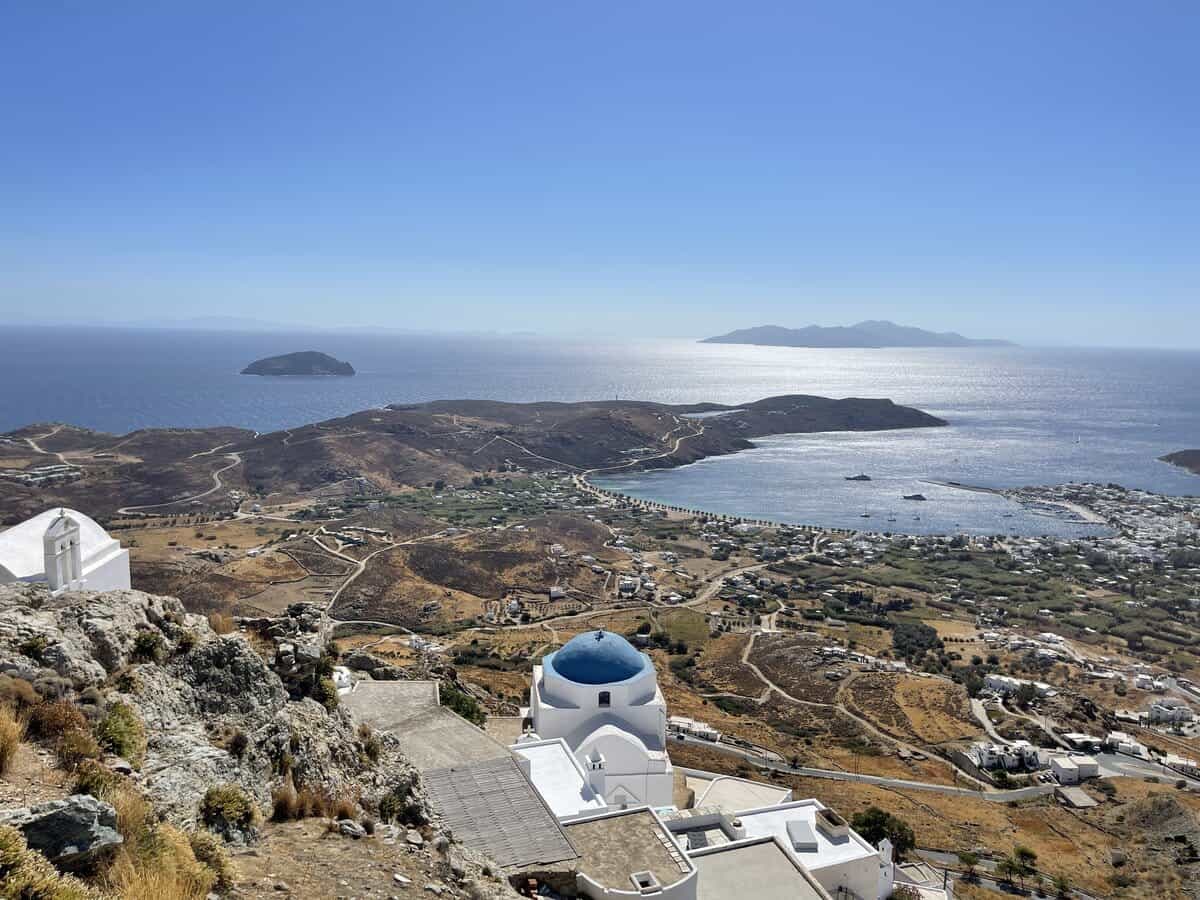
- Key Features: Serifos is a less crowded, peaceful island, famous for its rugged landscape and charming hilltop capital, Chora.
- Tourist Attractions: The striking white-washed village of Chora and its windmills, hiking, and beautiful beaches.
- Where to Stay: Rizes Hotel , Coco-Mat Eco Residences Serifos
Folegandros:
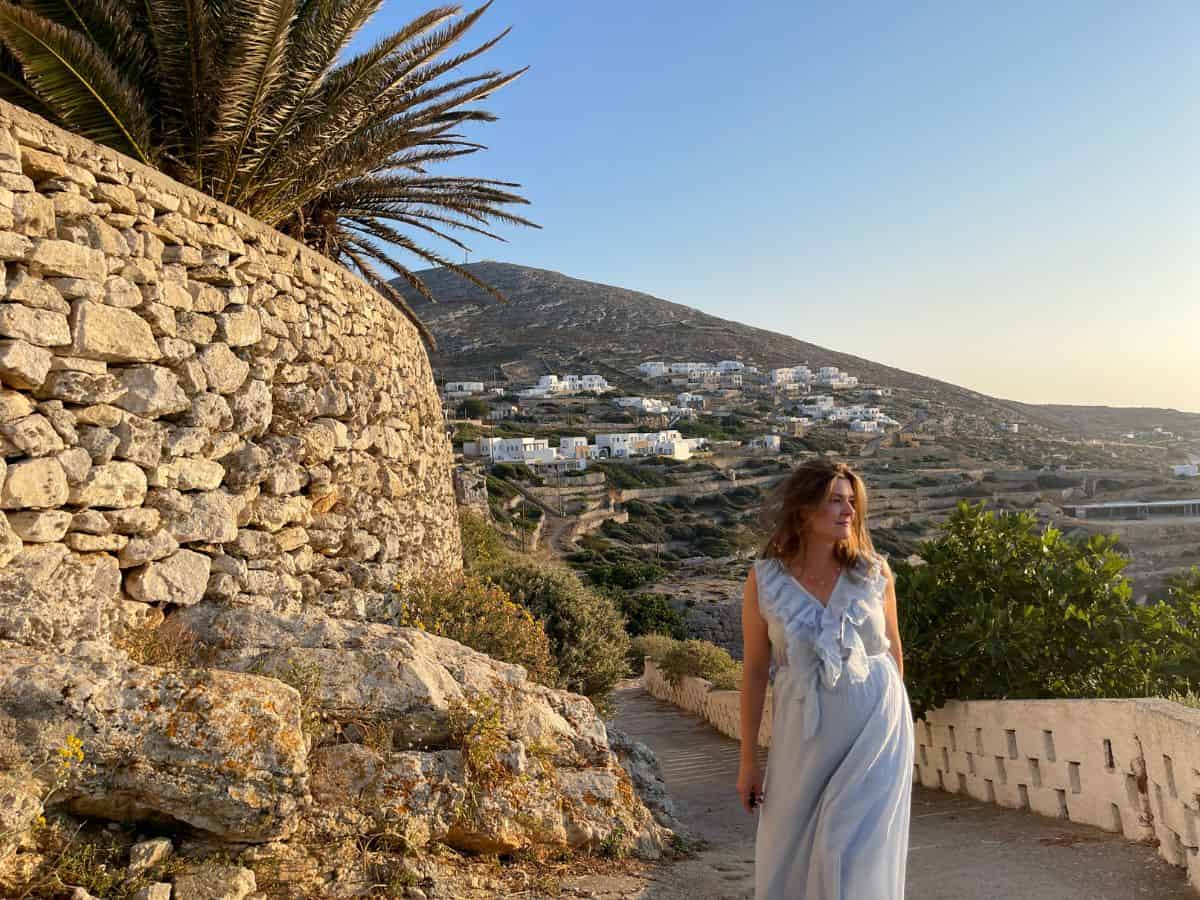
- Key Features : A small, serene island with traditional Cycladic architecture and a laid-back atmosphere.
- Tourist Attractions : The cliffside Chora, Church of Panagia, and secluded beaches.
- Where to Stay: Blue Sand Boutique Hotel & Suites , Polikandia Hotel
Island Hopping Itinerary Routes- The Cyclades
When planning a Greek Island hopping itinerary route in the Cyclades an easy route is to start from Athen Pireaus Port .
Mykonos – Paros – Naxos – Santorini:
- Mykonos : 2 nights
- Paros : 2 nights
- Naxos : 3 nights
- Santorini : 3 nights
Santorini – Amorgos – Naxos:
- Amorgos : 2 nights
- Naxos : 2 nights
Syros – Mykonos – Milos – Sifnos – Serifos
- Syros : 2 nights
- Milos : 3 nights
- Sifnos : 2 nights
- Serifos : 1 night
Saronic Gulf Islands (Closest Islands to Athens)
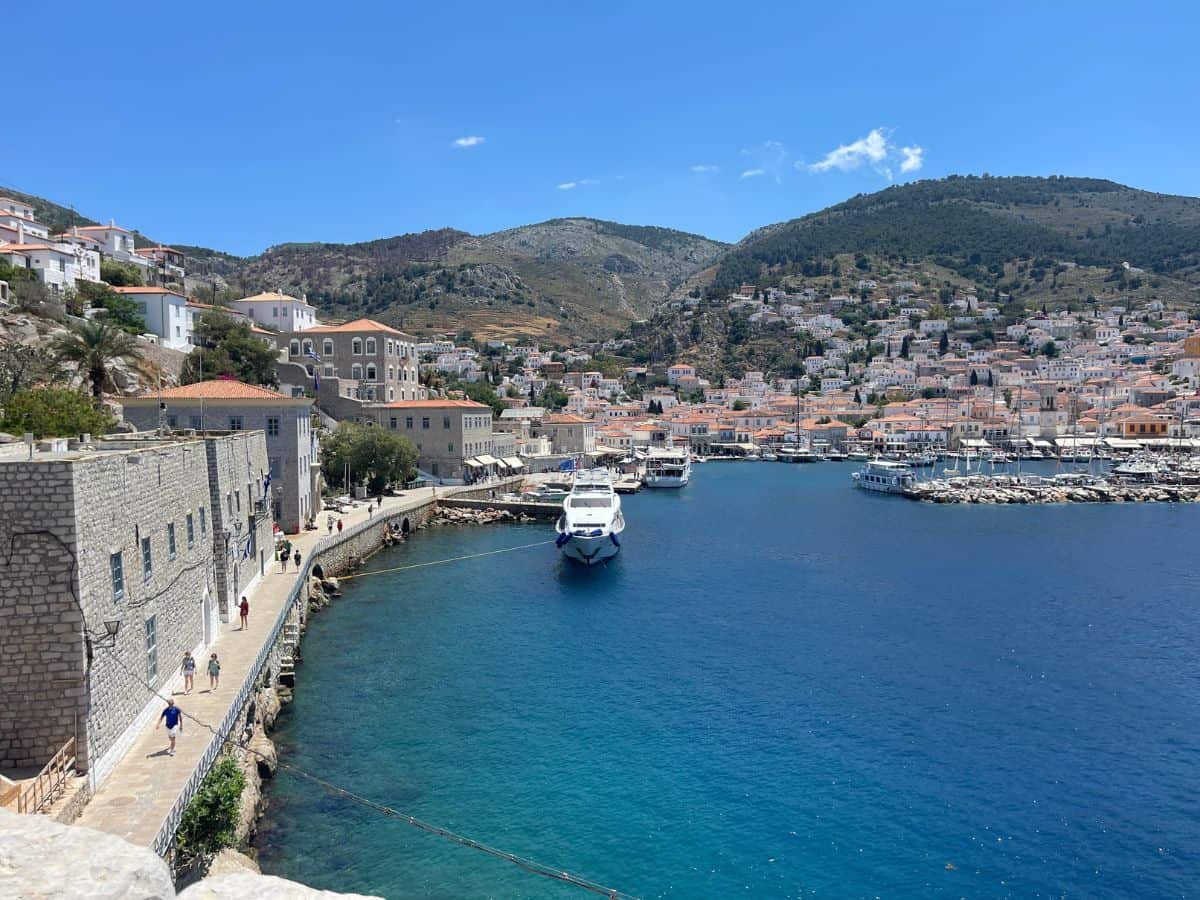
If you are visiting Greece on a short trip and want to easily combine a visit to Athens as well as the Greek Islands, you want to visit the Saronic Islands !
Of all of the Saronic Islands, I can highly recommend going to Hydra for the day!
These islands include Aegina, Agistri, Poros, Hydra, Spetses, and Dokos. The most popular, and arguably the best, is Hydra.
Hydra is one of the most popular Greek Islands close to Athens. No cars are allowed on the island which I loved.
You will see the locals using donkeys to transport their goods and sometimes themselves to travel from one place to another.
Best Way To Get To The Saronic Gulf
The only way to get to these tiny islands in the Saronic Gulf is by ferry. A popular route is by taking the ferry from Athens to Hydra . Depending on the ferry company, your route may include a stop at Aegina.
One fun way to see three islands in one day from Athens is to book a tour! The full-day tour leaving from Athens leaves early morning and takes you to all 3 islands with short stops for a couple of hours at each.
If you are short on time it’s a terrific way to see the Greek Islands .
Choosing the Best Islands in The Saronic Gulf
- Key Features : Famous for its pistachio orchards, Aegina is a popular destination for day trips from Athens . It has a rich history, evident in its ancient ruins.
- Tourist Attractions : The Temple of Aphaia , one of the most important Doric temples in Greece, the picturesque town of Aegina, and the church of Saint Nectarios.
- Where to Stay: The Beachhouse Apartments , Cruise on Land

- Key Features : Known for its well-preserved architecture, absence of motor vehicles, and art scene. The island has a cosmopolitan atmosphere and is a favorite among artists and celebrities.
- Tourist Attractions : Hydra’s port town with its stone mansions, art galleries, and the historic monastery of the Assumption of the Virgin Mary.
- Where to Stay: FOS Hydra Residence , Villa Maria- Hydra Dream House
Read Next: Athens to Hydra Ferry
- Key Features : A small, lush island separated from the Peloponnese by a narrow waterway. It’s known for its scenic beauty, historic clock tower, and serene beaches.
- Tourist Attractions : The Sanctuary of Poseidon , the picturesque Poros Town, and beautiful beaches like Love Bay.
- Where to Stay: Dimitra Boutique Hotel , Sea view house on Poros
- Key Features : This island has a rich nautical history and is famous for its significant role in the Greek War of Independence. It’s known for its elegant mansions and car-free policy .
- Tourist Attractions : The Museum of Bouboulina , the old harbor, and the annual Armata Festival, which commemorates a naval battle during the War of Independence.
- Where to Stay: Villa Kalomira , Armata Boutique Hotel
- Key Features : A small, pine-covered island known for its crystal-clear waters and tranquil atmosphere. It’s less crowded compared to its neighbors, making it an ideal spot for relaxation.
- Tourist Attractions : Quiet beaches like Skala and Aponisos, and the opportunity for hiking and biking in a serene environment.
- Where to Stay: Oasis Beach Hotel , Koukounari Apartments
- Key Features : The largest island in the Saronic Gulf, Salamis is historically significant as the site of the famous naval battle in 480 BC. It’s a residential and holiday spot with a mix of sandy beaches and pine forests.
- Tourist Attractions : The Cave of Euripides , where the famous playwright is said to have written some of his plays, and the Monastery of Faneromeni.
- Where to Stay: Salamina’s Apartments
- Key Features : A small, mostly uninhabited island between Hydra and the Peloponnese, known for its archaeological significance, particularly for underwater archaeology.
- Tourist Attractions : The island is mainly a destination for yachting and anchoring in its protected bays, offering a secluded and natural environment.
Island Hopping Itinerary Routes-The Saronic Gulf
A great Island hopping itinerary includes a 3 day stay in Hydra with a day trip to and then 2 nights in Aegina.
The Dodecanese Islands (Most Southern Islands)
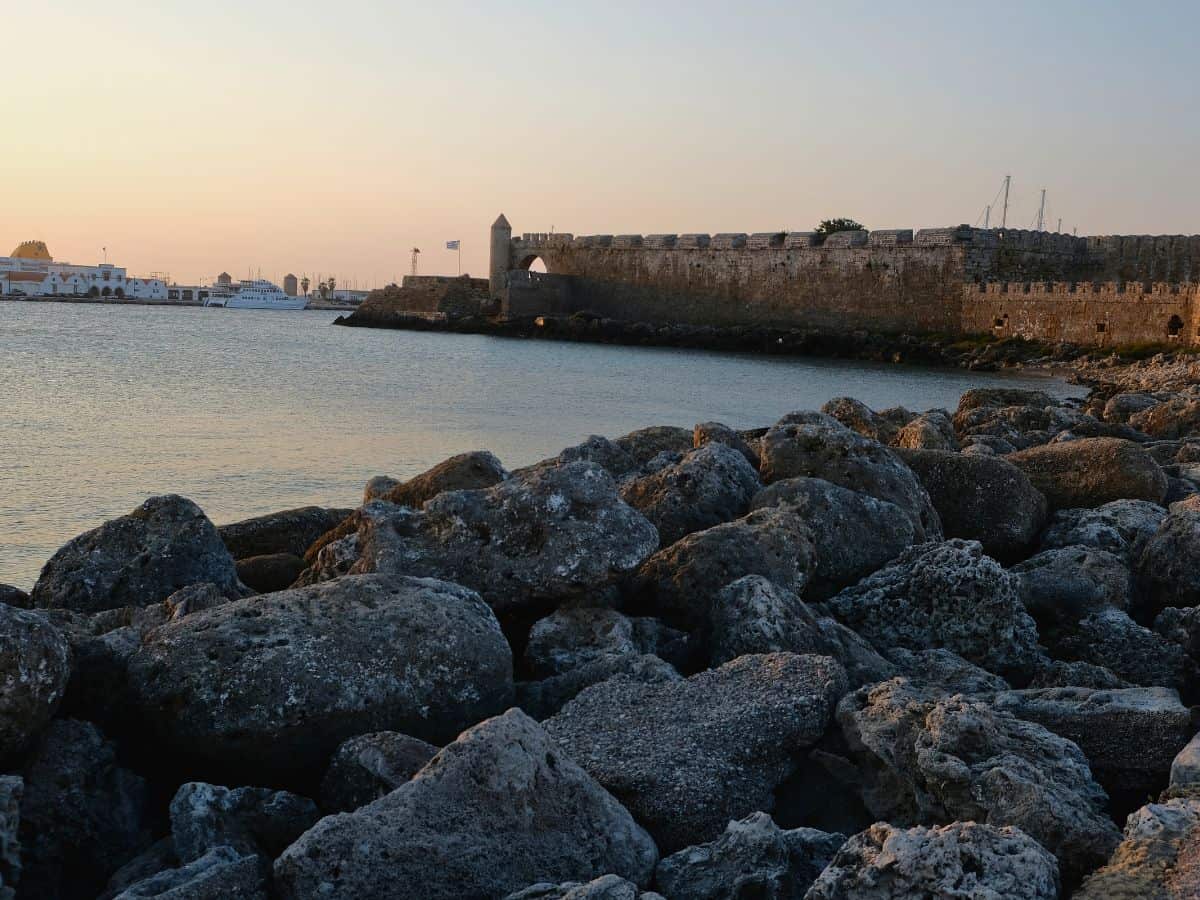
The island group that is the most southern closest to Turkey is the Dodecanese group of islands. Here you will find that Rhodes is the largest Greek island.
Other islands in this group include Astypalaia, Kalymnos, Karpathos, Kasos, Kastellorizo, Kos, Leros, Nisyros, Patmos, Rhodes, Symi, Tilos, and Chalki.
Best Way to Get to The Dodecanese Islands
If your first destination is an island in the Dodecanese, the most logical way to get there is to fly. Unless you want to burn a lot of time on ferries.
I recommend flying into Rhodes and beginning your ferry-hopping journey from there.
Other Dodecanese islands that have airports are Kos, Karpthos, Leros, Kalymnos, Kastellorizo, and Astypalaia. Rhodes and Kos likely have the most daily flights .
An easy day trip from Rhodes is by taking the Rhodes to Symi Ferry or a fast boat.
Choosing the Best of The Dodecanese Islands
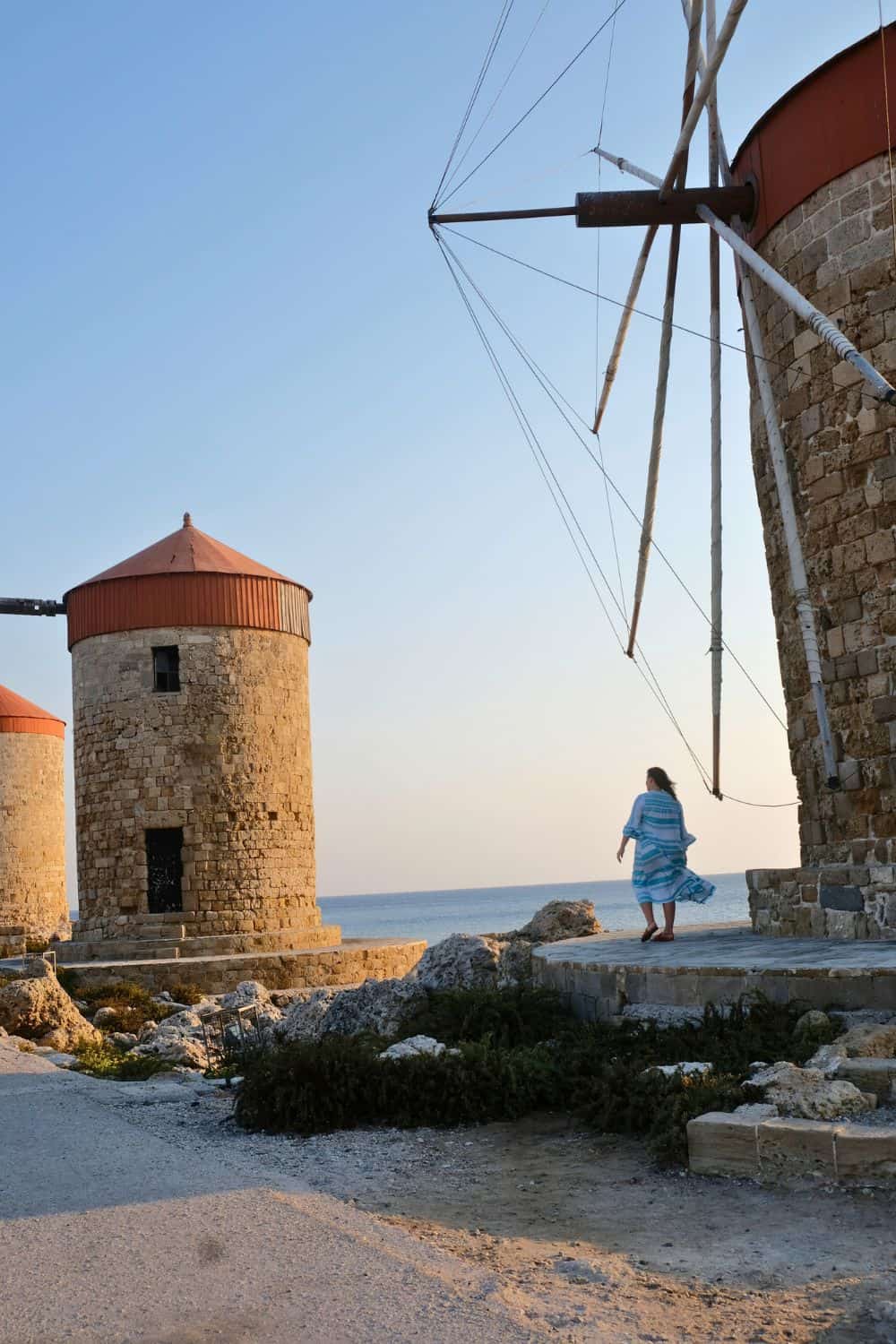
- Key Features : The largest of the Dodecanese islands, Rhodes is famous for its ancient ruins, medieval Old Town, and beaches. It’s a blend of historical sites and a bustling tourist resort. When visiting Rhodes, it is ideal to rent a car .
- Tourist Attractions : The medieval Old Town of Rhodes , the Palace of the Grand Master, and the Acropolis of Lindos .
- Where to Stay: Sperveri Boutique Hotel , Evdokia Hotel
Read Next: Rhodes to Symi Island on a Fast Boat
- Key Features : Known for its sandy beaches, ancient ruins, and the Asklepion, an ancient healing center. Kos is the birthplace of Hippocrates , the father of medicine.
- Tourist Attractions : The Asklepion, the Castle of the Knights, and the ancient Agora.
- Where to Stay: Maritina Hotel , OKU Kos
- Key Features : A significant Christian pilgrimage site, Patmos is where St. John is said to have written the Book of Revelation . It has a fortified monastery and a charming old town.
- Tourist Attractions : The Monastery of Saint John the Theologian and the Cave of the Apocalypse.
- Where to Stay: 9 Muses Exclusive Apartments , En Patmo Holiday Home
- Key Features : Known for preserving traditional customs and dress, Karpathos offers dramatic landscapes, with rugged mountains and pristine beaches.
- Tourist Attractions : The villages of Olympos and Diafani, known for their traditional architecture and customs, and beautiful beaches like Apella.
- Where to Stay: Alisachni Villas , Aeolia Suites
- Key Features : Leros has a relaxed atmosphere with a rich naval history. It features a blend of architectural styles and has a scenic indented coastline.
- Tourist Attractions : The Castle of Leros , the War Museum, and the scenic port of Agia Marina.
- Where to Stay: Alidian Bay Suites Leros
- Key Features : Best known for its sponge diving heritage, Kalymnos is also a world-renowned destination for rock climbing.
- Tourist Attractions : The Sponge Divers Museum in Pothia, climbing spots, and beautiful beaches like Masouri.
- Where to Stay: Petra Boutique Villas , Petra Boutique Homes
Astypalaia:
- Key Features : Astypalaia, shaped like a butterfly, is known for its Venetian castle, traditional white windmills, and tranquil beaches.
- Tourist Attractions : The Venetian Castle, Chora with its windmills, and the beaches of Livadi and Vatses.
- Where to Stay: 5 Traditional Suites
- Key Features : A volcanic island famous for its still-active volcano and lunar-like craters. Nisyros offers a unique landscape and tranquil villages.
- Tourist Attractions : The volcano and its accessible crater, the traditional village of Mandraki, and the Monastery of Panagia Spiliani .
- Key Features : A small and serene island known for its unspoiled nature, wildlife, and medieval ruins.
- Tourist Attractions : The abandoned medieval village of Mikro Chorio, the Monastery of Agios Panteleimon , and tranquil beaches.
- Where to Stay: Uno Apartment 1st Floor
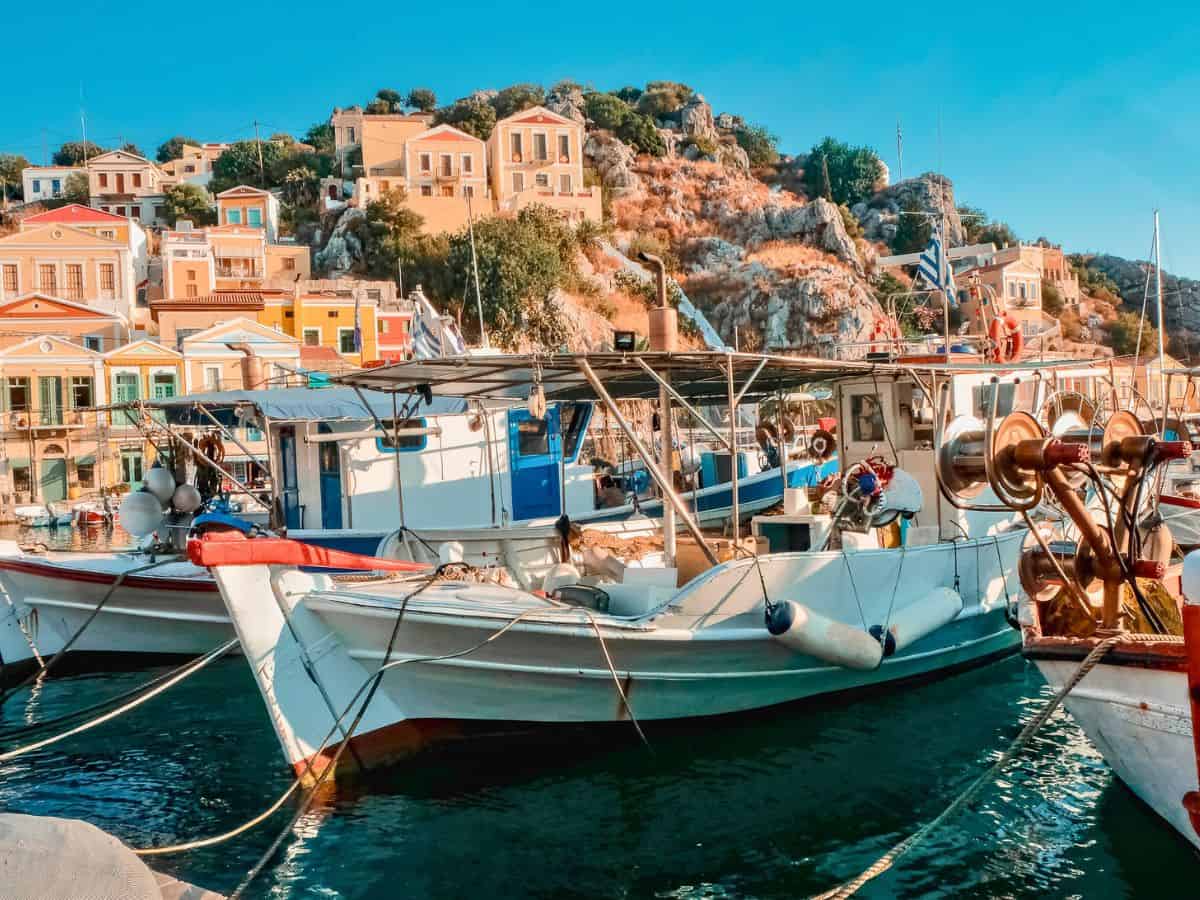
- Key Features : Famous for its neoclassical architecture with colorful houses, Symi is a picturesque and charming island.
- Tourist Attractions : The port of Gialos, the Monastery of Panormitis , and the scenic bay of Pedi.
- Where to Stay: Odyssia
Kastellorizo (Megisti):
- Key Features : The easternmost Greek island, is known for its rich history, colorful houses, and crystal-clear waters.
- Tourist Attractions : The Blue Cave, the Castle of the Knights, and the Archaeological Museum.
- Key Features : A less-visited island with a strong maritime tradition, Kasos is known for its traditional music and customs.
- Tourist Attractions : The traditional villages, the Church of Agios Spiridon , and the maritime museum.
Island Hopping Itinerary Routes- The Dodecanese Islands
Kos – nisyros – tilos – rhodes:.
- Kos : 2 nights.
- Nisyros : 1 night.
- Tilos : 2 nights.
- Rhodes : 3 nights.
Patmos – Leros – Kalymnos – Kos:
- Patmos : 2 nights.
- Leros : 1 night.
- Kalymnos : 2 nights.
The Ionian Greek Islands (The Seven Islands)

The Ionian Greek island group has been referred to as the Heptanese , which means “Seven Islands”.
These Islands are located in the Ionian Sea on the Eastern side of Greece closer to Italy and Albania.
Best Way To Get To The Ionian Islands
From Athens, the easiest way to get to the Ionian Islands is to fly. Ferries leaving out of Port of Piraeus don’t have a direct link that go there .
In the Ionian Islands, several have international airports which facilitate both domestic and international travel. Corfu, known as Kerkyra in Greek, is served by the Corfu International Airport , also referred to as Ioannis Kapodistrias Airport .
This airport is well-equipped for international flights, making Corfu a convenient destination for travelers from abroad.
Kefalonia, or Cephalonia, also hosts an international airport, known as Kefalonia International Airport or Anna Pollatou Airport. This facility connects the island with various international locations.
Similarly, Zakynthos, or Zante, has an international airport named Zakynthos International Airport, also known as Dionysios Solomos Airport, which caters to international passengers, particularly during the tourist season.
Lefkada, or Lefkas, does not have its own airport; however, it is conveniently served by the nearby Aktion National Airport located on the mainland near Preveza.
This airport, which handles international flights, is within a short driving distance from Lefkada, making it relatively easy for visitors to reach the island.
Choosing the Best of The Ionian Islands
Corfu (kerkyra):.
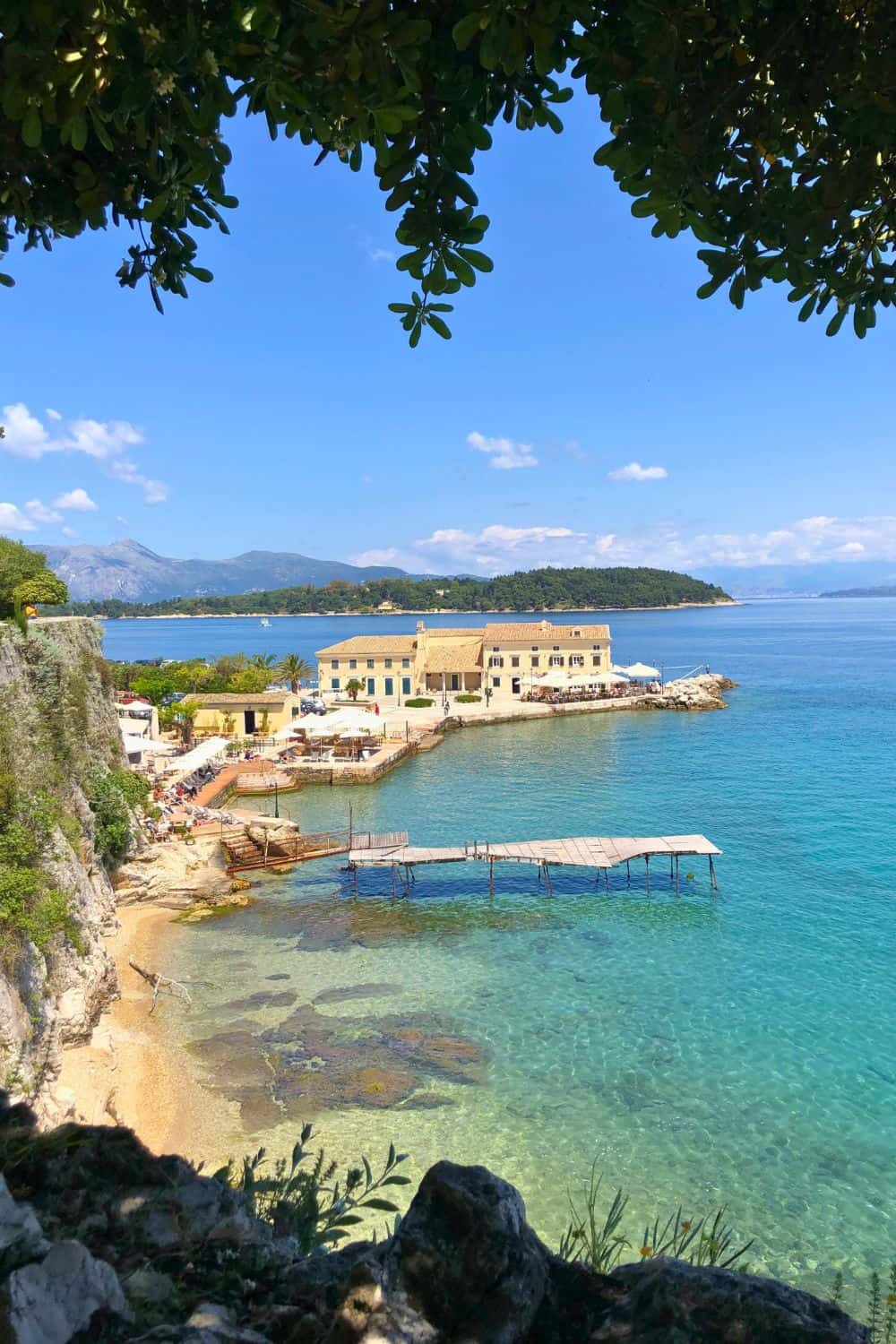
- Key Features : Known for its lush greenery, Venetian-style architecture, and rich cultural heritage. Corfu has a cosmopolitan atmosphere with a blend of Greek, Venetian, French, and British influences.
- Tourist Attractions : The Old Town of Corfu (a UNESCO World Heritage Site), the Achilleion Palace, the Venetian Fort, and the Paleokastritsa Monastery .
- Where to Stay: Archontiko Petrettini Boutique Hotel
Kefalonia (Cephalonia):
- Key Features : Kefalonia is famous for its beaches & dramatic landscapes, including mountains, caves, and stunning beaches. The island gained fame through the novel and movie “Captain Corelli’s Mandolin.”
- Tourist Attractions : The Melissani Cave , Myrtos Beach, and the picturesque village of Fiscardo.
- If you are looking for Where to Stay in Kefalonia I would suggest as close to ARGOSTOLI.
Zakynthos (Zante):
- Key Features : Known for its swinging nightlife and beautiful beaches, including the iconic Shipwreck Beach (Navagio) , one of Greece’s most famous photographic spots.
- Tourist Attractions : Navagio Beach, the Blue Caves, and the endangered loggerhead sea turtles in Laganas Bay.
- Where to Stay: Tsamis Zante Suites
Lefkada (Lefkas):
- Key Features : Connected to the mainland by a causeway, Lefkada is known for its impressive beaches with turquoise waters and its charming mountain villages.
- Tourist Attractions : The beaches of Porto Katsiki and Egremni, and the windsurfing center at Vassiliki.
- Where to Stay: KN Ionian Suites
Ithaca (Ithaki):
- Key Features : The Greek Island of Ithaca is famed as the homeland of Odysseus in Homer’s epic, Ithaca is a tranquil island with lush landscapes and quaint villages.
- Tourist Attractions : The Cave of the Nymphs , the ruins of the ancient city of Alalcomenae , and the picturesque village of Kioni .
Paxos (Paxi) :
- Key Features : A small and unspoiled island, Paxos is known for its olive groves, crystal-clear waters, and pebble beaches. It has a peaceful and exclusive atmosphere.
- Tourist Attractions : The Blue Caves, the charming port villages of Gaios, Lakka, and Loggos.
Kythira (Cythera):
- Key Features : Although geographically closer to the Peloponnese, Kythira is culturally and administratively part of the Ionian Islands. It’s known for its wild beauty, waterfalls, and traditional villages.
- Tourist Attractions : The Venetian castle of Chora, the picturesque village of Avlemonas, and the Mylopotamos waterfalls.
Island Hopping Itinerary Routes- The Ionian Islands
Corfu – paxos – lefkada:.
- Corfu: 3 nights
- Paxos: 2 nights
- Lefkada: 3 nights
Kefalonia – Ithaca – Zakynthos:
- Kefalonia: 3 nights
- Ithaca: 2 nights
- Zakynthos: 3 nights
The Northern Aegean Islands
The Northern Aegean Islands, a beautiful group of islands, are located in the northeastern Aegean Sea, between Turkey and Greece.
These islands are known for their interesting history, varied landscapes, and unique culture.
They are less visited than other more popular Greek islands, which makes them a quieter but still very charming place to visit.
Best Way To Get To The Northern Aegean Islands
Reaching the Northern Aegean Islands typically involves a combination of air and sea travel, depending on your starting point.
From Athens, the most efficient way to reach these islands is usually by flying.
Lesbos, Chios, Samos, and Ikaria have airports with domestic connections to Athens and, in some cases, direct international flights, particularly during the tourist season.
Lesbos is served by Mytilene International Airport “Odysseas Elytis,” offering both domestic and international flights.
Chios Island National Airport “Omiros” and Samos International Airport “Aristarchos of Samos” also connect these islands to various destinations.
For Ikaria, the Ikaria Island National Airport caters mostly to domestic flights but may have some international charters.
Alternatively, ferry services from the mainland and other Greek islands provide a scenic route to the Northern Aegean Islands.
These ferries frequently depart from ports such as Piraeus in Athens, offering a more leisurely but equally enjoyable journey to these storied isles.
Whether by air or sea, the journey to the Northern Aegean Islands promises a gateway to an array of experiences, from exploring ancient ruins and enjoying unspoiled natural beauty to immersing oneself in the rich cultural traditions of this distinctive Greek island group.
Choosing the Best Northern Aegean Island
Lesbos (mytilene):.
- Key Features : Lesbos, also known by the name of its capital, Mytilene, is the third-largest Greek island. It is renowned for its rich cultural heritage, Petrified Forest, and production of ouzo, a famous Greek liquor.
- Tourist Attractions : The Petrified Forest , a UNESCO Global Geopark ; the historic Castle of Mytilene; and beautiful beach towns like Molyvos and Skala Eressou.
- Where to Stay: Luxury Apartment with balcony, The Beehive
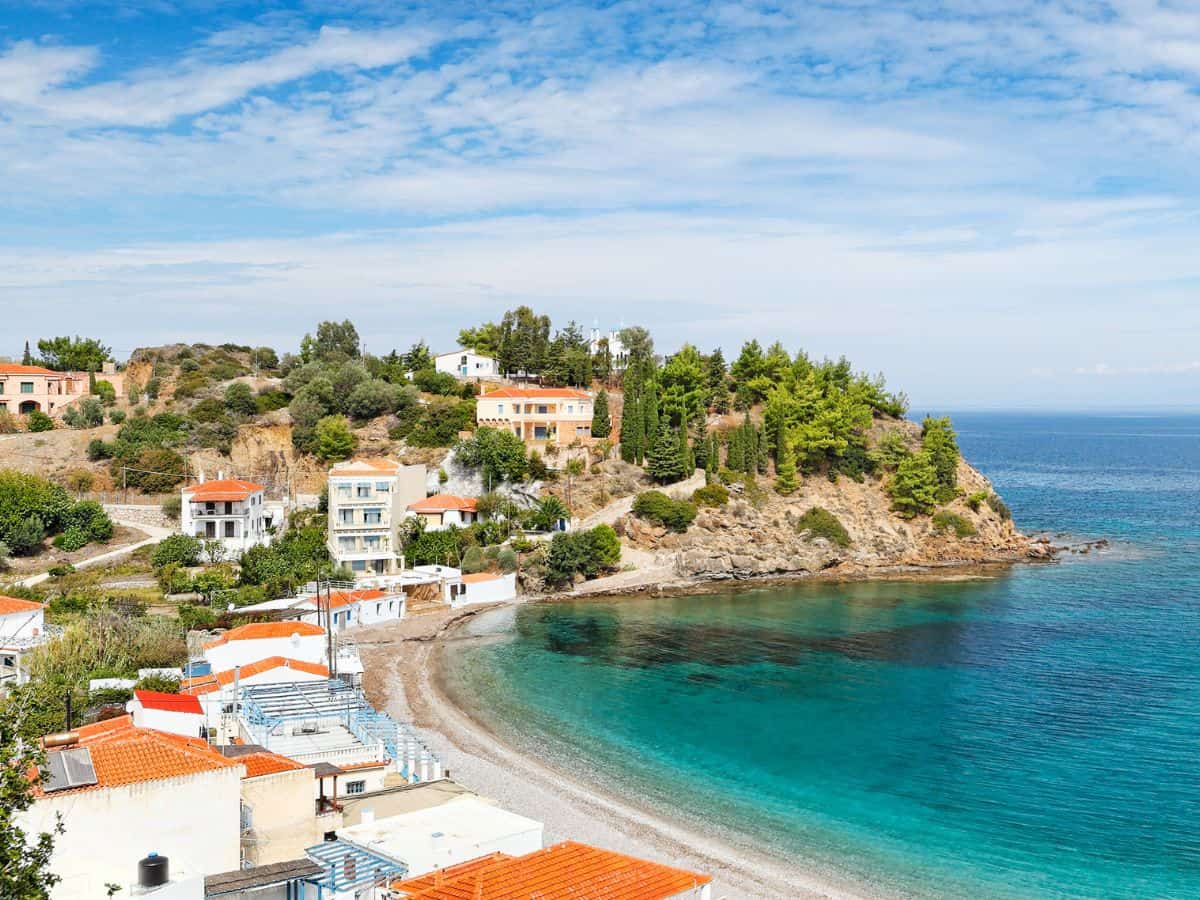
- Key Features : Famous for its medieval villages and mastic production, Chios has a unique identity. The island is dotted with distinctive stone houses and has a rich medieval history.
- Tourist Attractions : The Nea Moni , an 11th-century monastery and UNESCO World Heritage site; the mastic villages like Pyrgi and Mesta; and beautiful beaches such as Vroulidia and Mavra Volia.
- Where to Stay: Ostria Seaside Studios and Apartments, Almiriki Hotel
- Key Features : Known for its wine production and rich ancient history, Samos is an island with lush greenery, mountainous landscapes, and significant archaeological sites.
- Tourist Attractions : The Temple of Hera , a UNESCO World Heritage site; the Tunnel of Eupalinos, an ancient engineering marvel; and beaches like Tsamadou and Kokkari.
- Where to Stay: SeaView Apartment & Studios, Casa Cook Samos – Adults only
- Key Features : Famous for its longevity among inhabitants, Ikaria is a mountainous island with a relaxed pace of life. It’s known for its thermal springs and wild, untamed nature.
- Tourist Attractions : The Radioactive Thermal Springs of Ikaria, the scenic village of Armenistis, and the Seychelles beach.
- Where to Stay: Archipelagos Hotel, Patras Apartments
Limnos (Lemnos):
- Key Features : An island with volcanic origins, Limnos offers vast sandy beaches, ancient ruins, and a tranquil environment. It’s known for its traditional villages and local wine.
- Tourist Attractions : The ancient city of Hephaestia, the Castle of Myrina , and the unique landscapes of the Aliki wetland.
- Where to Stay: Arxontiko Hotel, Grand Patelli
Island Hopping Itinerary Routes- The Northern Aegean Islands
Lesbos – chios – samos:.
- Lesbos: 3 nights
- Chios: 2 nights
- Samos: 3 nights
Thassos – Lemnos – Samothraki:
- Thassos: 3 nights
- Lemnos: 2 nights
- Samothraki: 2 nights
The Sporades Island Group
The Sporades Islands, an enchanting archipelago, are nestled in the northwest Aegean Sea, off the coast of mainland Greece.
This cluster of islands is celebrated for insane greenery, stunning beaches, and crystal-clear waters.
They offer a more tranquil and unspoiled alternative to the busier Greek islands, providing an idyllic retreat for those seeking a serene yet captivating Greek island experience.
The Best Way to Get The Sporades Islands
The most common entry point to visit Sporades is via the city of Volos on the Greek mainland , which is well-connected by road and rail to major cities like Athens and Thessaloniki.
From Volos, you have the option to take a ferry or a high-speed catamaran to reach the islands.
The ferry service is more frequent during the summer months, catering to both passengers and vehicles.
Skiathos, the closest and most popular among the Sporades , serves as a gateway to the other islands in the archipelago, including Skopelos and Alonissos.
Alternatively, for those seeking a quicker route, Skiathos also has an airport that accommodates domestic flights, primarily from Athens.
The flight from Athens to Skiathos is short , taking about 30 to 45 minutes, and from there, visitors can easily hop onto a ferry to explore the neighboring islands.
Choosing the Best Sporades Island
- Key Features: Skiathos, the most accessible of the Sporades islands, is known for its nightlife and stunning beaches. It boasts over 60 sandy beaches, including the famous Koukounaries , and has a bustling town filled with charming shops and restaurants.
- Tourist Attractions: The Lalaria Beach , accessible only by boat, with its striking blue waters; the medieval ruins of Kastro; and the Skiathos Town with its lively harborside and nightlife.
- Where to Stay: Skopelos Village Hotel
- Key Features: Skopelos is celebrated for its lush green landscapes, traditional architecture, and being a filming location for the movie “Mamma Mia!” It’s a quieter, more authentic experience compared to Skiathos, with beautiful monasteries and churches.
- Tourist Attractions: The iconic cliffside Agios Ioannis Chapel , made famous by “ Mamma Mia !” ; the scenic Skopelos Town with its winding streets and charming buildings; and serene beaches like Stafilos and Panormos.
- Where to Stay: ELIVI Skiathos
- Key Features: Known for its natural beauty and marine park, Alonissos is the most remote of the inhabited Sporades islands. It’s a haven for nature lovers, with rich biodiversity both on land and in the surrounding waters.
- Tourist Attractions: The National Marine Park of Alonissos , a protected area offering superb opportunities for snorkeling and seeing marine life; the charming Old Town of Alonissos ; and secluded beaches like Chrisi Milia and Agios Dimitrios.
Island Hopping Itinerary Routes- The Sporades
Skiathos- skopelos-alonissos.
- Skiathos: 2 Nights
- Skopelos: 2 Nights
- Alonissos: 2 Nights
Greek Island Cheatsheet
If you’re familiar with the unique vibes of Greek islands and seeking the perfect one to match your interests, here’s a guide to some of the most common island themes:
Best Greek Islands for a Party

If you are looking for the Greek Islands known for a good time check out:
Best Greek Islands for Families
Traveling to the Greek Islands with the whole family? You want to check out these islands:
- Serifos, Greece
Best Greek Islands for Solo Travelers

When going to the Greek Islands alone you should consider these to be ideal:
Best Greek Islands for Foodies

Fancier yourself a foodie? These Greek Islands are KNOWN for their incredible cuisine:
Read Next: Best Greek Islands for Food Lovers
Which Greek Island Should You Visit? Take The Quiz!
Still not sure where to go? Take the quiz and find out what Greek Island is right for you based on your personality!
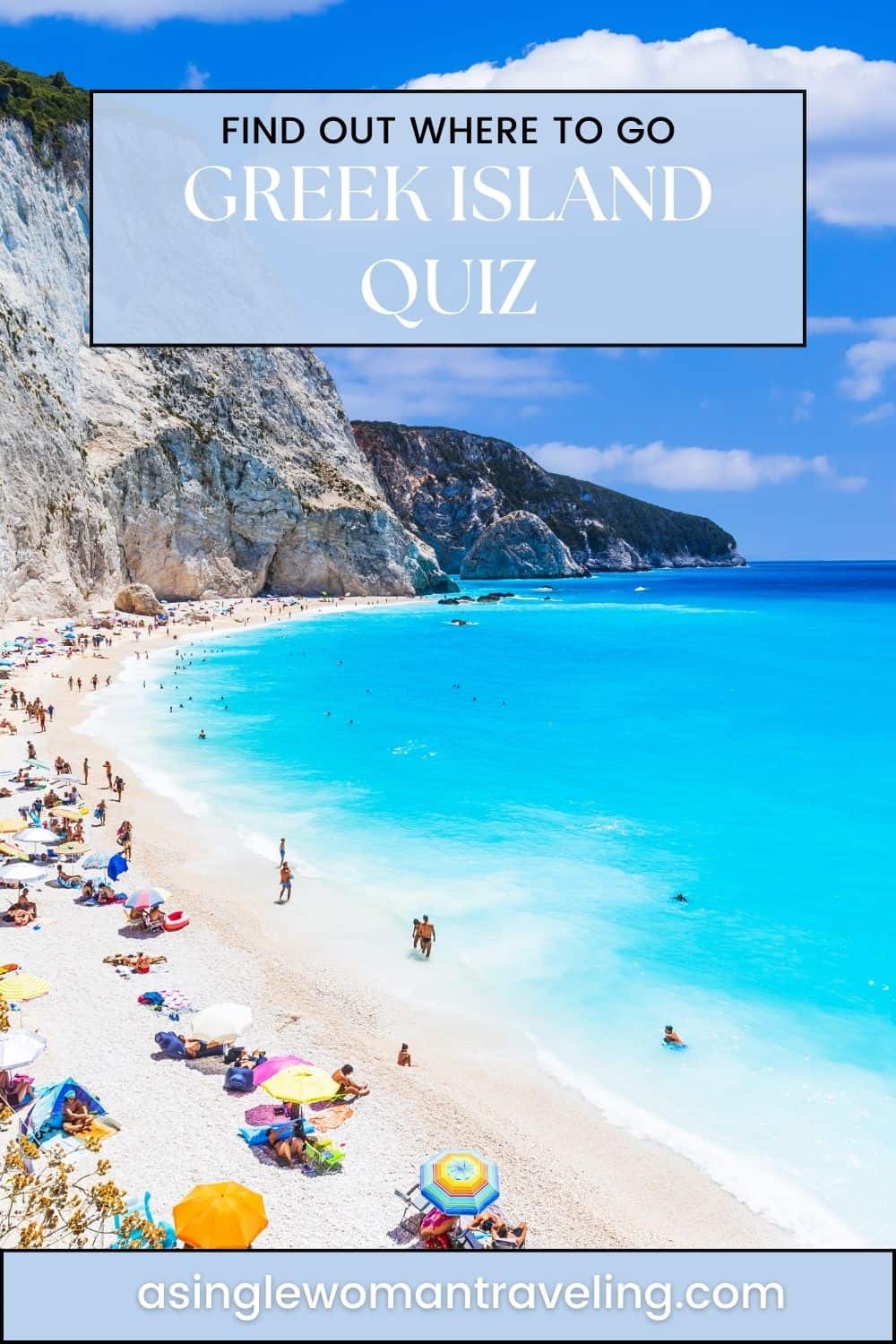
🫶 Did you enjoy this article? Help fellow travelers and share this guide with the buttons below!
Melissa Byron, a seasoned solo traveler since 2009, is the founder & visionary behind A Solo Woman Traveling. Drawing from her extensive personal experience globetrotting solo to over 40 countries, she has dedicated herself to a mission: crafting invaluable guides and itineraries for women who embark on solo adventures.
Related Posts

Are Solo Trips to Greece Safe For Women? The Truth From Female Travelers
If you are wondering “is Greece safe for solo female travellers” you’ve come to the right place. I have been taking solo trips to Greece for the past 10 years! It’s definitely a safe place for women to travel. In 2023, I moved and found a new home in Athens, a place where I’ve always…

Foolproof Copenhagen 3 Day Itinerary For First Timer’s + Map
Three days in Copenhagen will go by in the blink of an eye, so you want a well-thought-out itinerary. There is so much to see in Copenhagen from the famous Nyhavn Harbor, historic Tivoli Gardens, and the infamous Freetown Christiania. And without proper planning, you could miss something! While 3 three days in Copenhagen may…
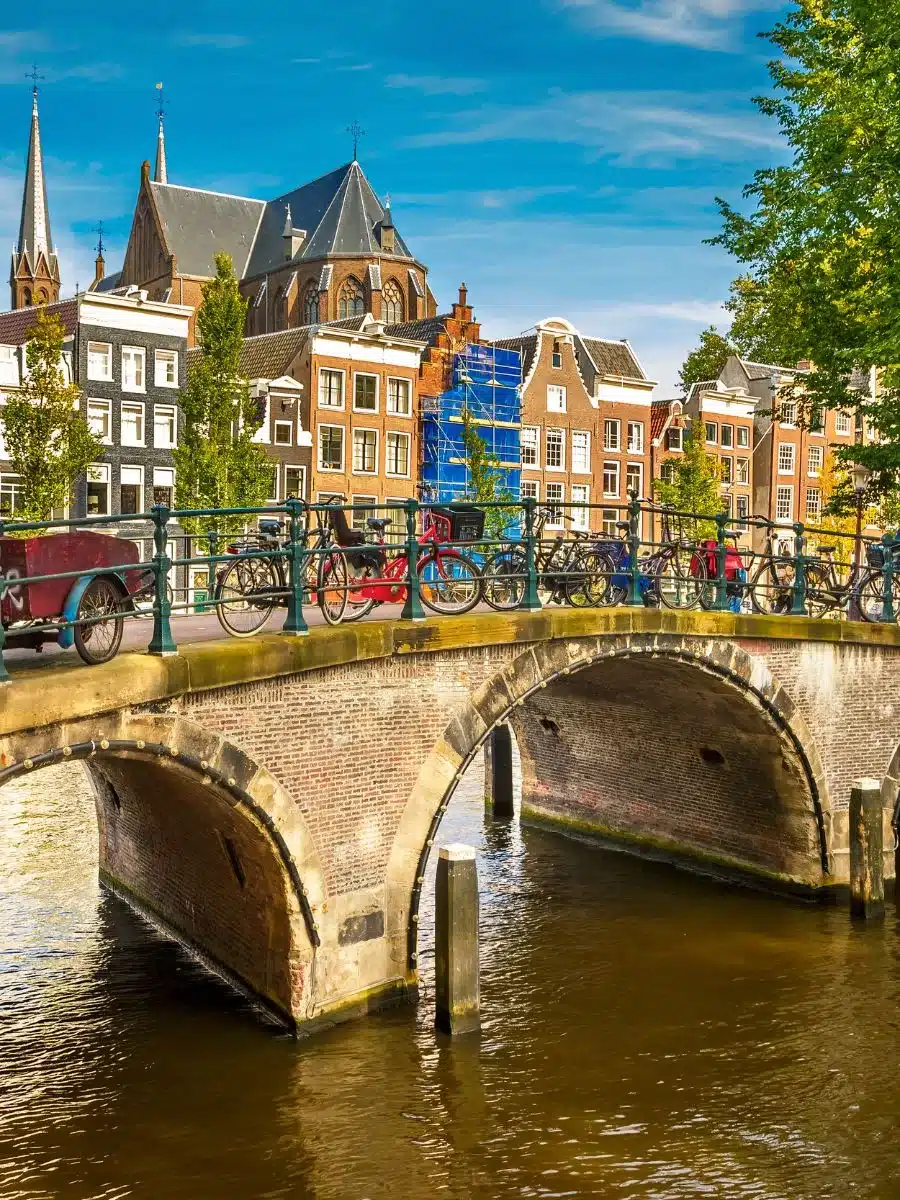
Ultimate Guide For a Safe Solo Trip to Amsterdam + Map
So you are thinking of doing a solo trip to Amsterdam? Right on, Amsterdam is awesome. But is the city safe? An important question to ask for sure. Let me give you some assurance, YES! Amsterdam is safe. Take it from me, someone who’d spend hours searching “Is Amsterdam safe for solo female travelers?” reading…

The Complete Day Trip to Verona Itinerary & Guide + Map
Let me take you on a day trip to one of my favorite Italian cities, VERONA! I’ve been to this picturesque town twice in the last few years! It is one of the easiest places to reach from nearby destinations such as Milan, Florence, and Bologna! Depending on where you are in Northern Italy, Verona…

How To Spend 3 Days in Belfast Solo + Map
Looking for ways to spend 3 days in Belfast solo? More and more women are traveling to Belfast solo, and I was one of them! I had only planned on visiting Belfast for one day, but I loved it so much I stayed for three! Belfast itself is pretty small, so if you don’t have…
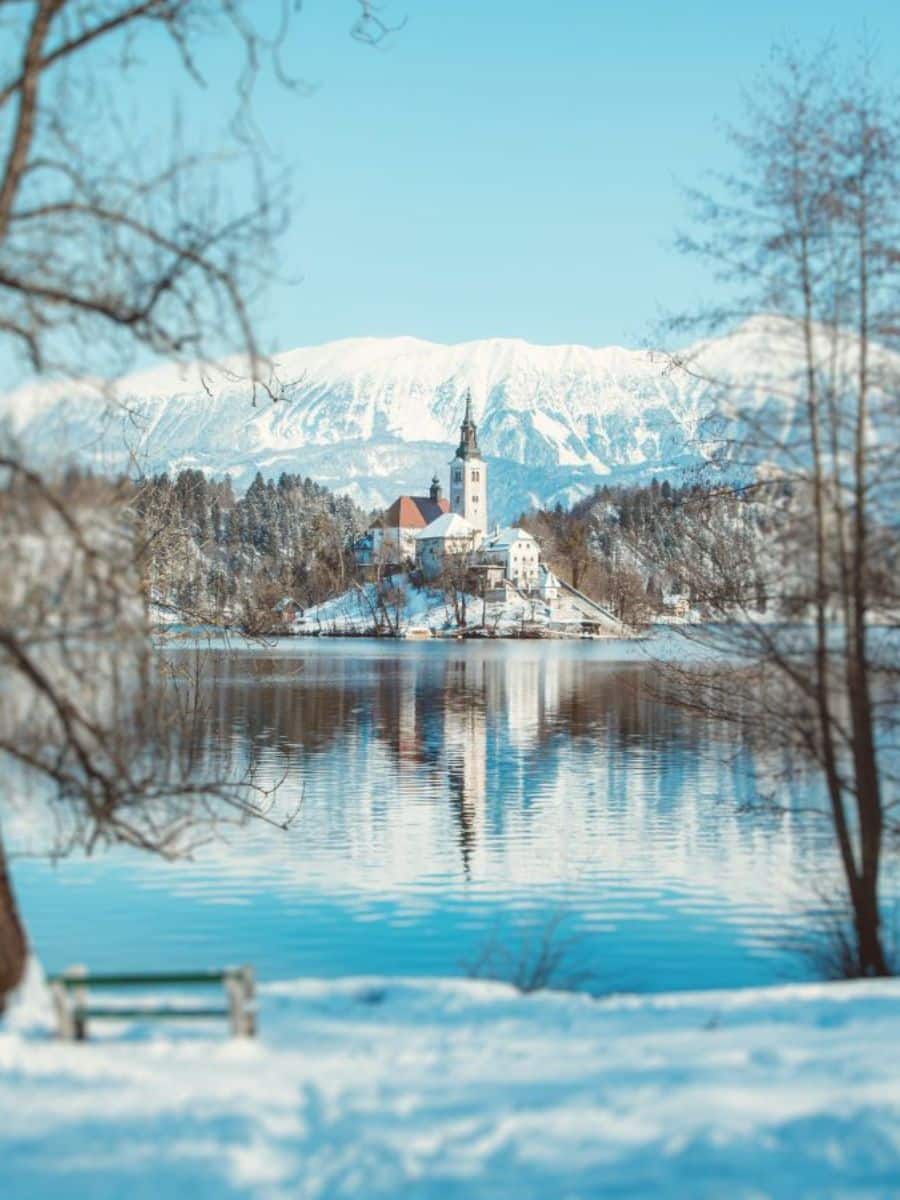
10 Most Magical Things To Do in Lake Bled in the Winter
Looking for the best things to do in Lake Bled in the winter? Though my visit was short, I was pleasantly surprised by all the fun things to do around the lake! It was the perfect little place to escape for a weekend. During winter time, Lake Bled is VERY quiet. I went at the…
What are you looking for?
Going Awesome Places
Detailed itineraries + travel guides
The Best Greek Islands Travel Guide – The Ultimate Guide to Island Hopping The Greek Islands
Last Updated May 1, 2024 William Tang
You are here: Home » Travel Guides » The Best Greek Islands Travel Guide – The Ultimate Guide to Island Hopping The Greek Islands
The beautiful sandy beaches, coastal coves, and white-washed villages are what make legendary vacations. If it’s your first time here, it can be overwhelming. Covering multiple seas and thousands of islands, planning a Greek island hopping trip isn’t as straightforward without some research, especially if you plan on island hopping. This Greek Islands travel guide is a must-read for anyone heading there soon, there is also useful information that will be helpful to discover the best Greek Islands to visit for the first time
Let’s dig into the practical things you might already be making plans for, suggest a few things you may not have already thought of, and let’s delve deeper.
Read more about Greece
- 14 day itinerary Greek Island hopping in the Western Cyclades
- Athens 2 day itinerary
- How to get from Athens to Santorini
- Is Santorini worth it?
- Read more Greece travel tips
TOP TIPS FOR THE GREEK ISLANDS
- Where to stay – Our two favorite properties on our island hopping adventure were Prekas Apartments in Santorini and Giannoulis Hotel in Milos where one had epic views and the other just blew our expectations in terms of comfort and space. We used Booking.com for all of our stays. Alternatively, you can always see if hotel corporate codes might work for you.
- Car rentals – Rent a car to get around the Greek Islands. Save the most money through car rental coupon codes and always start your search with Discover Cars and RentalCars so you know what the best deals are.
- Ferries – You will need to use ferries for island hopping. Get your tickets and check ferry schedules using Ferries in Greece .
- Flights – International flights are never cheap, but with the Skyscanner “Everywhere” feature you can find the best deals. Check how much it would be for you to get to Greece!
- Insurance – Make sure you’re covered for all of your adventure activities with the best travel insurance .
- Hottest deals – Never be without our frequently updated travel deals page .
In This Article
Greek Islands geography
Which islands to visit, getting there, getting around the greek islands, where to stay in the greek islands, what to pack for the greek islands, when to visit the greek islands, how much does a trip to the greek islands cost, 5 main takeaways, frequently asked questions, travel resources for your next trip, the best greek islands travel guide.

This Greek Islands travel guide will primarily focus on The Cyclades Islands, but it will also have information relevant for those planning trips to the whole Greek Archipelago, which spans 6,000 islands and takes up 7,500 km of the country’s 16,000 km coastline.
WHAT YOU NEED TO KNOW
- 1€ EUR = $1.11 USD = $1.45 CAD
- ATMs can be found all over and the credit cards are widely accepted
- SIM card – The three main companies in Greece are COSMOTE , Vodafone, and WIND . All companies have some sort of pre-paid package available. Some are more aggressive about promoting in Athens with street stands but others you have to visit a shop for. As an example, Vodafone offers 9.2GB for 20 EUR or 4GB for 10 EUR on top of minutes.
- Alternative data options – Airalo is what we used in Greece because eSIMs are so easy nowadays. Make sure to use our code WILLIA9500 to save $3 USD.
- Measurement system – Metric
- Tipping – Not a strong culture of tipping but is expected in the service industry. In general 10% is the rule of thumb.
- L anguage – The official language is Greek .
Back to the top
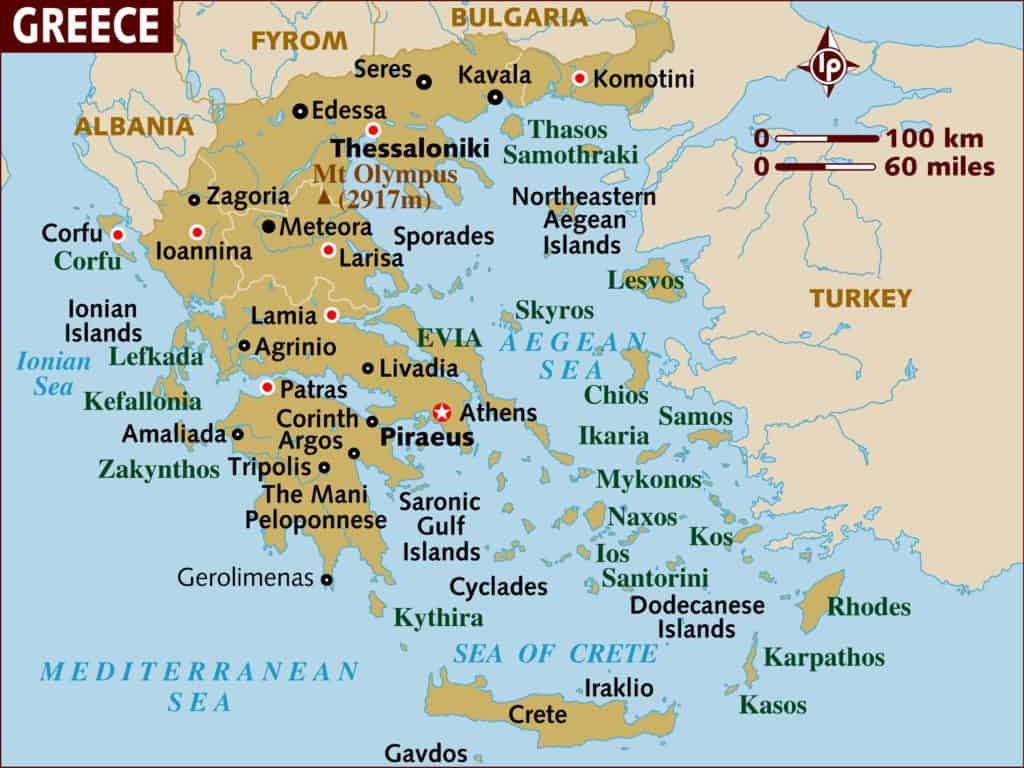
There are at least 6,000 islands in Greece scattered throughout two different seas. To grasp how wide it spans, you need to know the breakdown of these islands and the clusters that form this stunning archipelago.
In this free Greece travel guide we break it down between the two seas that are involved: Aegean and Ionian.
In the image below the boxes give you an idea of some of a few of the clusters of islands that you can visit in Greece.
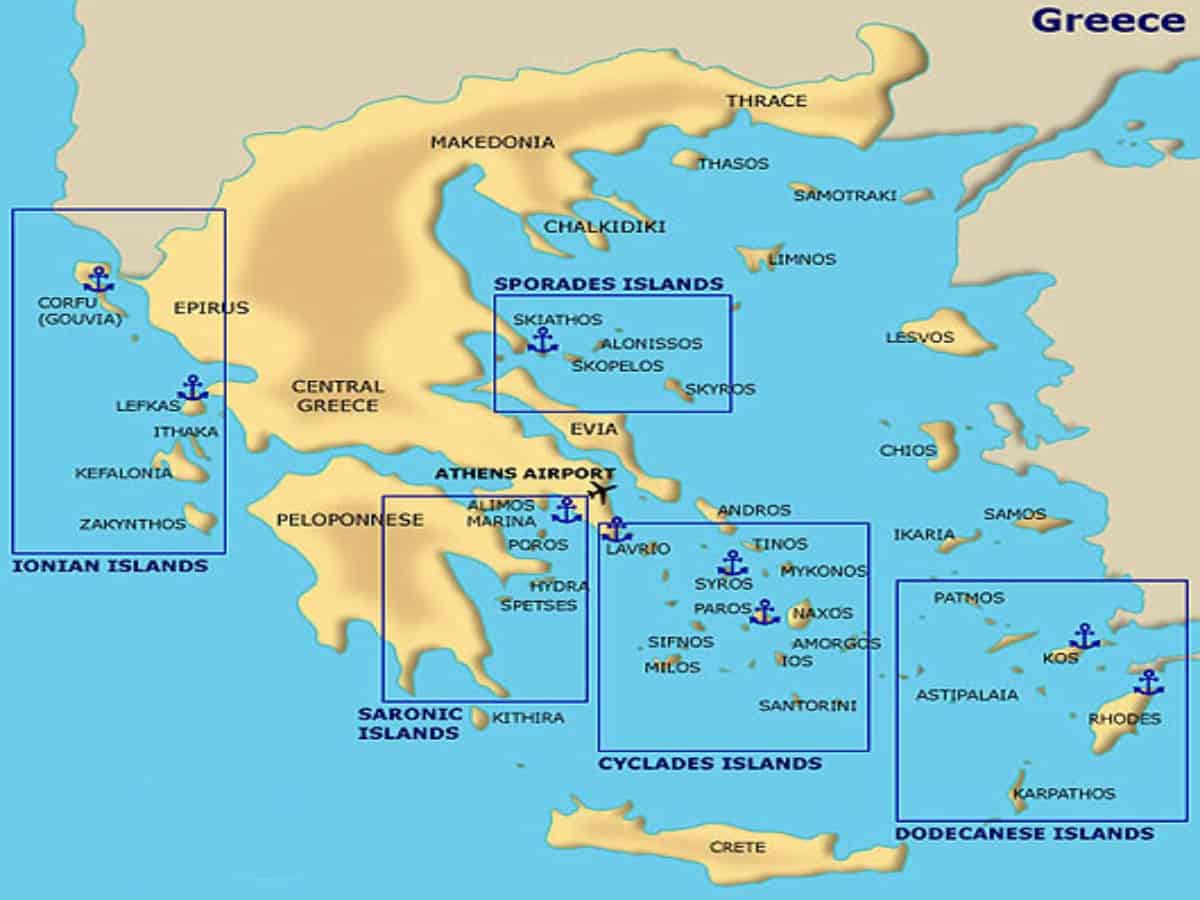
The Northeastern Aegean Islands – Agios Efstratios, Thasos, Ikaria, Lesbos, Limnos, Inouses, Samos, Samothrace, Chios, Psara.
The Sporades Islands – Alonissos, Skiathos, Skopelos, Skyros.
Evia – The island of Evia is the second largest Greek island after Crete and is also known by its ancient name of Euboea. Its close proximity to Athens on mainland Greece makes it a popular destination for the residents of Athens. It is bordered by the region of Viotia, (latinized as Boeotia or Beotia) to the east, with the south touching the Aegean Sea, before spreading into the Evian Gulf.
Islands of Argosaronic – Angistri, Aegena, Methana, Poros, Salamina, Spetses, Hydra.
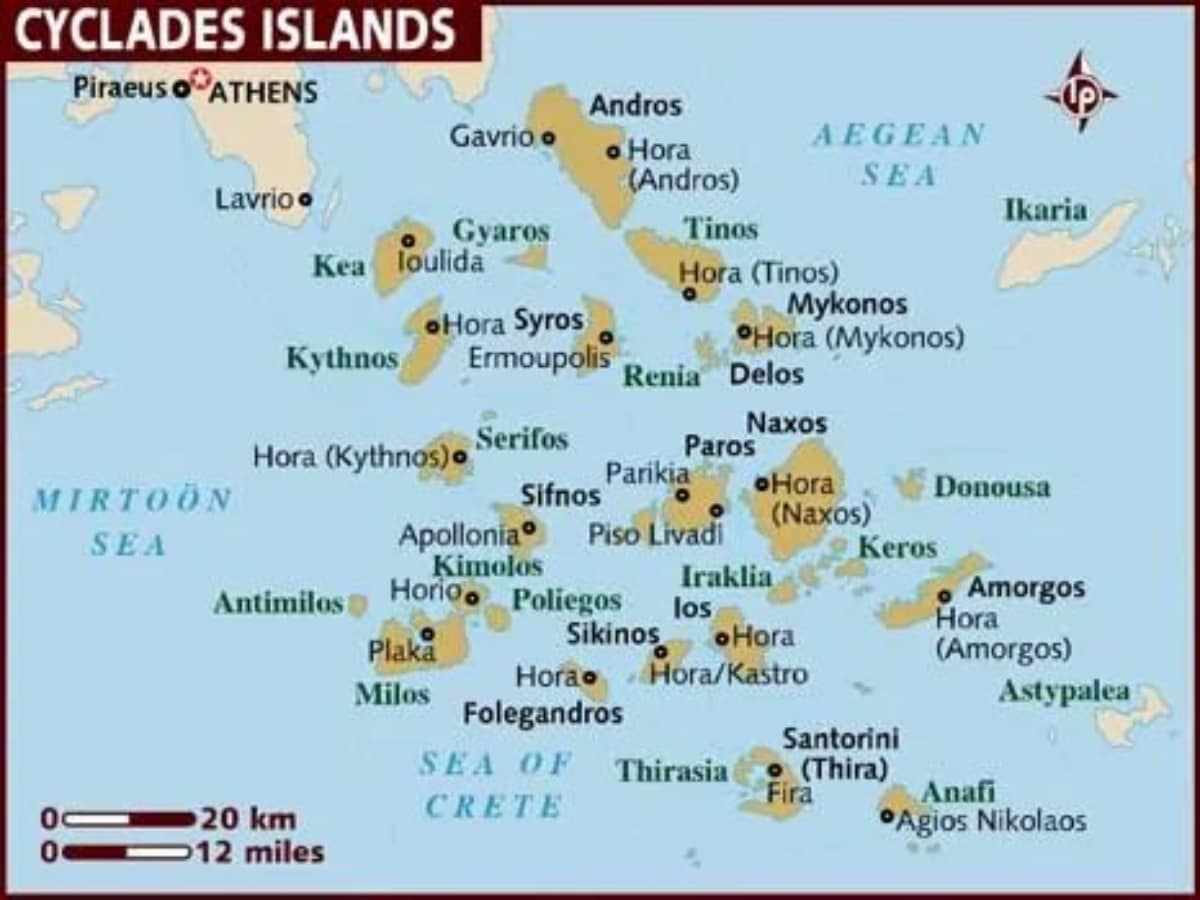
The Cyclades – By far the largest island group with a total of 56 islands, the most important ones being Andros, Antiparos, Delos, Ios, Milos, Mykonos, Naxos, Paros, Santorini, Syros, Folegandros and several others, as well as the ‘Minor Cyclades’ comprising Donousa, Irakleia, Koufonisia and Schinousa.

The Dodecanese – Astypalaia, Kalymnos, Karpathos, Kasos, Kastellorizo, Kos, Lipsi, Leros, Nisyros, Patmos, Rhodes, Symi, Tilos, Chalki.
Crete – Crete is the largest of the Greek islands and is divided into four prefectures: Chania, Rethymno, Heraklion and Lasithi.
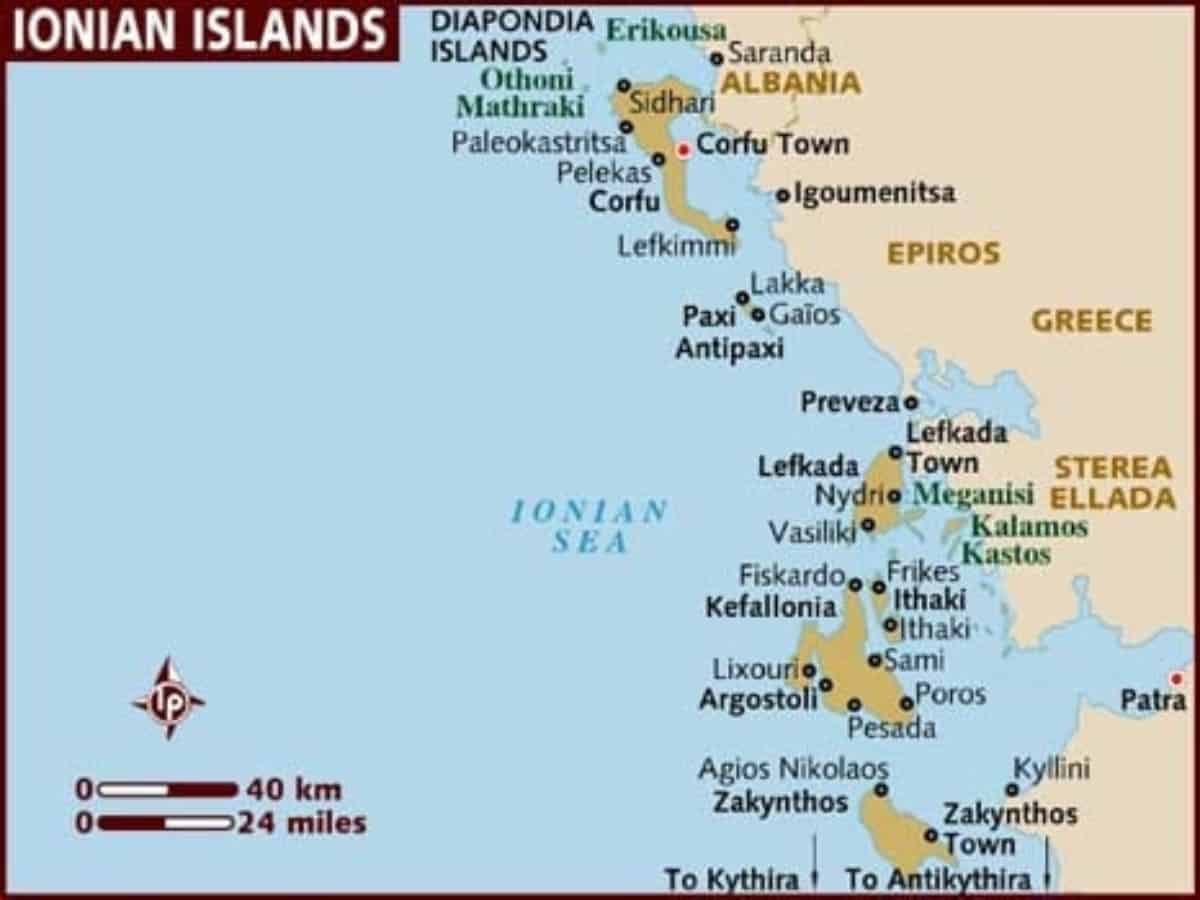
The Ionian Sea is to the west of mainland Greece, and while they may not be as famous as the ones in the Aegean Sea, they are equally beautiful and are often visited more by the local Greeks.
The Ionian Islands – Zakynthos, Ithaca, Corfu, Kefalonia, Lefkada, Paxi, and Kythira
From here, it breaks down into smaller islands – Antipaxi, Ereikoussa, Kalamos, Kastos, Mathraki, Meganissi, Othoni, Skorpios, and Strofades.
There are a few groups of smaller islands that don’t really belong anywhere, including the islands of Gavdos (situated south of Crete), Elafonissos (in the Gulf of Laconia), and Trizonis (in the Gulf of Corinth).
How do you choose which is the “best Greek island to visit”? We wanted to start with a few baseline itineraries. First we checked out the Greece travel itineraries of G Adventures and Intrepid Travel to get a few ideas to form our own Greek Islands travel guide.
To help you through that thought process we broke down how we ended up here in our 14 day Greece island hopping itinerary :
- Decide which sea you want to do – Ionian or Aegean?
- For a trip spanning 2 weeks, pick a cluster to focus on. Jumping between island groups makes ferries complicated, distances long, and time wasted. You want to optimize the time you have with minimal transport so you can spend precious time exploring and soaking up the islands.
- If there’s a specific island you want to visit, for instance Santorini, skip steps #1 and #2. It also helps to know whether Santorini is worth visiting , read that alongside this Greek Islands travel guide.
- Divide your number of trip days by 3. That’s how many islands to visit without rushing your way through. For example on our 14 day trip we could only fit in 4 islands comfortably. You could try to fit in more if you were really ambitious. Our guide how many days in Santorini you need should help give you an idea of how to gauge your time in each place.
- Research blog posts and look at photos. Here, we committed to visiting 2 popular islands and 2 lesser known ones of Greece .
With this guide and content created for your Greece travel, we hope it’ll make your trip planning easier.
BEFORE YOU CONTINUE
You need to read the the full 14 day Greek island hopping itinerary to get an idea of how to plan and choose the right islands in the Western Cyclades. Read that after this Greek Islands travel guide.
2 Week Greek Islands Itinerary

For our trip, we focused on how to get from Athens to Santorini , but for a more general look, you should learn about flying vs. ferry.

Greece’s primary international airport is Athens Eleftherios Venizelos International Airport (ATH). It’s your main way in and out of the country coming from an international destination.
As the capital of Greece, flying into Athens makes sense. If it’s your first time you should make some time to explore the city. It is also home to the ports that will take you down to the Western Cyclades area of the Greek Islands.
Not all islands have airports, but the larger ones do, including Santorini, Mykonos, Naxos and a few more. So if you can fly into these airports easily you can start your trip from one of these before moving onto your next destination.
There are direct flights to Santorini! From Europe you can grab one from Thessaloniki, Naples, Rome, Venice, Milan, Barcelona, Prague, Frankfurt, Paris, Amsterdam, and London.
Once in Greece, the main national carriers are Aegean and Olympic Air. RyanAir is a discount carrier that also services Athens and Santorini. We recommend using Skyscanner or the Skyscanner app to find the best prices on flight tickets.
When visiting the Greek Islands, you’ll likely fly in via Athens. If time is tight and cost is no issue, fly into Santorini and then fly out of another island with an airport. Then you’ll likely be taking ferries in between the islands.

The primary way to get around to the Greek Islands is by ferry. It’s not the fastest, but they run frequently, and they hit islands you can’t fly to. They also do run somewhat on time so you can plan your travel between islands fairly accurately.
Traditionally, visiting the Greek Islands means starting in Athens and island hopping with ferries exclusively. This is the most cost-effective method but takes time because the trip from Athens to any island is usually going to be your longest leg. Ferries function like buses and stop at multiple islands, they’re usually on time but delays and cancellations can sometimes happen.
Ferry companies
There are a number of ferry companies out there that operate between the islands and the mainland. The main ones that are relevant for The Cyclades are Blue Star Ferries, SeaJets, Golden Star Ferries, Hellenic Seaways and Aegean Speedlines. For the rest you can find out more information here .
Ferry itinerary
When planning your island hopping itinerary, using a tool like Ferries in Greece makes things easier. We dub this tool the “Skyscanner of ferries.” You can basically enter in the itinerary as you would a flight search tool, and it’ll give options and prices to choose from.
Use this Ferry Planning Tool
FerryHopper allows you to find out what ferry companies are operating to and from Santorini. We recommend using this to help with trip planning.
- Are there any discounts? – We found that if you aren’t a local or able to take advantage of a large pass, there weren’t any codes or promotions to take advantage of but it never hurts to check.
- Can you save money staying with one ferry line? – Even if you do a multi-leg journey, there are no discounts or reasons to use one particular line but you can also jump around between different companies. You don’t need to stick to one.
- Is there a point in waiting to book ferries? – Only if you’re still unsure of your plan. Once you have that there’s no point in waiting. Ferry prices don’t drop if you book last minute and you don’t want your specific route to sell out, which in peak seasons can easily happen well in advance. Make sure to use Ferries in Greece to get organized as soon as you have your plans confirmed.
Getting the ferry from Athens: Piraeus vs. Rafina
In Athens there are two ports:
- Located to the east of Athens
- Closest to the city center of the two ports
- There is a convenient direct bus from Athens Airport
- Takes 30-40 minutes to get here from Athens Airport by bus
- No metro options to get to Rafina
- Fewer ferries run from this port
- Bus from the airport costs 4 EUR
- Located to the south west of Athens
- Primary port from Athens
- There are more ferry route options that operate from here
- Various different options to get to Piraeus (bus, bus + metro, metro)
- Takes one to 1.5 hours to get here from Athens Airport by bus
- Bus from the airport costs 6 EUR
Taking the bus from Rafina
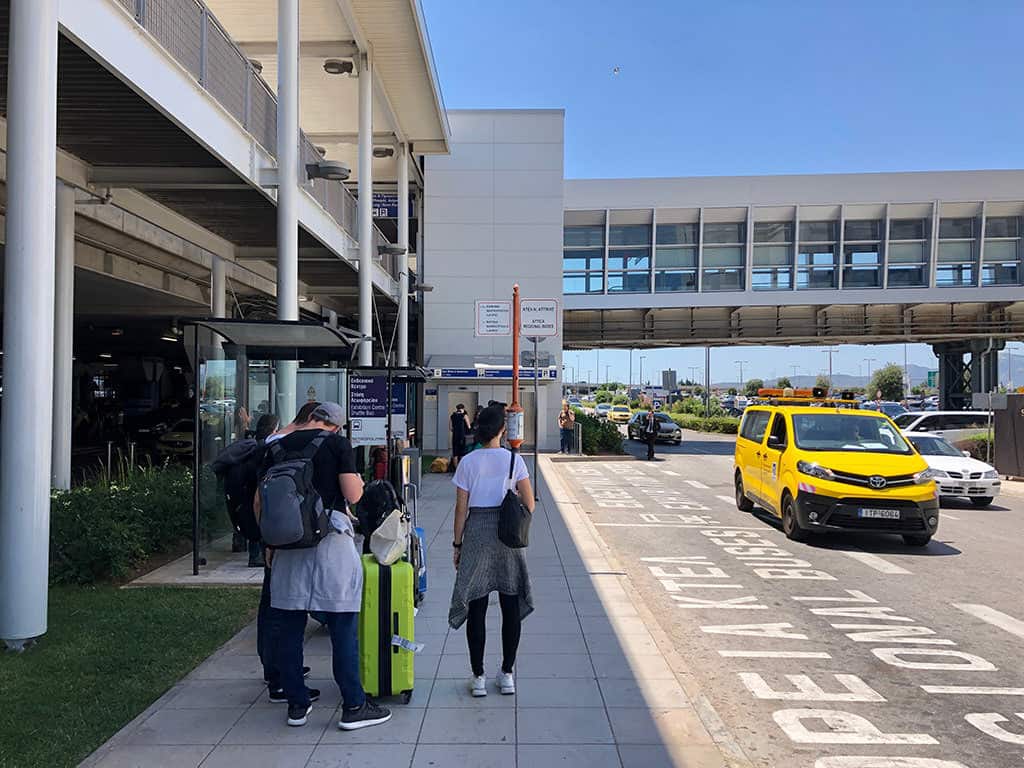
The Rafina bus is privately-run and the location isn’t where you may expect compared to the bus to Piraeus. The bus is located right across from the Mitsis Hotel at the airport, between Exits 2 and 3 where you’ll first cross the street.
The bus schedule can be found here . Note that this bus is not 24 hours, so check the schedule based on your flights. Credit card is accepted for booking.
Taking the bus from Piraeus

If you’re headed to Piraeus, look for public bus number X96. The ride is about an hour and the full schedule is here . This bus runs 24 hours.
Note that public buses on the arrival level are easy to find because all signs for public transportation will point you that way.
You can purchase your tickets at the booth and you are also able to pay by credit card.
Boarding and disembarking ferries
Every ferry company is slightly different because each ship is constructed and run differently. But there are general similarities that you can expect from boarding to disembarking.

On most islands there is a waiting area at the port where they have divided columns. Sometimes they’re labeled with the right ferry route and times but usually it’s not that organized . If in doubt, ask other people if you’re in the right place. Some waiting areas are just an open lounge and someone will yell out the next ferry when it comes in. Sometimes there’s no covered waiting area at all and you just find a random place to sit. This is all part of the charm of Greek island hopping!
As the boat arrives, everyone seems to automatically know to start a queue and the attendant lets you know when it is your turn to board.

Boarding – Once the ramp is down, cars and passengers that are arriving at the port exit first. Then they’ll call everyone waiting to board to walk up the ramp and put your luggage on the racks available in the cargo/car hold. There’ll be stairs on the left and right heading up to the main deck of the ship and there’ll be someone scanning tickets there. After that, head up and grab a seat or watch the action from the open rear of the ship.

Disembarking – When the ferry is close to the destination port, they’ll make an announcement for everyone to gather in the cargo hold. You’ll then head back downstairs and grab your luggage. Once the ramp drops down, the crew will be yelling and ushering for everyone to quickly get off. So make sure you are organized and move fast!
About Piraeus
The boarding process is a little different in Piraeus because of its massive size and all of the unloading is done on arrival so they’re waiting for you to board. There’s no luggage held down below. Instead, you bring your luggage to the cabin and store it in shelving areas. These are relatively safe but we recommend dropping by your cabin when the boats start docking to make sure nobody takes their chances during disembarking.
Your ferry ticket will have a specific gate you need to go to so account for time to figure out where that is. If you take a look at the map below, the subway is closest to E5 and E6.

- Gate E1 – Ferries for Dodecanese Islands (Rhodes, Kos, Kastelorizo, Kos etc) – Blue Star Ferries / Superfast Ferries
- Gate E2 – Ferries for North Aegean Islands (Lesvos, Chios, Samos) (Blue Star Ferries & Hellenic Seaways)
- Gate E3 – Ferries for Crete. (Minoan, Anek, and Blue Star Ferries)
- Gate E4 – Ferries for Crete and other small islands such as V.Kornaros and Prevelis
- Gate E5-E6 – Blue Star Ferries for Cyclades
- Gate E7 – Speedrunner, Highspeed 4& 6, and Nissos Mykonos
- Gate E8 – Ferries for Saronic Islands, catamarans and hydrofoils
- Gate E9 – SeaJets and Zante Ferries (E10 is the exit, E9 is the entrance)
- Gate E11 & Gate E12 – Cruise ships gates, only for passengers of the cruise ships.
Onboard experience

- Bringing food onboard – They didn’t seem strict on outside food at all so feel free to bring your own picnic.
- Assigned seats – Seats are automatically assigned with ticket purchase. For the less-crowded inter-island ferries, nobody checks your tickets for your assigned seats. They usually don’t care if you move somewhere else within the same class.
- Electrical outlets – There weren’t any by our seats.
- Bathrooms – Several onboard and we found all of them to be pretty clean.

- Announcing stops – There are announcements made in Greek and English so it’s clear what the next port is even if your Greek isn’t quite up to scratch.
- WiFi – Many offer paid wifi. On Golden Star Ferries it’s 3.50 EUR for 3 hours.
- Those that get sea sick easily – My wife gets sea-sick quite easily and she did okay for most ferries because the water was relatively calm. If this is an issue, sit on the outside rear deck for fresh air and the ability to focus on the horizon. You can also prepare with dramamine and sea sickness bands if you tend to suffer.
- Upgrading classes – The business-class section always had their own deck or closed off area but all we saw was that they had access to somewhat larger seats, maybe a window and a table if that’s important to you. For the longer distance ferries, some have cabins. This might be worth booking to get some sleep if your ferry is overnight.
Ferry Travel Tips:
- They run the AC pretty high inside the boat so make sure you have a jacket or sweater on-hand. Something light and packable like this is good to always have in your backpack .
- There is no access to the front of the ships, so you can only be outdoors if you stand on the rear deck.
- Set an alarm on your phone if you think you’re going to sleep. The disembarking process is very swift and you don’t want to miss it or be in a rush and forget to grab all your belongings.
- Make sure the phone number you put on your booking is the actual phone number you’re going to have when you are in Greece. We know that’s hard for those wanting to pick up a local SIM, which is why something like Airalo actually makes more sense because you know your number when you land. Ferry companies do send out SMS to let people know about delays, changes in schedule, and cancellations so it is really helpful to make sure your phone number is correct.
- Ferries are sometimes on time but not always. For us, some ferries were pretty on the dot, and others showed up 15 minutes late. Make sure you don’t plan your schedule to be so tight that you can’t absorb any delays.
Checking in online vs printing your tickets

What you’ll find different from flying versus taking a ferry is that the technology hasn’t advanced very far in Greece.
You can purchase all of your ferry tickets online, but only a few companies have a way of checking in online. One of them is Golden Star Ferries . This was a pleasant surprise because we were able to check in weeks in advance and have tickets with a QR code printed.
Other companies use old-fashioned printed tickets which need to be picked up. You have to go to very specific offices to have these tickets printed. Plan around visiting the designated offices for the ferry tickets you don’t have. They usually have one by the port but don’t expect it to be the official ferry company. Instead, they partner with third-party travel agencies so make sure to read the instructions to collect your tickets.

As an example, we took Blue Star Ferries to Paros and Golden Star Ferries to Santorini. Our last set of ferries was with SeaJets and we didn’t get a chance to go to one of their offices to have physical tickets printed. In Santorini, the SeaJets partner is Nomikos Travel in Fira so we made sure to drop by our first day. Note that these offices charge 0.50 EUR per ticket . We aren’t sure if all agencies have this extra surcharge but it is something to keep in mind.
All of this is to say that you need to have physical ferry tickets in hand, whether they be digital or physical. When you book your ferry tickets with Ferries in Greece you can then arrange where to pick up each set of tickets you need.
BOOK YOUR FERRIES
Getting from Athens to Santorini
We found there to be a lot of intricacies when it came to our trip from Athens to Santorini . Be sure to read our full guide if this is part of your itinerary.
The main question you’ll have is – is it better to fly or take the ferry? All of that gets answered here .
You need to read the 14 day Greek island hopping itinerary if you’re having trouble figuring out which islands you should visit and honest feedback on how it all went.

When visiting the Greek Islands, you’ll want to explore. Luckily most islands aren’t overwhelmingly large, however, you can’t walk everywhere you might want to.
Unless you plan on exclusively staying at your resort, you’ll need to plan on which days you need a vehicle and note what type .
The challenge you’ll face is deciding whether you should rent a traditional car or an ATV. Scooters are also available but we wouldn’t recommend them unless you ride them frequently or have a ton of experience. Some of the roads are pretty basic and other drivers are likely more comfortable with the terrain and route, making it a hotspot for inexperienced riders having accidents.
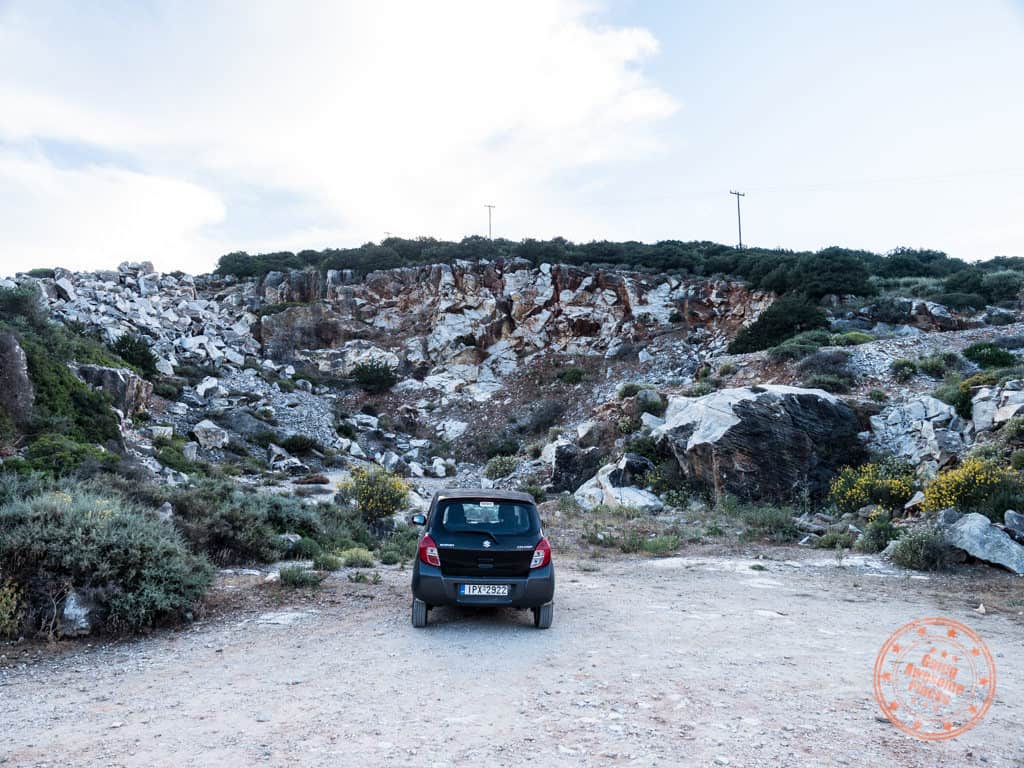
The tried and true method of getting around the island. Car rental companies are everywhere and the process to rent them is simple.
Depending on your requirements (having a larger group of people, moving luggage, comfort, experience, etc.), the car may be your only choice. With a car, you know what you’re getting and on most islands, all the places you’ll go are paved so there’s no issues getting around.
If Santorini is in your plans, check out this guide on where and how to rent a car in Santorini .
Pro: Fits more than 2 people, protects from the sun, stays cool with air condition, spacious and can transport more things.
Con: May not be as capable, or even possible, when it comes to off-road, uses slightly more gas and is less exciting than the alternative of an ATV. If you’re staying in old town areas the roads may not be accessible for cars.
- You need an international driver’s license . This is an absolute must so don’t forget to get one from CAA or AAA (if you’re from North America) before you go.
- Ask about car insurance and know your coverage options.
- When renting a car, make sure to ask for your transmission of preference because they will assume manual if you don’t say anything.
- Ask for recommendations on how much gasoline you should fill in the tank based on where you’re going and how many days.
- Most cars you will rent in Greece are never full so there’s always the worry about whether you’ll have enough and how much to fill off the bat. You will need a lot less than you think. As an example, in Paros we filled up to the max from 3 ticks down on the gauge and after 2 days we barely used one tick. Filling up 48 EUR was a big mistake because 10 EUR would’ve been enough.
- What you see listed by a car rental company isn’t always the price they offer. There’s always an element of negotiation or they would just offer up automatic discounts. Yes, this may have been because we were in Greece during low-season but never be shy about asking for a discount. The fluidity of the price is why some car rental companies didn’t even allow me to take photos of their pricing sheet.
- Discounts can only be had if you pay by cash.
- During low season, reservations don’t seem to be necessary but would recommend it during high season.
- With a car, you can take advantage of the extra storage by loading up on supplies at the grocery store.
- You might not need the car every day so plan your itinerary in a way where you only need it for a grouping of days to save money.
- Think about whether it makes sense to rent from the port or not. It’s advantageous for those wanting a round trip rental from the point you get off the ferry to when you need to get on it again. Alternatively, some car rental companies allow you to pick up a car from one place and drop it off at the port. These are called one-way rentals and some have a minimal charge for it and others might add a significant fee.
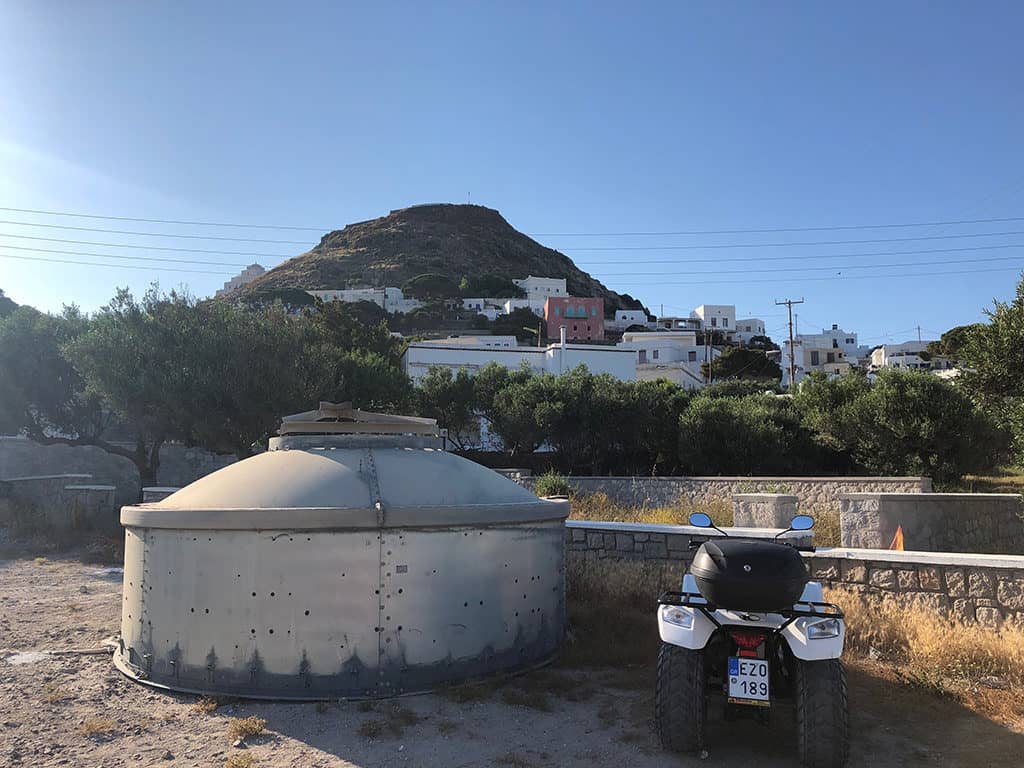
We don’t know any other place in the world where ATVs are this prevalent but it’s totally a “thing” on the Greek Islands. You’ll see them everywhere and be tempted to try it.
If there are two of you, and at least one is comfortable with driving an ATV, it’s a fun way to get around any island. They are incredibly handy when it comes to going off-road and in tight spaces because they are much smaller and more capable of handling all types of terrain.
The disadvantage is storage space. You’ll need to make sure your items can be strapped onto the vehicle or fit inside the storage compartment. We had lots of camera gear and things were tight but we managed to fit it.
If you’re not totally confident in driving an ATV on your own but still want to try the thrill of it, try this guided ATV tour through Santorini to get the hang of it while enjoying sights, local foods and wines along the way
We recommend trying the ATV on an island that has less traffic and large roads, such as Santorini, Milos or Paros, so you can get comfortable with driving around, especially if it’s your first time.
Pros: Off-road capabilities, great on tight turns (a factor in Milos ), uses less gasoline and loads of fun!
Cons: Minimal storage space, no cover from the sun, learning curve to learn how to drive, not as safe as a car and no AC.
ATV Travel Tips:
- You need an international driver’s license !
- Ask about insurance and know your coverage.
- Test the ATV and make sure that brakes work well before you leave the lot.
- Ask for a bungee cord if one isn’t provided to strap things to the front of the ATV.
- Similar to the car, most rental companies will offer discounts, especially during low season.
- The rear passenger on the ATV will be responsible for navigating by your phone’s GPS.
- Bring a sun hat and plenty of sun protection if you are visiting in the summer months. It is really easy to burn while cruising around in your ATV and you won’t feel it until you stop.
- Are ATVs easy to drive? It’s quite easy to drive because it’s automatic. You’ll just have to get used to making sure you hold the brake handle down when changing from Park to Drive and getting out of the habit of having your right foot rest on the secondary brake.
- Do you need more power than 170CC? We drove all over the island with our 170CC ATV and had no issues when off-road and climbing hills.
- How much fuel should I fill up for 2 days? On an island like Folegandros , we only used a fifth tank of fuel in two days.
Local buses

Every island has their own bus system – some better than others. It’s an economical option and possible to travel exclusively by bus.
The challenge you’ll face is you’ll be at the whim of their schedules and routes. It’ll get you to most places but some spots on the island you won’t reach.
Cost of the bus ranges from island to island but we’ve only seen it go as high as 3 EUR.
Where the bus works really well is in Santorini. There are multiple routes, they’re comfortable coach buses and they only cost 1.80 EUR .
Pros: Prices and one of the few options for those who don’t have a driver’s license.
Cons: Most buses don’t run 24/7, you are limited to their route schedule.
Bus Travel Tips:
- Cash only. Try to have smaller change or notes available.
- Payment is taken on the bus. You either pay the driver or the ticket attendant who goes around once the bus starts moving.
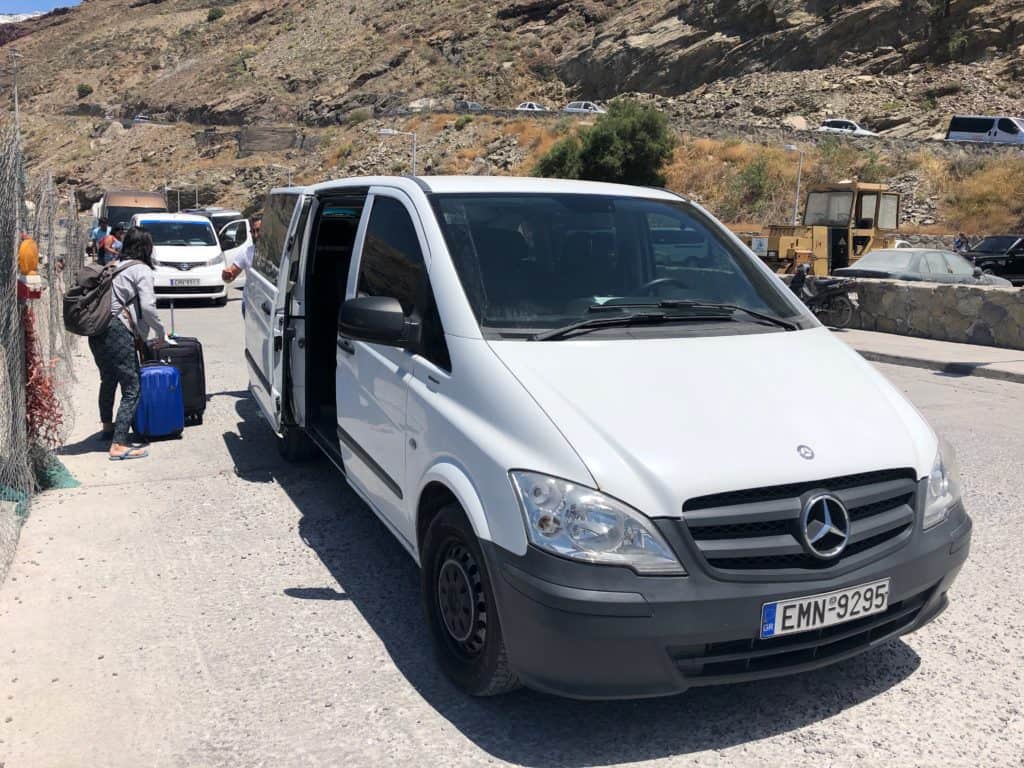
Taxis are the least cost effective way of getting around but may be necessary sometimes. Where it makes sense to take a taxi is when needing transport from your airport or ferry port to your hotel and you’re not renting a car right away.
Taxis work just like every other country. They normally run on a fixed fare system but we didn’t find this to be consisten t. In most cases, you’ll hop in one and hope for the best. If you read any of our individual island guides , you’ll see we’ve shared some of the rates we paid but keep in mind that rates can change over time so don’t take our rates as the set price for you to expect. Use them as a rough guideline.
There was no Uber coverage anywhere. This may change in the future but we wouldn’t plan on using Uber on the islands.
Pros: Door to door service and convenience.
Cons: Expensive, at the mercy of their rates, may require some pre-planning in terms of booking particularly in less built-up places.
Taxi Travel Tips:
- In some instances, it’ll be smart to book a shuttle service in advance. This can be done through your hotel or online . You can save money and you won’t have to deal with the chaos that ensues when you arrive. We find that GetYourGuide has plenty of shuttle service options for most of the destinations you will arrive at on your Greek island trip.
Where to book your hotels, car rental, ferries, flights, activities
- Hotels – Booking.com has the best inventory of properties and with their Genius tier, you can save even more money.
- Car Rental – If you’ve read our guide, you can book with the big brands combined with car rental coupon codes or you can use RentalCars to do a search of most companies. Make sure to also read the guide on how to rent a car in Santorini .
- Ferries – My go-to booking platform is FerryHopper .
- Flights – Use Skyscanner to look for cheap flights using the Everywhere feature and also setting price alerts.
- Activities – Always compare between Viator and GetYourGuide to get the best price.
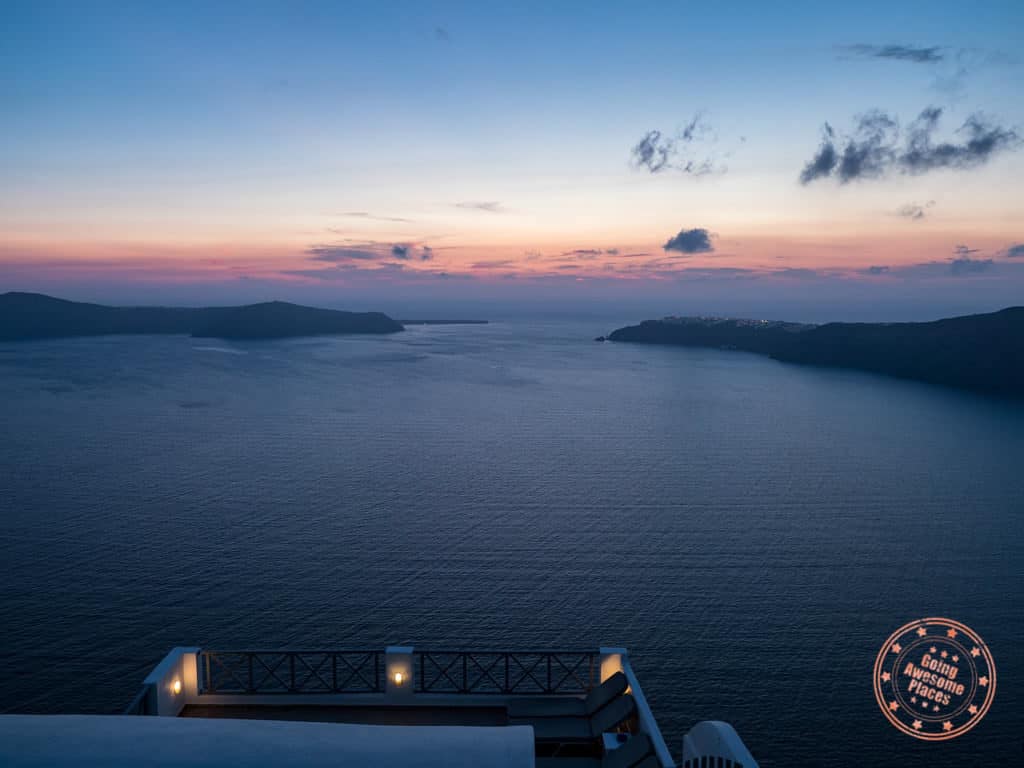
Depending on the island, you’ll have too many choices (Santorini, Mykonos, Milos), few choices (Folegandros, Sifnos, Serifos), or somewhere in between (Naxos, Paros).
Where You Should Stay in Santorini?
Where is the best area in Santorini to stay? Is Fira and Oia worth it? Read on to find out an honest look at each of the major towns and why you should consider each.
Where To Stay in Santorini
Instead of specific recommendations in this Greek Islands travel guide, we’ll share what we learned from planning our island hopping trip:
- Large chain hotels aren’t easy to find on the Greek Islands. Santorini and Crete are the exceptions. Everywhere else will be family-run hotels, villas, guest homes, B&Bs and budget-friendly hostels.
- There are Airbnb properties but many are the same listings you’ll find on Booking.com . We recommend Booking.com over Airbnb because there are better cancellation policies.
- We use Booking.com to book all of our accommodations. Getting up to Genius level only requires 2 bookings. Once you’re at that level many properties offer 10% (level 1 Genius) and 15% off (level 2 Genius).
- Book at least 8-12 months in advance in busier islands such as Santorini if you want something that has a view.
- For accommodation recommendations read our individual guides for each island we visited ( Paros , Santorini , Folegandros , and Milos ).

Traveling to the Greek Islands doesn’t require a highly technical packing list. But it is good to prepare so you don’t feel caught out while travelling.
- International Driver’s License – Hopefully we’ve got this drilled into your head. Make sure to get one before you go.
- Sunscreen – You can buy this there if you want to save on packing space. Between two people over 14 days, we’d recommend two full-sized bottles.
- Sunglasses – An obvious one, don’t forget these!
- Daypack: You always want to make sure you have a day pack when you’re travelling, particularly if you are planning a beach day. Those collapsable backpacks like the New Outlander are great for this. If you want something studier for camera gear the Thule Covert DSLR Rolltop Backpack is a great option, just less portable than the Outlander.
- Shirts: In the summer a shirt is great for throwing on as added sun protection, in the cooler months its something you would wear most days anyway. Pack them in the Eagle Creek Pack-It Specter Cube to keep them nice and tidy. If you haven’t yet started using packing cubes these will be a game changer.
- Pocket cap: The Outdoor Research Radar Pocket Cap is a great travel hat simply because you can fold the brim. This makes it incredibly easy to pack and even while on the road, I can easily stick the cap in my back pocket if I want to take it off but not go through the trouble of putting it into my daypack.
- Packable layers: It doesn’t make a lot of sense to bring an umbrella when you can bring a waterproof shell jacket which also doubles as an additional layer. Shells like this are perfect for travelling because they’re versatile, light and easily rollable. Whether it be on the ferries or windy up on the caldera of Santorini, you never know when you might need that extra layer. Hoodies are also a great option.
- Shoes: The Merrell Moab Ventilators Hiking Shoe have been the bread and butter of all my trips for years now. They’re incredibly comfortable and great in all situations. These ones aren’t waterproof but for city walking, this fits the bill. As a sandal the Rainbow Sandals, Double Layer Leather Sandal I have reviewed extensively before and I can’t go on a summer trip without these. They’re just so damn comfortable and great for extended periods of walking. An alternative is the KEEN H2 Newport Sandal – My review holds this as one of the best sandals on the market. I love them because they’re just so versatile in summer conditions. Amphibious is the word that comes to mind. Perfect for beach days.
- Packable Towel: Accommodation owners don’t like when guests use their towels at the beach. Ask for a beach-friendly one or pack your own . Don’t make the mistake I made with quick dry towels and buy a small one. It’s just not worth it to annoyingly dry yourself with something the size of a hand towel. This one is great because it’s large (XL in fact), packs into a small form factor, and dries quickly. While mostly used in hostels, this is the kind of thing that’s always nice to have with you as it doubles up for the beach if needed.
- Insect repellant: Big cities usually aren’t a problem but again it’s one of those things where you never know, particularly if spending time near the beach. Pack the Off Mosquito Repellent just in case.
- Travel toiletries case: I’ve been very happy with this Muji toiletries organizer because of it’s simplicity in design and comprehensiveness in terms of pockets, zippers and elastic holders. The must-have feature for any toiletries organizer is the hook. Hanging your bag is always a better option than letting it sit on the sink especially if you’re using communal hostel washrooms.
- Plug Adapters for UK and EU : I have a random assortment of plug adapters I’ve collected over the years. Always do your research beforehand but in Europe you’re mostly dealing with these two types of plugs. Universal adapters are good but the problem is with all the devices you have you’ll need multiple. I find that individual adapters like mine are more useful.
- Non-drowsy Gravol – If you get motion sickness pack this.
- Exchange Euros – It’s always a good idea to have Euros with you immediately after you land. Don’t leave the airport without at least some Euros otherwise you might find yourself scrambling around to find exchange offices and be at the mercy of their rates.

Low-season (November – March)
Let’s start with when not to go to the Greek Islands. Winters are pretty mild compared to other parts of Europe, but it’s quite variable with high chances of rain and dreary days.
In the low season the ferry and flight schedules are also reduced so your options are limited. Most of the islands are populated by seasonal workers, so you’ll have to contend with skeletal services, facilities and closures. Count on many hotels, restaurants, and activities (especially water-based ones) being closed.
The advantage is not many people travel to the islands in the winter so you won’t see many tourists. Things won’t be as lively as they normally are in other parts of the year, which if this is the kind of trip you are looking for, the low season is perfect.
Spring to Summer (April – Mid-June)
One of the best times to come. Flowers are blooming, the weather is warming and the large tourist hordes haven’t quite arrived yet.
Shoulder season means better prices and vacancies for hotels.
At this time of the year, flights and ferries switch to their full capacity schedule or close to it. Restaurants typically don’t need reservations and car rental companies are willing to offer additional discounts.
This applies even more for popular islands like Santorini. Make sure to read the best time to go to Santorini .
High-season (Mid-June – Mid-September)
This is the height of travel. Expect every aspect to be more challenging whether it’s hotels, car rentals, restaurants, ferries, flights or activities. You can also expect for prices to skyrocket for everything, this is the least economical time to travel and prices can get wild.
Not only are you contending with massive crowds, but the temperature is the hottest if that is a consideration for your trip to the Greek islands.
The only exception to this is in the north with islands like Samothraki and Thassos. They’re only super busy between July and August so you can get the summer heat with less of the volume of people. Some of the more popular islands are super busy and not as enjoyable in the summer so if tranquility is the aim of your trip add Mykonos, Crete, Kos, and Zakynthos to a list of Greek islands to avoid.
Summer to Fall (Mid-September – October)
The transition to Autumn is a great time to visit the Greek Islands. Similar to Spring, the weather is more temperate with the sea balmier than the air. Green lends its way to subtle Fall colors and that has its own beauty well worth experiencing while Greek island hopping.
If you’ve come from our Greek Island Hopping in the Western Cyclades itinerary , you’ll see the full breakdown of costs from that trip. Flights are excluded because they vary drastically from person to person depending on your starting point.
The category breakdown of our spending looked like this:

$2318.82/person or $165.63/person/day . Backpackers will look at this and say that’s too much and those looking for a luxury trip will think it’s too little. We’d say that we were pretty moderate when it came to making decisions on our trip.
Where we splurged:
- Getting a nicer hotel in Santorini
- Nicer dinners where it made sense
Where we saved money:
- Finding affordable properties outside of Santorini thanks to Booking.com .
- Avoided excursions and activities.
Cutting costs:
- Don’t rent a car/ATV – rely on buses or stay in an area where you can walk everywhere.
- Hop to fewer islands.
- Avoid big islands and focus on lesser-known ones.
- Find cheaper hostel accommodations through Hostelworld .
- Buy your own groceries to save money on meals where it makes sense (breakfast especially). There is something lovely about picking up pastries from a local bakery and enjoying it on a morning walk or sitting by the beach.

In short, this is what to know when planning a trip without reading this entire Greek Islands travel guide:
- You should have booked your Santorini hotel yesterday! This is the most popular island and gets booked up fast.
- Pick a good balance of popular and small islands – don’t be afraid to try the unknown ones like Folegandros .
- Always break change – you never know when you’ll need it.
- Fill no more than 5 EUR at a time with your car rental or ATV.
- It’s easy to let your guard down when you go back to Athens after spending time in the Greek Islands. Stay vigilant and beware of pick-pocketers immediately (read my story in the Athens 2 day itinerary ).
Santorini is the safest Greek Island to travel to, as it is one of the more popular islands, so there are always other tourists around. Here, locals are known to be very friendly and helpful to tourists, crime rates are low, and the transportation systems are highly rated as being reliable and safe to use.
The more affordable islands are Crete, Andros, Tinos, Corfu and Naxos, as they are less popular islands than some of the other well-known. Therefore, they are less travelled so prices on these islands are much cheaper than ones like Santorini.
Well you read this guide of course! Ultimately it depends on the type of experience you are looking for and the amount of time you are working with. For instance, if you don’t have much time during your travels the Saronic Islands are recommended since they are all close to Athens. If you are looking for the islands with the best nightlife, the Cyclades are for you. If you’re a foodie, you want to visit Crete! All islands offer something unique, so determining your visit will be unique to you!
Have specific questions about your upcoming trip to the Greek Islands? Drop a comment below in this Greek Islands travel guide!
What you should read next
- Best Places To Stay In Crete – A Guide Of The Best Towns And Areas!
- Best Area To Stay in Santorini Guide
- Best Places To Stay In Corfu – Top Areas And What To See When There
- How To Backpack Europe On A Budget
- Cheapest Way To Travel Europe – Getting Around On A Budget
If you’re in the process of planning your trip and putting together your itinerary, these are genuinely the best resources that the Going Awesome Places team stands by 100% .
Credit cards: Don’t get burned by hidden fees on top of terrible exchange rates. When we travel now, we use the Wise Card . Simply load it with the currency you need before you go and use it as a regular VISA or their digital wallet card. Use their free app to track how much you have and top up when you need to.
Flights: Of all the booking search engines, Skyscanner is the most helpful and easy to use thanks to their Everywhere feature . Kayak is also another that’s we will often check as well.
Car Rental: If you’re looking to save money, these car rental coupon codes will be a true game-changer. Otherwise, DiscoverCars and RentalCars are great places to start.

Airport Parking: You’ll need a spot to leave your car at the airport so why not book a spot at a discount. Use code AWESOME7 to get at least $5 off at Airport Parking Reservations or Park Sleep Fly packages.
Data: We’ve been a huge fan of wifi hotspot devices like PokeFi (use code GAP24300) because their rates are so good and you can use it globally but recently, we’ve really loved using eSIMs. The best one is Airalo . Save money by getting region-specific eSIMs and use referral code WILLIA9500 to get $3 USD credit on your first purchase. Ubigi is another one that we’ve had success with where they uniquely offer 5G coverage. Use code AWESOME10 to save 10% on your first order.
Hotels: Our go-to is Booking.com because they have the best inventory of properties including hotels and B&Bs plus they have their Genius tier discounts . The exception is Asia where Agoda always has the best prices. TripAdvisor is also useful for reviews and bookings.
Vacation Rentals: Your first instinct will be to check Airbnb but we always recommend checking VRBO as well if you’re looking for a vacation rental.
Tours: When planning our trips, we always check both Viator and GetYourGuide to at least see what’s out there in the destination that we’re going to. They often have different offerings and prices so check both.
Travel Insurance: Learn how to buy the best travel insurance for you. This isn’t something you want to travel without.
- Insured Nomads – Popular insurance provider for frequent travelers and comes with great coverage and special perks.
- RATESDOTCA – Search engine Canadians looking for the cheapest insurance including multi-trip annual policies.
- SafetyWing – A perfect fit for long-term nomads.
- Medjet – Global air medical transportation.
- InsureMyTrip – Best for seniors, families, and those with pre-existing conditions.
If you need more help planning your trip, make sure to check out our Travel Toolbox where we highlight all of the gear, resources, and tools we use when traveling.
Find us on social media

Real Greek Experiences
Greek Culture, Travel Information, Itineraries, Life in Greece
Greek Island Hopping: A Step-By-Step Guide For Beginners And Not Only
Island hopping in Greece is an experience of a lifetime! The stunning scenery, crystal-clear waters, delicious food, and rich history and culture make for a fantastic trip. Here are all the tips you need to plan your Greek island-hopping trip entirely on your own.
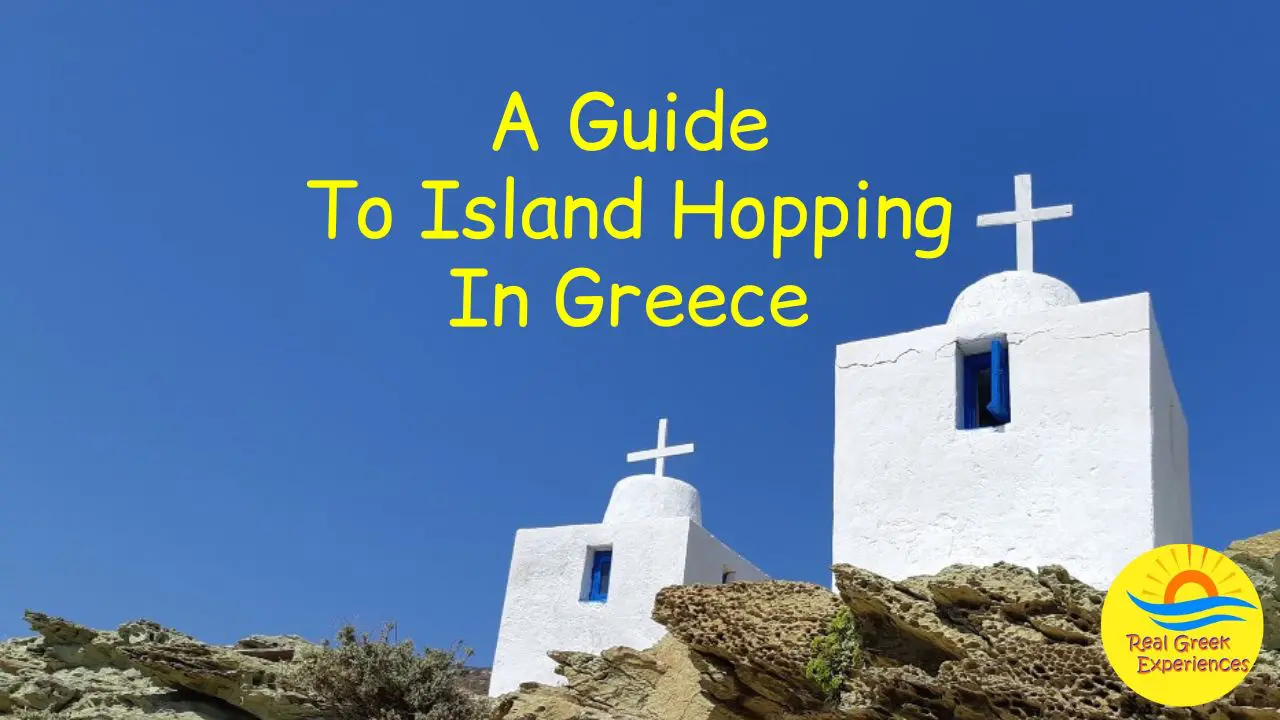
How to travel between the Greek islands by ferry
Island hopping in Greece is a unique experience. From the amazing beaches to the picturesque villages and numerous ancient sites, there is so much to explore on each island.
With well over 100 beautiful islands to choose from, planning an island hopping trip to Greece might seem like a daunting task. In reality, though, it’s not that hard to plan your Greek vacation on your own.

I’m Vanessa from Athens, and I’ve been island-hopping in Greece since I was a kid. I’ve travelled to over 60 of our islands, and I wrote this guide to help you plan your own island hopping trip in Greece. Here is my step-to-step guide and my best tips!
1. Research the best time of year to visit the Greek islands
Before you start planning to travel to the Greek islands, you should know that Greece has four seasons. In fact, winters in Greece can be surprisingly cold and damp. Most of the coastal resorts, even on world-famous islands like Santorini, actually shut down in winter!
The best months to visit the islands of Greece are from May to September, when the weather is warm and you can enjoy the beautiful beaches.
However, keep in mind that July and August are peak tourist season, and many islands will be crowded. If you’re looking for a calmer vacation, consider visiting in May, June or late September.
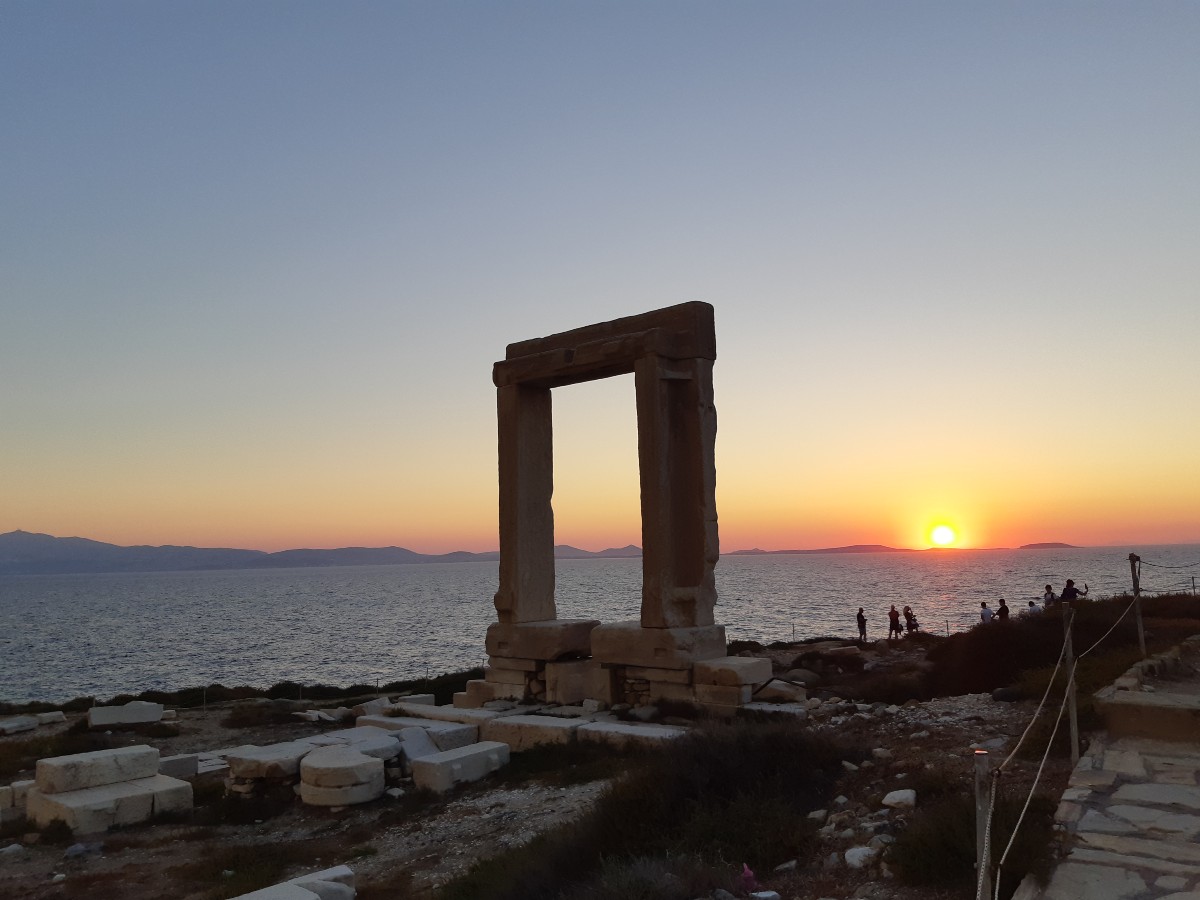
April and October are also good options, though the weather can be a little hit and miss. If you are looking to visit in April or early May, you could plan your trip around the Greek Orthodox Easter celebrations , which are very unique.
For some more insight, have a look at these articles:
- Best time to visit the Greek islands
- Hottest Greek islands to visit in October
2. Check a map of Greece and see where the islands are
As you are starting to plan your trip, look at a map of Greece. You will notice that most of the islands are clustered together in groups. The main Greek island groups are the following:
- Cyclades islands , known for their white-washed houses and dry, rocky landscapes. Mykonos , Santorini , Paros, Naxos and Milos belong to the Cycladic islands.
- Saronic islands , which are located close to Athens and are known for their cosmopolitan feel. Examples are Aegina, Hydra and Spetses.
- Sporades islands , known for their verdant landscapes. There are four islands in this group – Skiathos, Skopelos , Alonissos and Skyros.
- Dodecanese islands , which are the furthest away from Athens. Some of them are Rhodes, Kos, Symi , Tilos and Nisyros .
- Northern Aegean islands , some of the lesser known islands in Greece. Lesvos, Chios and Ikaria are some of the biggest ones.
- Ionian islands , which are known for their long sandy beaches and thick forests. Corfu , Kefalonia and Zakynthos are the most popular ones.
- Crete , Greece’s largest island, which is located to the south of the Greek mainland.
- Evia , a large island close to Athens, which you can reach via a bridge.
For more information on what each island group looks like, have a look at this introduction to the Greek island groups .
3. How to plan your Greek island itinerary
To plan your Greek island itinerary, research the islands and their attractions, allocate time for each island, plan accommodation and transportation, create a rough daily itinerary, and be flexible in case of unexpected changes.
That was easy, eh? Let’s break this down further!!
So, if you are like most people, you will have about one or two weeks to spend in Greece. In order to save time and avoid last-minute stress, it’s usually best to plan your itinerary in advance.
First, you will need to decide which islands you want to visit. While it can be an overwhelming task, it becomes a lot easier if you narrow them down by island group, or proximity on the map! Then, you can decide if you want to focus on the most touristy islands, or perhaps some small islands that you don’t know anything about.
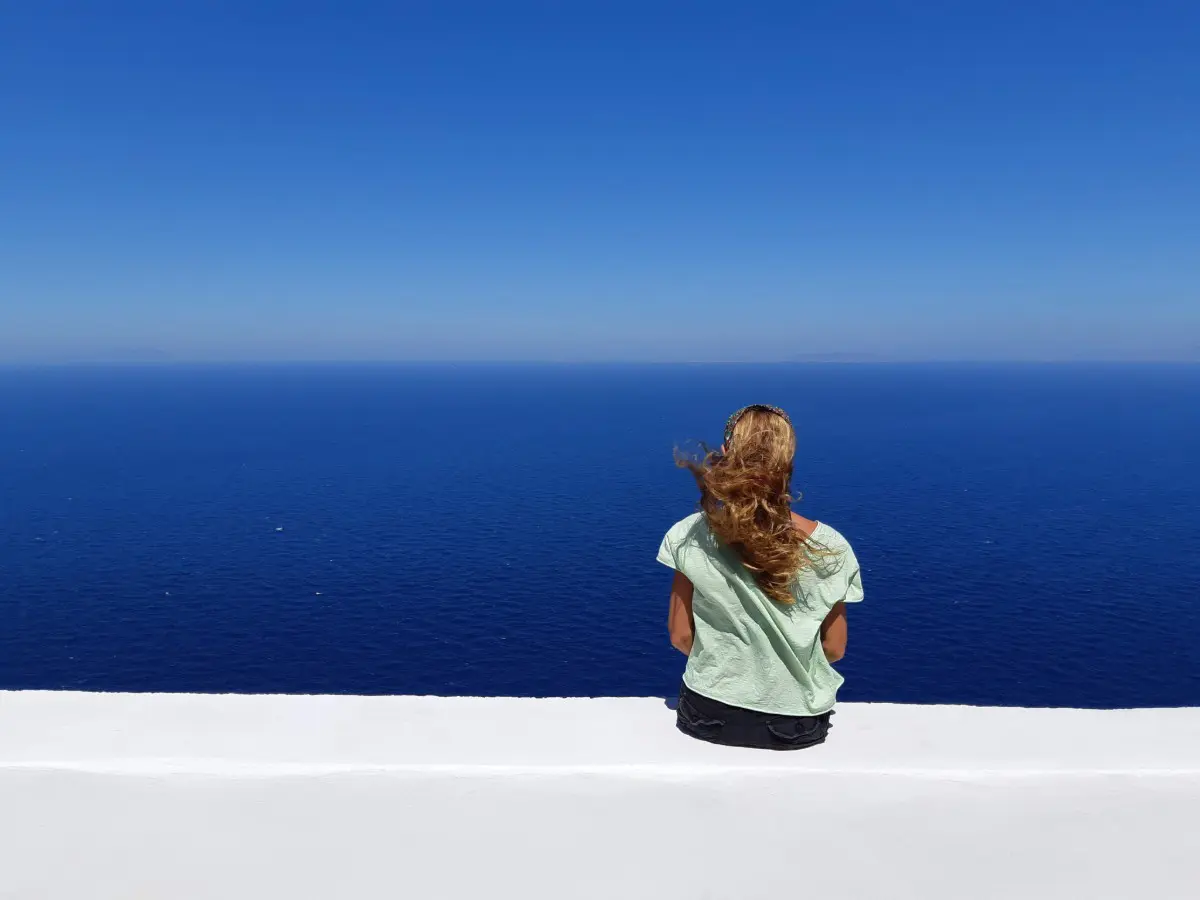
As you are planning your itinerary, you will need to check transportation options between the islands. It’s much easier to visit islands that are directly connected to each other via ferry.
I use a search engine called Ferryscanner to check ferry routes and book my ferry tickets. Most ferry itineraries are released a few months in advance, so there’s plenty of time to plan. You can also see past ferry routes on a site called Openseas . While exact routes may change from one year to the next, this will give you a pretty solid indication.
Find the best Greek island hopping routes
My best tip when island hopping in Greece, is to visit islands which are connected on direct ferries. Usually, these belong to the same island groups.
Some examples are:
- Santorini, Mykonos, Paros and Naxos
- Andros and Tinos
- Milos and Kimolos
- Rhodes, Nisyros and Kos
- Santorini and Crete
- Ithaca, Kefalonia and Zakynthos
- Corfu and Paxi.
While it may be tempting to visit islands in completely different island groups, you will find that the logistical challenges involved might not be worth it. For example, travelling from the Cyclades to the Ionian islands would require flights and / or ferry journeys of several hours.
Of course, it’s still possible to visit islands that are far from each other if that’s what you want. Just be prepared to allow for extra travel time, and note that transportation is likely to be costly.
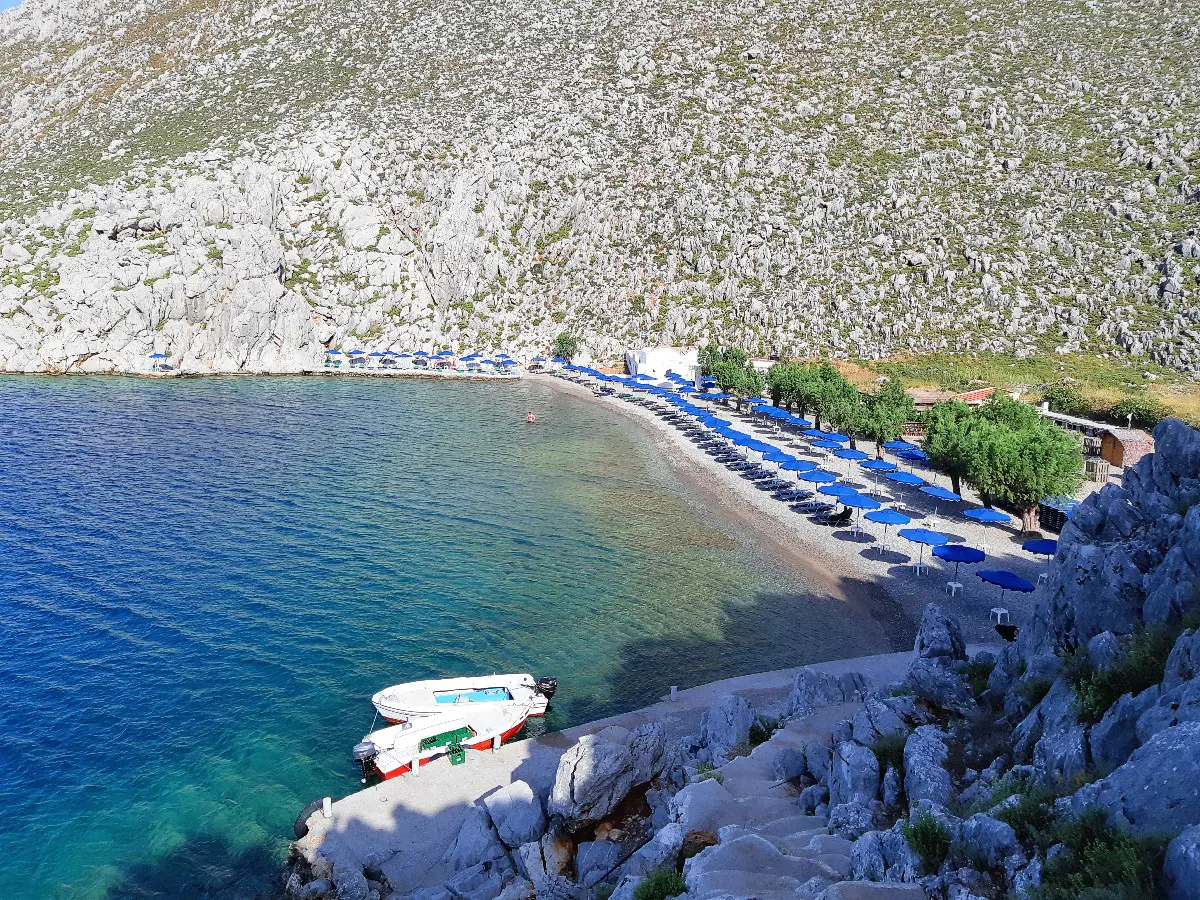
Allow enough time on each island
When you are planning your Greece trip, you will be tempted to try and visit several islands, especially since there are so many beautiful ones to choose from. However, more isn’t always better!
I recommend spending at least 3 nights on each island, and longer for larger islands. So, if you have 9-10 days in Greece, I would suggest that you visit no more than three islands.
It’s also important to factor in travel time between islands when planning your itinerary. Check the ferry schedules and travel times carefully, as they can vary depending on the season and the day of the week. And note that, occasionally, a ferry might get delayed – more on this, later.
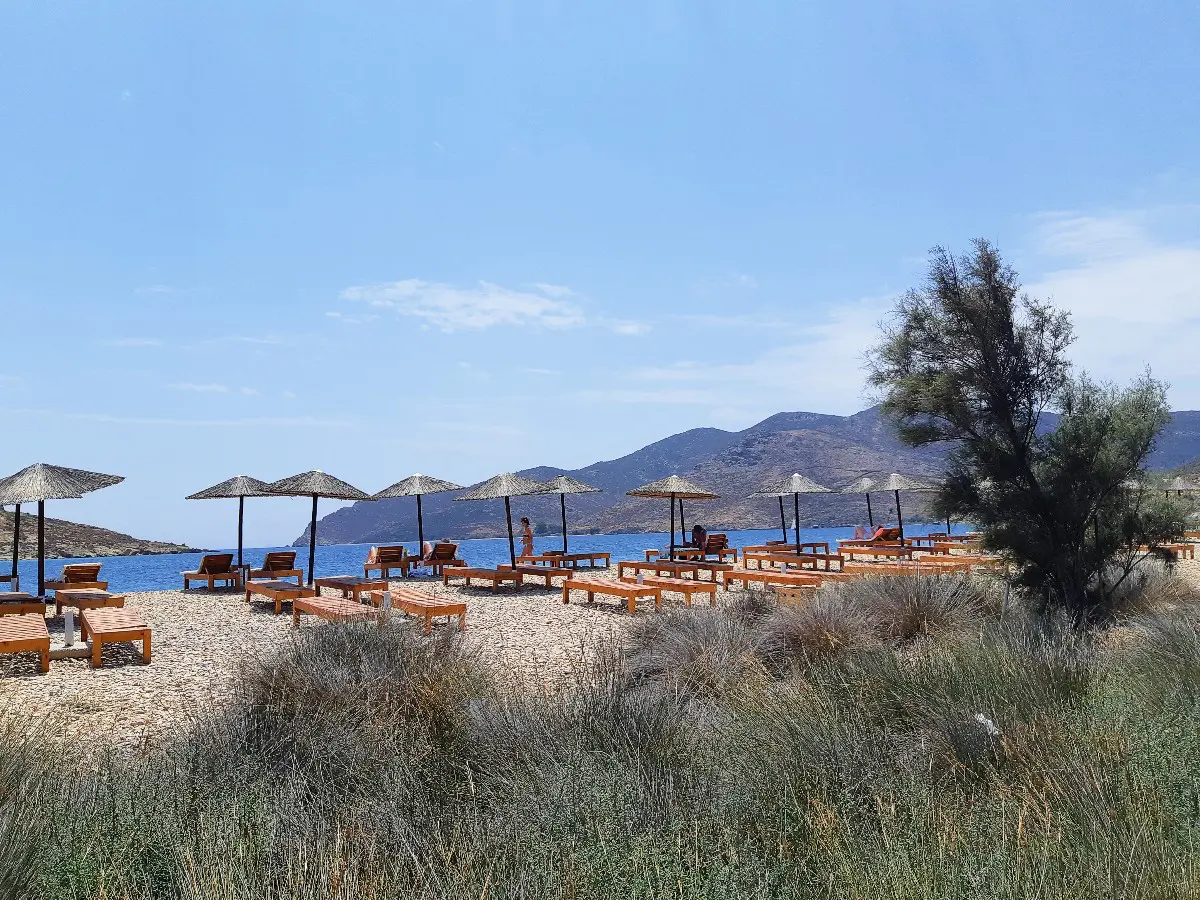
Allow enough time to see the sights, enjoy the gorgeous beaches and scenic landscapes, soak up the atmosphere, and fully immerse yourself in the local culture. This will help make your trip to Greece even more memorable!
4. Check flight options to Greece
Once you’ve got a rough plan in mind, you can check out available flight options to Greece and the islands. Many people fly into the Athens International Airport (ATH), the biggest airport in Greece.
However, several islands also have international airports. If you are flying from Europe, you may be able to find direct flights to major destinations in Greece such as Santorini, Mykonos, Crete, Rhodes, Kos, Kefalonia and Skiathos. These flights are usually available during late spring, summer and autumn.
In addition, several islands such as Naxos, Milos or Syros have domestic airports, and there are daily connections to and from the Athens airport year-round. So you can fly into Athens, and catch an onward flight a few hours later.
Once you’ve booked your flights, you can move on to the next step: book your accommodation!
5. Book your hotels on the Greek islands
Once you have planned your itinerary and decided which islands you want to visit and in what order, you can go ahead and book your accommodation on each one.
Accommodation options on the Greek islands can vary a lot. Some islands, like Mykonos or Santorini, will offer a range of luxury resorts and villas. Most islands also have more budget-friendly options like guesthouses or small family-run hotels.
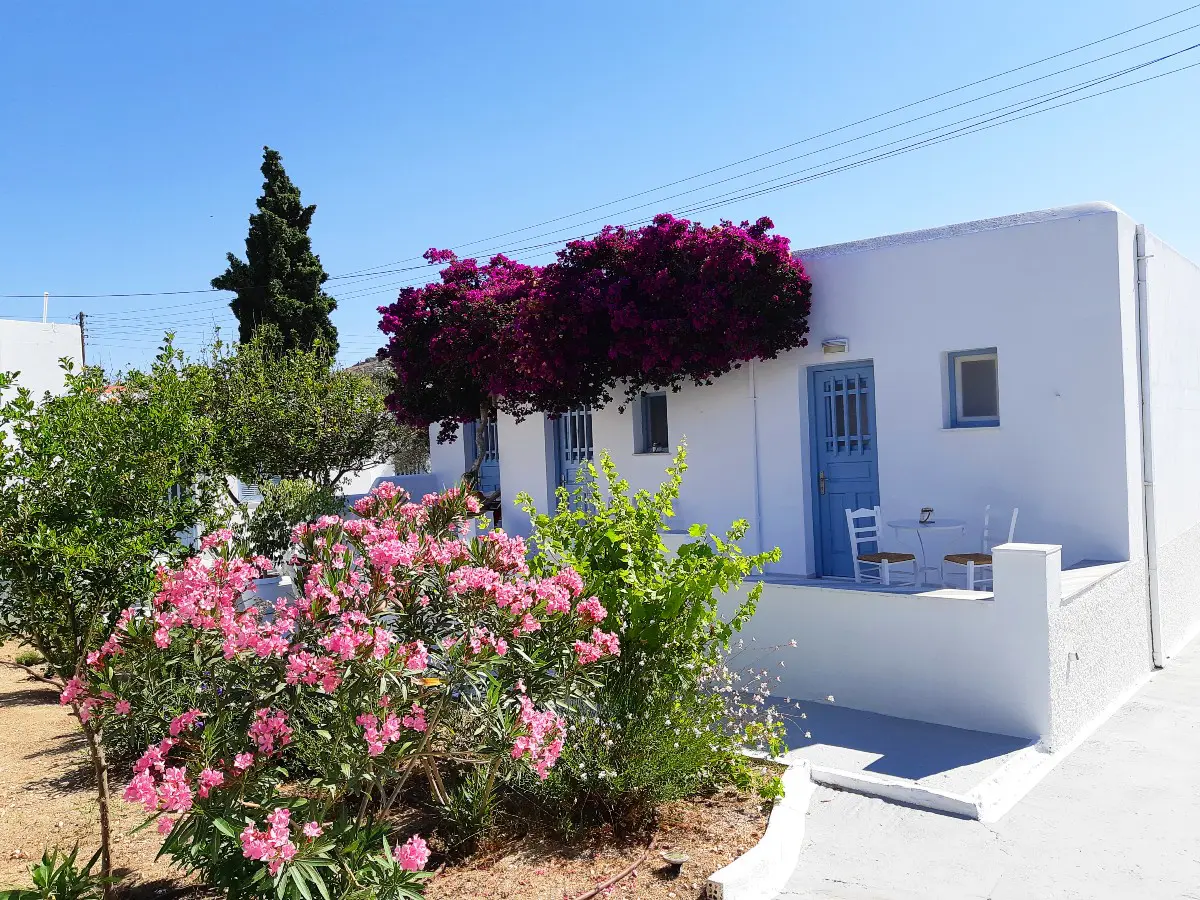
I recommend booking your accommodation in advance, especially if you’re travelling during peak season. While there may be last-minute options available, they might not be suitable for your specific needs.
Also, keep in mind that many of the smaller islands, such as Schinoussa or Donoussa , have limited accommodation options. During the high season, rooms can actually get sold out, as there are many travellers who return every year. Make sure you check availability of accommodation before finalizing your itinerary.
I’ve always found that Booking.com offers more choice and better value in Greece than other similar platforms such as Airbnb or VRBO. So make sure you check all options before you book.
6. How to buy Greek ferry tickets
Once you have booked your accommodation, you can book your ferry tickets as well. As mentioned earlier, Ferryscanner is a useful search engine to check ferry routes and book your tickets.
Some travellers prefer to book their ferry tickets last minute. In my opinion, it’s usually best to book them at least a week or two in advance, especially during the peak tourist season when some ferries can actually sell out.
And while there will often be another ferry on the same day that you can take, it doesn’t hurt to secure the route you actually prefer!
A few tips on ferry travel in Greece
Ferries are the most common mode of transportation between the Greek islands. There is a huge network of ferries, some of which run year-round. Others are seasonal and run in spring, summer and autumn.
Itineraries for most ferries are announced a few months in advance. So, for example, if you are travelling in June, you will find that most ferry routes will be announced by March or April.
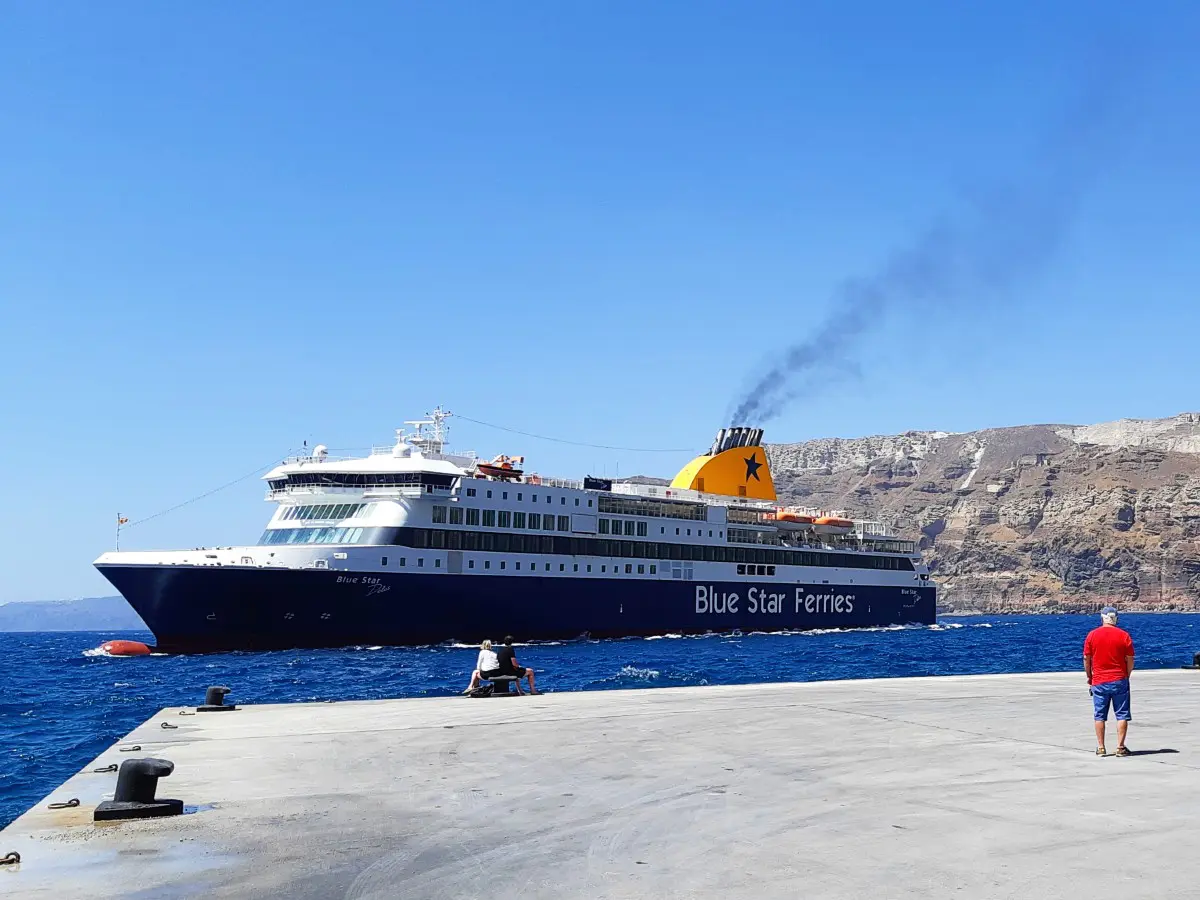
The Greek ferry system is very efficient overall. Still, ferries can sometimes be delayed or, in rare cases, cancelled. Always allow for extra time when planning your ferry trip. If you are flying back home from Athens, I suggest spending your last evening in the Greek capital.
Keep in mind that ferries will typically be crowded during peak season. Get to the port at least a half hour early, especially if you don’t have a numbered seat – more on this below.
And finally, make sure to bring a light jacket on board. Some of those ferries have ridiculously cold air-condition!
Fast ferries vs slow ferries
Generally speaking, there are two types of ferries in Greece: the fast ferries and the slow ferries.
The fast ferries only have assigned indoor seating, and you are not allowed to walk on the outdoor deck. People often refer to all fast ferries as “SeaJets”, as the majority are run by a company called SeaJets.
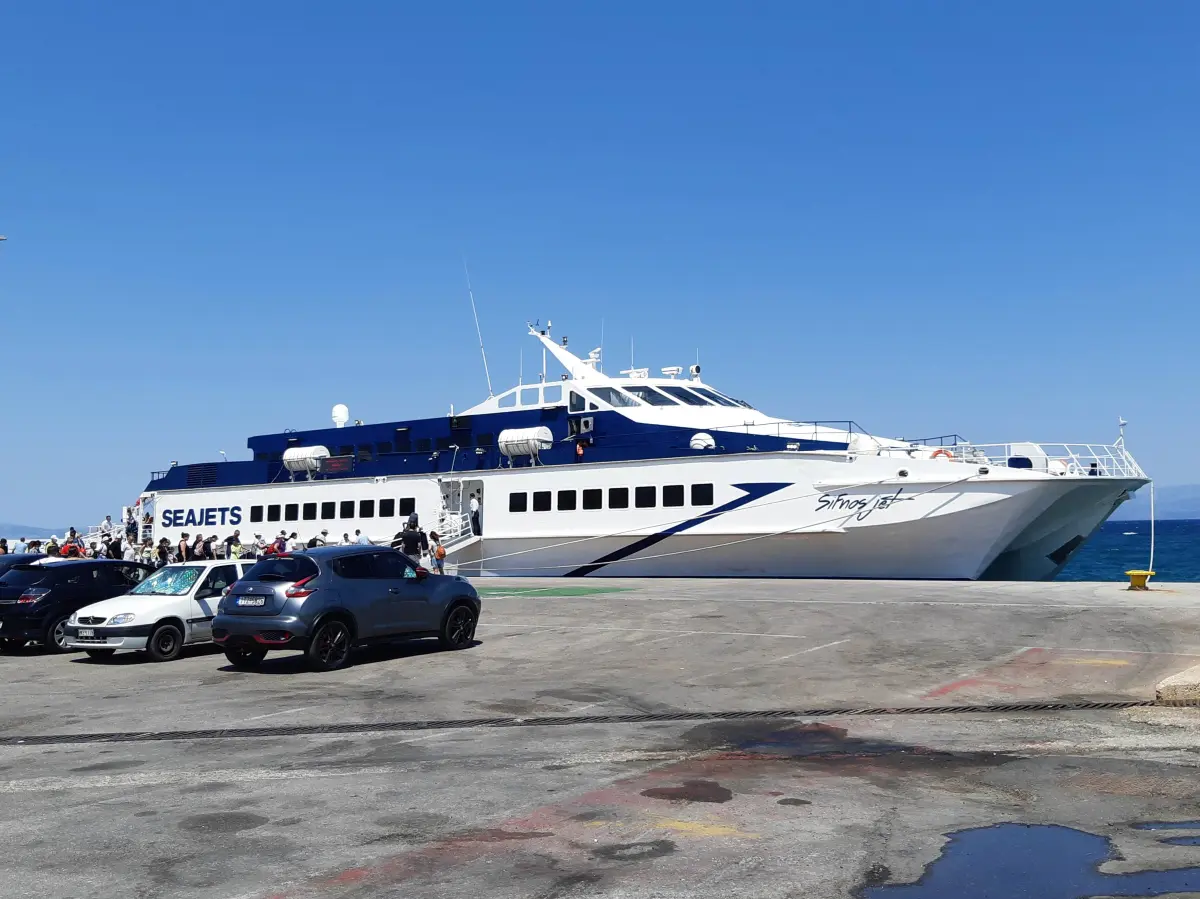
Note that not all SeaJets are equal – in fact, they vary a lot in size. The smaller ones can be claustrophobic for some people, and are a no-no if you easily get seasick, as the meltemi summer winds will affect them. If you have a choice, it’s best to travel on the bigger SeaJets, that also carry vehicles on board.
Most of the slow ferries are bigger, and they have both an outdoor and an indoor area. They are generally more comfortable to travel on, even on windy days, and are also cheaper, especially if you get a deck (non-assigned) seat. Many of the most popular slow ferries travelling around the Aegean Sea are run by a company called Blue Star Ferries.
In any case, it’s a good idea to have some motion sickness medication with you, just in case. And if you are planning to sit on the deck, don’t forget your sunscreen and a hat. You won’t feel you are sunburned until you look at yourself in the mirror – I’ve learnt the hard way!
7. Choose some tours to enhance your Greek Island Experience
If you are interested in taking any organized tours on the islands you are visiting, it’s worth doing some research before you go.
You will typically find many interesting options on most islands. Some examples are sailing tours, guided tours of the ancient sites, road trips, cooking classes, and outdoor activities.
Here is a tiny selection of great tours on some of the most popular Greek islands:
- Sunset cruise in Santorini , a great way to experience the iconic island
- Guided tour of the Palace of Knossos in Crete , which was first built around 1,900 BC!
- Half-day trip from Mykonos to Ancient Delos and Rhenia – combines history, culture and amazing swimming spots
- Cooking class in Naxos island , one of my favourite Cyclades islands for food
- Amazing sailing trip in Milos , a fantastic activity where you will see the amazing coastline of Milos
- Kayaking in Rhodes – I took this myself and had a blast!
For a huge selection of tours in Greece and the rest of the world, you can check out these two platforms: GetYourGuide and Viator .
In addition to that, you can usually find last-minute sailing tours on most islands, often on smaller boats with basic facilities. Ask around at the main port town.
8. Decide how you are going to get around each island
There are several ways to get around the islands. Examples are public buses, taxis, boat trips, and walking / hiking. You will also find or rental cars, ATVs, scooters and bicycles on most islands.
Public transportation is one of the most affordable ways to get around the islands. The buses are known as KTEL buses, so you can Google the name of the island plus the phrase “KTEL bus” to find out bus itineraries. Note that these change often – there are more services in the peak season months than, for example, in April or May.
All in all, renting a vehicle will offer more freedom, and you will be able to visit places at your own pace. DiscoverCars is a great website where you can easily book cars for many of the largest islands. You can also check Google Maps for car rental services on each island – just make sure you read reviews from previous customers.
Like with hotels, if you are travelling in July or August, it’s usually best to book your vehicle in advance. Have a look at this article on driving in Greece .
9. Learn a few Greek words and phrases
Learning the Greek alphabet and a couple of basic Greek phrases can enhance your island hopping experience in Greece. While English is widely spoken in tourist areas, Greeks truly appreciate it when visitors make an effort to speak Greek.
Start with the basics, like “ kalimera ” (good morning), and “ yiassou ” (hello /goodbye). Also, try to master “ parakaló ” (please), and “ efharistó ” (thank you). Unfortunately, the last one is a bit of a challenge for most people!

I’ve written three guides with a few words and phrases in Greek – have a look:
- The Greek alphabet
- Useful Greek words and phrases
- Greek curse words – use them wisely, if at all 🙂
10. How to pack for your island hopping trip
And now, let’s fast forward to a few days before your Greek island hopping trip… packing time!
When packing for your trip to Greece, keep in mind that the islands can get very hot in the summer months. Be sure to pack light, breathable clothing. However, make sure you also throw in a light jacket for those windy evenings, or the air-conditioned ferries.
Now, I can not stress it enough: Exploring the Greek islands usually involves lots of walking, and it will often seem that there are stairs wherever you go. Bring your most comfortable walking shoes , and consider packing light, as you may need to carry your suitcase up and down several flights of stairs.
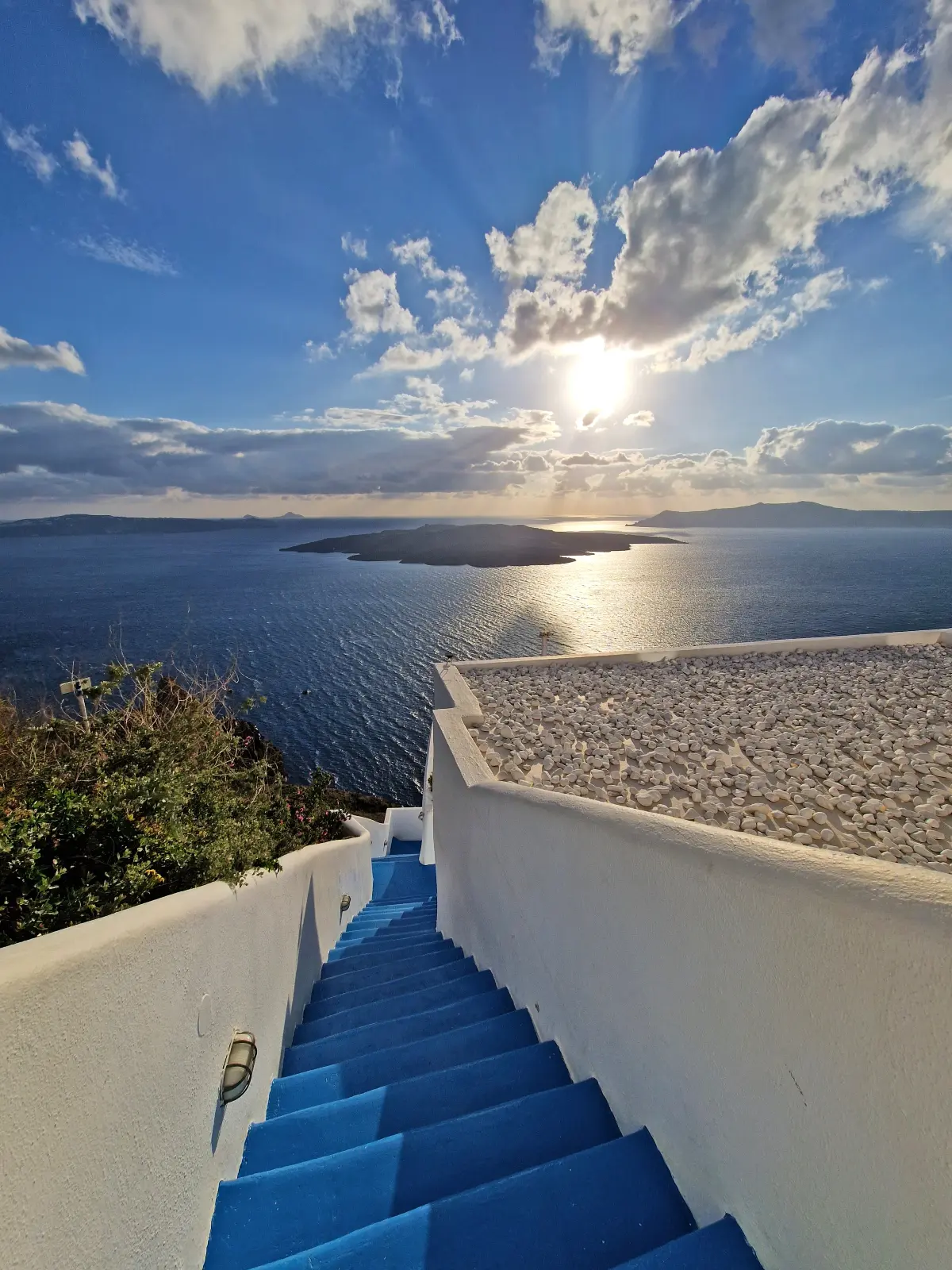
You will also need a hat, sunglasses, your swimsuit, sunscreen and insect repellent. Mosquitoes in Greece are not dangerous, but they can be a nuisance… I’m talking from experience! Here’s how to avoid mosquitoes in Greece .
That said, if you forget any of those items, no worries – they are easily available all around Greece. Pharmacies, cosmetics stores and supermarkets all stock sunscreen and insect repellent, but you can also find them at many tourist shops.
Here is some more information on what to pack for Greece for every season and why I think Tevas are the best shoes for Greece .
11. Bring some cash to use on the Greek islands
These days, most businesses in Greece take credit and debit cards. However, you will still find that, sometimes, you can pay in cash only. As an example, local buses in Santorini require cash payment!
Similarly, some smaller family-run restaurants and shops in remote areas will typically prefer cash payment. In rare occasions, you might not even have the option to pay with your card.
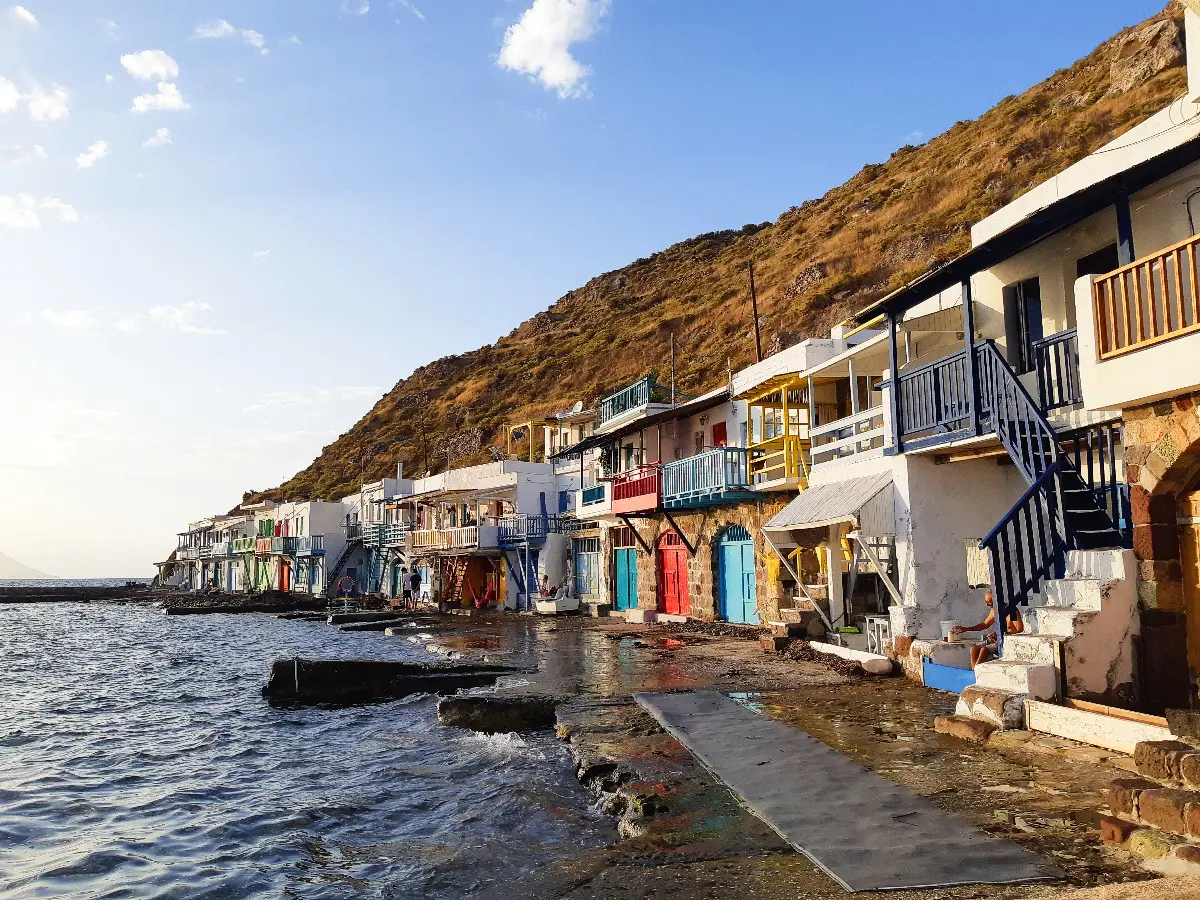
Therefore, it’s always a good idea to carry some cash on you when you are out and about. And if you need to withdraw money, there will usually be an ATM or two in the island’s main towns.
In terms of cards, while Visa and Mastercard are both fine, note than American Express is not widely accepted in Greece.
Actually, I warmly recommend Revolut whenever you are travelling – I’ve been using it for years and it’s saved me a lot of hassle and commission fees in many countries. If you want to have a look, you can check out my referral link !
12. Embrace Greek island life!
And the big day has arrived – you are finally on one of the Greek islands! Now what?
Well! As a Greek, I can tell you that our islands are known for their relaxed and slow pace of life. Do take some time to relax on the great beaches, and take in the stunning wild beauty of the islands.
Wherever you go, you are going to want to do some sightseeing, explore the towns and traditional villages, and learn about the ancient history. But don’t forget to slow down! Take your time to embrace the Greek cuisine, and enjoy a leisurely meal with a couple of drinks at one of the Greek tavernas .
Here is my guide with 50 of the best Greek dishes !
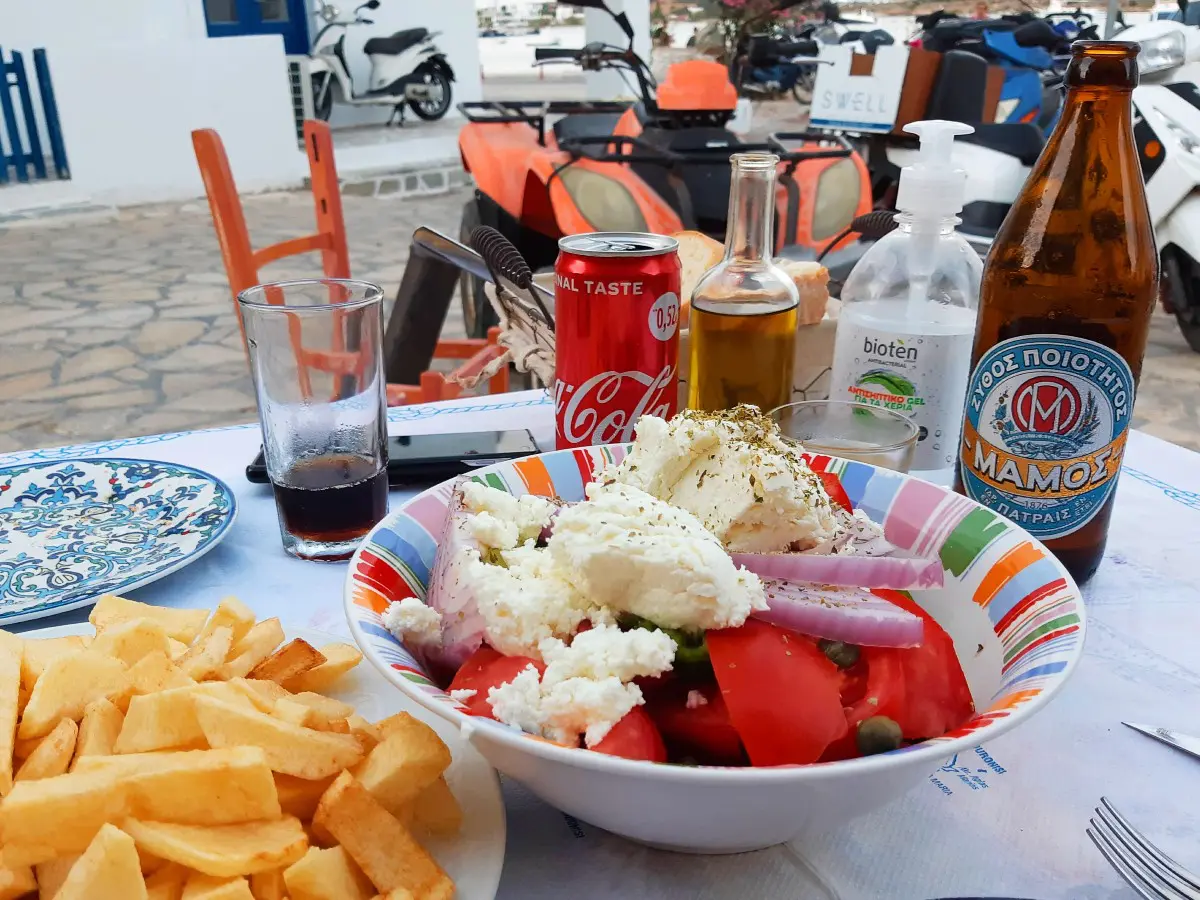
Last, but definitely not least, make sure you talk to the locals and ask about island life. I’ve always found that the conversations I’ve had with the islanders have offered me more insight about the local culture than I could ever find in any travel book or guide!
FAQs about Greek island hopping
Here are some questions that readers have asked me in the past:
Which is the best Greek island for island hopping?
You can start your Greek island hopping trip in Athens, or on any island with an international airport. Some examples are the two most famous islands in Greece, Santorini and Mykonos, which many first-time visitors include in their Greece tour. Other islands with international airports include Crete, Rhodes, Kos, Corfu, Kefalonia and Zakynthos. You can easily take a ferry from any of those to other nearby islands.
Is Greek island hopping worth it?
It is definitely worth visiting the Greek islands at least once in your life. To plan your Greek island itinerary on your own, you will need to choose the islands you want to visit, and research ferry connections between them.
When should I go Greek island hopping?
The best time of the year to travel around the Greek islands is between May and September, when the weather is warm. You will then make the most of the fantastic beaches and enjoy the local atmosphere.
How easy is Greek island hopping?
It’s actually pretty easy to plan your Greek island hopping itinerary on your own. Alternatively, you can always find some Greek island hopping packages or even sailing cruises.
What is the best way to island hop in Greece?
The best, and often the only, way to island hop in Greece is by ferry. There are several Greek island hopping routes which usually include some of the most popular islands. If you like sailing, you can also take a sailing trip around the islands.
Do you need a car for Greek island hopping?
While a car is not strictly necessary if you want to visit Greece and the Greek islands, it will offer you more freedom if you want to explore each island at your own pace. Public transportation is quite good on some of the most popular islands, but if you want to visit remote beaches or get away from areas with mass tourism, a vehicle is always a good idea.
Is Greek island hopping expensive?
Greek island hopping doesn’t need to be expensive. To keep ferry costs down, it’s better to visit fewer islands that are on the same island hopping route. Here’s some information on island hopping in Greece on a budget , and my article on why Greece is not expensive .

Leave a Comment Cancel reply
Save my name, email, and website in this browser for the next time I comment.

Greece Travel Tips: The Ultimate Guide For First-Timers
Greek Island Bucket List is an Amazon Associate and participant in other affiliate programmes. I earn from qualifying purchases. Please see my disclaimer for more information.
If you’re travelling to Greece for the first time you probably have all sorts of questions. Whether it’s how to travel within Greece or more to do with day-to-day etiquette and practicalities. I’ll answer some of the most common questions here and give you some essential Greece travel tips.
Note that this Greece travel guide for first-timers is HEFTY so pin it to refer back to.

When is the Best Time to Visit Greece?
If you’re going to the islands, the season runs from around April until November however it does vary a bit from place to place.
Best Time for Everything to Be in Full Swing
Mykonos, for example, has a shorter season and things are really packing up by mid-September. The season in Santorini runs for longer and activities are still being offered well into November.
In most other places I’d expect to see a distinct difference in what’s open after the 15th October.
The best time for everything to be open and the sea to be pleasant is from June to late September. Before and after that the weather can be changeable and fewer places are open so plan accordingly.
Although the sea in April and May can be cold, it holds its temperature through October and November.
Read about Paros and Santorini in October

Best Time for Hiking
If you’re interested in hiking the islands, the best months are April , May, the beginning of June and then September, October and the beginning of November.
Late spring and early summer are lovely times to go because you can generally expect good weather, blossoming bougainvillaea, warm seas and services that are up and running.
At the same time, you’ll avoid the blistering heat of July and August and the biggest onslaught on visitors.

What to expect in High Season
July and August are the peak months when you can expect summer crowds. In the first three weeks of August, Greek people flee the summer heat of Athens and head for the islands too.
The main tourist areas can be overwhelmingly busy so consider some of the smaller islands. July and August will be much busier than normal for them too. But it’s also when you’ll find sea taxis running to take you to some of the most beautiful places
Many Greek beaches are only accessible by boat, so you’ll have a hard time getting to them outside of July and August.
How Do I Decide Where to Go?
Since there are a number of different island groups it can be hard to decide which is the best option, especially for your first trip.
What Are You Looking for?
My advice is to start with what are the most important things to you. For example, are you looking for amazing beaches?
Perhaps you want somewhere with good hiking trails, masses of history, a great nightlife, particularly delicious food or that’s perfect for families.
Maybe you’re looking for the perfect place to hide away and relax, far from other tourists. Once you know what you’re looking for from your trip you can start to narrow down the best places for those things.
Then you can look at how to travel between those places or find alternatives that are closer to each other.
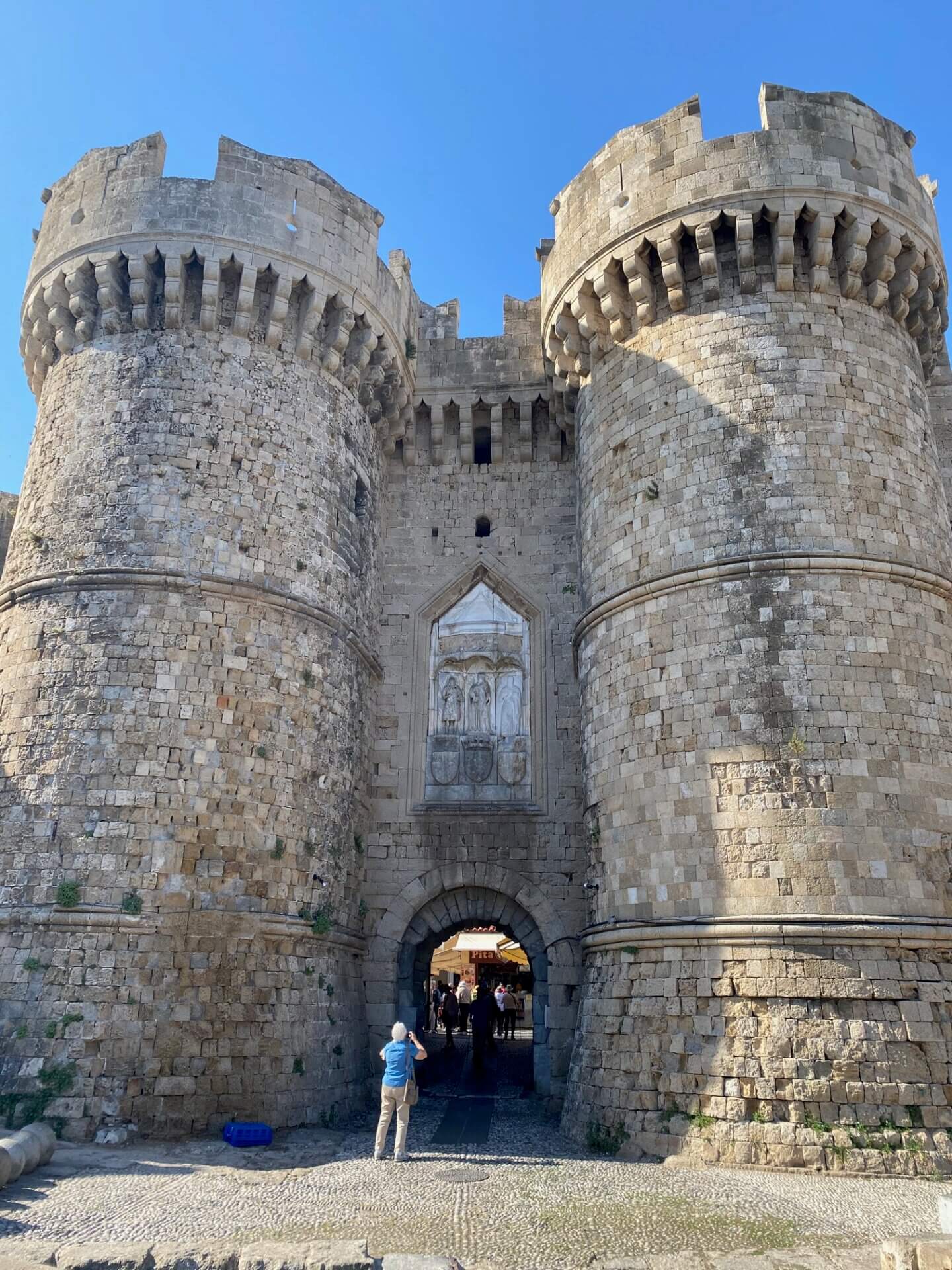
How Long Do You Have?
Another big consideration is how much time you’ve got. If you’re really limited and are spending time in Athens then hopping about the Saronic Islands might make the most sense.
Alternatively, if you’re besotted with social media pictures and videos from the Ionian Islands then just go ahead and book there and cross it off your bucket list!
What Temperatures Do You Want?
Be aware that like other European countries, Greece in the summer season gets HOT. The Peloponnese is renowned for its scorching temperatures. One of the reasons some of the islands are so popular is because of the winds that help keep the temperatures down.
Less is More
My biggest piece of advice though is not to try and cram too much in. Less is more when it comes to deciding on how much of the mainland to explore or how many islands to visit.
Ferry travel can take up a lot of time. And although it’s a quintessential part of Greek travel, you don’t want to be spending more time on a ship than at your destinations.
Although you might be keen to see as much as possible, make time to just absorb the Greek culture, sample local food and watch the world go by. You can always add places to your list to visit next time.

Should I Avoid the Main Tourist Destinations?
People will tell you that Santorini and Mykonos are overrated, touristy and not the real Greece. I can’t deny they are touristy and that there are many other islands to discover (not to mention mainland Greece).
Greece is a beautiful country and there are many popular destinations to choose from as well as off-the-beaten-track options.
But I can’t say that Santorini is overrated. It’s about the most popular tourist destination in Greece for a reason. The view of the caldera is truly spectacular and it’s something I think is worth seeing once.
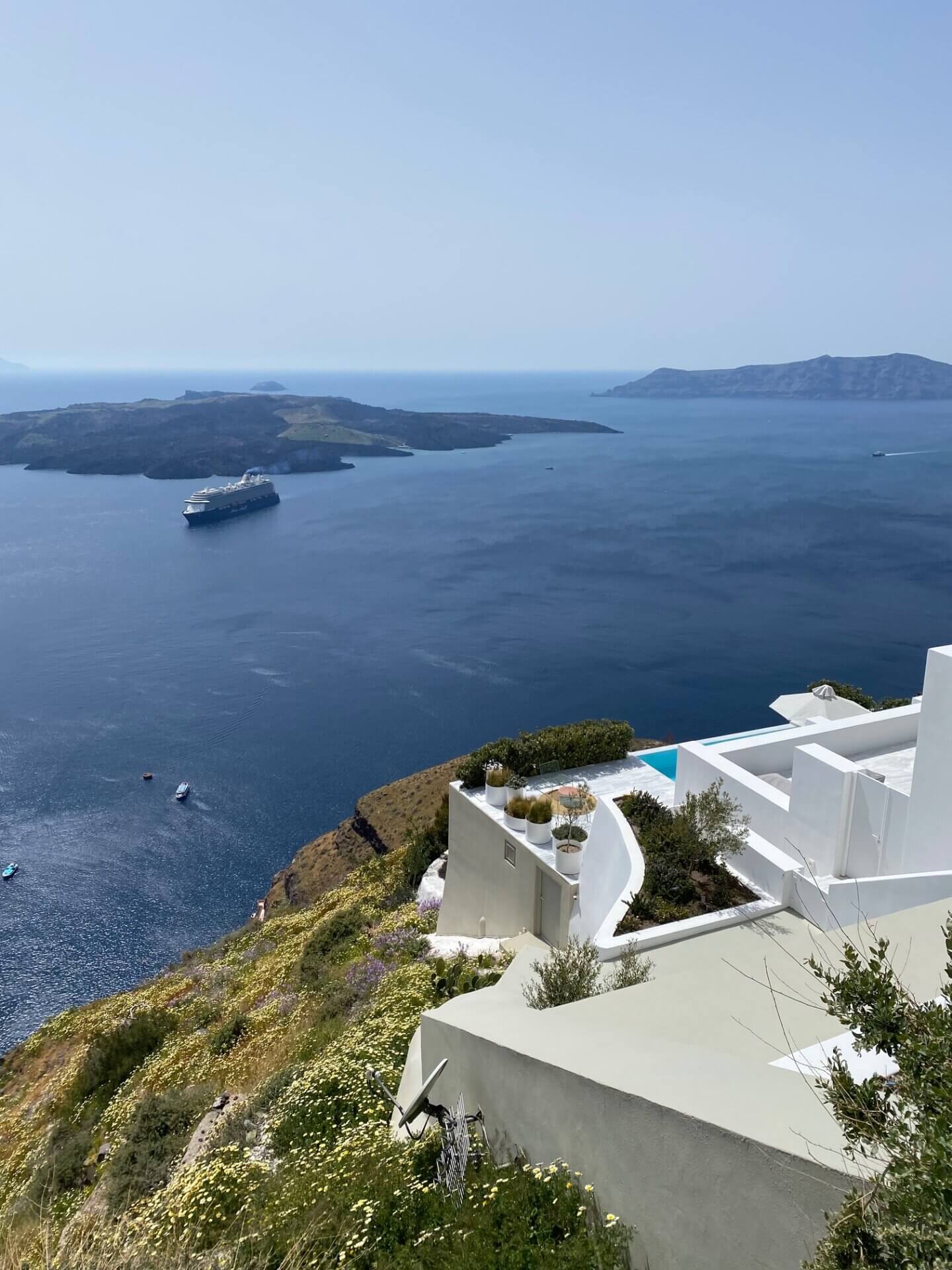
Similarly, Mykonos is a rather unique and diverse place. I used to think it was a really tacky destination for package holidays from the UK.
But having been, there’s something about seeing all the wealth and the way other people live that always makes me want to up my game.
I think it’s fun, glamorous and inclusive and it does have beautiful beaches. The Unesco World Heritage Site of Delos next door is really special too.
I think it’s nice to go to Mykonos for a short time but include some other islands in the mix. Tinos right next door is a great place to combine with.
Should I Fly to the Greek Islands or Take the Ferry?
The most common way of getting to the islands is via ferry. I recommend it although I know it’s not the easiest way for everyone. If you have children then flying might be easier than the sensory overload and organised chaos that comes with getting the ferry in high season.

For more information about flying see the Best Greek Airlines For Island Hopping .
Things to keep in mind about flying:
- some of the large islands do have national or international airports but lots of islands don’t
- if you’re going to smaller islands like the Small Cyclades you could fly to Naxos and then get the boat from there
- Athens is a hub and most island flights radiate out on “spokes” so you’ll have to fly in and out of Athens to get from island to island
- there can be a few exceptions in peak times like flights directly between Santorini and Corfu
- leave enough time between arriving on an international flight and your departure time for the islands (about 3 hours)
If you decide to fly then I recommend Skyscanner to book your plane ticket. They show you all the flights to a particular location on the date you specify, or across the whole month.
If you’re booking connecting flights then they also offer you options to buy tickets through travel agents.
That can be helpful if you’re booking connecting flights as you’ll have more support if you’re delayed on the first leg and miss your connection. Note that Delta has partnered with SKY Express to offer tickets all the way through to your final destination.
What is the best website for Greek island hopping?
If you’re heading to the Greek islands then get on FerryHopper.com , I love it. It’s the easiest site I’ve found to search for dates and several “hops” at once.
Plus they send you an email with all your booking details filled out so it’s super easy to check in online with just a single click.
Once you check in they’ll send you e-tickets so you don’t have to go and collect paper copies. (There are a few exceptions to this but you can see when booking if e-tickets aren’t available.)
When Should I Book my Ferry Tickets?
If the ferry schedules are out, then the best time to book your tickets is probably as soon as you’ve booked your hotel. If the schedules for the month of your visit aren’t yet published then just keep checking back.
See: Greek Ferries Guide for People Who Don’t Know Where to Start
People will tell you it’s fine to get your tickets on the day of travel. And while I am a last-minute person I wouldn’t advise leaving this too late.
One, if you do need to collect paper tickets it’s better not to be rushing about trying to get them. And two, tickets do sell out. It doesn’t happen all the time, but in the summer season, I have seen sold-out trips.
Plus there are finite numbers of economy seats, cabins and pet cabins, so if you want any of those you need to book when they’re available.
What do I need to hire a car in Greece?
I’ve answered all your Greece car hire questions here and tell you everything you need to know about driving in Greece here. Depending on where you’re coming from you probably won’t need an International Drivers Permit now but do check.
For many islands, it can be good to hire a car to really explore. But it depends on how long you’re staying and how comfortable you are about driving in Greece whether it’s worth it.
People can find driving on the islands a unique experience and sometimes one that’s more stressful than it’s worth.
Think twice (or three times) before hiring an ATV /quad bike. They’re really not safe and there are tons of accidents each year (many fatal).
See Do I Need a Car in Naxos?

Using buses on the islands
Bus facilities on the islands vary greatly. Places like Paros and Syros have good frequent buses around their islands. Mykonos has good transport to the various popular beaches there.
Where I stayed in Tinos there were only buses on Mondays. But the more popular parts for tourists had pretty regular routes. I’ve included bus information as part of many of the island guides.
During July and August, there are usually a lot more buses serving popular routes. Outwith these months buses can be cut right down or entire routes stopped altogether. If there are a few of you travelling together it can often work out cheaper to get a taxi.
Often there’s a small bus stop/shelter on one side of the road where you can wait for the bus. If you need to travel in the other direction just wait opposite it if there’s no obvious sign of a stop on the other side.
Luggage on Buses
In Greece, you put your luggage or any big or bulky items in the storage areas under the bus. If there are handles on the doors just open them up and put your suitcase in yourself. If there are no handles then the driver will open them up from the dashboard.
Keep valuables with you but I’ve always felt comfortable leaving the rest of my stuff under the bus. It was the same in Spain when I lived there.
Don’t try and take your stuff onto the bus with you. You can’t take up a seat for your bags and there’s not much space to put them anywhere else.
Paying your fare
On some buses, you pay the driver directly. On others, you take a seat and a conductor comes round and takes your money. I’ve seen both options on the same route too, sometimes. It’s usually ok to pay with notes if you don’t have change.
All About the Money
How can i exchange dollars or access euros in greece, euro only in greece.
Just to clarify, Greece uses the Euro. I’ve seen a surprising number of people ask if it’s possible to pay in US dollars when you get here. The answer is no.
However, if you’ve been travelling in Turkey, I can understand why you might think you can use alternative currency.
Exchanging money at the airports
You can exchange money at Athens airport. If you fly directly to an island then this is also possible in some places like Rhodes, Crete and Mykonos.
However, it’s always likely to be more expensive than if you were to exchange money with your bank at home before travelling.
Withdrawing foreign currency from the cashpoint/ATM
As I fly by the seat of my pants a bit, I tend to withdraw money from the cashpoint when I arrive. You get charged a fee each time but I don’t think it’s more than what you would pay to an exchange place.
Because of the fee, make sure that during your stay you pull money out in chunks rather than frequent, small withdrawals. The ATM will usually ask if you want the conversion to be in Euros or your home currency converted.
My bank won’t let me do this, but if you can choose the Euros option for calculating the amount.
(Side note: same when you’re paying by card. Sometimes the card terminal will ask if you want to be charged in Euros or your home currency like Dollars or Sterling. Choose the Euro option as it’s pretty much guaranteed to be cheaper for you.)
Have Cash When You Arrive
It’s probably sensible to have at least a bit of cash on you when you arrive in Greece. Many taxis won’t take cards. So at least if you have some physical money on you, you can get to your hotel. (Assuming you haven’t already organised some kind of transfer.)
The airports have ATMs but from time to time these things don’t work and the smaller airports won’t have a lot of options.
Having said that, I’ve asked taxi drivers to stop at ATMs on the way to where we’re going plenty of times (because I’m highly disorganised at times). Although, perhaps it’s not ideal for a female traveller, especially if you’re travelling at night in an unfamiliar area.
Avoid Euronet ATMs
Look for a normal bank ATM rather than these yellow and blue convenience ATMs. They’re installed in smaller, touristy areas, often next to tourist supermarkets. Usually, they’re seasonal too and only operate from April to October.
The exchange rates aren’t good and they charge a much bigger one-off fee to use them. They’re ok if you’re stuck – hence paying more for convenience – but I’d advise against using them regularly.
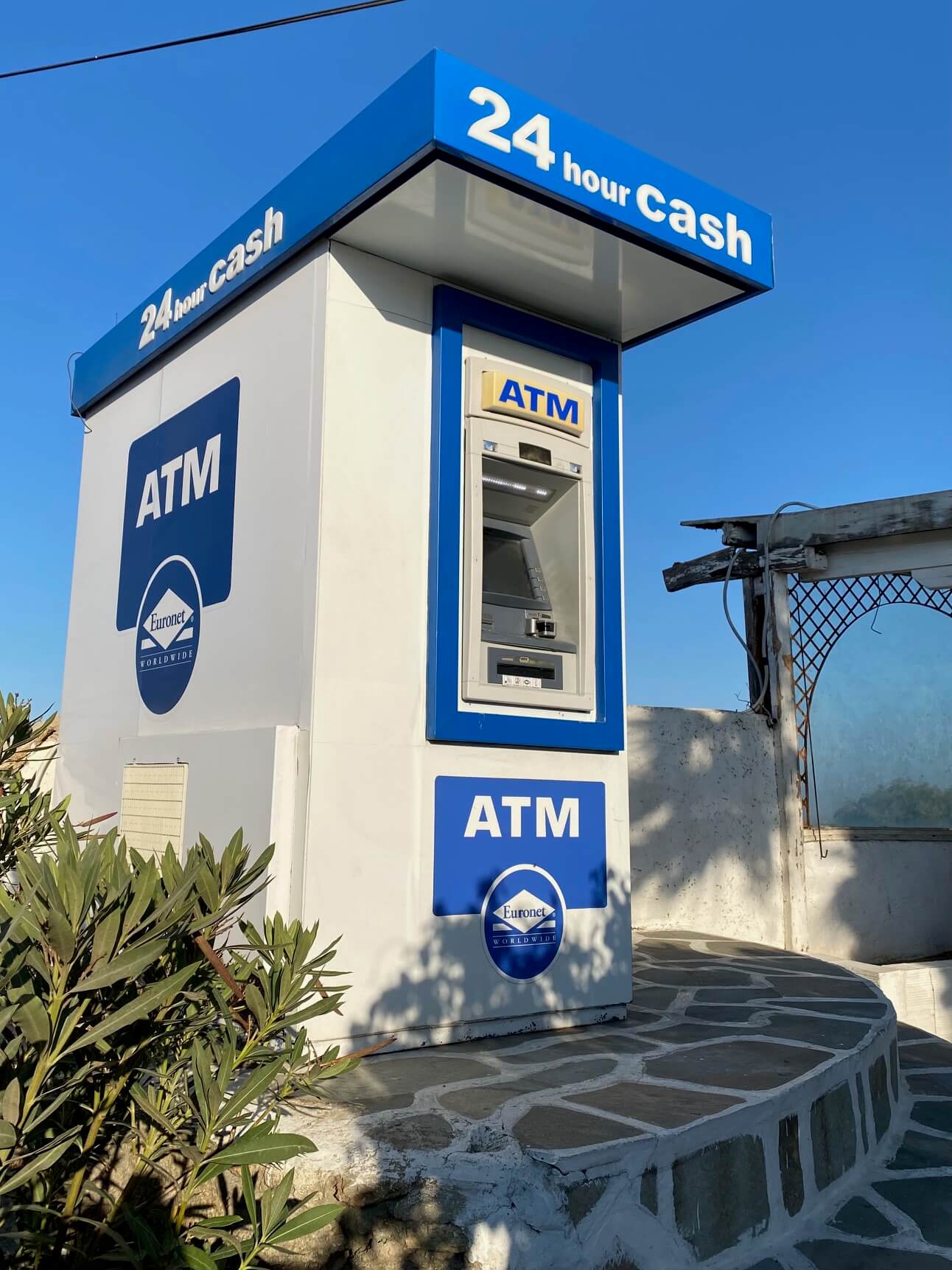
Paying by card in Greece
I use my contactless bank card for most things in Greece. However, I heard that a lot of US credit cards don’t have this facility. You can still use chip and pin or you may be asked to sign the receipt.
A lot of taxi drivers won’t accept cards and some smaller shops and restaurants may not either. Of those that do, American Express and Diners Club are probably less widely accepted than others.
As I mentioned above, if you get the option on the PDQ machine, it’s usually the most cost-effective to pay in local currency. I.e. choose the option to pay in euros rather than in dollars or pounds or whatever you’re home currency is.
How Does Tipping Work?
Tipping is different to what you’re used to if you’re from the USA. It’s normally just to round up your bill after a meal and just leave the change. Otherwise leaving 1 or 2 euros in the dish when you leave the table is normal.
For tour guides and private drivers, you can leave more but all of it is up to you and the type of service you received. People won’t be expecting the type of tips you might leave in the US but they will appreciate anything you do give them.
What to Pack and Wear
My first piece of advice here is to pack light. If you’re going in the winter months that’s a bit easier said than done. And if you’re hiring a car and exploring only on the mainland then it’s less of a worry how much you take. You can chuck everything in the car and off you go.
But if you’re going to the islands in the summer months then I’d really aim to only take hand luggage. It’s the best way to do things since you’ll encounter lots of steps, uneven pavements, dirt roads and the like.
Having said that, if you’re arranging transfers everywhere to your hotels and someone else is taking care of your luggage, it’s less of a concern.
Just tip well if someone’s traipsing up and down the caldera steps in Santorini with loads of heavy luggage. And don’t make the donkeys do that work either.
Pack things that:
- will help keep you cool
- are suitable options on particularly windy days
- can be washed and dried easily
- that work well together so you can make a number of outfits from the same pieces
See What To Wear In Santorini Greece For A Happy Trip, and if you’re travelling in the summer the Ultimate Summer Greece Packing List: What to Pack for the Greek Islands
You’ll also want:
- some cooling shorts to stop your thighs chaffing
- comfortable flat shoes/sandals – you’ll walk miles round ancient ruins and archaeological sites not to mention village steps
- skirt/sarong that covers the knees or that you can use for your shoulders to enter monasteries and churches
- light jumper or jacket for the evening in the shoulder season
On The Beach
Are you imagining yourself on a beautiful golden sand beach by the Ionian Sea, or maybe the Aegean Sea? If so, here are a couple of things you might want to know about Greek beaches.
See also: 11 Top Black Sand Beaches In Santorini for a relaxing day read up on the 10 Best Beach Clubs In Santorini For A Luxurious Day and for golden beaches near Santorini Anafi Island: Beautiful Beaches A Hop From Santorini
Organised and unorganised beaches
These are the categories that Greeks split their beaches into. Unorganised means it’s a normal beach with no beds/umbrellas etc. There may or not be facilities nearby to get drinks or snacks.
An organised beach is one where you’ll find sunbeds and umbrellas and often a beach bar of some kind. Sometimes that’s a little hut and sometimes it’s a full-on restaurant or beach club .
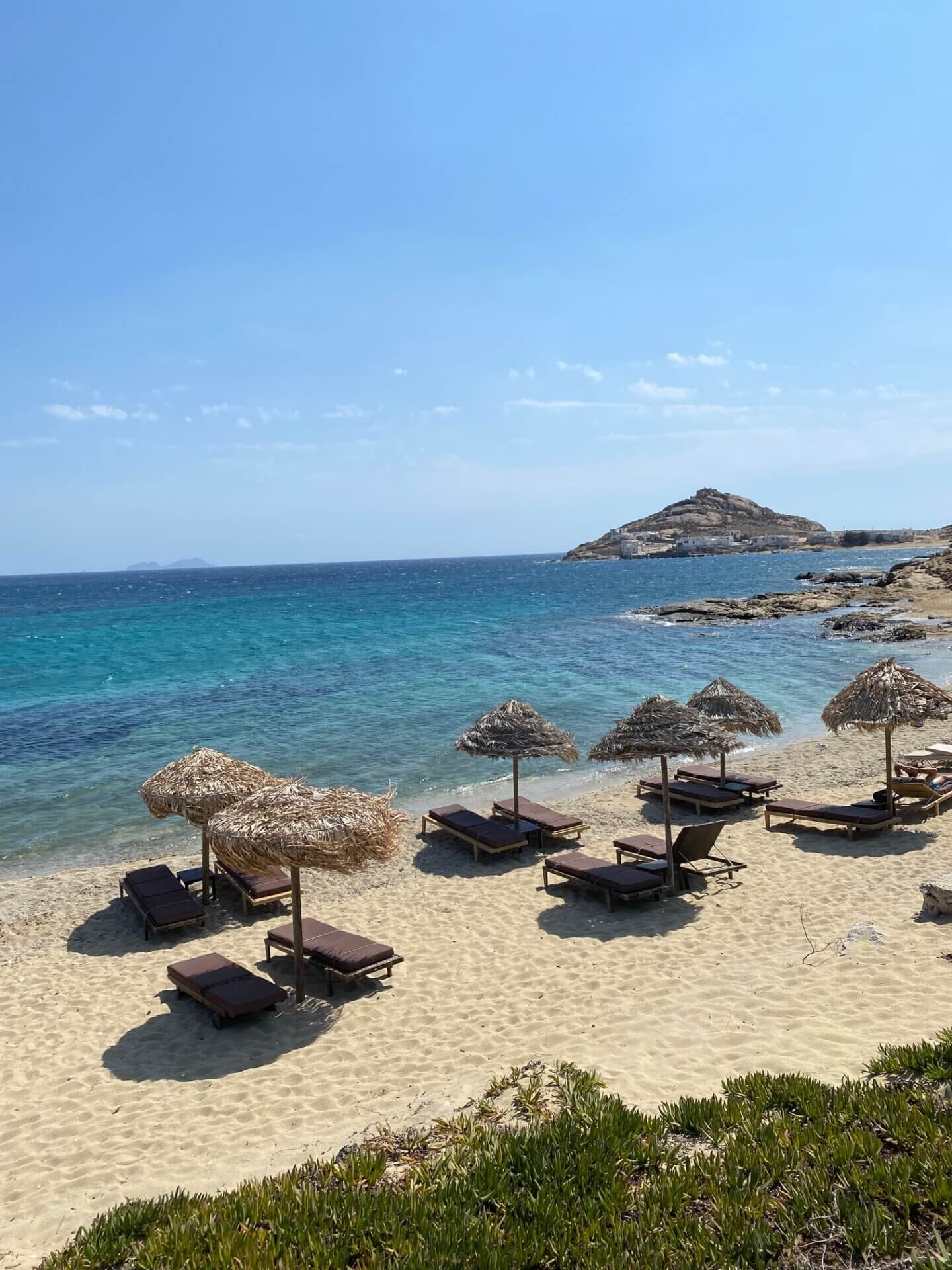
They’re normally a cost involved in taking a bed. It’s either a set charge for a bed and umbrella and prices can be set differently for each row, i.e. you’ll pay more for a front-row spot next to the sea.
Or, you can use the sunbeds if you buy food or drink from the bar. Prices can vary wildly depending on the island.
Usually, there’s some space on the organised beaches where you can lay down a towel so you can go without having to pay for a bed.
Nudist Beaches
Technically these don’t exist in Greece although you might find some on Google Maps. People go topless or fully nude on some of the tucked-away beaches or at the far end of some more popular ones.
Solo Travellers at the Beach
As a solo traveller , I always leave my belongings unguarded on the beach. There are waterproof pouches you can get to take things with you while you’re swimming, but I worry more that I’ll lose everything in the sea.
Make up your own mind about what you’re comfortable doing but know that it’s common for people to do this without a thought. You can always leave your valuables in your hotel room safe.
Dogs on the Beach
Unless it’s a Blue Flag Beach, dogs are allowed on Greek beaches so be aware of that.
Getting Around
There is an Uber app in Athens but it will just call you a normal yellow taxi. I haven’t used it but have used the Free Now app many times which is the same sort of thing.
See also the 15 Best Apps For Greece Travel In Athens & The Islands If you’re heading to Santorini this is a must-read Santorini: How To Get Around By Car, Quad, Bus & Taxi As is this if Mykonos is on the agenda Get Around Mykonos Easily: Travel the Famous Island |
Public transportation in Athens is good with an easy-to-use Metro system , train travel, a tram network and many buses. On the islands, the quality of public transport really varies, particularly on the small islands. Check my island guides for getting around before you go.
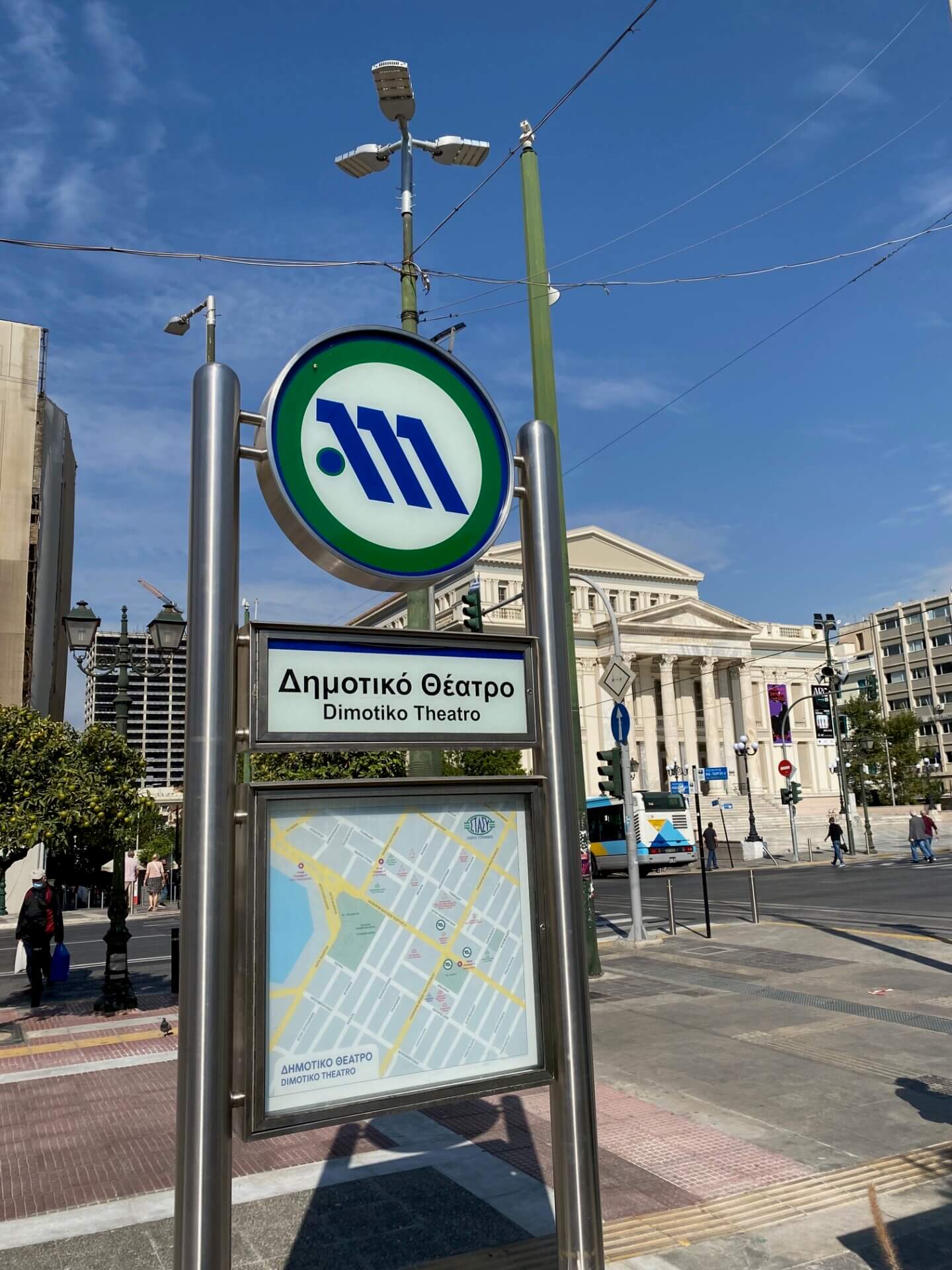
Do I Need to Be Concerned About Petty Crime?
Like all big cities, Athens does see some petty and opportunistic crime, particularly in touristy areas. When you’re in the city centre wherever you’re visiting be sensible with your belongings.
I’ve heard of a lot of tourists from the United States who like to use a money belt under their clothes. I haven’t done that, but I do tend to keep my valuables zipped away in an internal pocket in my bag.
Keep your bag close if you’re enjoying a meal at a Greek restaurant in tourist area or when you’re around tourist sites. Don’t make it easy for someone to grab your stuff.
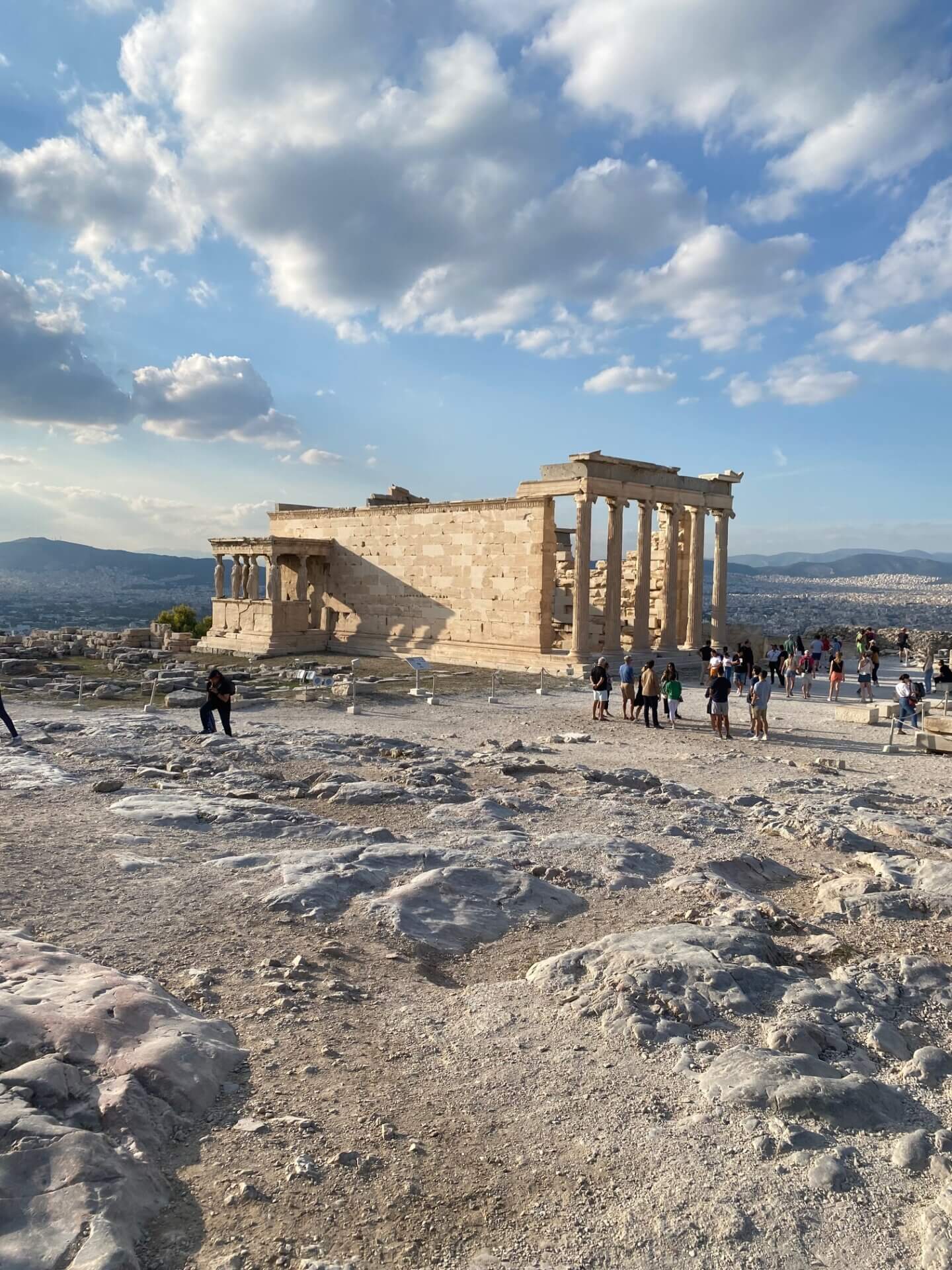
Also, keep your wits about you on the Metro and around the city in general. Some groups have scams where they’ll divert attention and then pickpocket.
In rural areas like on the islands, things are very laid back. It can be one of the best things about them! You might be asked to leave the keys under the mat in your rental car when you go.
Or if you arrive at your hotel late at night, they’ll just leave the key in the door for you.
Accommodation FAQs
Why am i being asked for my passport number.
It’s quite common in Greece to give your passport number for things so don’t be alarmed. It’s not about recording you, it’s about the recipient allocating payment for tax purposes.
Hotels will normally take a copy of your passport when you check-in. That’s normal in many countries.
Every Airbnb needs to take your name and passport number to be recorded for tax. I’ve also had to give my passport or Greek ID when I’ve booked a car through an app (using iMove in Mykonos, for example) or other private transfer.
What is the city tax I’m being charged?
City tax is a compulsory charge that you often have to pay in cash at your accommodation even if you’ve paid for your room online. Sometimes, it’s included if you’ve paid upfront on booking.com or similar.
The listing will tell you when you book whether the city tax is included or not.
If you need to pay it when you leave, it’s usually around 50 cents per night, although I think Santorini’s is a bit higher. You need to pay your city tax in cash.

Why am I being asked to pay by wire transfer?
In the UK and Europe, it’s not at all unusual to pay friends or sometimes businesses by bank transfer. That might be different to what you’re used to if you’re from the US. But don’t immediately think you’re being scammed.
Even established hotels might ask for you to pay this way. I’ve noticed that a lot of businesses in Greece use a Facebook page as their website. So many simply don’t have the facilities set up to take payments online.
If you feel uneasy about any transaction, then go with your gut. But just be aware it’s not necessarily an unusual request. I saw a thread in a travel group on Facebook where someone asked about this and all the advice was that it must be dodgy and to stay well clear.
People were saying this particularly because the accompanying email was written in less-than-perfect English. Understand that the culture is different in different countries.
Also, be aware that if someone is responding to you in a second or third language, their English is unlikely to be perfect. It doesn’t mean there’s an issue.
Day-to-Day Practicalities
When are greek public holidays.
You can see upcoming Greek public holiday dates here. Shops and businesses are normally closed although tavernas remain open. During the summer season, touristy places will run on.
Orthodox Easter is usually end of April/beginning of May and can be a busy time for accommodation and ferries.
15th August Holiday (called the Fifteenth of August!) is also a huge day in Greece. The islands can be ferry crowded as Greeks are usually on holiday with their families at that time anyway. Tinos is mobbed on this holiday.
Do shops/Stores close on Sundays?
Sundays are also public holidays, but touristy places during the summer season will open all week. In the off-season, you might find some mini-markets / small stores that are also open on Sundays.
Chemists/pharmacies on the islands are usually closed at the weekend, although it varies. When I lived on Paros, they were open on Saturdays, but that wasn’t the case when I lived on Naxos. There are phone numbers on the door for each weekend though, that will tell you which pharmacy is on call for emergencies.
Main supermarkets are usually closed on Sundays.
Are the opening hours on Google Maps accurate?
Be aware that many businesses are seasonal. Often they put in their opening hours for summer and then leave them year-round. Probably they don’t expect people to be looking in the off-season.
If you’re travelling in the winter, you can see if the business has updated its hours recently. (You can see if there’s a message from Google saying the hours have been updated X number of days or weeks ago by the business).
If there’s no message and you’re making a special trip, then call before you go. Other restaurants and tavernas are really helpful and mark themselves as temporarily closed.
What are afternoon quiet hours?
Quiet hours are like Spanish siesta times. They change with the season but are usually around 3/3:30pm – 5-6pm.
Because it gets so hot in summer Greeks stay up late to take advantage of the cooler air and then sleep in the hottest part of the day. You’ll see whole families, including toddlers, going for a walk or a meal at 10pm.
Business hours for shops are usually along the lines of Monday and Wednesday 9am – 3pm and Tuesday/Thursday/Saturday 9 – 2pm and 5:30pm – 9pm . It can vary a bit and some places don’t open again on Saturday evenings. Department stores and supermarkets tend to stay open all the way through.
The quiet hours between 2/3pm and 5:30pm are taken seriously. You aren’t allowed to blare music from your car radio, talk loudly outside etc and builders can’t usually work through quiet hours. It’s like breach of the peace after 11pm in the UK would be.
Please be respectful of quiet hours. In island villages, holiday accommodation is often mixed in with residential accommodation and in very close proximity.
Be aware that people in the apartments around you might be sleeping in the afternoon. They usually have to get up early after being up late so they need the extra nap time.
Power Sockets, Plugs and Voltage
The plugs, sockets and voltage in Greece are different to many areas of the world. Unless you’re coming from somewhere with European appliances you’ll need a travel adapter for your device plugs. You might also need a converter so that your items work on the Greek voltage and electrical frequency.
See also: Power In Greece
Where can I do laundry/washing?
If you just want to do a little bit of handwashing during your stay, don’t bother bringing travel wash. Pick up a small box of powder from the shop. It’s really cheap, I think it’s more effective, and many places will provide a small washing bowl in your room
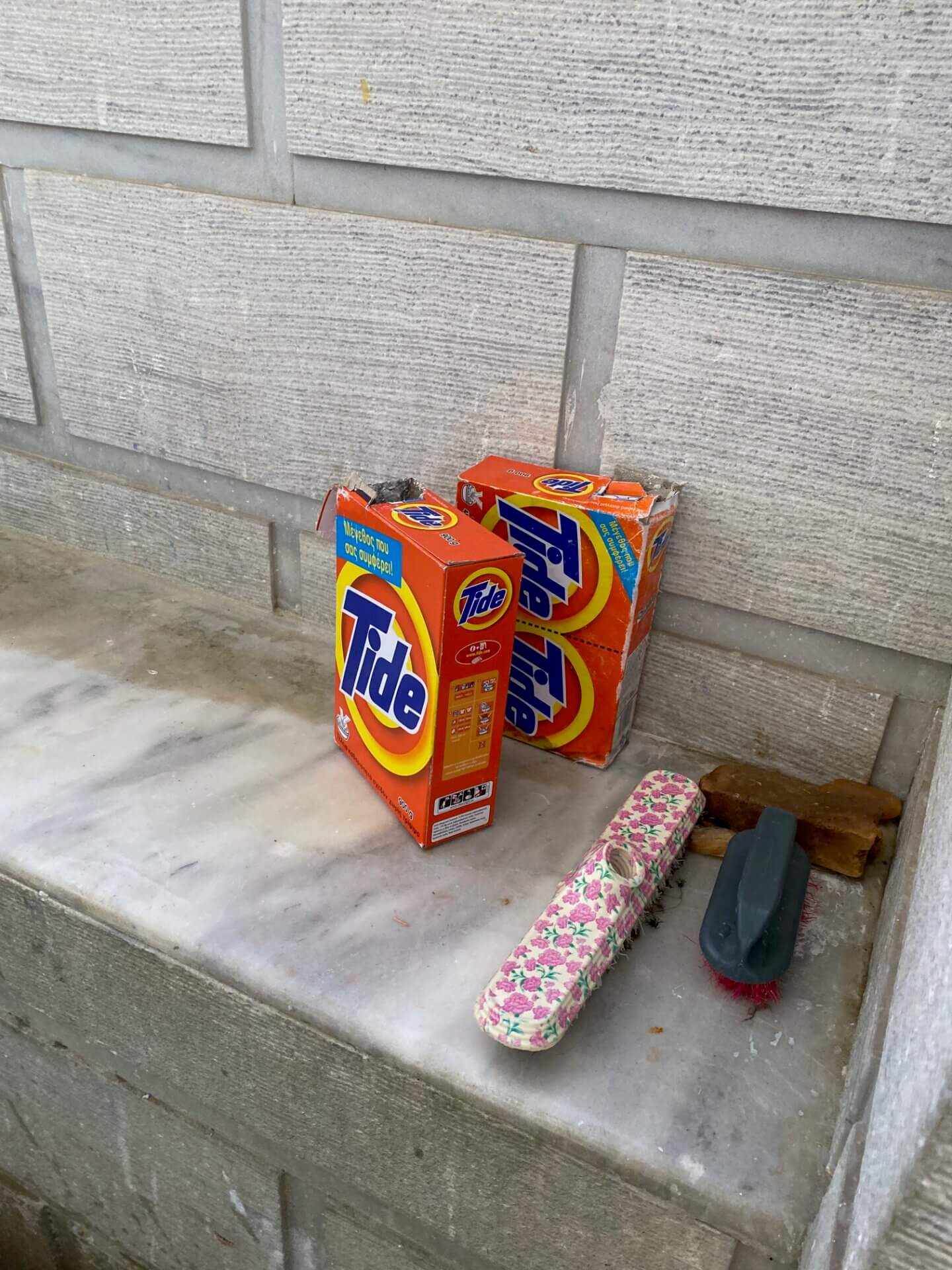
Chuck everything in overnight, rinse it and hang it out to dry in the morning.
For a mid-stay load make sure you book at least a night or two in an apartment with a washing machine. Or head to the local laundry/laundrette.

Note that not every island will have a laundry, and many that do literally are laundries, not self-service laundrettes. I’ve used a few in different places, and the turnaround time has been about 2 hours.
On average, I’ve paid between 5 euro for wash up to 15 euro (Santorini) for wash and dry. Although I think one place in Mykonos was something ridiculous, like 18 euro. If you don’t want them to use fabric softener you need to really insist that they don’t.
I usually just get my stuff washed and I dry it where I’m staying as I think that’s much nicer to dry it outside. However, it will depend on the size and facilities of your accommodation plus the time of year you visit.
Easywash is a brand of self-service laundrettes and you can see all their locations here . You can also use Google Maps to find laundries in the area you’re visiting. This post on 15 Best Apps For Greece Travel might be helpful.
How do I open the windows/doors?
Ok, this sounds like a random one. But I know from my experience in the hospitality industry, and now in Greece, that windows and doors can flummox visitors in different countries!
The type of window below is quite common in Greece (and Europe), and the same design is used for doors too.
If you’re playing around with the handle to see how it works, you can get a fright when the door angles back from the top. The first time I encountered a door like this in the UK, I thought the whole thing was falling on me!
Close the window with the handle down

Turn it 180 degrees, and it opens at the top only (secure but lets air in)

Turn it 90 degrees, and it opens normally

How do I get hot water?
Solar-heated water is common in Greece. You’ll have water when the sun has had a chance to heat the tank. In that case, you might not have water first thing.
Once the water’s heated, it could cool down in the evening if it’s not hot enough outside to keep it warm. So, you may need to be strategic about when you have a shower.
Some water tanks are heated electrically, like an immersion heater. More than likely, the switch on the fuse board will be kept off until you need it.
If you’re staying in an apartment or villa, this might be the case. If so, you’ll need to flip the switch for about 20 minutes to let the tank heat up.

Make sure you turn off the switch before you get in the shower. Water and electricity don’t mix, and standards of installation might not be as high as you’re used to.
Can I drink the tap water?
The general answer you’ll find on the islands is no, however, there are exceptions. Like on Paros . But don’t worry, you don’t necessarily need to buy single-use plastic bottles for your whole stay.
The Greek water supply is subject to the same levels of cleanliness as the rest of the EU. Unless you’re somewhere remote you’re getting water from the mains.
So cleanliness isn’t really the issue. It’s more that seawater can mix with the mains water. Many islands don’t have desalination plants and don’t remove any of the excess minerals/salts that the water contains.
@bucketlistmylife Don’t drink the tap water here! Walk with me… #greekislandlife #bucketlisters #over40andloveit #housesitter #naxos ♬ From Now On – Hugh Jackman & The Greatest Showman Ensemble
If you’re in cities like Athens, it’s ok to drink the water from the kitchen tap. However, on most islands, you’ll be told not to do that. The villages have public taps in the street but check locally whether this is good to drink.
In some places, I understand they’re supplied by a spring, and it’s fine to drink. In other places I’ve stayed, the public taps in the village were the same as the kitchen tap water, and I was told it was not a good idea to drink from.
10 litres of water for 10 – 20c in Syros and Paros, Free in Andros
In the supermarket, a 1.5l bottle of water will cost about 30c. Although there’s a big awareness campaign on Paros to show people the water is safe to drink, you might still prefer filtered. In which case you’re in luck.
Syros and Paros both have big units in several points across the islands where you can get 10l of water for 10c (Paros) or 20c (Syros). You’ll obviously need a few bottles to fill, or ideally a 10l container. Find out more about the locations in Paros here .
In Syros, I’ve seen them on the road to Vari (just before the village, travelling from town) and on the big roundabout along from the Lidl and the bus station, where the taxis stop. Ask about them at your accommodation.
In Andros , these machines are free to use.
Is it true I can’t flush the toilet paper ?
Yes, it is. Greece was ahead of its time and invited toilets before toilet paper was a thing. Therefore, the pipes used were really narrow. As things changed, it didn’t make sense to overall the entire country’s plumbing system so the same tiny pipes are still used today.
You’ll find a small bin in the toilets where you throw your toilet paper (and anything else you need to dispose of).
The bin bags get thrown out with the normal rubbish when they’re full. If you’re staying in a hotel or serviced apartment, housekeeping will come in regularly to remove and replace your bin bags.
I hate it, and as a rule, I take the bin bag out myself. What a horrible job for someone else to have to do for me. If that’s not practical, I always tie the top to try and make it marginally less unpleasant.
Are public toilets easy to find?
It’s generally quite acceptable to pop into the nearest taverna and ask to use their loo. I always think it’s polite to buy a drink to take away, but I’m not sure it’s expected.
You will find public toilets on the more popular islands, but the state of them can’t be guaranteed. I’d recommend always having some tissues in your bag. Oh, and they’ll likely be holes in the ground with a porcelain plate to stand on.
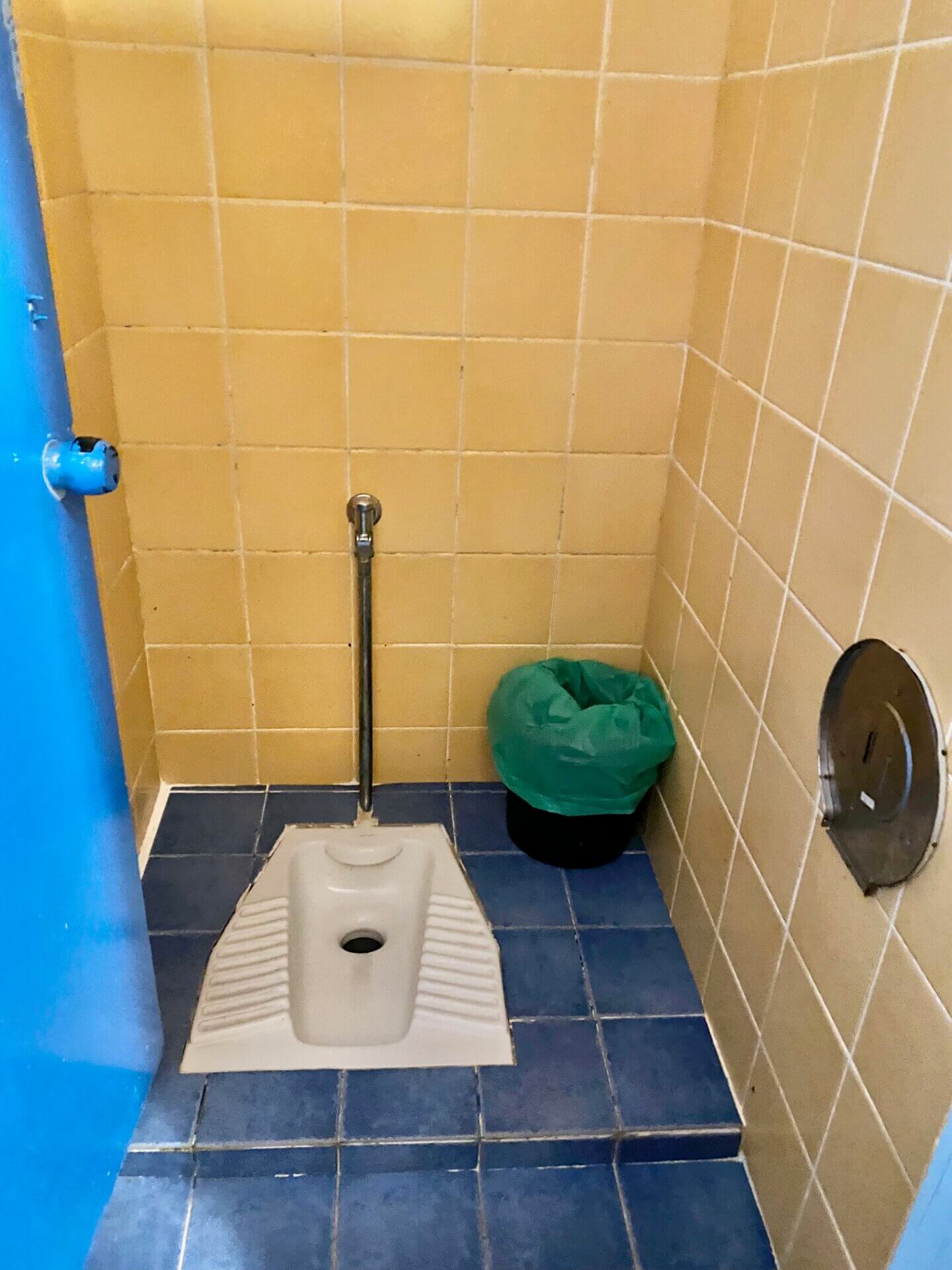
There’s often a toilet at the port of the larger islands. In my experience, they’re generally not awful during the peak season.
Alternatively, petrol stations usually have public toilets. The larger chains like BP mostly keep them in good condition. Local ones might ask you to wait a moment while they clean it for you!
Supermarkets are another option you can ask in. AB Supermarkets always seem to have a decent customer toilet.
Travel Insurance
All I have to say about this is make sure you get some for Greece travel adventure. Get something that repatriates you to your home country if you have an accident or get ill with something like COVID.
Historically I’ve been really rubbish with this because a lot of my travel was within the EU while the UK was part of it. But I’ve heard a lot of horror stories recently about people travelling without insurance. (Globally, that is, not necessarily in Greece.)
Insurance will cover you if there’s an issue with your flights or baggage (check the terms carefully) as well as medical issues. So it can really save your vacation if things go awry.
Animal Welfare
It’s really common to see stray cats all over Greece . They’re supposed to be cared for by the local Municipality (council) who should provide water and dry food.
But often, the responsibility is, wrongly left to animal welfare associations. These are usually set up by foreigners.
You can help by taking a cat to the vet to get neutered; perhaps talk to the welfare association first. A clip in the ear means that a cat has already been sterilised.

If you’re self-catering for any part of your trip and are eating anything from a tin can, please crush it before binning it. Many cats live in and around the bins, and they will scavenge anything.
If there is the tiniest bit of food in a can, they’ll get their head in to eat it. The problem is, they can’t always get their head back out again. So please crush your cans .
Although there used to be an issue with packs of stray dogs, over the last 10 years, that’s really changed. At least on the islands. On the mainland, particularly in the north, I’m aware that you might still encounter packs of dogs.
However, you will still see stray dogs on the road. Sometimes it’s hard to know whether they really are stray. Many Greek owners let their dogs run about on the road. If a dog has a collar on then that usually means it belongs to someone.
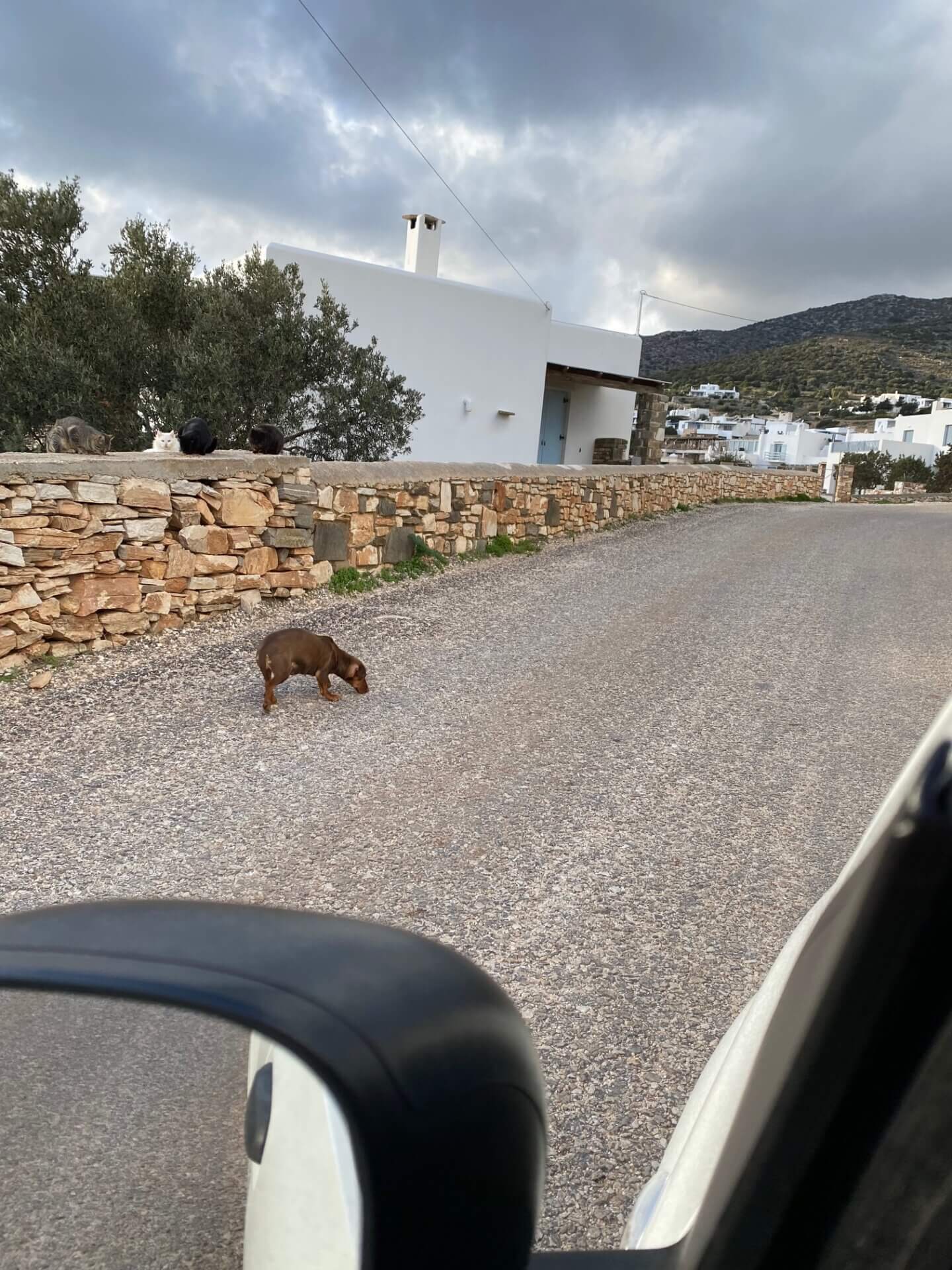
If you see a dog in a bad way, regardless of whether it has a collar, report it to the island’s animal welfare association.

Farm animals
Many Greek farmers are using modern farming techniques and treat their productive animals well. But something you might see is hobbling, where horses, goats, sheep and cows have their front and back legs tied together with rope or wire.
This is illegal and you can report it to the local police. You need to take pictures but there are guidelines you can read here
Visiting Greece in Winter
A lot of the travel tips I’ve given above hold true whatever time of year you visit the Greek isles. But if you’re thinking of visiting Greece in winter, there are things to know.

Greek Islands in Winter – Do they Close?
This is such a common question. The answer is that no Greek island “closes” in winter . People live on the islands all year round.
But, in terms of what’s available from a tourist point of view, many of the restaurants, shops, services, hotels and tours provided for them do close down over the winter.
If you want to visit the islands between October/November and April, then be aware you’re going to have a different experience than in the summer.
Here’s what it’s like in Santorini in October and November and Paros in October .
You can still enjoy Greek culture and indulge in Greek cuisine. The incredible beaches are still there. But unless you’re a hardened cold-water swimmer, you’re not going to be doing anything other than going for a bracing walk along the sand.
If you want to visit Greece in the winter, you’re best doing a city break in Athens or exploring the mainland.
Here’s what to expect from Greece in November , and Christmas time in Athens .
Island-hopping is still possible if you stick to a particular ferry route. For example, Paros, Naxos, Ios, Santorini. But you’ll be going for the views, hiking and food and not beaches, boat trips and partying.
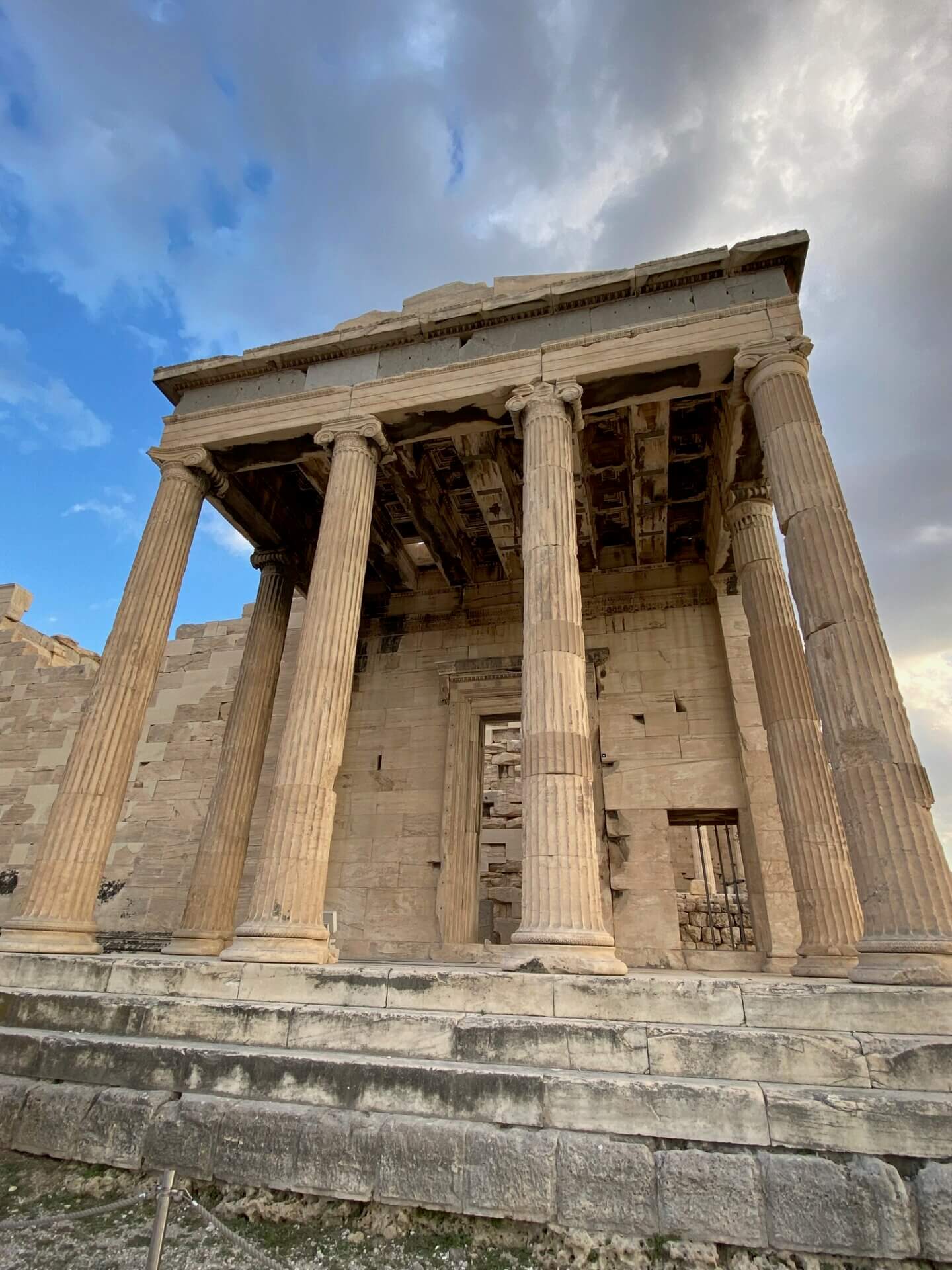
Important Greece Travel Tips for Winter
- staying in island accommodation that’s designed for the summer isn’t fun in winter. A lot of homes are drafty, damp, have no heating and only have hot water if the sun shines for long enough.
- most touristy tours and trips don’t run in winter. For example, if you visit Mykonos after October/November there’s no way to get over to Delos to see the ancient ruins
- local public transport routes can reduce after the peak season
- ferry routes and flight options vastly reduce after October and sea journey times can be much longer than in summer
- generally, it doesn’t snow on the islands although it can. Mostly, it’s rainy and windy, although it can vary between the island groups
- If you’re particularly looking for snow and cosy cabins, then head to the mainland for ski resorts and mountainous destinations
Do I Need a Visa?
Currently, citizens from the UK, USA, Australia and the EU do not need a visa to enter Greece for a period of up to 90 days within a rolling 180-day period.
From 2025, you still won’t need a visa, but third-party nationals from countries like the US, UK and Australia will need an ETIAS. This is a visa waiver and is required before travel. You apply online and once approved, the ETIAS is valid for three years.

Suzie Young
Suzie writes informative posts for solo, nervous or first-time travellers to Greece, Turkey and other countries on her 50-before-50 bucket list. She became a Greek resident in 2020 and intends to visit every inhabited island (13 down!).
Leave a Reply Cancel reply
Your email address will not be published. Required fields are marked *
Save my name, email, and website in this browser for the next time I comment.
This site uses Akismet to reduce spam. Learn how your comment data is processed .

The ultimate guide to unforgettable holidays
Aegina. The hidden jewel of an island just 35′ from Athens

Filled with fascinating ancient sites, religious landmarks, hikes and more, Aegina is emerging as a top destination for day-trips from Athens and even for extended vacations. A favorite among Greeks. Read along to see why I believe that this island is a hidden jewel.
Best Greek Islands 2022

2022 has all the potential to be a fantastic travel year. And Greece is probably on the top of a lot of travelers lists. Since 2020 I have maintained this post as a go-to guide for the best Greek islands to visit. Enjoy the read 🙂
How to get from Athens airport to the ports

Getting from Athens international airport to the three ports of Athens is easy for locals but can be confusing for travelers. Read this complete guide on how to do it like a local.
Best Beaches Paxos. The finest of the Ionian

Don’t get dazzled by the beauty and number of beaches that Paxoi/Paxos have to offer. I’m here to help you decide which beaches are for you by listing all of Paxos best beaches
Greek Islands COVID-19 Travel Updates 2020

All you need to know on how Greece is opening up for tourism amid COVID-19. Get frequent updates with hotel-ferry-restaurant-beaches re-opening schedule. How to plan your vacation with safety and more
Amorgos. The island with the deepest blue waters

Have you ever wondered which Greek island has the deepest, most fascinating blue color waters? Read this GURU island review to find out Amorgos’s best secrets. Read along as I share my personal experience on where to swim, where to stay, when is the best time to go, how to get to this stunning island and more.
Athens Taxis. Can they be trusted?

Finding a reliable taxi in Athens can be tricky. In this post, I share my most useful tips to avoid headaches and taxi scams. Learn how to ride a cab in Athens like a Pro.
How to get a taxi at Piraeus port. The right way

Getting a taxi at the port of Piraeus might prove a troublesome task. Read how to avoid landing on the wrong driver and make sure you do not overpay.
Top 5 off-the-beaten-track Greek islands
Find out what are the best islands that remain mostly undiscovered by mass tourism
Cyclades. This is how to choose the one for you

This is a short description of this wonderful post I have just written
- Island reviews
- Island selector

Aegina. The Hidden Jewel of an Island Just 35′ From Athens
Copyright © 2023 | All rights reserved | GreekIslandGuru.com

- Living In Croatia
- Croatian Recipes
- Balkan Recipes

Home > Greek Islands: Local’s Guide To Island-Hopping Greece
Greek Islands: Local’s Guide To Island-Hopping Greece

Written by our local expert Gabi
Gabi is an award-winning writer who lives on the Island of Crete in Greece. She is an expert in Greek travel and writes guides for the everyday traveler.
Although most of us close our eyes and dream about the enchanting images of white Santorini, there are so many more Greek islands to choose from that you never know exactly where to start island-hopping in Greece..or where to finish!
So, please let me help you island-hop Greece like a local, using my own travel experience of living in Greece for many years.
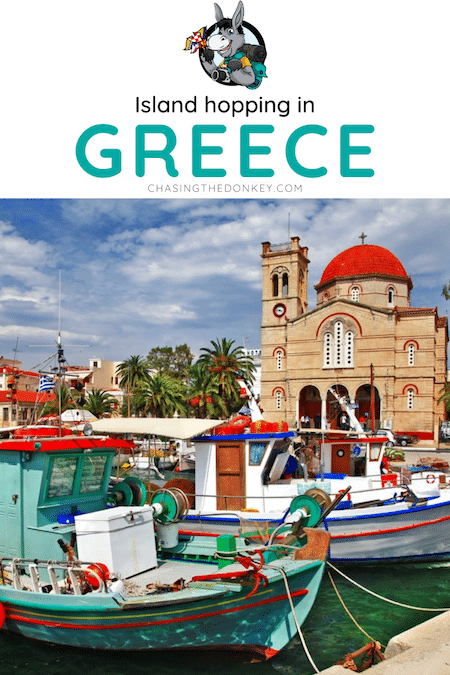
There is nothing more magical, romantic, and adventurous than boarding a Greek ferry and sailing the sea to explore the beautiful beaches of Greece. The Greek islands are blessed with stunning landscapes and feel like an authentic slice of paradise.
You must first know that the Greek islands are divided into different island groups. As well as that, some islands are extremely popular among Greek island-hopping tourists, while others, equally enchanting, are almost unknown and offer a great vacation spot for those looking for less crowded places… which often come with much lower price tags too!
So, let’s get started and show you the best way to island hop in Greece;
Skip Ahead To My Advice Here!
The Greek Islands Groups
Let’s take a look at the islands of Greece and what groups they belong to.
These are the most popular islands in Greece . When you go island-hopping in the Cyclades, you can visit gorgeous beaches and places like Santorini , Mykonos , Sifnos, Syros, Serifos, Paros, Milos, Naxos, Amorgos, Ios , Tinos, and Folegandros.
This beautiful slice of Greece includes islands such as Patmos , Samos, Kos, Tilos, Symi, Kalymnos , Leros, and Rhodes. The latter is one of the most popular destinations and often features on Greece island-hopping itineraries .
Ionian Islands
These islands are easy to visit when visiting Greece from Italy , one of the many popular Greek island hopping routes. Corfu , Lefkada , Kefalonia , Zakynthos , and Ithaka are some of the best-known Ionian Islands.
Argo-Saronic Gulf Islands
Easy to reach as they are relatively close to Athens , the most popular Saronic Islands include Aegina, Poros, Hydra , Spetses, Salamina, and Agistri.
Crete is Greece’s biggest island. It’s a major destination on its own, a place where you could spend a week or more exploring amazing beaches and ancient sites.
However, Crete is also a much-visited destination among people who are island-hopping in Greece . It is, for example, a great base from which to visit Santorini on a day trip .
Evia is the second biggest island in the country, and it is also easy to reach from Athens .
Northeastern Aegean Sea Islands
Some of the islands in this group are Lesvos, Chios, Samos, Ikaria , and Thasos.
These beautiful green Greek islands include Alonissos, Skyros, Skiathos, and Skopelos.
As you can already see, there is no one best Greek island for island-hopping – you have to see a few. Let us show you how many islands you can see on your island-hopping around Greece adventure with the ferry routes below.
Brands We Use And Trust
Ferry routes to the most popular greek islands .
When planning those unforgettable Greek island-hopping adventures, deciding where to go first or how long to stay is a decision that will be subject to the Greek islands’ ferry routes, ferry schedules, and your Greek budget .
Are you ready to start planning your Greek island-hopping vacation? Let’s go! This article gives you a sweeping panorama of how to island-hop in Greece. But, first things first, are you starting on the mainland? If so read this section:
From Athens To The Main Greek Islands
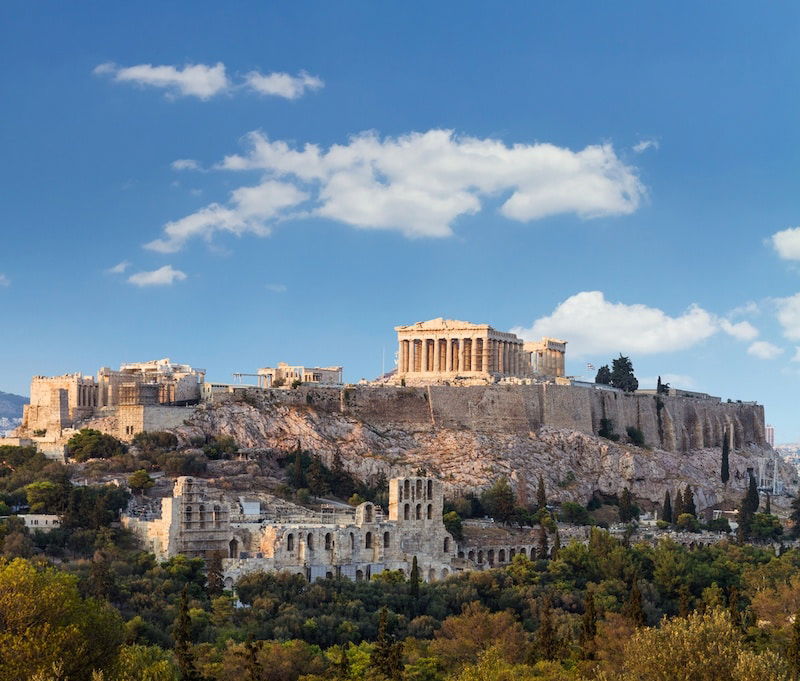
Athens, the capital of Greece, offers access to all the islands, either by plane or by ferry routes to the Greek islands . Popular islands, including Rhodes, Corfu, Crete , Mykonos, and Santorini, can be reached by flying out from Eleftherios Venizelos International Airport.
The most popular tours from Athens:
- 🏝️ Book this 13-day Greek islands tour in Mykonos, Santorini, Crete, and Rhodes and admire the beauty of each island!
- 🏞️ Grab the opportunity to visit the most cosmopolitan destination in Greece – Mykonos Island – on this day trip from Athens
- 🚢 Visit the most famous Greek islands – Santorini and Mykonos on a 2-day trip from Athens
- 🛥️ Spend four days traveling around some of Greece’s island hotspots by joining this trip with ferries, flights, and accommodations included
- 🚢 Book your ferries with Ferryhopper in advance
Athens Ferry Ports
It’s also a popular choice to travel by sea. You can reach most Greek islands from the main Port of Piraeus, about 30 minutes from the center of Athens. However, it would help if you also kept in mind that there are other ports from which you can depart, too. Lavrio and Rafina are two smaller island ports in Athens with regular ferry services to different Greek islands.
- From Lavrio: you can reach the islands of Chios, Lemnos, Andros, Folegandros, Ios, Kea, Kimolos, Kythnos, Milos, Mykonos, Naxos , Paros, Sikinos, Syros, and Tinos.
- From Rafina: instead, it’s possible to visit the islands of Crete, Andros, Folegandros, Ios, Amorgos, Mykonos, Naxos, Paros, Sifnos, Sikinos, Syros, Tinos, and Santorini.
You can choose between fast ferries to the Greek islands that carry boat cargo on this route. These are ideal if you want to take a rented car or motorbike with you.
For the best flight deals, book your ticket here .
Corfu to santorini, crete, and mykonos.
There are no direct flights from Corfu to Santorini, Mykonos, or Crete. Therefore, if flying is a must, the best way to get there is to fly to Athens and then take another flight to the island of your choice.
Other alternatives include taking the ferry from Corfu to the mainland and, from there, boarding a bus to Athens. Once in the capital, you can choose either a ferry or a plane to reach Crete, Santorini , or Mykonos.
Another alternative is to reach Larissa from Corfu and take a train trip to Athens.
Crete To Santorini

There are no direct flights from Crete to Santorini , but a ferry route connects both islands during the high season with at least 2-3 daily ferry crossings.
The ferry times between these Greek islands range between 2 and 4 hours, depending on whether you take a fast or regular ferry. The cost of the ferry trip between Heraklion and Santorini is about 50 euros, and it can be a great day trip if you’re staying in Crete. This is one of the most popular ferry travel routes on the Greek islands.
Rhodes To Crete

The trip from Rhodes to Crete can be quite long on a ferry. That’s why most travelers choose to fly from Heraklion, Crete’s capital. The flying time is about 50 minutes, and prices tend to be considerably high, so booking in advance is a good idea.
The ferry route connecting Rhodes to Crete is covered by the sailing company Aegeon Pelagos. There are four weekly connections and the traveling times range between 11 and 15 hours.
It’s possible to board the ferry with a car, a motorbike, or a camper van. Since it’s such a long trip, the vessel offers facilities, including restaurants, bars, and shops , to make the journey more pleasant.
I highly recommend this full-day land rover tour.
Mykonos to santorini.

The only way to travel between Mykonos and Santorini is by boarding a ferry since no direct flights connect the Aegean Islands .
You can save some money traveling with regular service (about 4 hours), pay more, and cut off your traveling time by at least two good hours.
Since this is probably the most famous sea route during summer, it’s a better idea to book your ferry tickets well in advance – we suggest Ferryhopper for that here. The trip from M ykonos to Santorini is among the best Greek island hopping experiences you can have.
Book your Santorini Day Trip From Mykonos here
Naxos, Paros, Ios To Santorini
The three islands are connected by ferry routes all year round, with a considerable increase in services during the high season .
The best way to travel among these islands is by boarding a fast ferry. The ferry travel times between these Greek islands vary from 2 hours to 45 minutes (Paros-Naxos).
The three islands can also make an excellent escape from the bustle of Santorini and are the perfect destination for a one-day trip or a weekend away.
Here is how to island hop between Mykonos and Ios.
Rhodes to santorini, mykonos, and other cyclades.
The best way to travel between the Greek Cycladic Islands and Rhodes is by boarding a ferry to Athens and, from there, boarding another ferry to any of the Cyclades Islands (or Rhodes).
It’s not common to find ferries departing from Rhodes with a stop on the Cyclades , but if you manage to book a vessel making a stop either in Naxos or Paros, it would unquestionably be a winning choice. Check with your ferry operator to find the best Greek island-hopping route for your trip.
Here is how to island hop between Mykonos and Paros.
Italy to greece.
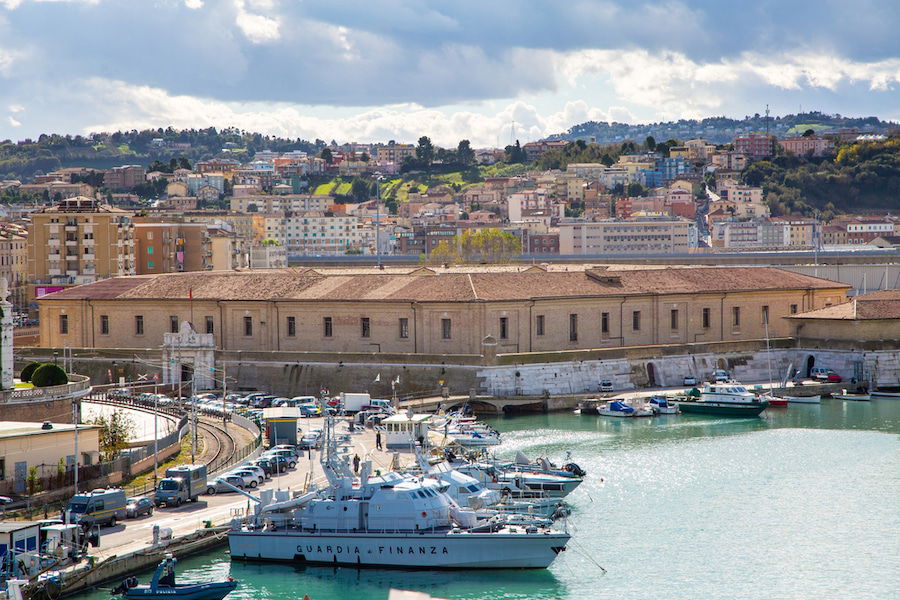
As we mentioned in this post about traveling from Italy to Greece , there are comfortable ways to connect both countries by plane or ferry. Ferries depart from Italy’s main ports , and it’s possible to board most vessels with a rental car or a motorbike.
Some of the ports are Bari, Ancona, and Venice, and they usually connect Italy to the Greek ports in the Ionian Sea , including Corfu, Igoumenitsa, and Patras.
Of course, routes (and prices) increase during the high season, which in Europe goes from June to September.
We recommend you book your ferries with Ferryhopper in advance here.
Which greek islands have airports.
Let’s go island-by-island.
What Greek Islands Have Domestic Airports
- Chios Island
- Ikaria Island
- Kalymnos Island
- Kythira Island
- Milos Island
- Naxos Island
- Paros Island
- Skyros Island
- Syros Island
What Greek Islands Have International Airports
- Astypalea Island
- Corfu Island
- Crete Island
- Kefalonia Island
- Lemnos Island
- Lesvos Island
- Rhodes Island
- Samos Island
- Santorini Island
- Skiathos Island
Best Greek Islands For Island-hopping
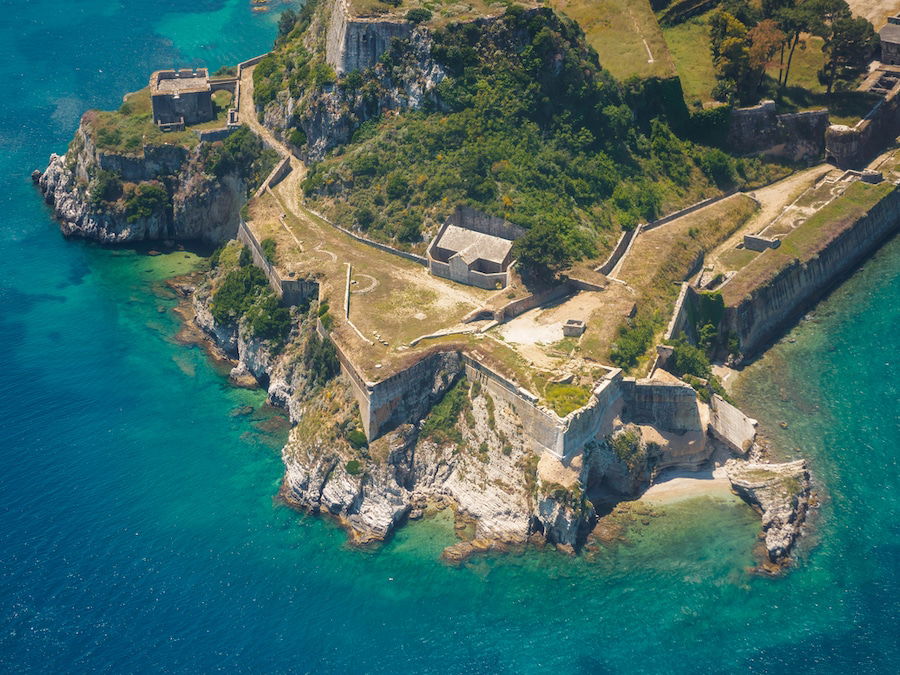
Deciding which Greek islands to include in your Greek island-hopping itinerary can be difficult. It depends on what activities you love doing and how you prefer to spend your vacation time.
Do you love sunbathing and swimming on sandy beaches ? Do you dream of soaking in the whitewashed landscapes of Greece? Are you eager to climb mountains and fill your trip with incredible adventures? Do you want epic Greek nightlife ?
There’s an island for every taste and every traveler… People usually choose to visit the most popular places either because they heard about them or because some other travelers suggested so.
Here are our ideas for the lesser-known Greek Islands.
People often flock to places such as Santorini, Mykonos, Corfu, Hydra , and Crete, for the best beaches, totally unaware there are hundreds of other islands worth visiting in Greece.
If you’re visiting Greece for the first time and eager to discover some of the best islands, the best thing to do is travel around on a ferry. You can get to even some of the less-visited islands with ease.As you can see above, tons of ferries connect the Greece islands, making it super easy to have an unforgettable Greece island-hopping experience.
This is not only the most good option when it comes to ticket prices, but it is also the favorite way to travel for locals. You will immerse yourself in the right atmosphere that will set the pace for a relaxing trip.
One of the best Greek island-hopping tips we can give you is: don’t run against the clock. The most enjoyable way to visit Greece and the islands is to take one place at a time and enjoy it to the fullest. When it comes to island-hopping the Greek Islands, I think that less is definitely more.
What is the best time to go Greek island-hopping?
The best months to enjoy a Greek isle adventure has to be when it’s warm, but the hordes of vacationers have left – making that May, June, and September. Of course, the summer months of June, July, and August are the most popular as that is when people have summer break – but that is also when the prices are higher and crowds bigger
Is it easy to island hop in Greece?
YES! With hundreds of islands and decades of tourism experience, Greece has an excellent, well run and efficient ferry network, making hopping from island to island easy and cheap
How to island hop Greece?
We have provided you with many tips; plan in advance and don’t rush from place to place for the best experience
Can I take a self-guided Greek island-hopping trip?
Is it expensive to island hop in greece.
Yes, and no. Budget travelers can find low-cost accommodations, or you can also stay in 5-star resorts. Just as you can enjoy low-cost street food or eat in the finest restaurants. Greece offers something for all budgets
How long do you need when island-hopping in Greece?
You can rush, but then you would not get to fully immerse yourself in the authentic way of Greek life. At a minimum, we recommend that you spend three nights on each island. So if you have just 10 days in Greece, do not island-hop more than three islands, and spend at least one day in Athens or Thessonaliki
What is the cheapest way to island-hop in Greece?
The cheapest – and easiest way to get around the Greek Islands is by jumping on the Greek ferry system. With several ferry companies offering ferries to and from all of the islands all year, you do not need to spend much
Which Greek island should I visit first?
We hope that island-hopping Greece has been made easier with this guide on planning a Greek island-hopping holiday adventure.
- Best Things To Do In Greece With Kids
- How To Tip In Greece
- Car Rental And Driving Tips For Greece
- Where To Stay In Crete
- What To Do In Greece
- What To Expect & Do In September In Greece
Comments (12)
Very nice blog on Island Hop Greece, Here Is How To Travel Between Greek Islands
Hi SJ, I was thrilled to find your blog. Croatia was my last vacation (before Covid) and I finally booked a “post Covid” vacation for April 2023, We will be taking a Windstar cruise from Barcelona, thru a few ports in Italy and ending in Athens. My plan is to add a few days in Greece after the 8 day cruise. We will sightsee in Athens for 2 days and then I would like to see one (or two) of the Greek Islands. Can you recommend which island we should go for the best overview of Greece. We are 60+ years old so I don’t car about the nightlife of dancing and partying. I want culture and food! Thanks Gail G
Hi Gail, the trip sounds amazing! I would look at these islands for what you describe: Kefalonia: https://www.chasingthedonkey.com/things-to-do-in-kefalonia-greece-guide/ Lefkada: https://www.chasingthedonkey.com/things-to-do-in-lefkada-island-greece/ Milos: https://www.chasingthedonkey.com/things-to-do-in-milos-island-greece/ Aegina : https://www.chasingthedonkey.com/things-to-do-in-aegina-greece-guide/
Enjoy your vacation!
I am planning a trip to Greece to Island Hop in July. Please advise on the best way to travel between (Athens, Mykonos, Naxos and Crete). I was thinking; Atlanta to Athens (flight) with first island Mykonos (High Speed Ferry or flight) then Naxos (High Speed Ferry) and then Crete (flight) and back to Athens (flight) then fly back to the USA. While in Crete we will likely do a day trip to Santorini.
I have visited Athens, Mykonos, and Santorini in 2017. How many days should I plan for in Naxos and Crete? Please recommend hotels in Mykonos, Naxos and Crete.
Hello.What island to choosef rom September 15 to30 so that it is possible to swit. Thank you Edvardas.
Possible to “Swit” what does that mean?
Hi, Great reading your site. We have 21 days to explore the Cyclades Islands starting in Santorini and ending in Athens, we want to do this leisurely using Ferries. We like the thought that less is more but we have a nice length of time. What route would you suggest ?
Best wishes, Jim
For a leisurely 21-day exploration of the Cyclades Islands starting from Santorini and ending in Athens, you can enjoy a wonderful island-hopping experience. Here’s a suggested route that balances relaxation with exploration:
Day 1-4: Santorini Day 1-2: Arrive in Santorini. Spend your first two days exploring Fira and Oia, enjoying the sunset views, and perhaps a wine tour. Day 3: Visit the Akrotiri Archaeological Site and relax on the Red Beach. Day 4: Take a boat tour of the caldera, including the hot springs and Thirassia. Day 5-7: Ios Day 5: Take a ferry to Ios. Enjoy the beaches like Mylopotas and relax. Day 6: Explore Ios Town (Chora), visit the windmills, and enjoy the local cuisine. Day 7: Spend a day on a secluded beach or partake in water sports. Day 8-10: Paros Day 8: Ferry to Paros. Explore Parikia and visit the Panagia Ekatontapiliani church. Day 9: Day trip to the picturesque village of Naoussa. Enjoy the beaches. Day 10: Explore the interior of the island or take a short boat trip to Antiparos. Day 11-13: Naxos Day 11: Ferry to Naxos. Visit the Portara and explore Naxos Town. Day 12: Explore the inland villages like Apiranthos and Filoti. Visit the Temple of Demeter. Day 13: Relax on beaches like Agios Prokopios or Agia Anna. Day 14-16: Amorgos Day 14: Ferry to Amorgos. Visit the Monastery of Hozoviotissa and the Chora. Day 15: Enjoy the serene beaches and explore the island’s hiking trails. Day 16: Relax and soak in the traditional island life. Day 17-19: Syros Day 17: Ferry to Syros. Explore Ermoupoli and its neoclassical architecture. Day 18: Visit the Ano Syros, and enjoy the panoramic views. Day 19: Relax on the beaches or visit the local museums. Day 20-21: Athens Day 20: Ferry to Athens. Explore the historic sites like the Acropolis and Plaka. Day 21: Visit the National Archaeological Museum and spend your last evening in a nice Athenian restaurant. This itinerary gives you a mix of popular and lesser-known islands, each with its unique charm, allowing for a well-rounded experience of the Cyclades. Remember to check the ferry schedules in advance as they can vary, especially outside of the peak summer months. Enjoy your trip!
Hi, I love reading all of your information but hoping for suggestions on the next part of our holiday. My husband & I will have 12 days to get from Istanbul to Athens in April-May. Hoping to go via some Greek islands. I am having trouble with ferry schedules at the moment. Could you suggest a route that would work? We are not fussed which islands we go to. We do not have a car. Many thanks in advance
Here is a list of Greek Islands you can get to from Türkiye https://www.chasingthedonkey.com/how-to-visit-the-greek-islands-close-to-turkey/ the obvious place to start from Istanbul woul dbe to go to Izmir and go Cesme to Chios. Then the world is your oyster. Suggestions here: https://www.chasingthedonkey.com/island-hop-greece-travel-between-greek-islands/ Use FerryHppper to buy your tickets. https://www.ferryhopper.com/en/?aff_uid=chsgdnk
We will be traveling to Athens this June and we are still trying to decide on the islands we want to see. We have 3 weeks to explore Greece, and since it’s our first time there we want to spend our first few days exploring Athens and then head to some islands. We do want to see Mykonos, Santorini, Los, Paros. Any recommendations for other islands and the route we should take? Thanks!
Consider adding Naxos for its beautiful beaches and rich history. A suggested route could be Athens -> Mykonos -> Naxos -> Paros -> Santorini -> Ios.
Leave a Reply Cancel reply
Your email address will not be published. Required fields are marked *
Save my name, email, and website in this browser for the next time I comment.
This site uses Akismet to reduce spam. Learn how your comment data is processed .
Move This Adventure To Your Inbox & Get An Instant Freebie
Subscribe To Unlock Your FREE Customizable Travel Packing List & All Our Best Tips!
Unlock Your FREE Customizable Travel Packing List!
Subscribe Now For Instant Access To Stress-Free Packing

Greece Travel Guide
Last Updated: June 6, 2024

It’s also one of the more affordable countries on the Euro.
You can travel around Greece for a fraction of what you’d spend in other Western Europe, which is just one of the many reasons why I absolutely love visiting Greece.
I’ve been to Greece many times and have spent months exploring this country. I cannot say enough good things about it.
Visiting Greece is always the highlight of my summer European travels. There’s just something magical about this country. There’s an energy in the air and you can’t help but think, “Maybe I should never leave?” It sucks you in.
And, while the Greek islands get the most attention, the interior of the country — with its small towns, historic ruins, and mountain hikes — is too often overlooked and underappreciated.
So, while you may have a strong desire to stick to the islands, try to get to some of the places in the interior if you can. You won’t regret it.
This Greece travel guide combines all my knowledge and experience to help you plan an epic, affordable trip!
Table of Contents
- Things to See and Do
- Typical Costs
- Suggested Budget
- Money-Saving Tips
- Where to Stay
- How to Get Around
- How to Stay Safe
- Best Places to Book Your Trip
- Related Blogs on Greece
Click Here for Island and City Guides
Top 5 things to see and do in greece.
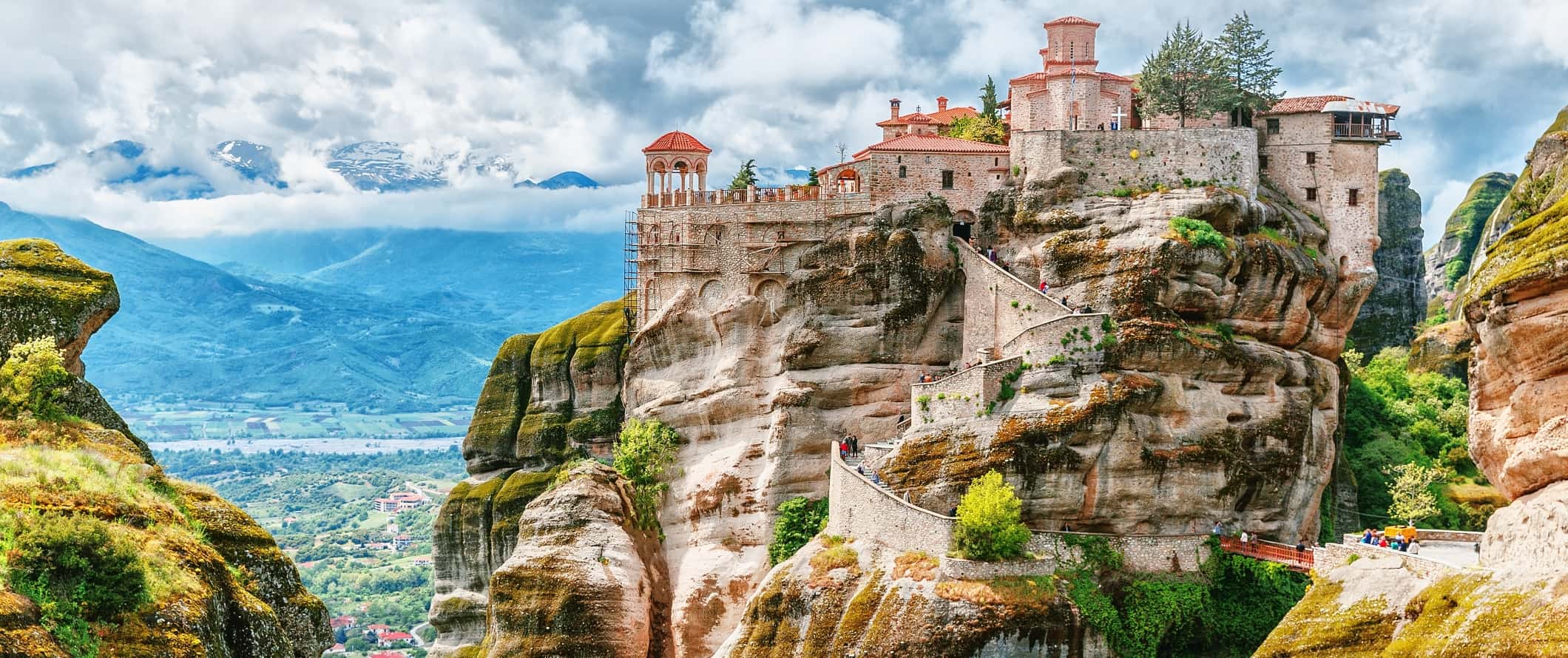
1. Visit the Acropolis
Located in Athens , this magnificent hilltop complex from the 5th century BCE includes ancient buildings and ruins like the temple to Athena and the famous Parthenon. A UNESCO World Heritage Site, this is an excellent place to learn about the city’s history. You’ll also get to enjoy an expansive view of the skyline and the nearby ruins. During the summer, it’s swarming with tourists so get there early. Admission is 20 EUR, or for 30 EUR you can get a 5-day combined ticket that includes many other archaeological sites in Athens. For a guided tour, Athens Walking Tours runs guided tours for around 55 EUR (including admission) that skip the line.
2. Discover historic Crete
Crete has a long, long history. It was once home to the ancient Minoan civilization (which predated Greek civilization), and you can still visit the Bronze Age ruins of Knossos, the ancient capital of the Minoan empire (also considered the oldest city in Europe). The island is the largest in all of Greece and has beautiful beaches (including a beach with pink sand), plentiful hiking, quaint towns, and delicious food and wine. It’s affordable and because of the island’s size, you can still escape the summer crowds. Don’t skip this island!
3. Hike up Mount Olympus
Mount Olympus is the legendary home of the Greek gods. Any climb to Mount Olympus starts from the town of Litochoro, 150 kilometers (93 miles) south of Thessaloniki. At 2,917 meters (9,570 feet) high, it’s the tallest mountain in Greece. The hike up is both strenuous and mystical. As you climb, it becomes abundantly clear why Greeks thought it was this mountain from which the gods ruled!
4. See Meteora’s monasteries
Meteora is famous for its monasteries that sit atop sheer rock mountains . They are a stunning sight to see and worth the steep trek up to the top. The monasteries date back to the 9th-10th centuries when Orthodox Christian hermit monks isolated themselves on the cliffs and in the many caves in the area. In the 12th century, the monastic community became more organized and in the 14th century the Great Meteoron Monastery was constructed (one of the ones that you can visit today). Although more than twenty monasteries used to perch on these sandstone cliffs, only six remain today. They are still active, with around 50 nuns and 17 monks living here. It’s a 3 EUR entrance fee per monastery.
5. Explore the islands
Other things to see and do in greece, 1. learn some history.
Greece is where western civilization began and everywhere you turn, you’ll find ruins that are thousands of years old. Start in Athens with the museums, the Acropolis and surrounding ruins in the Agora, and then set off to explore the ruins of Delphi, Sparta , Corinth, and Crete . There are also great archaeological museums everywhere to see artifacts up close and learn even more. This country is a history lover’s dream!
2. Explore Sparta
Sparta was the ancient rival of Athens and known for its fierce warriors (the entertaining but historically-inaccurate film 300 was based on the Spartans). The city has a long history and plenty of ruins to explore. There is no shortage of things to do , museums to visit, excursions to take, and places to eat when you visit the city. Be sure to check out the King Leonidas statue, visit the Archeological Museum, and explore the Diros Caves. I especially enjoyed the Museum of the Olive and Olive Oil, which takes you through how olives have become a staple of everyday life in Greece. It’s an often-overlooked city even though it’s only a 2.5-hour drive southwest of Athens. It’s a great place to learn some history without the crowds.
3. Attend the Athens Epidaurus Festival
Every summer, the Athens Epidaurus Festival hosts concerts and performance theater, including reenactments of famous Greek plays. There are operas, indie musicians, dance performances, lectures, and more. It’s a unique celebration of the performing arts in all their forms and worth your time if you’re in the city when it’s happening. Started in 1955, it’s one of the country’s top cultural events and runs for the whole summer (May-October). If it coincides with your visit, you’ll see just how proud the Greeks are of their past. Tickets for each performance cost as little as 5 EUR.
4. Soak up the sun in Corfu
The Cyclades Islands may get all the press but sunny Corfu on Greece’s west coast is also a good place to enjoy the beach too. It’s a popular destination for young backpackers, but once you get out of the main town, you can avoid them and their partying ways and get the island to yourself! There are plenty of quiet beaches, ancient ruins, and beautiful villages to explore. I especially recommend checking out the Achilleion a palace from 1890 as well as Nymfes Village, historic Corfu Town, and the incredible views from Angelokastro Castle. You’re just a stone’s throw away from Albania too.
5. Explore the Delphi Ruins
Delphi was a place of spiritual significance to the ancient Greeks. Located around 2.5 hours northwest of Athens, this UNESCO World Heritage Site is where the omniscient Oracle would contact the god Apollo and give his advice to those seeking good fortune. Although the eternal flame no longer burns inside the temple, a visit to the Temple of Apollo is obligatory if you’re nearby. Admission is 12 EUR and includes entry to the museum as well as the archaeological site itself (which includes far more than just the Temple of Apollo). There are a lot of day trips to Delphi from Athens starting around 48 EUR.
6. Explore Melissani Cave
This otherworldly cave grotto can be accessed by a short yet postcard-worthy boat tour. Located on the island of Kefalonia on the western side of Greece, here you can admire the seemingly magical ultramarine waters and the monumental walls that envelope you as you make your way through this hidden underground landscape. I love how you can see the lush forest and trees just above the cave walls. It’s totally surreal and the water is so clear that it looks like the boats are floating on glass. Admission is 7 EUR and includes the boat ride.
7. Hike the Samaria Gorge
Samaria Gorge in beautiful Crete is one of Greece’s National Parks and a UNESCO World Biosphere Reserve. For outdoor enthusiasts, this is considered one of the best hikes in Greece. While it isn’t the shortest or easiest trek (it’s 16 kilometers/10 miles), the gorge does promise beautiful landscapes, fantastic photo opportunities, and a great workout. Along the way, you’ll see the White Mountains and the trek ends at the lovely beach town of Agia Roumeli. The whole trek takes 5-7 hours to complete so make sure you bring water, sunscreen, and a hat as the heat can be overwhelming. The views are worth it though!
8. Experience the Patras Carnival
Every year in mid-January, the city of Patras (located 2.5 hours west of Athens) hosts what is basically a month-and-a-half-long party that starts on January 17th and runs to the beginning of Lent. There’s a slew of events both major and minor, increasingly crazy weekends, treasure hunts, and various costume parades (which even feature floats). It’s a lively time and as the largest such festival in Greece, attracting tons of revelers. If you want to attend, it’s a good idea to make hotel reservations well in advance as things fill up.
9. Tour the Archaeological Museum of Heraklion
The number one attraction in Crete , this museum also happens to be Greece’s second-largest archaeological museum (the museum in Athens is the largest). The artifacts here cover more than 5,500 years of history. One of my favorite pieces was a game board that dates all the way back to 1600 BC. The stunning collection here highlights the Cretan civilization (dating back from Neolithic times through to the Roman empire), with ancient pottery, jewelry, sarcophagi, colorful frescoes from Knossos, and more. Its Minoan collection is the most extensive in the world. You could easily spend hours here — especially if you love history like me. Admission is 12 EUR in the summer and 6 EUR in the winter.
10. Party on Ios
Ios has the wildest nightlife out of all the Greek islands. It is the summer party island where days are spent hungover on the beach and the nights are spent eating cheap food and drinking. If you don’t want to do that but still want to see Ios, it’s best to go to the eastern part of the island where it’s quieter. Don’t let Ios’ party reputation deter you from visiting though, it’s a beautiful, rugged island (and home to the grave of Homer, who wrote The Iliad and The Odyssey). It’s only busy from June-August so you can visit in the shoulder season to escape the party crowd.
11. Visit Thessaloniki
With more than 1 million inhabitants, Thessaloniki is Greece’s second-largest city after Athens. Although it dates back to 315 BCE, a lot of the city was destroyed by fire in 1917 and then by bombing during World War II. The result is a combination of more modern European city urban planning alongside Early Christian, Roman, and Byzantine monuments. In fact, Thessaloniki has more UNESCO World Heritage Sites (15!) than any other city in Europe. Be sure to visit the White Tower, the Rotunda, the Arch of Galerius, and Galerius Palace as well as the many churches (such as the Hagia Sofia and Hagios Demetrios). There are also several great museums here, including the Archaeological Museum, the Museum of Byzantine Culture, the Jewish Museum, and the Olympic Museum.
12. Go to Zakynthos
Just south of Kefalonia in the Ionian Sea is Zakynthos , one of Greece’s most popular islands. With its soft, sandy beaches and charming villages, it’s easy to see why this island is a fan favorite. It can be busy, particularly in the summer, so head away from the main tourist area (go north, west or inland) or visit in the off-season to escape the crowds. Zakynthos is also a breeding area for loggerhead turtles and you can see them on Lagana Beach or on Turtle Island but take care to do so responsibly. Other activities include seeing the Blue Caves, Marathonisi Islet, and Shipwreck Beach (you’ll need to take a boat tour to get there). There are also tons of churches, monasteries, and ruins to check out too.
13. Visit Monemvasia
Monemvasia is a medieval castle town in Laconia on the coast of the Peloponnese, around 90 kilometers (56 miles) southeast of Sparta . It’s a spectacular island to visit as it is built into the side of a huge rock! Monemvasia was founded by the Byzantines in the 6th century and is a quiet town perfect for relaxing on the beach before dining under the stars at seaside taverns or on cobbled streets in the town. There are ruins to explore and a mosque from the 16th century now houses the towns Archaeological Museum. You can also walk out to the lighthouse for incredible sea views. If you’re into hiking, there are some trails that will take you past chapels and settlements up to hilltops to admire the views or down to secluded beaches.
14. Explore Ioannina
Next to Lake Pamvotida in northwestern Greece, Ioannina is a castle town that is bursting with museums. Don’t miss the Byzantine Museum, the Ethnographic Museum, the Archaeological Museum, and the Silversmithing Museum (the area is well-known for its beautiful jewelry). Head to the castle at sunset for a peaceful end to your day. You can use the town as a base for exploring the nearby Pindus National Park, the Tzoumerka mountain chain, the Cave of Perama, and the Byzantine town of Arta as well. You won’t need more than a couple of days here but it is well worth stopping if you are passing through.
15. Go wine tasting
While Greece isn’t as internationally renowned for wine as other European countries such as France or Spain, it should be. The Greek wine-making tradition goes back at least 6,500 years and is still going strong. Wine regions are spread across the country, but Crete has one of the oldest wine-making traditions (and over 30 wineries to visit around the island), while the wineries of Santorini make for an interesting tour due to the way that grape vines must be grown here (to protect against harsh winds). Wine tours start around 50 EUR for a full-day tour.
16. Take a cooking class
Greek food is legendary. If you’re a foodie like me and want to learn more about the cuisine and culture behind it, try a cooking class . Bring a taste of your trip home by learning how to make some traditional recipes (including favorites like tzatziki and moussaka) while learning about the importance of each dish directly from a local chef. Cooking classes generally last 3-4 hours and cost 70-100 EUR.
17. Take a boat tour
A boat tour is one of the best ways to see the islands, especially as some beaches are only accessible by water. You can find these on most of the islands and they’ll take you to incredible places you can’t get to by car. Most tours also have stops for snorkeling and lounging on the beach, and many include drinks and lunch. Half-day tours start at 20 EUR, while full-day tours are around 30 EUR. Prices can vary greatly depending on where you’re taking the tour from.
18. Go diving
Diving has become increasingly popular in the Greek Islands. On Mykonos , Paradise Reef has a large variety of marine life, including sponges, barracuda, octopus, and starfish. Ios is popular with beginners due to its crystal-clear waters and relatively calm waves. On the other hand, Santorini has less marine life but tons of shipwrecks. Shore dives start around 50 EUR, while a two-tank dive on a boat starts around 70 EUR. You can also take a beginner discovery course for around 70 EUR or a variety of PADI courses starting at 65 EUR.
19. Tour an olive oil farm
For more information on specific destinations in Greece, check out these guides:
- Athens Travel Guide
- Corfu Travel Guide
- Crete Travel Guide
- Ios Travel Guide
- Mykonos Travel Guide
- Naxos Travel Guide
- Santorini Travel Guide
- Sparta Travel Guide
Greece Travel Costs
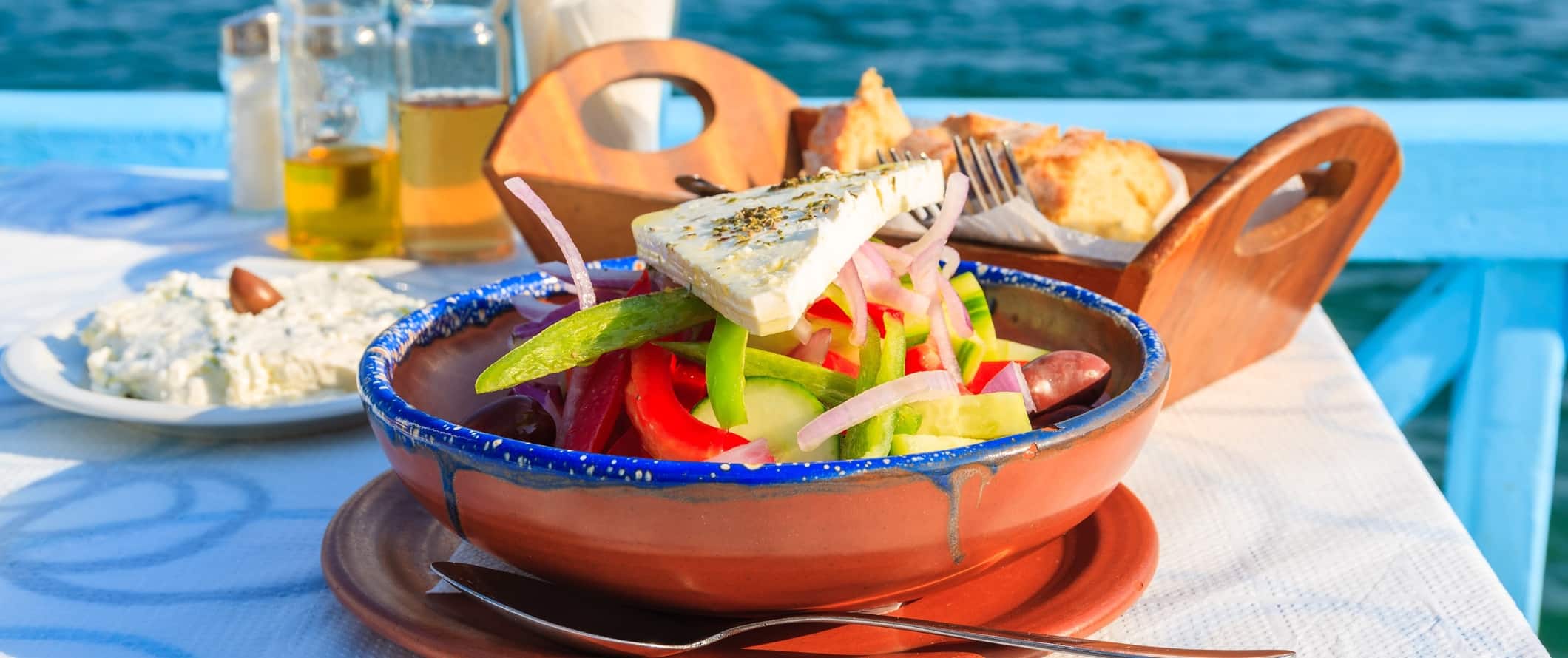
A room in a budget hotel that sleeps two can be found for 40-60 EUR (expect much higher prices — up to 50% higher — during the summer). Amenities at these hotels typically include free Wi-Fi, TV, a private bathroom, AC, and sometimes breakfast as well.
On Airbnb, you can find private rooms for 25-45 EUR in many cities and entire homes (including studio apartments) start at around 50 EUR per night.
Food – Greece is known for its food. Think seasonal vegetables (like olives), seafood, grilled meats, bread, feta cheese, and yogurt — all the staples of a fresh Mediterranean diet. To eat cheap, stick with eating gyros, souvlaki, and kebabs. These cost 3-6 EUR and easily fill you up. If you’re on a budget, you can live off these for as little as 15 EUR per day.
At a casual restaurant that serves traditional cuisine, expect to pay around 8-12 EUR for a main dish like moussaka and about 3-6 EUR for a glass of wine. A Greek salad costs between 6-8 EUR. Fish is more expensive, costing around 17-22 EUR for the catch-of-the-day.
Most restaurants charge for bread. The price is between .50-1.50 EUR. A bottle of water is about 2 EUR.
Fast food (think McDonald’s) costs around 9 EUR for a combo meal. A large pizza costs 8-11 EUR while Indian/Middle Eastern/Chinese food can be found for around 7-8 EUR for a main dish.
If you’re going out for dinner at a traditional taverna, expect to spend between 12-25 EUR depending on how much food you get. After that, the prices go up depending on how fancy the restaurant is!
Beer is 3-5 EUR while a latte/cappuccino is 3-4 EUR. Bottled water from the supermarket is 0.50 EUR.
If you cook your meals, expect to pay 35-50 EUR per week for groceries including pasta, vegetables, chicken, and other basic staples. It’s easy to eat on the cheap in Greece.
Backpacking Greece Suggested Budgets
If you’re backpacking Greece, my suggested budget is 40-60 EUR per day. This assumes you’re staying in a hostel, eating cheap food, cooking some of your meals, doing only free activities like hiking and relaxing on the beach, limiting your drinking, and using local transportation to get around. If you’re visiting the Greek islands or traveling during peak season, expect to spend on the higher amount of that. If you plan on drinking, add 5-15 EUR per day to your budget.
On a mid-range budget of 100-130 EUR per day, you can visit some museums and ruins, stay at a private hostel room or Airbnb, eat out more, enjoy some drinks, take the occasional taxi, and rent a bike or scooter to get around.
If you keep your drinking and costly activities down, you can easily do this closer to 100 EUR per day. On the other hand, if you’re staying on one of the more expensive islands like Mykonos or Santorini and drinking a lot, expect to spend closer to 150-180 EUR.
On a “luxury” budget of 235 EUR or more per day, you can stay in a hotel, eat out anywhere you want, drink as much as you want, do paid tours and more expensive activities (like diving), rent a car to get around, and generally enjoy the finer things in life! This is just the ground floor for luxury though. Expect to pay upwards of 50 EUR more per day on the islands.
Greece Travel Guide: Money-Saving Tips
Greece is affordable. Sure, islands like Santorini and Mykonos are expensive but, for the most part, if you are “keeping it local” you aren’t going to spend a lot of money here. Here are my favorite ways to save money when you travel to Greece:
- Use the Greek salad/bread rule – If the bread cover is .50 EUR or a Greek salad is less than 7 EUR, the restaurant is cheap. If the cover is around 1 EUR and a salad is 7-8.50 EUR, the prices are average. Anything more than that and the place is expensive. Use this rule to figure out how to eat at cheap restaurants.
- Eat super cheap – Gyros and other street snacks only cost a few euros and can keep you full for around 15 EUR per day if you’re on a tight budget.
- Rent a moped – It’s cheaper than a car and a fun way to see the various towns and cities — especially on the islands. You can usually rent a moped for around 15 EUR per day. Just drive carefully as Greek drivers tend to be aggressive.
- Get off the beaten path – Greece is a cheap country and even cheaper when you get away from the touristy islands or popular destinations. Head off the beaten path and you usually see prices drop by 30% or more.
- Book overnight ferries – Greece’s inter-island ferries can get expensive if you are visiting a lot of islands. Taking the overnight ferries can save you up to half off the normal price. Plus, it saves you a night of accommodation. Moreover, if you book the ferries around two months in advance, you can save up to 25% off the cost of your ticket.
- Get a ferry pass – Eurail has a ferry pass that has 4- and 6-trip options. The only caveat is that you can only take Blue Star and Hellenic Seaways ferries. Those tend to be the larger, slower ferries and, depending on the islands, might require you to connect somewhere. You’ll need to research routes in advance to see if the pass is worth it. I would search routes on FerryHopper to see if it works for you.
- Take public transportation – Buses, while sometimes running on inconvenient schedules, are the best way to get around Greece. Taxis are very expensive so minimize their use whenever you can and stick with the buses.
- Visit in the off-season – July and August are the most expensive months, so skip the middle of summer if you’re on a budget. Prices will be significantly cheaper.
- Stay with a local – Couchsurfing is a great way to get a free place to stay and meet locals. There are a ton of hosts throughout the country (I stayed with one in Athens) and it’s my favorite way to get to know the “real” Greece.
- Buy wine at the store – You can buy a great bottle of wine for around 5 EUR at the store. It’s a lot cheaper than drinking at the bar.
- Have an ISIC Card – To save on the cost of admission to museums and other tourist attractions, be sure to present a valid student card. The ISIC is typically accepted in places where a foreign student ID is not.
- Go to museums on their free admission days – Most museums have some days when admission is free. Check the Odysseus Culture website for details as they vary from museum to museum.
- Get combined tickets – Historical attractions in Greece are often priced so that it’s always a better deal to buy a combined ticket. If the sites you are going to offer one, buy it. It will save you money.
- Use points for accommodations – If you have credit card points that can be used for cash, using them to book accommodation can save you a ton of money. This post has more information to help you with the basics so you can start collecting points now and use them on your trip .
- Rent a car – Car rentals can be incredibly cheap in Greece. Prices start at just 20 EUR per day when booked in advance. Drivers need to be at least 21 and have had their license for one year. An International Driving Permit is also required. Discover Cars is an excellent place to find a car for your trip.
- Bring a water bottle – The tap water here is generally safe to drink so bring a reusable water bottle to save money and reduce your plastic use. LifeStraw is my go-to brand as their bottles have built-in filters to ensure your water is always clean and safe.
Where to Stay in Greece
Greece has something for everything and you can often find small family-run operations on the islands. It’s not hard to even find budget accommodations with nice extra like pools either! The specific destination guides have more places but here are some my suggested places to stay in Greece:
- Selina (Athens)
- Athens Hawks Hostel (Athens)
- BedBox (Athens)
- Studio Eleni (Mykonos)
- Caveland (Santorini)
- Bedspot Hostel (Santorini)
- Asterolithos Hotel (Santorini)
- Rethymno Youth Hostel (Crete)
- Intra Muros (Crete)
- The Pink Palace (Corfu)
- Francesco’s (Ios)
- FarOut Beach Club (Ios)
- Castle View Camping and Bungalows (Sparta)
- Lakonia Hotel (Sparta)
How to Get Around Greece
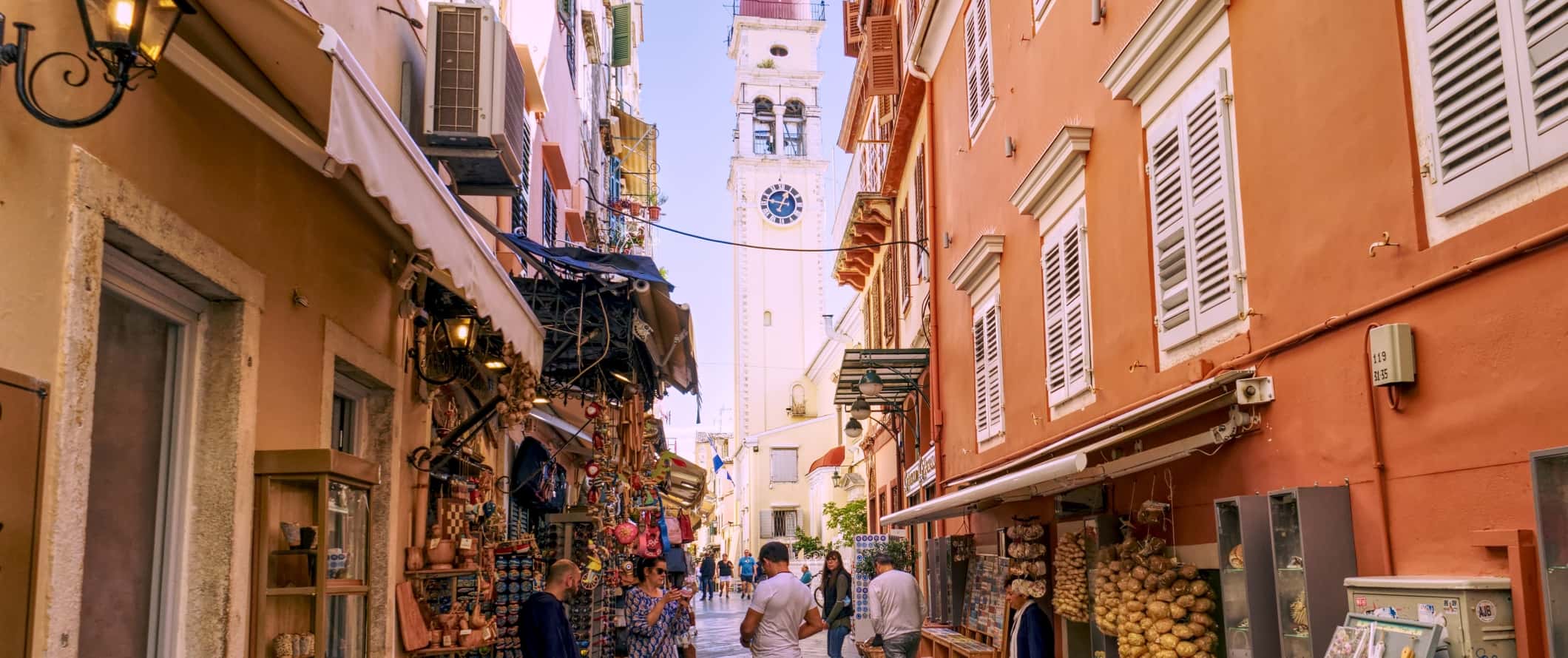
Buses – KTEL is the main bus operator in Greece. You can look up schedules and prices online, but their website is pretty outdated and you’re better off booking tickets at the actual bus station. Getting from Athens to Sparta takes around 3.5 hours and costs around 20 EUR, while Athens to Thessaloniki takes around 5.5 hours and costs around 42 EUR. Thessaloniki to Ioannina takes 3.5 hours and is 24 EUR.
Trains – Train travel in Greece isn’t great. Trains are unreliable and slow and there are only a few routes in the country between Athens and other major cities, like Thessaloniki and Patras. You’re better off driving or taking the bus. However, if you do get the train, a trip from Athens to Thessaloniki takes about 4.5 hours and costs at least 20 EUR.
Ferries – Because Greece has a lot of islands, you have to deal with taking ferries to get around. Expect to spend an average of 35 EUR per trip, though you could spend as little as 10 EUR if the islands are really close together. From Athens, most ferries to the Cyclades Islands start around 40 EUR.
Taking the overnight ferries can save you up to half off the normal price plus save you a night of accommodation so if you’re not in a rush, book those!
There are many different ferry companies, and most are created equal. High speed ferries or catamarans cost a lot more (book in advance). You can research routes and ticket prices using FerryHopper and gtp.gr .
If you’re ok traveling on the slower ferries and your routes match the available routes, the Eurail/Interrail ferry pass is worth considering as you’ll get discounts with this pass. Search routes on FerryHopper to see if it works for you.
Flying – Flying is a quick and affordable way to get around Greece and between islands (though not all islands have airports). A one-way flight from Athens to Santorini or Mykonos takes less than one hour and costs around 25-35 EUR. Flights can dip to as little as 20 EUR when booked in advance.
Scooter/Quad rentals – Renting a scooter or ATV is a really popular way to discover many parts of Greece, particularly the islands. It lets you explore at your own pace and is quite affordable. Scooter rentals cost between 15-25 EUR per day depending on the location and if it is peak season or off-season. ATVs cost around 38-50 EUR per day.
Car rental – Car rentals here are super affordable, starting at just 20 EUR per day for a multi-day rental. Expect manual transmissions. Drivers need an International Driving Permit before renting as well and need to be at least 21 years old. For the best rental car deals, use Discover Cars .
When to Go to Greece
Peak season in Greece is from June-August. Temperatures hover around 33°C (92°F) and popular destinations like Santorini and Mykonos experience a huge influx of visitors. Prices increase during this time as well. But the overall atmosphere and weather are great during this time, so it’s still worth visiting during peak season.
Personally, I think the best time to visit Greece is shoulder season (March-May and September-October). It’s still warm during these times but there aren’t as many crowds and prices are cheaper. It’s also easier to meet locals during this time. There is more rain during this time of year, so pack for that. Overall, it’s a particularly great time to hang out in the Mediterranean.
Winter is from November to February. It gets cold and tourist crowds thin out considerably. There’s quite a bit of rain and temperatures vary quite a bit from north to south, with it sometimes dropping to 11°C (52°F) in some places (Athens sometimes gets snow). Many of the islands — particularly Santorini and Mykonos — almost shut down entirely during the off-season. In short, I’d skip a winter visit unless you’re only planning to visit museums.
How to Stay Safe in Greece
Greece is very safe for backpacking and solo travel. Violent attacks are uncommon. Petty crime is about the worst that could happen to you, specifically pickpocketing in Athens, where it is prevalent. Fortunately, Greek police have really cracked down on perpetrators. Nevertheless, be aware of your surroundings and keep your valuables out of sight when you’re in markets, on busy streets, or when using public transportation.
Solo female travelers should generally feel safe here. However, the standard safety precautions apply (never leave your drink unattended at the bar, never walk home alone intoxicated, etc.). For specific information about a place, check out one of the many incredible solo female travel blogs on the web. They’ll give you tips and advice that I can’t.
You won’t find a lot of travel scams in the country but read this article on common travel scams to avoid so you know what to avoid.
If you go out hiking, always check the weather first. Bring sunscreen, water, and a hat. It can get incredibly hot here!
Be careful when driving as Greek drivers tend to be on the aggressive side and some of the roads aren’t very well maintained.
If you experience an emergency, dial 112 for assistance.
Always trust your gut instinct. Make copies of your personal documents, including your passport and ID.
The most important piece of advice I can offer is to purchase good travel insurance. Travel insurance protects you against illness, injury, theft, and cancellations. It’s comprehensive protection in case anything goes wrong. I never go on a trip without it as I’ve had to use it many times in the past. You can use the widget below to find the policy right for you:
Greece Travel Guide: The Best Booking Resources
These are my favorite companies to use when I travel. They consistently have the best deals, offer world-class customer service and great value, and overall, are better than their competitors. They are the companies I use the most and are always the starting point in my search for travel deals.
- Skyscanner – Skyscanner is my favorite flight search engine. They search small websites and budget airlines that larger search sites tend to miss. They are hands down the number one place to start.
- Hostelworld – This is the best hostel accommodation site out there with the largest inventory, best search interface, and widest availability.
- Booking.com – The best all around booking site that constantly provides the cheapest and lowest rates. They have the widest selection of budget accommodation. In all my tests, they’ve always had the cheapest rates out of all the booking websites.
- HostelPass – This new card gives you up to 20% off hostels throughout Europe. It’s a great way to save money. They’re constantly adding new hostels too. I’ve always wanted something like this and glad it finallt exists.
- Get Your Guide – Get Your Guide is a huge online marketplace for tours and excursions. They have tons of tour options available in cities all around the world, including everything from cooking classes, walking tours, street art lessons, and more!
- The Man in Seat 61 – This website is the ultimate guide to train travel anywhere in the world. They have the most comprehensive information on routes, times, prices, and train conditions. If you are planning a long train journey or some epic train trip, consult this site.
- Rome2Rio – This website allows you to see how to get from point A to point B the best and cheapest way possible. It will give you all the bus, train, plane, or boat routes that can get you there as well as how much they cost.
- FlixBus – Flixbus has routes between 20 European countries with prices starting as low 5 EUR! Their buses include WiFi, electrical outlets, a free checked bag.
- SafetyWing – Safety Wing offers convenient and affordable plans tailored to digital nomads and long-term travelers. They have cheap monthly plans, great customer service, and an easy-to-use claims process that makes it perfect for those on the road.
- LifeStraw – My go-to company for reusable water bottles with built-in filters so you can ensure your drinking water is always clean and safe.
- Unbound Merino – They make lightweight, durable, easy-to-clean travel clothing.
- Top Travel Credit Cards – Points are the best way to cut down travel expenses. Here’s my favorite point earning credit cards so you can get free travel!
- Ferry Hopper – If you’re looking to book your ferries, this website is an easy way to search the various companies, piece together routes, and book your tickets.
- Take Walks – This walking tour company provides inside access to attractions and places you can’t get elsewhere. Their guides rock and they have some of the best and most insightful tours in all of Greece.
Greece Travel Guide: Related Articles
Want more info? Check out all the articles I’ve written on Greece travel and continue planning your trip:
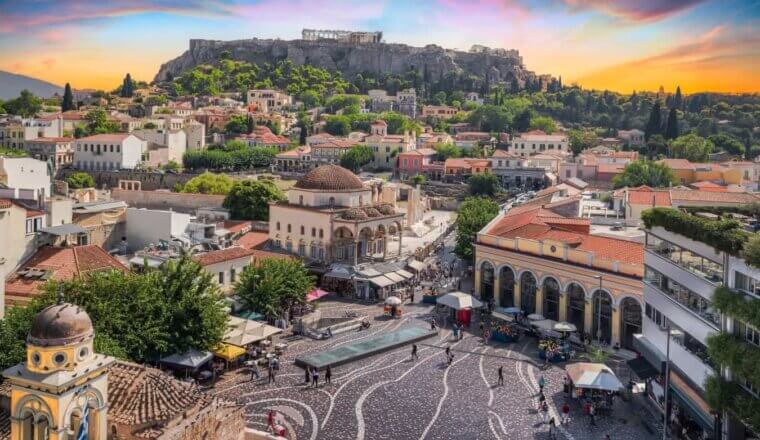
The 6 Best Hotels in Athens
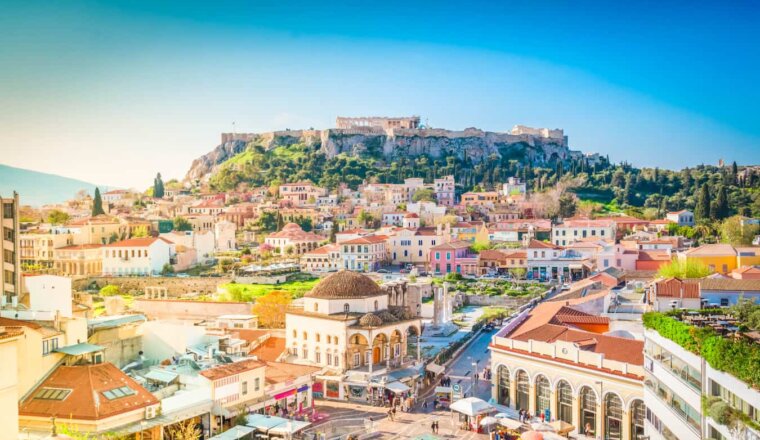
The 6 Best Hostels in Athens
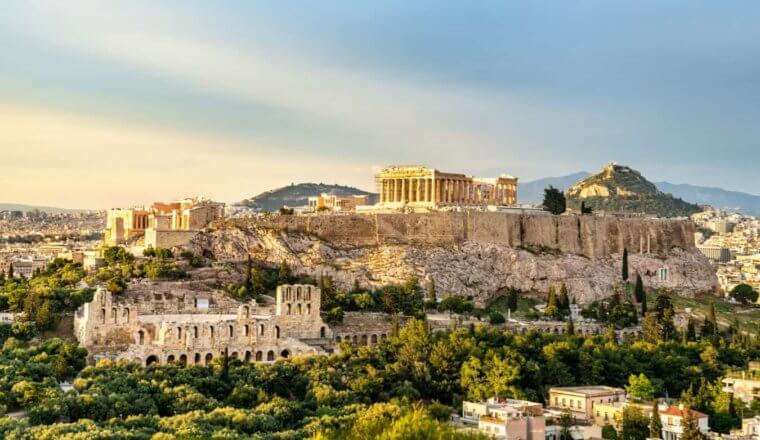
Where to Stay in Athens: The Best Neighborhoods for Your Visit
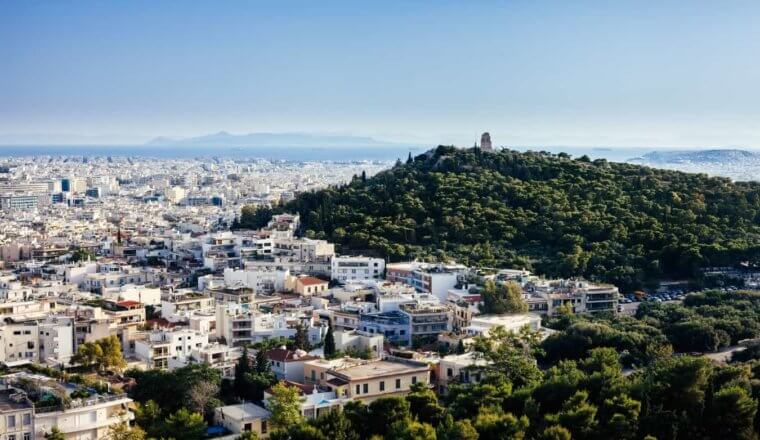
The Best Walking Tours in Athens
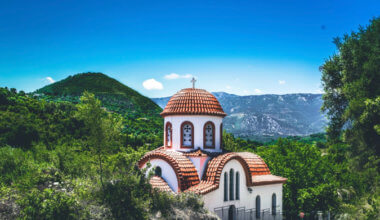
Traveling Greece: How Much Does It Cost?
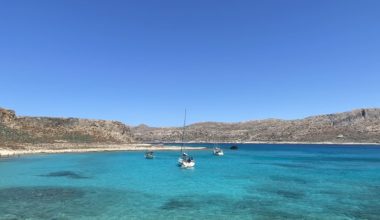
Fulfilling Childhood Dreams in Crete
Get your free travel starter kit.
Enter your email and get planning cheatsheets including a step by step checklist, packing list, tips cheat sheet, and more so you can plan like a pro!

- Where To Stay
- Transportation
- Booking Resources
- Related Blogs

15 Essential Greece Travel Tips: Things to Know For Your First Visit
From golden sandy beaches and dazzling blue skies to mouth-watering food, Greece offers a plethora of charms and irresistible attractions all year long.
What’s more, the country is filled with warm-hearted and hospitable people who will help you enjoy a fabulous escape from your overworked and hectic life.
That said, we wanted to share some essential Greece travel tips with you to help ensure that your trip goes smoothly. We also don’t want you to miss out on any of the classic Greek experiences!
15 Essential Greece Travel Tips
Table of Contents
1. Don’t forget to buy Travel Insurance
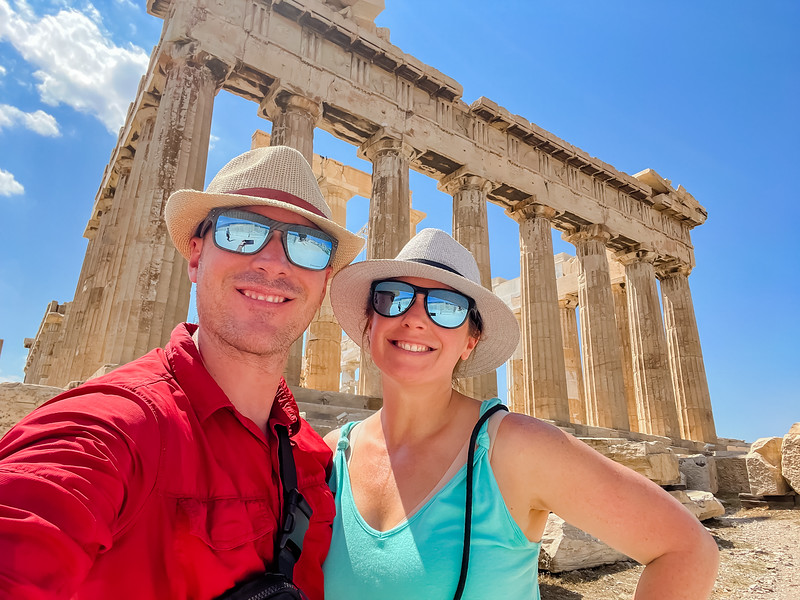
With all that’s been going on in the world, we can’t stress enough how important it is to protect your trip and the money you spent on it. We do not travel without travel insurance.
There are a lot of options out there for insurance, but we use and stand by Allianz Travel Insurance . Full disclosure, we receive financial compensation as ambassadors for their company.
That said, we’ve been purchasing plans through them for the past 7 years and they have never let us down. Canceled flights, delayed flights, lost luggage, and a global pandemic, they’ve been there for us.
We always renew their AllTrips Premier annual plan that covers all of our trips over a 12-month period. If you take more than 2 trips a year, it’s worth considering an annual plan.
For single trips, we recommend looking at their OneTrip Prime or OneTrip Premier plans.
2. Be prepared for the heat during Greece’s summer
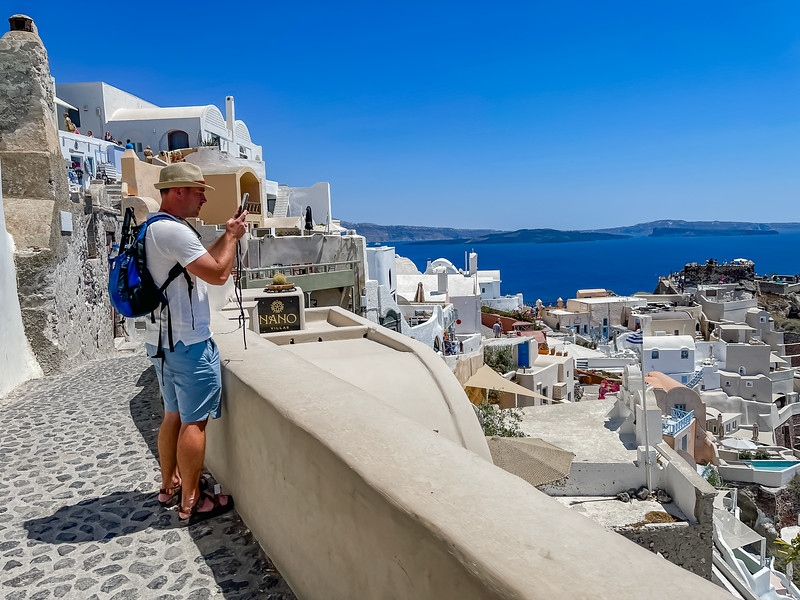
Greece’s summer sun isn’t forgiving for tourists who don’t protect themselves against its scorching heat. Heatstroke and sunburns are common for tourists visiting Greece in the summer. As is dehydration, which commonly presents as a stomach bug.
In Greece, summer temperatures can go beyond 95 F (35 C). On some days, it even rises above 104 F (40 C).
To protect yourself, always wear a wide-brim sun hat, and a pair of sunglasses. Bring a refillable water bottle, and drink frequently to help keep yourself hydrated on your sightseeing and beach trips in Greece.
Sunblock is a must too, especially if you’re hitting the beaches and outdoor archaeological attractions in Greece. And, even if you’re wearing sunblock, try to avoid direct sunlight as often as possible.
Wearing light-colored clothes is one of the most important Greece travel tips. Black is cool, but it’s not ideal in a place as sunny and warm as Greece in summer. Also, opt for skirts, or loose long wide pants, and wide, airy, and long sleeves.
If you’re visiting ancient sites in Greece, do it as early as possible, to avoid walking under the heat of the sun. Afterward, you can stop by a couple of museums, and take advantage of their air-conditioning as the temperature gets hotter during midday.
3. Consider visiting Greece in September or June
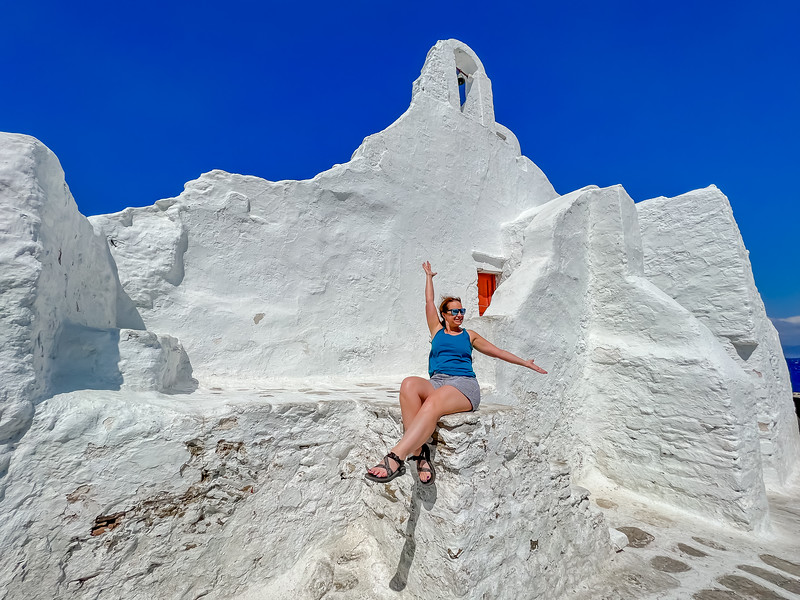
June and September are truly the best months to visit Greece. With lower rates for accommodations and flights, these months are perfect for those who want to save some cash on their Greece vacation.
Last-minute ferry tickets to the Greek islands are easier during these months, too. Don’t get me wrong, June and September are still part of the country’s peak season, but most Greece attractions and places have fewer crowds during these months. The weather is also less windy and cooler.
4. Buy your ferry, airplane, and train passes in advance
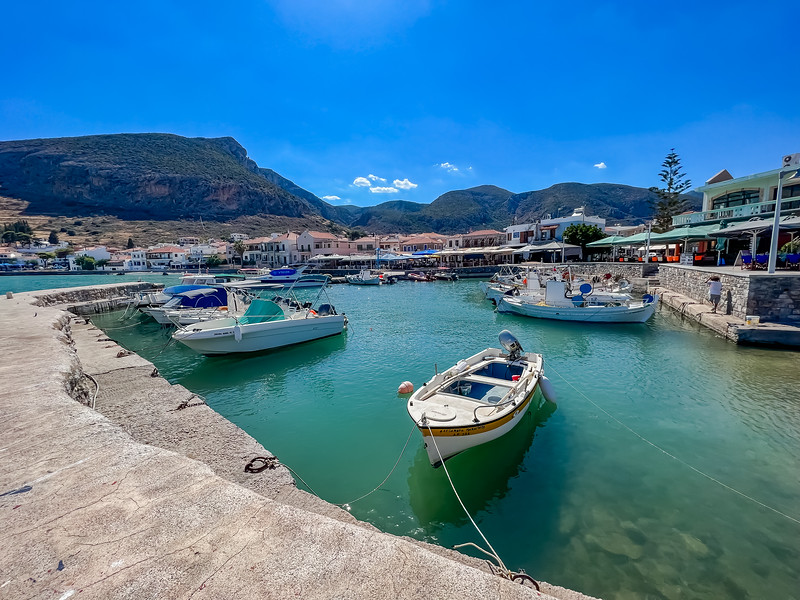
Greece is an extremely popular destination, especially in the summer months. And, that means you should expect tickets for ferries to be sold out weeks in advance, especially if you’re visiting Greece in June, July, August, and September.
Try to plan as far in advance as you can and book all the needed tickets in advance. A lot of Europe travels during the summer holiday season, so it’s not just overseas tourists you’ll be up against when it comes to accommodation, ferries, tours, etc.
5. Spend more than a week in Greece

Despite the country’s small size, it is packed with attractions and places to visit. I honestly think this is one of the most overlooked aspects of Greece travel.
People don’t do enough research and only realize once they are in the country that they don’t have the time they need for everything that interests them. Don’t make this mistake!
Also, don’t try to do too much in a short period of time. If you have less than a week to explore the country, focus on 3 destinations instead of trying to fit in 6 or 7 areas. Travel between the islands takes time and is often met with delays or even cancellations due to the wind.
For a first-time visit to Greece, we’d recommend 2 weeks if you can. This will give you time to visit Athens, a couple of sights on the mainland, and spend a week in the Greek Isles.
6. Learn a little Greek lingo

Learning some Greek phrases will do wonders for your Greece vacation. To me, it’s one of the most important Greece travel tips we can offer.
Not only will it make your vacation more immersive, but Greeks also love it when you can speak a few of their phrases or words.
Since English is prevalent in Greece, learning their lingo isn’t exactly necessary. But, they will have a deeper level of respect for those who show effort in speaking their language.
7. Check out the less explored beaches in Greece

The beaches on Greece’s most popular islands, like Santorini and Mykonos, can be extremely crowded. No matter when you visit.
If you want to steer clear of the crowds, head to the more serene islands, like Astypalaia, Ithaca, Donoussa, Sikinos, Kimolos, Tinos, and Andros.
Furthermore, you can enjoy a road trip along Greece’s coast in South Crete, Evia, Chalkidiki, Pelion, Epirus, and Peloponnese.
8. Consider visiting during an annual festival or event
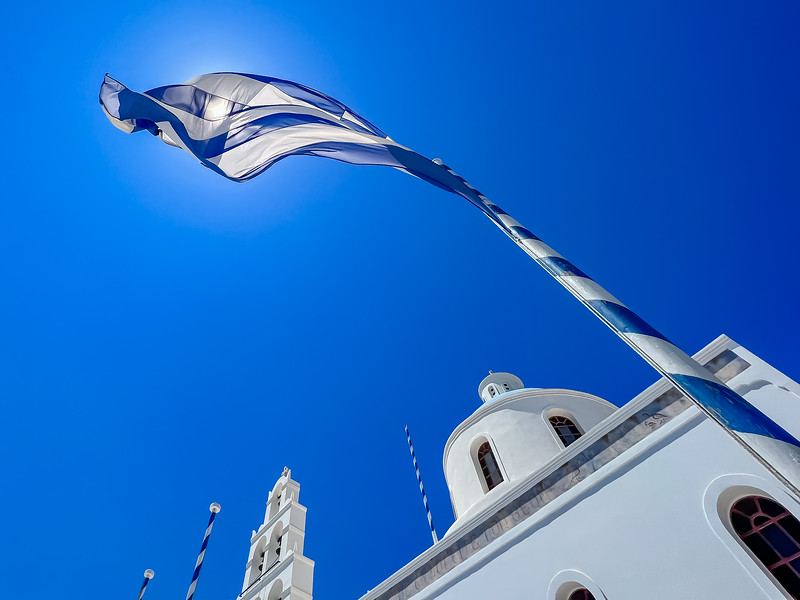
Some of the best and most exciting festivals in Greece take place in summer. The Athens Epidaurus Festival, for one, is one of Europe’s oldest performing arts festivals.
Inaugurated in 1955, this festival features numerous shows of music, dance, and theater. Even better, this festival gives you the chance to enjoy the ancient Greek Epidaurus amphitheater, which is known for its acoustics and is fully operational.
The amphitheater’s acoustics are so phenomenal that performers won’t need a microphone to be heard in the remotest tier.
You can also experience Panyigiria (Greek folk festivals). These folk festivals are scattered throughout the country in summer and are fun social gatherings.
9. Bring a refillable water bottle
Luckily, tap water in Greece is, in general, safe to drink. So, bring a refillable and reusable water bottle to reduce plastic use and save money during your trip.
This practice goes a long way toward being a mindful traveler and engaging in the principles of Leave No Trace while you travel.
10. Greece safety tips to be mindful about
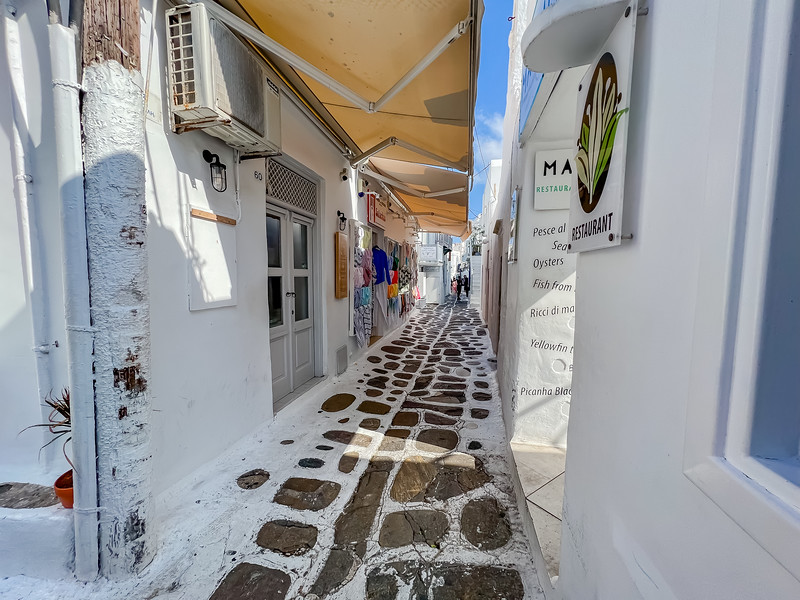
Greece is generally a safe destination, even for female solo travelers. Violent attacks in Greece are a rarity. Still, there are a few important safety tips you should take note of.
Pickpocketing is prevalent, specifically in Athens. Though Greek police have cracked down on some of these perpetrators, you should be aware of your surroundings, and hide your valuables when you’re in busy streets, markets, or using public transportation.
11. Give Athens at least 3 days
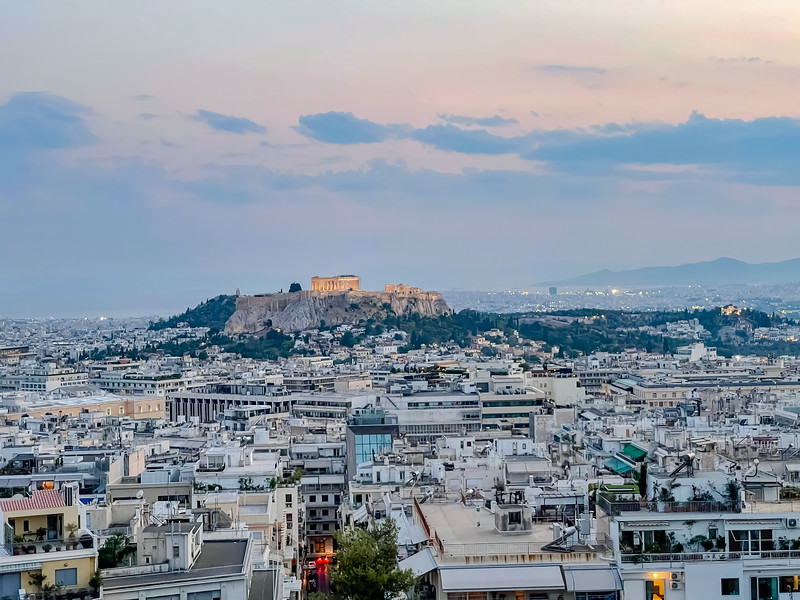
There’s no better place to start a Greece vacation than Athens. Not only is it the main international gateway to Greece, but it also has a host of fantastic, world-class attractions.
You could spend an entire week in this city, hitting known attractions, such as the Ancient Agora and the Parthenon.
Athens is also home to tons of first-rate museums. And, luckily, most of these attractions are air-conditioned, giving summer visitors a respite amid the scorching summer heat.
If it feels too hot outside, step inside the National Historical Museum and the National Archaeological Museum of Greece. You may also stop at Monastiraki’s covered markets, and pick up some Greek souvenirs.
Spending 3 days gives the perfect balance to see the main sites, hit up a few museums, and slow down just enough to enjoy the cafe life.
12. Don’t miss the Greek Islands
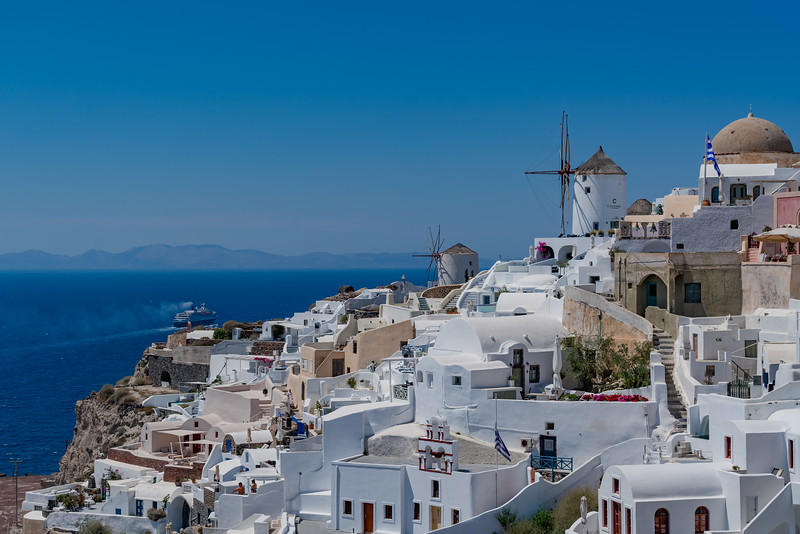
Greece is home to around 1,200 to 6,000 islands. And, these islands are divided into six island groups: the North Aegean, Saronic, the Cyclades, Ionian, Sporades, and the Dodecanese.
No matter what your travel style or interests are, you’ll find a Greek island that suits you. Some islands offer tranquility, peace, and solitude, while others have raucous nightlife and a party ambiance.
While Santorini and Mykonos are the typical poster children for the Greek Islands, and their beautiful, we also love Samos and Patmos for a quieter experience.
13. Eat Greek Salad

One of the most delicious things you can eat while in Greece is a Greek Salad. I am not exaggerating when I say that every time we set foot in Greece, we eat weight in these salads!
Made from plump ripe vine tomatoes, red onions, cucumbers, and green peppers, this salad is topped with a generous brick of Greek feta cheese. It is then sprinkled with a seasoning that contains a variety of herbs, salt, and pepper. It is then dressed with olive oil and vinegar.
It is not only refreshing but insanely delicious!
14. Try a Cappucino Freddo

Or as we like to call it, Greek rocket fuel. Coffee is a rite of passage, and with the heat of the summer months, it’s best to drink it ice cold. Enter the Freddo.
You can have it straight up or with milk – we prefer it with milk. They also offer it sweet or unsweet. But be warned, the sweet option is very sweet.
This national drink can be found pretty much anywhere and we suggest you try it in one of the charming street cafes you’ll find in Athens or on any of the Greek Islands.
15. Bring good shoes
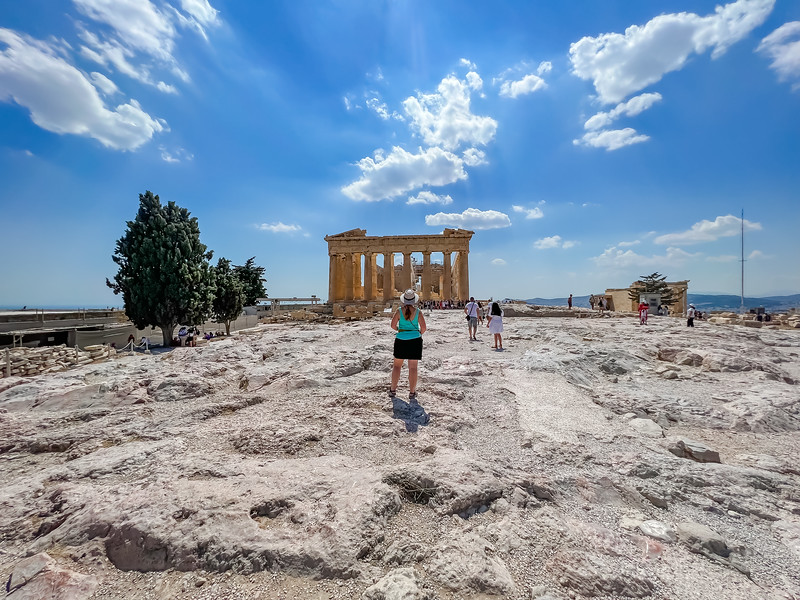
Lastly, and in my opinion, most importantly, make sure you bring solid shoes with you to Greece! You’re going to be exploring ancient ruins and walking on cobblestone streets.
I can’t tell you how many people I saw wearing shoes with heels or slippery soles struggling to enjoy their time in Greece. Not to mention, bad footwear is dangerous and can lead to injury.
We both lived in our Chaco sandals while in Greece. They offer the coolness of a sandal but have an insanely good grip for exploring. They also have comfortable soles and give good support for long days of walking.
This article is sponsored by Allianz Travel Insurance. As ambassadors we receive financial compensation. However, all opinions, stories, advice, and insane love for Iceland are 100% ours, as always.
You might also like:
- The Only Europe Packing List You Need (For Any Season!)
- When is the Best Time to Visit Europe? (Not when you think!)
- 10 Cheapest Places to Travel in Europe
- Train Travel in Europe: Ultimate Eurail Pass Guide
Did you like this story? Share it!
Travel planning resources, about lina stock.
Lina is an award-winning photographer and writer that has been exploring the world since 2001. She has traveled to 100 countries on all 7 continents. Member: SATW, NATJA, ATTA, ITWA
Leave a Comment Cancel reply

Introduction: My Greece Websites
Athens survival guide, greek island guides.

Index of My Greece Websites
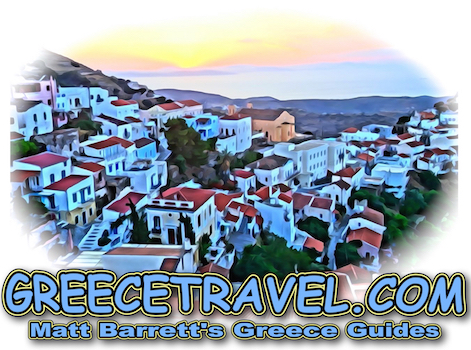
Using Travel Agents in Greece
Greece hotel search and automated booking.
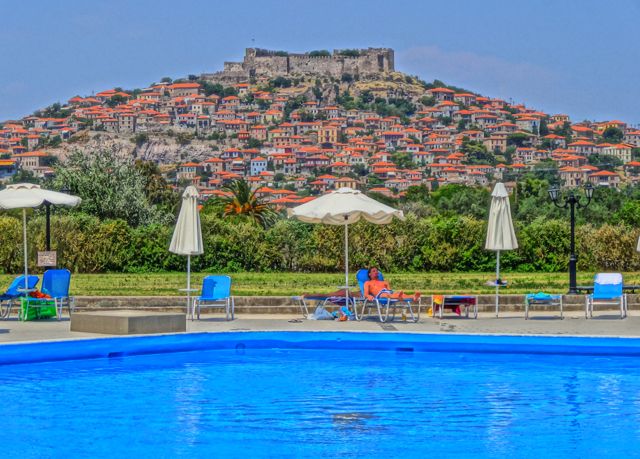
You can also use my old hotel directory at www.hotelsofgreece.com which I completely redid in 2021 while I was waiting for travel to begin again. More on that below. And in 2022 I completed my Book Hotels in Greece Directly page for those who want to avoid a middleman and book directly with hotel and villa owners.
Important Note : There is a lot of information on my website and it is all free to anyone whether you booked through the travel agents, the hotels or Air BnB. But it is the commissions I get from hotel bookings on my affiliate website with Booking.com that supports this website and enable me to continue doing the work I enjoy. So my request to you is that if you are using other sites to book hotels and apartments and using my websites for everything else and are thankful for the information you have received from it please think about donating whatever you can afford so I can continue to be creative. If you are appreciative of all the free information you get on my websites you can send a donation through Paypal
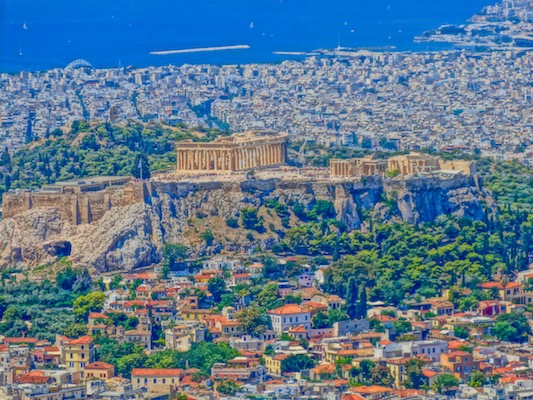
Ferryphobia
This year I got so many e-mails from people nervous about taking a ferry to the islands that I made a page of islands with bridges, islands with very short ferry rides, and places on the mainland that are just like being on the islands. See Greek Islands for Ferry-phobics
My Guide to the Peloponnesos has been rewritten and new photos added with several new towns and a lot more wineries. Matt's Greek Archaeology Page is where I have gathered every page that has anything to do with archaeological sites, museums, history, licensed guides and historical and archaeological tours. Also close to the same topic I have a new index of Licensed Tour Guides and why you should use them. I have also revisited and updated my Santorini Guide , re-wrote and added new photos to my Pelion Guide. If you are a gay or lesbian wondering what the scene is in Athens and the islands the news is all good and you can read about it on Alexia Amvrazi's Gay-Athens/Gay-Greece . Alexia also recently contributed Healing Arts in Athens: Yoga, Pilates, Accupuncture, Shiatsu and more . And with the help of Diana Farr Louis who wrote about Southern Evia and the Joys of Karystos , I finally have a somewhat completed Guide to Evia . Am I forgetting anything? Oh yeah, I added some stuff to Marc Dubin's Guide to Ipiros and I wrote a page about Metsovo which was probably my favorite place of 2018. See Matt's Metsovo Page . And finally... I got together with some of the ladies in my Greece Travel Facebook Group and did a page called Is Greece Safe for Women which focuses on women traveling alone in Greece. And when I discovered that I had somehow become a senior citizen while I was not paying attention I took lemons and made lemonade with Greece Travel for Seniors . For those who are interested in adventure, eco-tourism, hiking, mountain climbing, kayaking, food tours and more, see Trekking, Hiking, Adventure, Cultural and Alternative Travel in Greece which is a work in progress. Finally, for those who are going to Paris on the way to or from Greece I have rewritten and added new photos and a new look to Matt's Paris Guide . Like my Greece pages it is also free of obnoxious pop-up ads and has no spy-ware or cookies.
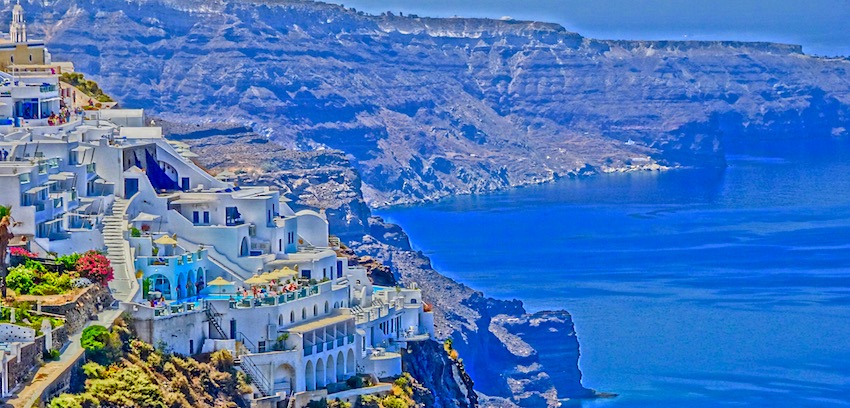
Matt's Best Hotels in Greece
My biggest project of 2020-21 was the facelift and reorganizing I did to Matt's Greek Hotel Guide which I am quite proud of. I basically went through every hotel on every island, village, town and city in Greece, and picked out the best ones, in all categories, with a representative photo (thousands of them) which link to more photos, descriptions, guest reviews, maps and booking information. Some of these can be booked through the travel agents or directly with the hotels, but the vast majority go through my Booking.com affiliate pages. Not only were their prices the best, but in 2020 when Covid caused thousands of cancellations, the people who had booked through these pages had no problems getting refunds because their cards were never charged. (Credit cards are used to save reservations. You actually pay at the hotel.) So please have a look at HotelsofGreece.com and if you are planning on not using a travel agency consider using this site to find and book hotels. Not only will you be getting the best deals at the best hotels but you will also be supporting this website. Remember to save it to your favorite places.
At the end of 2021 I completed my Book Hotels in Greece Directly page made up of hotels, villas, apartments and holiday homes that can be booked directly with the hotels themselves. If you don't want to use a Greek travel agent or you have discovered that many hotels on Booking.com don't have availability, then you can use this page to go directly to the hotel's booking system.
I have also made a page of Budget Hotels in Athens , another for Youth Hostels in Greece and also a page for Campsites in Greece .
New Economical Greece Packages

Aegean Blue: Athens-Naxos-Santorini
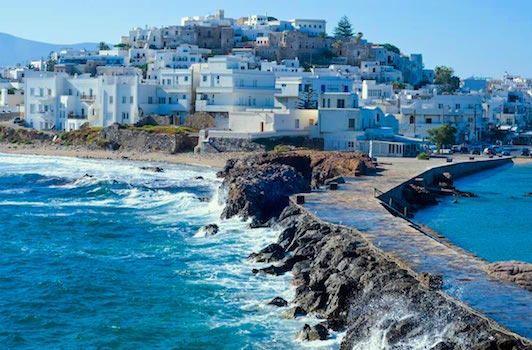
Cabin Charter Cruises of the Greek Islands
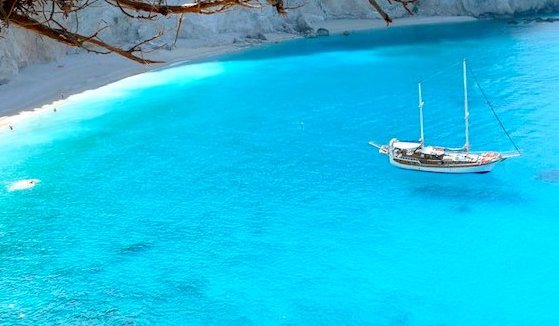
Far from the Maddening Crowd-Stay at the Beach in Athens!
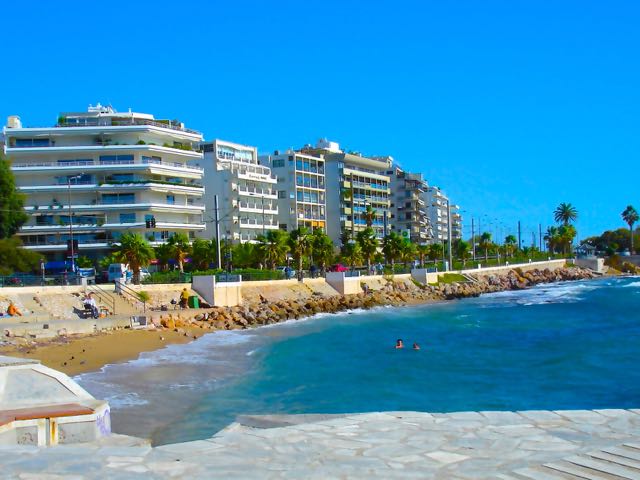
Matt's Greece Travel Blog and Facebook Group
New or updated greece travel information.
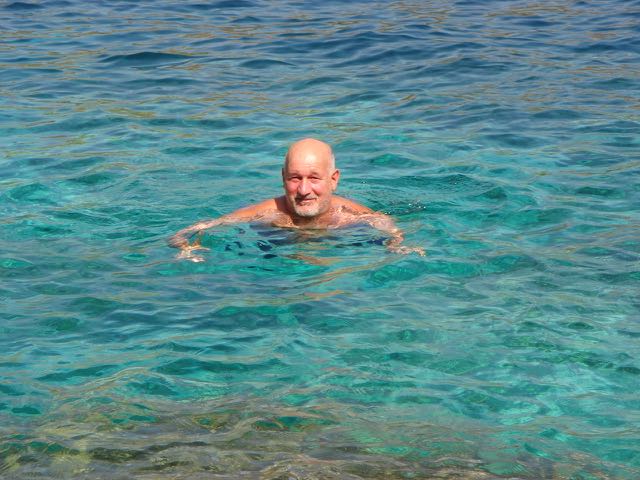
Support the People of Lesvos: Visit Lesvos

Winter in Greece
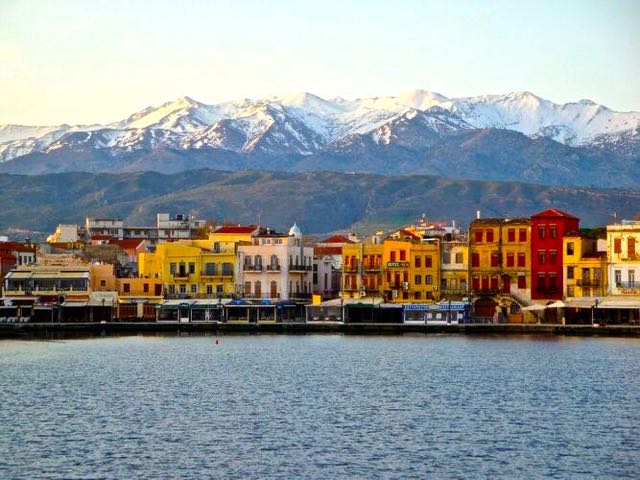
Easter and other Important Holidays in Greece
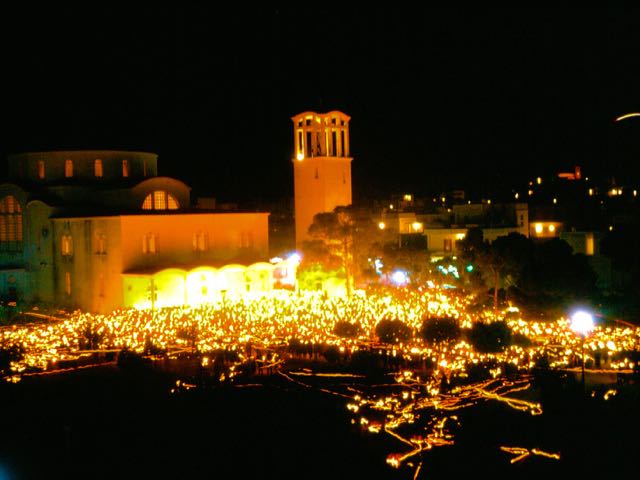
Apokreas is a two week Carnival Season just like New Orleans and Rio that comes to an end with Clean Monday and Lent 40 days before Easter Sunday. This is a great time to be in Greece too with parties and parades and lots of eating and drinking in Athens, Patras, Skyros and just about every island with a decent winter population. 40 days after Orthodox Easter is the Agios Pnevmatos Holiday , similar to our Memorial Day weekend but this is celebrating the Holy Spirit. The hotels and ferries to the islands are usually full that weekend, going there on Friday and returning on Monday or Tuesday. In August everyone leaves Athens for the villages and the islands and on August 15th it is the Celebration of the Panagia (Virgin Mary) and finding hotels or space on the ferries during this period is almost impossible if you wait too long. Many people stay in Athens during this period because even though it is hot, it is practically empty, by Athens standards at least. See also Holidays in Greece
Traveling with Children in Greece

Getting Married or Honeymooning in Greece

Greek Ferry Boats
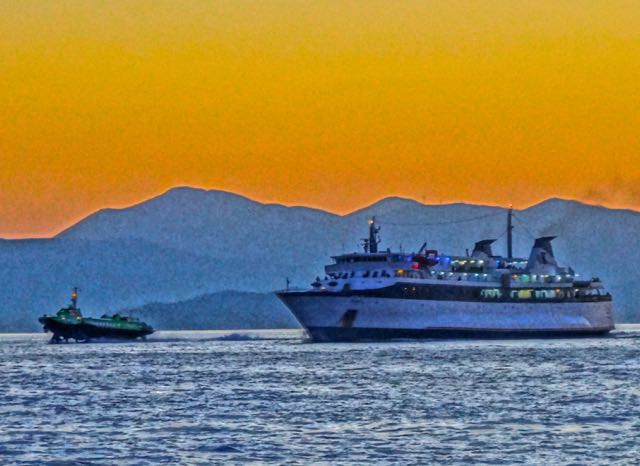
George the Famous Taxi Driver
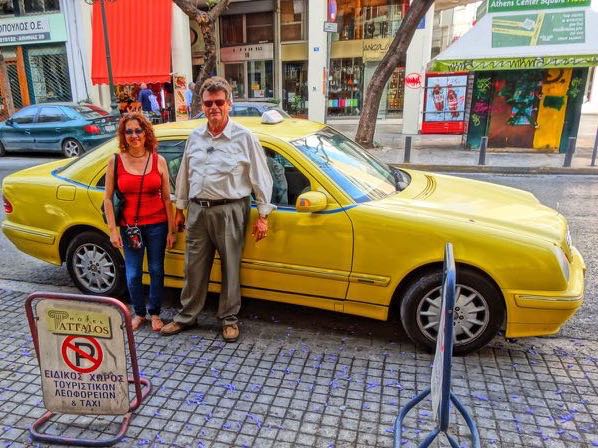
Driving in Greece

Sailing in Greece
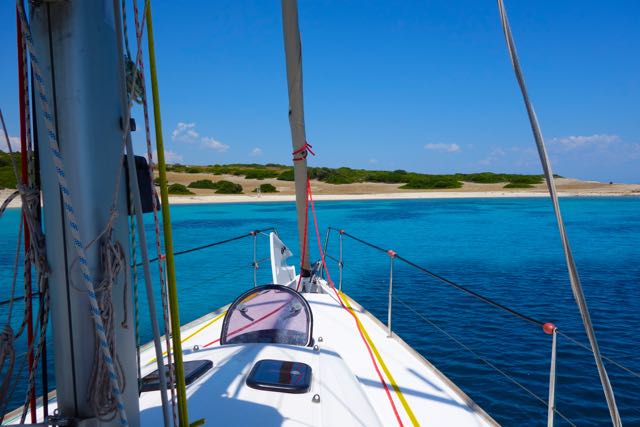
Greece Sail Cruises and Charters
The authentic way to sail the Greek islands with Captain Alex and his comfortable traditional wooden sailing yachts on the Aegean and the Ionian Seas. Rent a cabin or the entire boat for you and your family and friends. These beautiful boats are large enough to accommodate 16 passengers comfortably and offer several itineraries that will allow you to visit the different island chains when they each have the best weather. Or you can charter the entire boat and go wherever you want. See their website.
GM Sailboat and Yacht Charters
Group discounts, suggestions for interesting tours in greece...., fantasy travel's greek island packages, budget tours.
Many people write that they want to go to Greece on a very meager budget, but they are nervous about doing all their hotels, and ferry bookings on their own. They would like to stay in economical hotels but the thought of trying to figure out the metro, buses and taxis scares them a little. So I asked Fantasy Travel to put together a 10-day package for people who think they can't afford to go to Greece. They came up with something pretty special that includes 3 days each in Athens, Mykonos and Santorini, all transfers, breakfast, ferry tickets and a one day tour of Delphi or the one day Saronic cruise for as low as 62 euros a day per person. And everything except lunch and dinner is taken care of. Even entry fees at the archaeological sites are included. See my Budget Travel site and Fantasy Travel's Special Offers Page .
Weekend in Athens
Greece Cartoons: While playing with my camera one day, (a Sony Cybershot DSC-HX20V), I discovered that if I combined two settings I came up with a way to make my photos look like comics and my friends look like comic book characters. At first I began posting them as they were, but then I decided that if I could add word balloons my photos really would be like comics. All I needed was to think of something funny to say in each one, which is not as easy as it sounds. Well you can decide whether or not they are funny by going to my Greece Cartoons Page
Also take a one minute spin with my video All My Friends from Greece . It's a commercial I would make if I were the head of the Greek National Tourist Organization. I wrote the song and sing and play it with some of my rock and roll pals.
11 things I wish I knew before visiting Greece

As the travel industry reopens following COVID-19 shutdowns, TPG suggests that you talk to your doctor, follow health officials' guidance and research local travel restrictions before booking that next trip. We will be here to help you prepare, whether it is next month or next year.
When it comes to deciding where to go next, Greece is a usually a slam dunk. Whether it's a beachy island getaway you're after or an Athens (or perhaps Thessaloniki) city break that blends sightseeing by day with ouzo gulping by night, the mythic Mediterranean country ticks all the right boxes for classic holidays but wait -- there's more. Lots more.
Landing in Athens is the easy bit, but once you're on terra firma you'll find yourself immersed in both an epic history and some rather iconic landscapes, too. How you navigate this richness is largely up to you, but the more you know before you go, the more capably you can decode all those big fat Greek travel mysteries. Keep the following things in mind to help you steer clear of the cliches and make the most out of your experiences in Greece.
1. Don't just make the Acropolis in Athens your priority
Making the Acropolis the focus of a jaunt to Athens is like making a trip to Paris about visiting the Eiffel Tower -- so don't do it. Instead, do like the Athenians do and drink in views of the sacred rock from any number of rooftop bars and restaurants in the vicinity, or better yet wake up to a view of it from your hotel room . And the best views of Athens as a whole are actually from the top of Mount Lycavittos anyway (take the funicular in the Kolonaki neighborhood to the top).
Dodge the tourist crowds marching up to the Parthenon and instead inspect the arguably more evocative ruins at the foot of the Acropolis in the ancient agora area. I'd also suggest skipping the Acropolis Museum and diverting your cultural hours to the National Archaeological Museum across town. It's a bit fusty but still the best museum in Greece. Essential smaller museums include the Benaki Museum and Museum of Cycladic Art, both of which blend ancient artifacts with excellent contemporary exhibitions. If you fancy a Picasso or Van Gogh fix, the brand-new Goulandris museum is a must.

2. Don't just feast on gyro
I've seen this over and over (and over) again: tourists who enjoy a hearty international-style buffet breakfast at their hotel and then opt for a gyro or souvlaki platter for lunch and then again for dinner. Don't get me wrong, authentic Greek gyros are pretty scrumptious and at about three euros each are fiscally attractive dining options too. But Greek gastronomy is more diverse than that and experiencing at least some of it can be a highlight of your trip.
To savor a Greek breakfast staple you'll almost never find at a hotel buffet, try strapatsada, a delectable dish made with eggs (usually scrambled), feta cheese, fresh tomato sauce and a dash of olive oil. One of the best is served at the restaurant of the Acropolis Museum (you don't have to pay for museum admission to eat at the restaurant). For the best seafood, shun the touristy tavernas around the Plaka and head instead to Piraeus, where the seafood is generally cheaper, fresher and comes with sea views, too. Vegan restaurants are also taking off, particularly in Athens.

3. Find your nearest laiki
The spirit of ancient Greece lives on in the weekly laiki, or outdoor fruit and vegetable market that takes place rain or shine throughout the year on Fridays. A visit to a laiki is a great way to get an eyeful and taste of nature's bounty for which Greece is justly famous for. Every neighborhood in Athens has its own laiki and some are bigger and better than others. One of the best is in Pagrati, on Archimidous Street right behind the Panathenaic Stadium (the world's only stadium built entirely of marble). Besides organic produce you'll find plenty of traditional comestibles like extra-virgin olive oil, halva and honey for sale.
4. Greece isn't just for the summer months
One of the greatest Greek myths is that the many islands are strictly for summertime escapes, but that's far from the case. True, many islands rock their Greek summer vibes best in the peak months of July and August (the months that also pull the most crowds), but swimming season heats up as early as May and in many places doesn't wind down until November. Little islands near Athens like Hydra and Spetses are worth visiting even in winter and big islands like Crete have plenty of cultural attractions and historic sites to keep you busy throughout the year.

5. Don't take a three-island day cruise
When you are in the Piraeus port you'll see many advertisements for three-island cruises that promise you a mini-odyssey to a trio of islands close to Athens. Generally these are Aegina, Hydra and Poros. Focus on one island instead. Packing three islands into a single day trip is something that Greeks themselves would never do, it diminishes both the quantity and quality of your time. If you are really into ancient ruins, spend time on Aegina. For dramatic scenery, Hydra's the spot. Among all the islands within an easy ferry journey from Athens/Piraeus, Poros easily qualifies as the quiet charmer where you could linger for hours over Greek coffees and delightful harbor views.
6. Greek islands aren't just for hitting the beach
Greece has some 6,000 islands, of which about 227 are inhabited. That represents a lot of geographical diversity. Some islands have gorgeous beaches -- think Mykonos, Kefalonia and Corfu -- while others have a mix of decent beaches and landscapes that offer up the possibility of more varied activities. Kalymnos is the place for rock climbing and bouldering, Paros is ideal for windsurfing and kite surfing, Sifnos and Tinos (and to a certain extent Santorini) are much favored by foodies and so forth. The shoulder season, April to June and also October, is often ideal for these beyond-the-beach pursuits.
7. Skipping Santorini is not a sin
Two essential Santorini travel facts: the first is that yes, it's a geologically unique island and the second is that yes, you should probably also skip it. How dare I? Well, due to far too many cruise ships disgorging way too many people onto such a small place, the wisp of an island has degenerated into a sort of hyper-sanitized Selfie Island and really, how much fun is that? The views over the volcanic caldera are cool as are the Minoan ruins at Akrotiri but the beaches aren't great and the good hotels and restaurants tend to be overpriced.
So check it out if you must but make sure you avoid the months of June, July, August and now all of September too. Other Aegean islands beckon with their own brand of gorgeousness, whether that be breezy Andros, volcanic Milos and myriad others.
Read more: Which European countries don't use the euro currency and why?

8. You should visit Greece during Easter
Greeks celebrate Easter with a fervor most Europeans reserve for Christmas -- and the enthusiasm has a distinctly noncommercial flavor at that. The Greek Orthodox Church still holds sway over many aspects of contemporary Greek life and Easter week is when some of the more celebratory aspects really kick in, with all manner of feasts and public processions that begin on Palm Sunday and vary from location to location but that are particularly colorful on islands like Corfu.
9. Think of Crete as a separate country
Because in many respects it is. Starting with size: Crete is 160 miles from one end to the other and is the fifth largest island in the Mediterranean Sea. That means it's difficult to see it all in a single take, nor should you try. The landscapes are stunningly varied and unlike the more stereotypical Greek island getaways the Cretan economy is not wholly dependent on tourism: historic cities like Heraklion and Chania also have a youthful vibrancy that's hard to resist.
There are numerous nonstop flights from Crete's two major airports in Heraklion and Chania in the peak summer season and year-round connections from Athens. From Athens/Piraeus there are also daily ferry departures, they typically leave around 9 p.m. and arrive in Crete at 6 a.m. While these ferries resemble small cruise ships with plenty of seating options (including cabins), a flight on Aegean will you get from Athens to Crete in just about an hour.

10. Remember the mainland
Greece is more than Athens and the islands. The region of which Athens is a part, Attica, is home to some of the most important sites in antiquity from Marathon to Cape Sounio and the Temple of Poseidon. South and east of the Greek capital, the Peloponnese offers a dramatically chiseled coastline and plenty of historical gems too, like the city of Nafplion -- the first capital of Greece -- and the remarkable fortress isle of Monemvasia. The northern city of Thessaloniki, named after Alexander the Great's half-sister, is worth a detour for its history, museums and excellent restaurants.

11. You needn't spend a fortune to have a blast in Mykonos
Stick around Greece for any length of time and you're bound to hear Greeks bemoan how Mykonos has become an enclave affordable only for the likes of Arab princes and their consorts (who may or may not include Lindsay Lohan). While there is some truth to that, don't let it put you off a visit because the cosmopolitan Mykonos vibe is something you won't find anywhere else. The small Cycladic island has some of the best beaches, restaurants, hotels and nightclubs in the Mediterranean. July and August are the months to avoid, but if you can manage to hit Mykonos in June or September, you'll probably have a great time and without necessarily breaking the bank.

Bottom line
Greece is a country with attractions that are so iconic everybody thinks they already know the place and to varying degrees maybe they do, but not unlike Madonna, there is a lot more to her than meets the eye. It's when you avoid insisting on the cliches -- you probably don't need a whole day to snap selfies at the Acropolis or an overpriced seafood lunch in the touristy center of Mykonos town -- that the colors of Greece really begin to reveal themselves. And if you can avoid those peak crowded months of July (especially the second half) and August you'll very likely have a better holiday experience in Greece overall.
Cookies on GOV.UK
We use some essential cookies to make this website work.
We’d like to set additional cookies to understand how you use GOV.UK, remember your settings and improve government services.
We also use cookies set by other sites to help us deliver content from their services.
You have accepted additional cookies. You can change your cookie settings at any time.
You have rejected additional cookies. You can change your cookie settings at any time.
Register to vote Register by 18 June to vote in the General Election on 4 July.
- Passports, travel and living abroad
- Travel abroad
- Foreign travel advice
Warnings and insurance
The Foreign, Commonwealth & Development Office ( FCDO ) provides advice about risks of travel to help British nationals make informed decisions. Find out more about FCDO travel advice .
Before you travel
No travel can be guaranteed safe. Read all the advice in this guide as well as support for British nationals abroad which includes:
- advice on preparing for travel abroad and reducing risks
- information for women, LGBT+ and disabled travellers
Follow and contact FCDO travel on X (formerly known as Twitter), Facebook and Instagram . You can also sign up to get email notifications when this advice is updated.
Travel insurance
If you choose to travel, research your destinations and get appropriate travel insurance . Insurance should cover your itinerary, planned activities and expenses in an emergency.
Related content
Is this page useful.
- Yes this page is useful
- No this page is not useful
Help us improve GOV.UK
Don’t include personal or financial information like your National Insurance number or credit card details.
To help us improve GOV.UK, we’d like to know more about your visit today. Please fill in this survey (opens in a new tab) .
7 Tourist Traps to Avoid in Greek Islands And How To Avoid Them
By: Author Ruben Arribas
Posted on June 9, 2024
Categories Greece
Greek Islands is one of the most popular destinations in the world and we will tell you the tourist traps to avoid in Greek Islands for your next trip.
Visiting the Greek Islands can be a dream come true, but certain tourist traps can diminish the experience. Here are some common ones to watch out for and tips on how to avoid them.
By following these tips, you can enjoy the beauty and culture of the Greek Islands while avoiding the common tourist pitfalls.
Read here Things to know before going to Santorini , best Greece sim card for tourist and things to know before visiting Greece !
Table of Contents
BOOK YOUR TRAVEL INSURANCE
Two of our favorite travel insurance: Heymondo Vs Safetwing cheapest travel Insurance . You can get for $135 USD your Heymondo Travel Insurance with Heymondo discount code valid for 90 days. Read our full comparison of Genki vs Safetywing Travel Insurance Review and the comparison Heymondo vs Genki
General Tips for Avoiding Tourist Traps
Visiting in the shoulder seasons (spring and fall) can help avoid the crowds and enjoy a more authentic experience.
Opt for accommodations in less touristy areas. For example, stay in the village of Pyrgos in Santorini instead of Oia.
Instead of expensive taxis, use local buses or rent a scooter to explore the islands.
Ask locals for recommendations on where to eat, visit, and shop. They can often point you to hidden gems away from the tourist traps.
CLICK HERE TO BOOK YOUR ACCOMMODATION
Tourist Traps to Avoid in Greek Islands
1. overcrowded beaches in mykonos.
Trap: Beaches like Paradise and Super Paradise can be extremely crowded, with overpriced sunbeds and drinks. How to Avoid : Visit lesser-known beaches such as Agios Sostis or Fokos. These offer a more tranquil experience and are often frequented by locals.
2. Santorini’s Oia at Sunset
Trap: While Oia offers breathtaking sunsets, it is also packed with tourists, making the experience less enjoyable. How to Avoid : Opt for a sunset view from Pyrgos or the Akrotiri lighthouse. These spots provide equally stunning views with fewer crowds.
3. Expensive Dining in Tourist Hotspots
Trap: Restaurants in highly touristic areas like Fira in Santorini or Little Venice in Mykonos often charge exorbitant prices for mediocre food. How to Avoid: Dine where the locals eat. In Santorini, try Metaxi Mas in Exo Gonia or Taverna Katina in Amoudi Bay. In Mykonos, head to Kiki’s Tavern at Agios Sostis Beach for a more authentic and reasonably priced meal.
4. Touristy Souvenir Shops
Trap: Souvenir shops in main tourist areas often sell overpriced and generic items. How to Avoid: Shop in less touristy villages. For example, in Santorini, visit the smaller shops in Emporio or Pyrgos for unique and authentic souvenirs.
5. Expensive Boat Tours
Trap: Organized boat tours can be costly, especially those advertised heavily in tourist areas. How to Avoid: Consider renting a small boat with friends or joining a local fisherman’s tour. In Paros, for example, you can find local fishermen who offer private and more affordable boat trips.
6. Overpriced Cocktails and Bars
Trap: Bars in famous nightlife spots like Mykonos Town or Santorini’s Fira often charge a premium for drinks. How to Avoid: Enjoy a drink at more laid-back venues. In Mykonos, visit Jackie O’ Beach Club for a fun but more relaxed atmosphere. In Santorini, head to PK Cocktail Bar in Fira for beautiful views without the high price tag.
7. Tourist Crowds at Archaeological Sites
Trap: Popular sites like the Acropolis of Lindos in Rhodes can be swamped with tourists, especially in peak season. How to Avoid: Visit early in the morning or late in the afternoon to avoid the peak crowds. Alternatively, explore lesser-known sites such as the ancient city of Kamiros in Rhodes.
How To Avoid Tourist Traps in the Greek Islands
1. travel off-season.
Why: Visiting during the shoulder seasons (spring and fall) can help you avoid the large crowds and inflated prices common in peak summer months. How: Plan your trip for late April to early June or September to early October. The weather is still pleasant, and the islands are less crowded.
2. Stay in Less Touristy Areas
Why: Accommodations in popular areas like Santorini’s Oia or Mykonos Town are often overpriced and crowded. How: Opt for villages like Pyrgos in Santorini, Ano Mera in Mykonos, or Apollonia in Sifnos. These areas offer a more authentic experience and are typically quieter and more affordable.
CLICK HERE TO BOOK YOUR ACCOMMODATION IN SANTORINI WITH BOOKING AND AGODA!
3. Eat Where the Locals Eat
Why: Tourist-focused restaurants often serve overpriced and lower-quality food. How: Look for tavernas and restaurants that are filled with locals. In Santorini, try Metaxi Mas in Exo Gonia. In Mykonos, visit To Maereio in Mykonos Town for an authentic dining experience.
4. Use Public Transportation
Why: Taxis and private transfers can be expensive and often take longer due to traffic. How: Utilize local buses, which are reliable and cover most parts of the islands. Alternatively, rent a scooter or ATV for more flexibility and lower costs.
5. Explore Lesser-Known Beaches
Why: Popular beaches like Paradise Beach in Mykonos and Red Beach in Santorini can be overcrowded and expensive. How: Seek out less popular beaches such as Agios Sostis and Fokos Beach in Mykonos, or Vlychada and Koloumpos Beach in Santorini. These spots are often quieter and more picturesque.
6. Avoid Tourist Souvenir Shops
Why: These shops often sell generic, overpriced items. How: Purchase souvenirs from local artisans or in less touristy areas. For unique, handmade items, visit local markets and small boutiques in villages like Emporio in Santorini or Halki in Naxos.
7. Book Local Tours and Experiences
Why: Mass-market tours can be overpriced and crowded. How: Opt for tours led by local guides or smaller companies. They often provide more personalized and insightful experiences. Websites like Withlocals or Airbnb Experiences can be good resources for finding these tours.
8. Be Skeptical of “Must-See” Attractions
Why: Some highly advertised attractions may not live up to the hype and can be crowded and overpriced. How: Research and consider less advertised but equally interesting sites. For example, instead of the crowded Akrotiri ruins in Santorini, visit the Ancient Thera site, which offers fewer crowds and stunning views.
9. Use Apps and Online Resources
Why: They provide up-to-date information and reviews from other travelers. How: Use apps like Google Maps for finding local favorite spots and TripAdvisor for reviews and recommendations. Local travel blogs and forums can also offer valuable insider tips.
10. Engage with Locals
Why: Locals can provide the best tips and recommendations for avoiding tourist traps. How: Strike up conversations with locals in cafes, shops, or your accommodation. They can often point you to the best hidden gems and away from the touristy areas
About the Author : Ruben , co-founder of Gamintraveler.com since 2014, is a seasoned traveler from Spain who has explored over 100 countries since 2009. Known for his extensive travel adventures across South America, Europe, the US, Australia, New Zealand, Asia, and Africa, Ruben combines his passion for adventurous yet sustainable living with his love for cycling, highlighted by his remarkable 5-month bicycle journey from Spain to Norway. He currently resides in Spain, where he continues sharing his travel experiences with his partner, Rachel, and their son, Han.
- Skip to main content
- Skip to "About this site"
Language selection
Search travel.gc.ca.
Help us to improve our website. Take our survey !
Travel advice and advisories by destination
COVID-19: travel health notice for all travellers
The Government of Canada’s official source of travel information and advice, the Travel Advice and Advisories help you to make informed decisions and travel safely while you are outside Canada. Check the page for your destination often, because safety and security conditions may change. See Travel Advice and Advisories – FAQ for more information.
Where are you going?
Take normal security precautions
Exercise a high degree of caution
Avoid non-essential travel
Avoid all travel
Travel advice from other countries
Travel advice is also provided by the governments of Australia , New Zealand , the United Kingdom and the United States .
Risk Levels
take normal security precautions.
Take similar precautions to those you would take in Canada.
Exercise a high degree of caution
There are certain safety and security concerns or the situation could change quickly. Be very cautious at all times, monitor local media and follow the instructions of local authorities.
IMPORTANT: The two levels below are official Government of Canada Travel Advisories and are issued when the safety and security of Canadians travelling or living in the country or region may be at risk.
Avoid non-essential travel
Your safety and security could be at risk. You should think about your need to travel to this country, territory or region based on family or business requirements, knowledge of or familiarity with the region, and other factors. If you are already there, think about whether you really need to be there. If you do not need to be there, you should think about leaving.
Avoid all travel
You should not travel to this country, territory or region. Your personal safety and security are at great risk. If you are already there, you should think about leaving if it is safe to do so.
Travel Stories

Jun 8, 2024 • 7 min read
Combining innovation with tradition and a global culmination of flavors and trends, Dubai has some of the best dining options in the region.

Jun 7, 2024 • 9 min read
Two of our editors take us on the ultimate NYC summer walk through Manhattan.

Follow Lonely Planet's Laura Motta on her solo road trip from Las Vegas to Nevada's Great Basin National Park

Jun 7, 2024 • 8 min read
Cruising down a quiet river, surrounded by scenic views is an ideal way to see Europe. Here are the 10 best places for a European river cruise.

Jun 7, 2024 • 11 min read
Nothing says summer in the USA like heading to the lake. We asked our writers to share their favorite lakes in the country.

Jun 7, 2024 • 12 min read
Look beyond the French capital's most famous sights and you'll discover many free things to do in Paris – and get a local's perspective on the city too.

Jun 7, 2024 • 10 min read
Like any heavily touristed destination, it pays to research before you go. Here's an insider's guide to planning the ultimate trip to Mallorca, Spain.

Jun 7, 2024 • 7 min read
You don’t have to spend a fortune to enjoy the glamour of Nice. Beach-going, people-watching, architecture-viewing and more, all to be enjoyed for free.

Wander through a prehistoric wonderland of colorful rock formations, fossils, and prairies in the Badlands National Park in South Dakota.

Jun 6, 2024 • 6 min read
Shave ice is a summery treat served with colorful syrupy toppings and sold at shave ice shops across the islands of Hawaii. You won't want to miss it.

Jun 6, 2024 • 5 min read
Kona coffee is some of the world’s best, and a trip to the Big Island is incomplete without sampling its premier product.

Jun 6, 2024 • 8 min read
Mallorca’s capital is quickly becoming one of the hottest cities in the Med for food.

Nepal is not expensive, and there’s plenty of value to be had for visitors that follow these budget tips, along with a guide to daily costs.

From glorious stretches of white sand to secluded rocky coves, here are Mallorca's best beaches.

Choose the right time for your visit to Ecuador with this seasonal guide.

Jun 6, 2024 • 7 min read
Beautiful beaches and natural wonderlands drenched in southern charm – Coastal Georgia's islands have something for everyone.

The queen of the French Riviera, Nice drips elegance and panache. Here are some things to know before you arrive to help you fit in with the glitterati.

Jun 5, 2024 • 8 min read
Andean flavors, coastal seafood, Afro-Ecuadorian recipes and Spanish influences converge to create an innovative food-and-drink scene in Ecuador.

Jun 5, 2024 • 7 min read
No matter your hiking ability, Alaska's diverse trails provide plenty of opportunities for recreation.

Plan a summer adventure to Hilton Head, Folly Beach and other South Carolina Sea Islands with this guide.

Jun 5, 2024 • 11 min read
Plan your summer vacation to Wisconsin's Door County with our top tips.

Jun 5, 2024 • 5 min read
Explore Boston by bike with this guide to the city's best off-road routes, its local bike-share program and top safety tips.

IMAGES
VIDEO
COMMENTS
How to travel around the Greek islands ... Tips & Advice. If you're planning a trip to Greece in 2024, visit these 10 top destinations. Mar 4, 2024 • 6 min read. Beaches. 20 of Europe's most stunning beaches to explore in 2024. Feb 26, 2024 • 8 min read. Read more articles.
Next up on this 14-day Greek island-hopping itinerary is Paros, a personal favorite of mine! To get to Paros from Naxos, you'll grab a short 30 minute ferry ride (if you take the speed boat). Prices for the Paros-Naxos ferry range between €15-35, depending on the type of ferry. To see prices for your specific dates, use the handy ...
Planning a trip to the Greek islands can be intimidating, even for the most seasoned travelers. With more than 200 inhabited isles (and about 6,000 islands and islets in total), the magnitude of ...
Day 8 - Ios. If you're lucky enough to be continuing on for a 10 days in Greece itinerary beyond the Athens-Mykonos-Santorini route, then today it's only a short 40-minute ferry ride to the nearby island of Ios. A relatively unknown option compared to the likes of Mykonos and Santorini, Ios is famous in its own right.
Having said that, Greece is known for its laid-back attitude, and it's worth emulating this while island-hopping. Ferry schedules are always subject to change, even pre-booked and pre-paid journeys. Anything from windy weather to worker strikes can mean delay or cancellation at short notice.
The island group that is the most southern closest to Turkey is the Dodecanese group of islands. Here you will find that Rhodes is the largest Greek island. Other islands in this group include Astypalaia, Kalymnos, Karpathos, Kasos, Kastellorizo, Kos, Leros, Nisyros, Patmos, Rhodes, Symi, Tilos, and Chalki.
This Greek Islands travel guide will primarily focus on The Cyclades Islands, but it will also have information relevant for those planning trips to the whole Greek Archipelago, which spans 6,000 islands and takes up 7,500 km of the country's 16,000 km coastline.
A few tips on ferry travel in Greece. Ferries are the most common mode of transportation between the Greek islands. There is a huge network of ferries, some of which run year-round. Others are seasonal and run in spring, summer and autumn. Itineraries for most ferries are announced a few months in advance.
Costs of Traveling in Greece. Travel on a budget in Greece, from $580 − $1000 USD weekly per person, mid-range $1210 − $2670 USD, and high-end from $2590 − $4120 USD. However, costs depend on factors like accommodation, transportation, and activities. We did not include flights. Check flight prices here.
Crete, Corfu or Kefallonia: find the perfect Greek island for you. Sep 16, 2021 • 5 min read. The Greek islands offer deserted beaches, active volcanoes and everything in between. Let us help you decide on the perfect island paradise for you. Beaches.
Get inspired with Rick Steves' recommended places to go and things to do, with tips, photos, videos, and travel information on the Greek Islands. For many people, Greece is synonymous with islands. If you need a vacation from your busy mainland Greek vacation, the islands exert an irresistible pull. ... Greece Travel Tips I (28:24) Greek ...
Here's a quick guide to some of the best Greek islands that offer visitors unique experiences! The Best Beaches: Naxos and Paros. The Best for Natural Beauty: Crete. The Best for Low-Key Luxury: Antiparos. The Most Charming: Hydra. The Most Romantic: Santorini. The Best for College-Aged Partying: Ios. The Best for 20 to 30-Something Partying ...
The Ionian Islands. The Argosaronic Islands. The Sporades. The Dodecanese. The North Aegean Islands. Crete and Cretan islands. Evia and surrounding islands. The size of the islands can vary a lot. Crete is the biggest Greek island, with an area of 8,336 km2 and a population of 635,000 people.
The plugs, sockets and voltage in Greece are different to many areas of the world. Unless you're coming from somewhere with European appliances you'll need a travel adapter for your device plugs. You might also need a converter so that your items work on the Greek voltage and electrical frequency.
Greek Islands Travel Tips - Authentic content - Greek Island Guru. Aegina. The hidden jewel of an island just 35′ from Athens. Filled with fascinating ancient sites, religious landmarks, hikes and more, Aegina is emerging as a top destination for day-trips from Athens and even for extended vacations. A favorite among Greeks.
This is one of the most popular ferry travel routes on the Greek islands. Rhodes To Crete. The trip from Rhodes to Crete can be quite long on a ferry. That's why most travelers choose to fly from Heraklion, Crete's capital. The flying time is about 50 minutes, and prices tend to be considerably high, so booking in advance is a good idea ...
Accommodation - Depending on the area of Greece you are traveling to, hostels start at 15-20 EUR for dorms in the off-peak season, though these can rise to 35-45 EUR in peak season in more expensive destinations. Expect anything from 75-120 EUR per night for private rooms (less in Athens and less popular spots, more on expensive islands like Mykonos or Santorini).
Don't throw the Toilet paper in the trash. This is one of the most important Greece travel tips to know! Next to every toilet in Greece, you'll find a small trash can, and likely a sign saying not to throw anything in the toilet. That sign literally means don't throw anything in the toilet - even toilet paper.
4. Buy your ferry, airplane, and train passes in advance. Greece is an extremely popular destination, especially in the summer months. And, that means you should expect tickets for ferries to be sold out weeks in advance, especially if you're visiting Greece in June, July, August, and September.
Greek Islands travel advice. Honest and easy to read Greek Islands travel advice guide with tips from our Greek experts, health and safety information and reviews from our travellers. For more detail read on in our Greek Islands travel advice guide. Toggle navigation. menu. 01273 823 700. Call us after 9am. Destinations;
For more than 20 years travelers to Greece have been using Matt's informative and entertaining guides, a fun way to plan your trip to Greece and the Greek islands with hundreds of articles, photos and links to travel agents in Athens, hotels, restaurant reviews, ferry info and lots more
Get inspired with Rick Steves' recommended places to go and things to do, with tips, photos, videos, and travel information on Greece. Greece offers sunshine, whitewashed houses with bright-blue shutters, delicious food, and a relaxed lifestyle. ... Greek Islands: Santorini, Mykonos, and Rhodes (episode) ... Greece Travel Tips I (28:24 ...
5. Book everything in advance during peak season. In peak season, prices are high, and demand for car hire, accommodations and ferry tickets is even higher - this is not the time for ad hoc bookings on the fly. Greece is an incredibly popular summer destination, and the best options get snapped up well in advance. 6.
6. Greek islands aren't just for hitting the beach. Greece has some 6,000 islands, of which about 227 are inhabited. That represents a lot of geographical diversity. Some islands have gorgeous beaches -- think Mykonos, Kefalonia and Corfu -- while others have a mix of decent beaches and landscapes that offer up the possibility of more varied ...
Still current at: 9 June 2024 Updated: 15 May 2024 Latest update: Removal of information on the semi-final between Olympiacos and Aston Villa ('Safety and security' page).
Tourist Traps to Avoid in Greek Islands. 1. Overcrowded Beaches in Mykonos. Trap: Beaches like Paradise and Super Paradise can be extremely crowded, with overpriced sunbeds and drinks. How to Avoid: Visit lesser-known beaches such as Agios Sostis or Fokos.
Travel advice and advisories by destination. ... greece Greece: Take normal security precautions. 2024-06-04 08:03:01: greenland Greenland: ... turks-and-caicos-islands Turks and Caicos Islands: Take normal security precautions. 2024-06-07 11:35:36: tuvalu
Telegraph Travel offers the best holiday inspiration, advice, hotel reviews, news and interviews, first person stories, analysis, comment, data and interactive tools from the best writers in the ...
Discover amazing travel experiences with Lonely Planet's insider tips, inspirational traveler stories and expert guidance from around the world. ... Shave ice is a summery treat served with colorful syrupy toppings and sold at shave ice shops across the islands of Hawaii. You won't want to miss it. food and drink.